

The Absolute Best Places to Travel in Northern Europe
If you love exotic landscapes, challenging hikes, and off-the-beaten-path attractions, we think these are the best places to travel in Northern Europe!
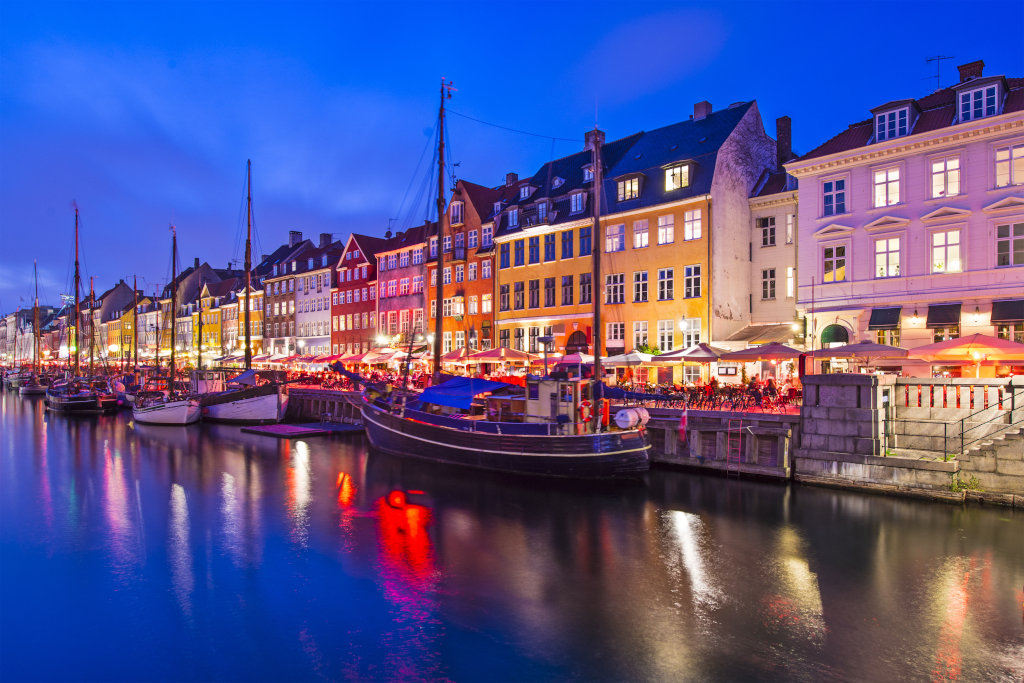
The colder regions of Europe often get overlooked by the mass tourist crowd in favor of sunny Spain or the gorgeous islands of Greece. Romantics head for Paris, France, and those obsessed with all things royal, usually land in London. However, for the traveler who loves exotic landscapes covered in snow, difficult hikes, and all things Viking, you can’t beat a trip that includes the best places to travel in Northern Europe!
Scavenger Hunts in Northern Europe
If you’re planning a visit to Northern Europe, don’t forget to download our adventure app and try one or more of our walking scavenger hunt tours ! We’ve created hundreds of exciting excursions in cities throughout the world , and our talented guides are creating additional options every day. Each experience includes a fun route to area attractions, facts about each stop, and photo challenges. Trivia questions will help test your knowledge and give you a chance to top the local leaderboard. Try one on your next trip!
The Best Places to Travel in Northern Europe
“Northern Europe” is a bit difficult to define, but it’s often categorized as countries above the 54th Parallel North, or roughly in line with the southern border of the Baltic Sea. This includes all of Scandinavia, most of the United Kingdom, and the northernmost cities of Continental Europe. That’s what we will use as our definition for this article.
Now that our parameters are set, without further ado, let’s jump into the best places to travel in Northern Europe!
1. Drive The Ring Road of Iceland
There is no landscape on earth quite like Iceland. “The Land of Fire and Ice” is majestic, mystical, and full of history. From active volcanoes to snorkeling with Humpback Whales, there is an adventure for every traveler in this northern paradise.
Your trip will start with a flight into the funky capital of Iceland, Reykjavik. From there, we recommend renting a camper van or SUV and driving The Ring Road . The Ring Road is the main Highway that circumvents the entire Island. Most of Iceland’s best sights can be seen from here on a 10-day trip. Check out the Golden Circle where you can snorkel between two continents at Silfra, explore Thingvellir National Park, and check out the show at Geysir Park.
Next, you’ll visit waterfalls and black sand beaches on the southern and eastern coast, including the famous Diamond Beach. In the north of the country, you can snorkel with Humpback Whales in Strytan, and then continue your hunt for waterfalls and canyons around the loop back to Reykjavik.
The interior of Iceland is magical as well, full of colorful mountains in Landmannalaugar and glacier peaks. However, the roads are only open in the middle of summer, from June-August, usually. You kind of have to pick your poison with Iceland travel. If you want ice caves and the best Northern Lights possibilities, winter is your time. If you want to go see the interior then summer is your best bet. In the summer months, you also have almost 24 hours of daylight, so that helps get all those sights in easily!
2. Explore The Top Trio of Norway
The Scandinavian nation of Norway should be at the top of any nature lover’s list! The mountain peaks, the fresh air, the deep blue fjords… heaven! From epic waterfalls to death-defying cliff overlooks, Norway has some serious beauty and adventure! With all those waterways, navigating around Norway can be a bit difficult, but with a little planning and flexibility, it can be the trip of a lifetime. We recommend spending a few nights in each of these areas and taking day trips and excursions from each.
Oslo is the oft-overlooked capital city of Norway, but Bergen is kind of the cultural capital. Oslo hasn’t been the capital that long, and much of it was destroyed in a fire in the 1600s, so so you won’t get the rich history there that you do in Bergen. Spend a day in Oslo, then move on to greener pastures.
We recommend you spend at least a couple of days in Bergen. The brightly colored wooden buildings of Norway’s second-largest city look like something straight off a postcard. Bergen is a mecca of culture and history. Visit the gorgeous Fantoft Stave Church, explore the museums, and stop by the historic Fish Market.
From there, you can hop on one of Bergen’s Fjord day trips to Mostraumen Fjord, or a slightly longer trip to Sognefjord or Flåm-which we highly recommend. Flam is adorable! You can also very easily take the train from Bergen to Flåm. Bergen is also the closest city to the famous cliff overlook of Trolltunga, which is a hike you don’t want to miss!
Tromso is a gorgeous town far above the Arctic Circle, in Northern Norway, famous for its nature activities. This is your chance to fulfill all your winter wonderland fantasies. Hunt for the Northern Lights. Marvel at the Midnight Sun. Search for wild reindeer or take a dog-sledding tour. Enjoy a concert at the Arctic Cathedral. Go on a whale safari or kayak the northern fjords on a guided tour. When in the city, make sure to take the Fjellheisen cable car up for a stellar view of the area. Tromso is gloriously beautiful! Just don’t forget your parka!
Stavanger is your mecca for hiking! It has an adorable Old Town too, but Stavanger is the perfect place to camp out a couple of nights and make the day trips to Lysefjord, Preikestolen (Pulpit Rock), and Kjerag. Pulpit Rock and Kjerag are two of Norway’s most easily accessible and popular hikes. You have likely seen both of these beautiful multiple times in your Insta feed. Kjerag is the rock wedged between two cliffs that the craziest hikers brave their life on to get that perfect photo. Pulpit Rock is a large, cliff overhang with incredible Norwegian fjord views. Both of these places are must-visit sights in our opinion!
3. Basque in The Quaintness of Tallinn, Estonia
Cutest” “Old Town in the world” award goes to… drum roll, please… Tallinn, Estonia! This place is seriously a fairytale and so underrated! A walk around Tallinn is like stepping back into a Medieval world of knights and castles, princesses, and perfect castle turrets. Pass by the multiple booths of fresh-flower merchants and enter the twin-towered gate to Old Town. You’ll instantly be greeted by a cobblestone maze of high-end cafes and stunning architecture.
Tallinn has one of the most intact medieval city walls anywhere in Europe. Parts of the wall are open for tourism. You can stroll at the top of the city on a covered wooden path, and several of the towers along the path now serve as city museums.
The Downtown area is laced with period actors selling their wares in costume. The food is fantastic. You can even experience a true Medieval meal at Ill Draakon. Fish for pickles in a barrel, be denied any kind of silverware, and have an absolute blast at this themed restaurant in the town square.
You can do everything, or nothing at all, in the city of Tallinn. Either way, you’ll enjoy some of Europe’s best food, the most beautiful architecture, and a quirky, entertaining personality that will lift the spirits of any weary traveler.
4. Sauna Hop in Finnish Lapland
Finland has emerged as a leader in travel for Scandinavia in recent years. It’s no surprise either. Finnish Lapland has done an excellent job of drawing in tourists. It plays on its natural beauty and incredible snowy landscape to provide adventures of all kinds to tourists who don’t mind a few cold nights.
Then, there are the saunas! Finland has a little over 5 million people, and those people enjoy well over two million saunas. To say it’s a Finnish pastime is the understatement of the century. To do it correctly, you must spend your time in the sauna until you’re nice and sweaty, run and jump in the nearest snowbank or icy body of water. It’s a thrill like no other! Don’t worry. Unless you have been diagnosed with epilepsy, it’s a safe activity and has been tested thoroughly by every Finnish local and the bravest tourists.
We recommend you spend a couple of days in the capital city of Helsinki. It has some excellent restaurants and cafes, a lovely national museum, and several stunning cathedrals. Plus the seaside port and Old Market Hall are a must-see. The market is a bit touristy, but worth it for the Lohikeitto (salmon soup)! It’s the perfect antidote for a cold Helsinki day.
From there, snag a bus or rental car and head up to paradise in Rovaniemi. Book a few days at Apukka Resort. Here is your one-stop shop for reindeer sleigh rides, dog sledding excursions, and Northern Lights tours of every kind. They have lodging ranging from glass-topped Aurora cabins, to villa-style lodges, to campers by the lake. Or, for the really adventurous, book a night in their ice hut and see if you can make it through until morning in -10C temps. You would think with all this on offer that Apukka would cost you an arm and a leg, but surprisingly, it’s one of the cheapest resorts in the area (which still isn’t cheap, Finland is very expensive).
5. Take the Ferry to St. Petersburg, Russia
While Russia is causing some trouble on the world scene at the moment, and we wouldn’t recommend this trip currently (actually it isn’t running right now), normally you can book a ferry from Helsinki, Finland to St. Petersburg, Russia. This ferry is a sort of an ill-kept secret and a loophole for getting into Russia without a visa. Russian visas are expensive.
With a tour package from St. Peters Line , you can take the ferry from Tallinn, Estonia, or Helsinki, Finland, and spend up to 72 hours in St. Petersburg, visa-free! There are a few rules you have to abide by, like taking a guided excursion into the city, but all-in-all it’s an easy and cheap way to get a taste of Russia!
6. Put Your Liver to the Test in Dublin, Ireland
There is no place on earth more lively than a Dublin pub. Pull up a barstool. Tap your foot to the rousing tune of a live band playing traditional music as drunken revelry entertains all your senses. If you’re lucky, perhaps an old Seanchai (traditional Irish folk teller) will regale you with a limerick or two.
Aside from the pubs, Dublin is a lovely city, full of gorgeous cathedrals and tons of history. Most of the city seems to be owned by either Guinness or Jameson, and there are a number of great rivalry tales. Plus, two pretty awesome brewery tours.
If you have the time, rent a car and do a loop of the Emerald Isle. There is no landscape on Earth that’s quite as peaceful as the Irish countryside. You can fish in quaint seaside villages, and explore some of our oldest human creations in the Neolithic passage tombs of Newgrange and Brú na Bóinne.
Drive Slea Head Loop. Stop at all the little beehive huts and Celtic burial grounds along the route. Stop off for a Guinness at the Dingle Pub. Drive the Ring of Kerry and experience paradise on Earth. Traverse the massive monasteries and abbey ruins like the Rock of Cashel, and visit every castle you can. It’s a road trip for the books! Oh, you can even stay in a renovated castle. Book a night in Wilton Castle for excellent service and a historical tour of this storied property.
For the very best way to explore Dublin, hop on one of our app-guided scavenger hunts of the city. Our hunts are chalked full of fun photo and trivia challenges and introduce you to the city in an adventurous competition that’s guaranteed to be the best part of your trip! Check out “ The Dublin Adventure ”, or the spooky ghost hunt, The Dark, The Dead, and The Doomed. ”
7. Explore the Complicated History of Riga, Latvia
Latvia not on your bucket list? It should be! Riga is a stunning city with an interesting history. It served as a major port for most of its existence and has been fought over by pretty much every major power in its turbulent past. It was founded by Germans and was going to be the Nazi headquarters for Northern Europe had Hitler succeeded. Riga has excellent free walking tours, led by local historians, and we recommend you take as many as you can!
Try all the local delicacies at the sprawling Riga Central Market. Take a dive off the bungee platform and enjoy the gorgeous Baltic Sea at Dārzu ceļš. Outside of the museums and architecture of Old Town Riga, Latvia is filled with gorgeous national parks and Baltic Sea beaches that are thriving in the summer months. If you want to avoid mass tourism, see amazing scenery, and get a little history in too, you can’t beat a week in Latvia!
8. Experience Pure Peace In The Faroe Islands
If you really don’t like people, head for the remote Faroe Islands. Holy cow are they beautiful? You get all the green swept fields of Ireland, the waterfalls and cliffside views of Iceland, and none of the tourist crowd!
We definitely suggest you do a road trip—with a few ferries thrown in. Visit the giant puffin colony of Mykines. Mykines is the westernmost island and can be accessed by ferry from Størvágur. Take some time to visit the lighthouse and explore a local village after admiring the cutest birds ever. You must make the hike to the stunning Lake Sørvágsvatn on Vágar Island. It’s the largest lake in the Faroe Islands, and it famously appears to be hanging off a cliff into the sea. The hike takes about an hour, and it’s fabulous!
The other must-see sight is the village of Gásadalur and its glorious waterfall, Múlafossur. The typical Faroese village has all the grass-covered roofs of your Faroe dreams and some of the most beautiful towering-mountain surroundings. The Faroe Islands are not a cheap trip, but they are beautiful and secluded, which sounds pretty good to us!
9. Cruise the Canals of Stockholm, Sweden
The capital of Sweden is a gem! The city proper is spread over 14 islands and covered in glorious palaces, museums, and castles that will keep you busy for weeks! Make sure to visit the opulent Royal Palace, on par with any in Europe. Make sure to stop in the Vasa Museum, The Swedish History Museum, and The Medieval Museum to get your history fix. Stroll the gardens of Drottningholm Castle , Sweden’s most intact and glorious residence from the 1600s. Stroll Strandvägen boulevard with some swiss chocolate in hand.
If you’re an ABBA fan, the famous Swedes have their own museum in Stockholm ! Stroll around 13th century Gamla Stan (Old Town). Cruise through the ancient canals and under beautiful bridges on a Paddan boat tour, and with all that sightseeing, don’t forget to take some time for a Fika (coffee and cake break)!
10. Medieval Castles and Beasts in Scotland
Castles, kilts, scotch, and Nessie, that’s what a vacation in cheery Ol’ Scotland will get ya. We don’t know about you, but that all sounds pretty good to us. Start your trip with our fun-filled “ Fairy Tale Capital” scavenger hunt and learn all there is to know about the UNESCO World Heritage Site of Old Town Edinburgh. It will get you all caught up on your Scottish history and give you a good overall layout of the city. Then, you can go back and explore in detail anything that strikes you as interesting!
After a couple of days in the city taking in Parliament, the cathedrals, and Castle Rock, hop in the car for the ultimate road trip! Head for Lochness and try to snap a shot of the Lochness Monster. Explore the remains of 13 intact castles on The Castle Trail in Aberdeenshire.
Next up are the incredible landscapes and eery mists of the Isle of Skye. You can hike its glens and explore caves for days, not to mention the gorgeous waterfalls and sandy beaches. With tons of wildlife and over 200 species of birds, the island is a haven for nature lovers!
However, make sure to save a couple of days in your itinerary for Glasgow to admire the Victorian and Art Nouveau architecture, catch an opera, and check out Glasgow Cathedral. We have a tour of glorious Glasgow , too!
Visit the whiskey distilleries on the isles of Islay and Jura. Climb The UK’s highest peaks in the Grampian Mountains, and make sure to take the tour of Melrose Abbey! Alternatively, you could just hop from castle to castle and keep your fairytale dreams alive for weeks.
11. Take A Pilgrimage in Lithuania
Like Latvia, the Baltic country of Lithuania might not be on your radar. However, there are some interesting sights in this little northern beauty. First of all, let’s talk about the “Hill of Crosses.” This quirky little sight is in northern Lithuania and has been a pilgrimage route since the first crosses were placed there after an uprising in 1831. Over the proceeding generations, pilgrims and tourists have left their mark on the grassy hill with what has turned into one of the largest collections of crosses and crucifixes in the world. Estimates as of 2006 put it at more than 100,000 crosses, and that was a long time ago. It’s kind of fun to just wander the sight and see the relics placed there by the faithful and the curious. It’s a weird sight, but worth a look!
The rest of the country is full of weird and quirky history too. Visit the Cathedral of St. Anne, the church Napolean tried to steal. Lurk through the underwater tunnels and escape routes of Kulgrinda, carved by Lithuanians over the centuries to escape their numerous invaders. Hike The Hill of Witches Trail and marvel at all the wood carvings of mythical beasts and little gnomes that dot the path.
We recommend a few days in the capital city of Vilnius too. It’s a beautiful city full of culture and history. Napolean was so impressed by Vilnius that he wrote home to his wife to tell her of its beauty. You can get an awesome view of the city from the Hill of Three Crosses, peruse the cafes and shops of one of the most well-preserved medieval Old Towns in Northern Europe, and even visit the weirdly-placed Frank Zappa Memorial. The singer had absolutely no ties to Vilnius or Lithuania and never visited there, but it’s one of two places in the world with a memorial to him. We told you Lithuania is quirky! If you like an off-the-beaten-path getaway, you’re gonna love this little Baltic jewel.
12. Connect With Your Inner Viking in Denmark
Copenhagen Denmark is a travel destination full of wonder and history. The city is full of museums, historic royal palaces, and fun amusement parks. Almost every major city in the world has a hop-on-hop-off tour, but not many of them are done by boat! In the gorgeous Danish capital, you can hop off at all the major sights from your canal cruise, and hop back on to the next sight down the waterway… so much more fun than a bus!
If you really want to explore the canals in luxury though, book a hot tub boat with Copehhot ! That’s right, you can cruise around the canals of Copenhagen in a hot tub boat, complete with champagne or a bucket of beer. Awesome! You’ll also want to make pitstops at The Little Mermaid Statue, Tivoli Gardens, and several of the country castles surrounding the city.
Once you have thoroughly explored the capital, head north and visit the acclaimed open-air museum of Den Gamble By. It contains over 75 historic buildings collected from multiple townships all over the country. The live period actors and furnishings really make you feel as if you have stepped back in time.
Hop over to the city of Odense and visit the historic home and museum of famous writer Hans Christian Anderson. Then, head for Randers and check out the amazing 3-domed zoo with an Asia, Africa, and South America Dome. It’s a paradise with free-roaming monkeys! One of the coolest zoos anywhere in the world!
Denmark is a small country, and you can feast your way through it on a 7-10 day trip pretty easily. Of course, you won’t see everything, but you can certainly make a good dent!
13. Explore The Shipyards of Belfast, Northern Ireland
Start your tour of the capital of Northern Ireland with a Let’s Roam scavenger hunt! It’s one of the best ways to get to know the city and have a really good time doing it. Work your way through difficult trivia questions, photo and video challenges, and much more on our adventure through the heart of Belfast. Simply download our adventure app and purchase tickets for the “ Bold and Beautiful Historic Belfast ” experience. Once purchased, our hunts can be done at any time, so they easily fit into the dead space of your trip itinerary. They may even turn out to be your favorite part of the trip. Give it a shot. We know you’re gonna love it!
If we could pick one thing that Belfast is famous for, it would be the RMS Titanic. The famous tainted ship was assembled right in the heart of Belfast at the Harland and Wolff Shipyard. After a period of abandonment, the Belfast Lough has been reconfigured as the Titanic Belfast Museum. The giant museum resembles four-ship bows and is quite an architectural feat to gawk at. Plus, you know, it’s full of Titanic memorabilia and history.
The Titanic museum isn’t the only great museum in Belfast though. The Ulster Museum boasts an impressive collection of dinosaur skeletons, Egyptian mummies, and Neolith war items and jewelry. The Ulster also has a great folk museum, east of the city, where you can experience a taste of ancient Northern Ireland village life.
Make sure to stop by the iconic City Hall, take in the smells of the Botanic Gardens, and visit the Grand Opera House before leaving the city. If you choose to tour around the rest of Northern Ireland. We recommend that you head north to the tip of the peninsula and visit Giant’s Causeway and The Old Bushmills Distillery. Oh… and The Dark Hedges are a beautiful place to snap those vacation Insta shots!
14. Pay Homage To The Beatles In Liverpool, England
Ahh, Liverpool… home to The Beatles, the world’s greatest second-hand shops, and a pretty great futbol club! In fact, it’s mostly Beatles fans and futbol fans, coming to Anfield, that target Liverpool as a travel destination, but it’s so much more than that! The city has a grit about it that is amusing and interesting. It’s a university city that still has kind of a rebellious vibe about it.
Start your trip with a visit to The Beatles Story . The world’s most iconic quad started their career here in Liverpool, and the most thorough museum dedicated to their lives and work is rightly here. Aside from the museum, you can visit The Cavern Club. The original club was one of the first places The Beatles played regularly and become the heart of the rock and roll scene in Liverpool in the 1960s.
After all the rock and roll and violent futbol stadium chants, make a stop at the Liverpool Cathedral to repent and take in the stunning architecture. Liverpool is a great city to just wander. Step into the record shops and vintage stores. Grab a coffee and hang out at The Royal Albert Docks, the old Victorian docks in Liverpool harbor.
If you have some time on your trip, drive through Manchester. Have a look around, and then swing up through the Yorkshire Dales. This part of the Northern English countryside is absolutely stunning, especially Malham Cove, The Forbidden Corner, and Aysgarth Falls. You really can’t go wrong actually, Northern England is beautiful anywhere you go!
Not sure where to start? We recommend our “ Lucky Liverpool ” walking scavenger hunt!
15. Refresh Your World War II History In Gdansk, Poland
Poland is a huge country, and there are so many places that you should visit there! Let’s start with the gorgeous Old Town of Krakow, home to the first UNESCO World Heritage Site, Wawel Castel. Then, there’s the capital of Warsaw and the World War II concentration camps of Auschwitz-Birkenau, Sobibor, and Treblinka. But, if we are sticking to our definition of Northern Europe, Gdansk is as far south in Poland as we are allowed to go, but don’t get sad yet. Gdansk is amazing!
Start your tour of the city with the emasculate St. Mary’s Basilica. This baby is huge, one of the three largest brick churches in the world! Yes, the world! It’s gorgeous. Then, move on to ice cream at Neptune’s Fountain, before hopping into The Museum of The Second World War. Do a little shopping in The Long Market. Gaze at all the pretties in The Amber Museum, and wander through the incredible shipyard.
Once you have finished your tour of the city, spend a couple of days taking some excursions. Head north to see the imposing Wisłoujście Fortress and Moat. Then, spend a day wandering the gardens and interior of Malbork Castle, a UNESCO World Heritage Site and the largest castle in the world! It’s a 13th-century beast, and it’s beautiful!
If you have time to see more of Poland, do it! However, you can easily spend a week in the stunning city of Gdansk. The architecture is to die for, with all those soaring epithets and red-tile roofs. The food is hearty and tasty. The city is clean and vibrant and full of history. We love everything about it, and we are sure you will too!
16. Photograph The Iconic Bridges Of Hamburg, Germany
Much like Gdansk, in Poland, Hamburg is the one German city that pretty much fits our rules for being included in Northern Europe. This German beauty is worth a visit for sure. It’s the second-busiest port in all of Europe. It’s the second-largest city in the country, a major metropolis of harbors and canals, and is the largest non-capital city in the European Union. Those are some pretty major stats.
Take a boat tour down the Zolkanal to Speicherstadt. This city of warehouses is a feat of architectural genius. A canyon of red brick, Gothic Revival “cliffs”, soaring up from the canal, all built on oak piles. It’s quite a sight! Few of the warehouses built in the 1880s are still used for storage. Most are now apartments or tourist interests, like Miniatur Wunderland- a warehouse turned into a miniature moving world, complete with just about everything you can think of. It contains scale models of part of Italy, The United States, Hamburg itself, and Switzerland, among other famous places.
Check out a concert at the iconic Elbphilharmonie Orchestra. Not only is the talent exceptional, but the building is a stunner! Join the locals for a picnic on the green spaces of Planten un Blomen. Take a harbor boat tour in one of the beautiful paddle boats. Photograph all the stunning bridges. Did you know that Hamburg has more bridges than Amsterdam, London, and Venice, combined?! That’s an insane amount of bridges. Make sure to take a gander at Hamburg City Hall too.
If you’re going to Hamburg to party, you certainly won’t’ be alone. Its Reeperbahn District needs no introduction. It’s famous for its wild bars, numerous prostitutes, and a plethora of porn shops and strip clubs. The Saturday night tradition is for the wildest of partiers to wander down to the Fischmarkt and party on out until morning light. It might be one of the wildest nights in Europe, but if you’re young and up for it, it’s a night you won’t forget! Never mind. Strike that. You probably won’t remember any of it!
Whether you enjoy gorgeous architecture, hearty German food, tons of naval and maritime history, or a good party, Hamburg has something to offer every kind of adventurer!
Closing Thoughts
Well, now that your next 16 vacations are planned, which epic destination are you going to start with? Let us know in the comments!
It’s a tough decision. Northern Europe is a mecca of Viking and Celtic culture, has some of the most stunning landscapes in the world, and contains some of Earth’s most charming cities. You should probably just quit your job and go visit them all! ( Disclaimer: We offer travel guides and adventure inspiration here on Let’s Roam. We do not recommend that you take our financial advice.)
We do, however, know a thing or two about budget travel! For a few tips on how to save some money on Europe travel, don’t leave without reading our tips for traveling Europe on the cheap !
Taking your whole family? No problem! You can still travel for cheap. Find out “ How To Travel On A Budget With Your Family. ” With these budget travel tips in tow, you can enjoy your vacation and not regret your life choices once you get back home!
Frequently Asked Questions
There are some iconic travel destinations in Northern Europe ! Hike the incredible overlooks of Norway. Drive the Ring Road of Iceland , or enjoy a quiet holiday on the quaint Faroe Islands.
There are magnificent places to see in Northern Europe ! It’s full of historical sights, stunning architecture, and arctic adventures! Explore the quirky capital of Iceland , take a road trip around the Emerald Isle, or try a dog sledding excursion in Finnish Lapland!
Northern Europe has some stunning cities. The canals and waterways of Hamburg and Copenhagen are perfect for boat tours. Tallinn, Estonia is one of the most intact medieval towns, and the pubs of Dublin offer some of the friendliest locals in the world!
Featured Products & Activities

Touropia Travel
Discover the World
17 Best Places to Visit in Northern Europe
By Becky Griswold · Last updated on May 4, 2024
Northern Europe may be known as a place of Vikings and snow – and to some extent, that’s not incorrect. The Viking Age definitely did help to shape the culture of Scandinavia, and yes; there is a lot of snow, too. But it’s much more refined, and much more beautiful, than you could imagine.
From the storied, colorful old towns of some of the region’s richest trading cities to museums stressing the importance of the ancient Vikings, history comes to life in Northern Europe. Then there are far-flung islands where the sun never sets in summer, magnificent fjords and lakes as far as the eye can see. One thing is for sure; Northern Europe is modest about its majesty.
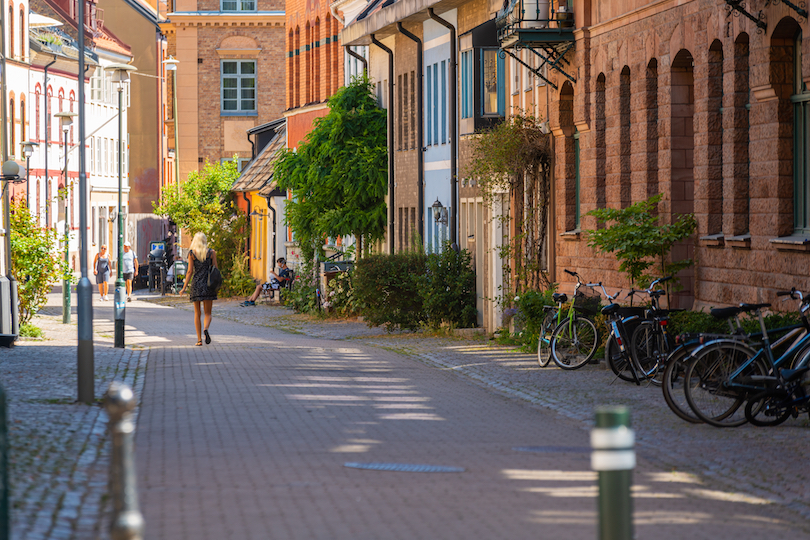
The third-largest city in all of Sweden , Malmo is something of a crossroads. With mainland Europe a quick ferry-crossing away, there are over 150 different nationalities in Malmo. Think a creative, international mix of Italian cafes, markets straight out of the Middle East, and fashionable bars.
Away from the modern-day melange of Malmo is Gamla Staden – or the Old Town – which comes complete with handsome Dutch Renaissance buildings. Malmo’s famous waterfront area was designed by architect Vastra Hamnen and is home to sky-piercing buildings that loom over Oresund Bridge for a fascinating mix of old and new that Malmo has become known for.
16. Reykjavik
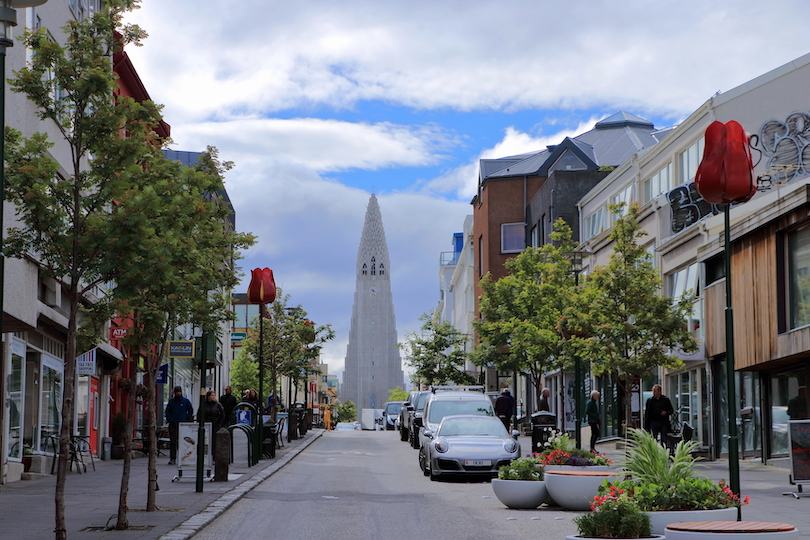
The compact Icelandic capital of Reykjavik is the ideal coastal city to base yourself for an adventure in this snowy, glacier-strewn land. Learn about the culture of this intriguing country – namely, Vikings – from the many museums on offer, like the National and Saga Museum.
One of the more famous sights in town is the stunning Hallgrimskirkja Church, a soaring modern marvel of a religious building; there’s a rotating glass dome from which you can catch views out across the sea. It may seem quaint in the day, but at night, things hot up, with plenty of clubs and busy bars around its central district.
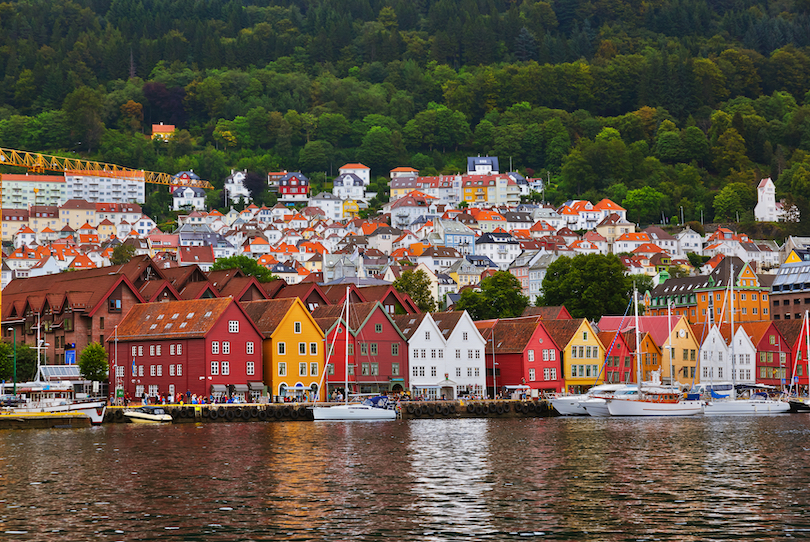
Bergen sits on the southwest coast of Norway , encased in mountains and flanked by fjords. In fact, the most famous fjord in Norway, Sognefjord (also its deepest and longest), is situated nearby. The charm of the city lies in Old Bergan, with its whimsical, wooden-built houses all painted in bright block colors; take a walk along the waterfront wharf area and end up at the port with its busy fish market.
The Fløibanen funicular in Bergen takes you up to the top of Fløyen Mountain for scenic views of the surrounding nature, in which hiking is not only a possibility, it’s a national pastime come summer.
14. Finnish Lakeland
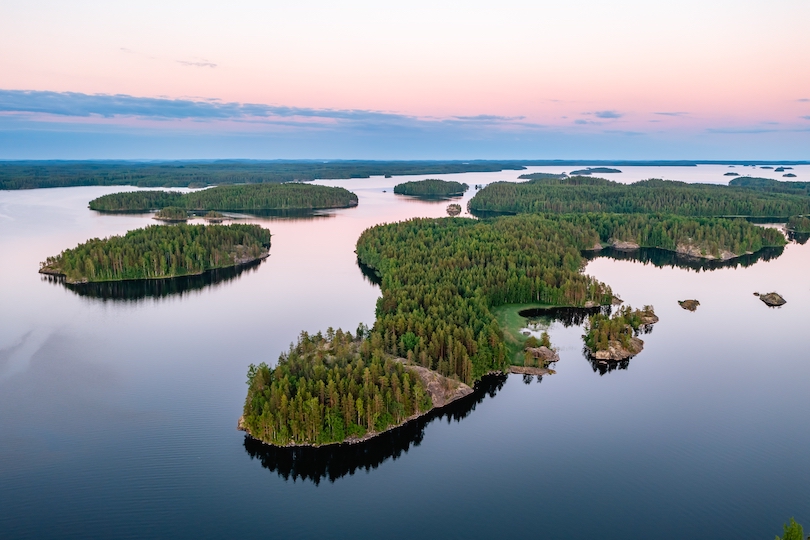
Finnish Lakeland is a region in the east of Finland where, true to its name, you will find almost countless lakes; around 40 lakes per 100 square kilometers. The largest of these is Lake Saimaa, which is not only Finland’s biggest lake, but also the fourth-largest natural lake in the whole of Europe. Studding Saimaa like little jewels are its 5,484 islands.
After spending time in an oak-burning sauna, a cooling dip in a lake is the best thing to do. The water of the lake is beautifully clean and reflects the sky for even more charm. Take a steamboat or canoe around the waters, spotting quaint mökki (summer cottages).
13. Gotland
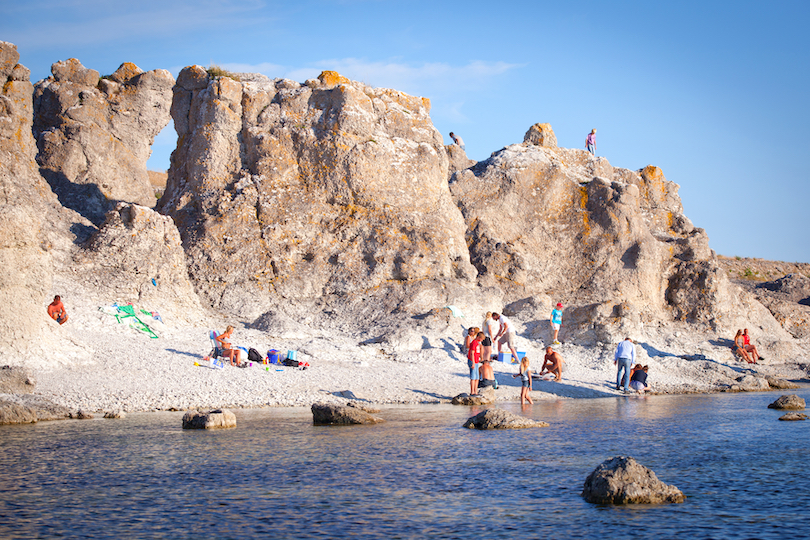
Just off the southeastern coast of Sweden is its largest island, Gotland . Also the largest island in the Baltic Sea, it’s a stunningly scenic and serene spot, where very few people actually live. The capital, Visby, is a historic center surrounded by well-preserved old city walls, that tells of the island’s Viking and medieval history.
There’s actually a fun festival held every year where Gotlanders don their best medieval garb and take a step back in time with music and merriment. Nature-wise, the island is asking to be explored. You could even just take a drive along the coast for dramatic sea views, little-visited hamlets tucked away, carpets of flowers in summer, and sandy beaches.
12. Jotunheimen National Park
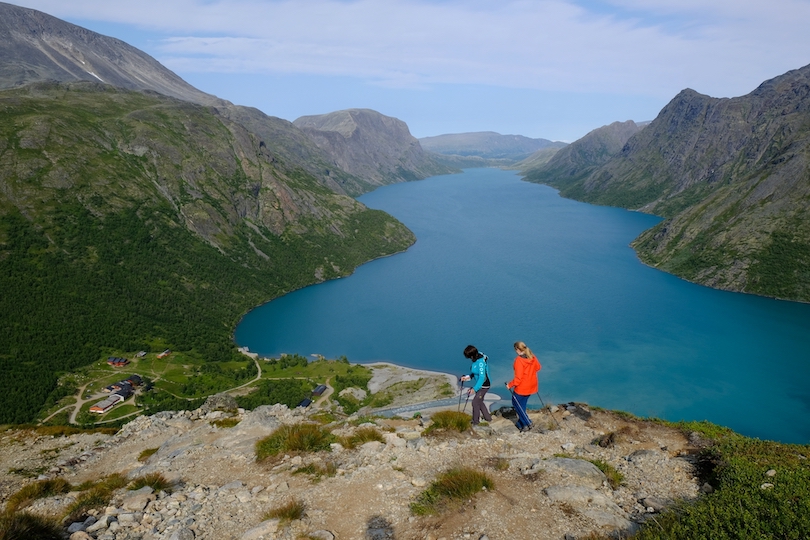
Part of the Scandinavian Mountain range, Jotunheimen (“Home of the Giants”) is a collection of mountains in Norway that boasts 29 of the country’s tallest peaks. Around a third of the mountains are contained within the Jotunheimen National Park. The area is a very popular spot for anybody looking for adventures on mountainsides – namely hikers and climbers.
In winter, the slopes are covered in pure-white powder, while in the summer, Jotunheimen is all about grassy valleys and gleaming rivers – and skiing, thanks to the summer ski center. There are many mountain lodges where you can stay the night along the 300 kilometers of marked paths.
11. Faroe Islands
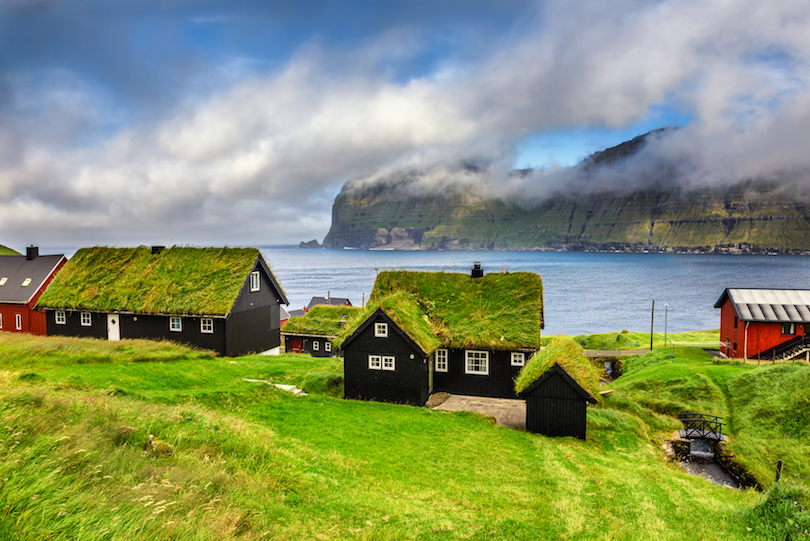
Set in the North Atlantic Ocean around 200 miles from the coast of Scotland , the Faroe Islands (part of the Kingdom of Denmark) are made up of 18 craggy, volcanic islets and islands. Its capital of Torshavn, located on the island of Streymoy, is where around 40% of the population of this self-governing territory live.
Many of the islands are connected by tunnels, bridges, causeways, and ferry crossings. It’s a popular spot for bird watchers especially, who enjoy observing the many species of seabird that live there, such as puffins, fulmars, kittiwakes, and guillemots. The iconic grass-roofed buildings of the Faroes are a sight that must be seen.
10. Blue Lagoon
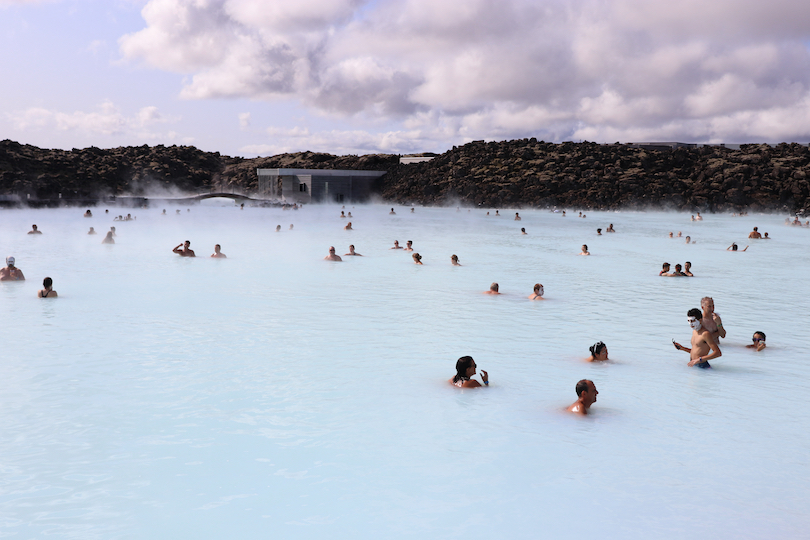
The hot spring that is Blue Lagoon is an extremely popular spot. Set on the Reykjanes Peninsula, not all that far from the Icelandic capital, the turquoise waters almost seem to glow like a gem amid the black volcanic rocks surrounding it.
The Blue Lagoon boasts 39°C water temperatures all year round, as well as healing properties (due to high silica and salt content of the volcanic water). Not naturally formed, it was first established in the 1970s as part of the cooling system for the local geothermal power plant; people started bathing here in the ‘80s, and it has since attracted people the world over.
9. Copenhagen

Copenhagen is the capital of Denmark and is situated on the coastal islands Zeeland and Amager. The city is strewn with historical sights and beautiful buildings, such as in the district of Frederiksstaden, where you’ll find ornate Rococo-style architecture dating back to the 18th century.
This area is also home to the Amalienborg Palace, the seat of the Danish royal family, as well as the impressive Frederik’s Kirke – fittingly known as the Marble Church. The iconic Nyhavn area is home to 17th-century buildings, canals, and plenty of drinking and dining options – as well as attractive heritage lodgings.
Tivoli Gardens , a 19th-century amusement park, is where you’ll find Rutschebanen – one of the oldest wooden roller coasters in the world!
8. Helsinki

Set on the south coast of Finland, Helsinki is the smart Finnish capital, and home to some stunning architecture. From the main railway station – with its unique National Romantic style and the imposing, stripped-back Parliament House – to the incredible Temppeliaukion Church – a bold 1960s church set directly in excavated rock – there’s an intriguing cross-section of modern styles in this city.
You can head over to the National Museum to learn all about Finnish history, or – from spring to autumn – check out Market Square, a hive of activity with food stalls, souvenirs, and street-side cafes where you can simply watch life in the capital unfold.
7. Svalbard
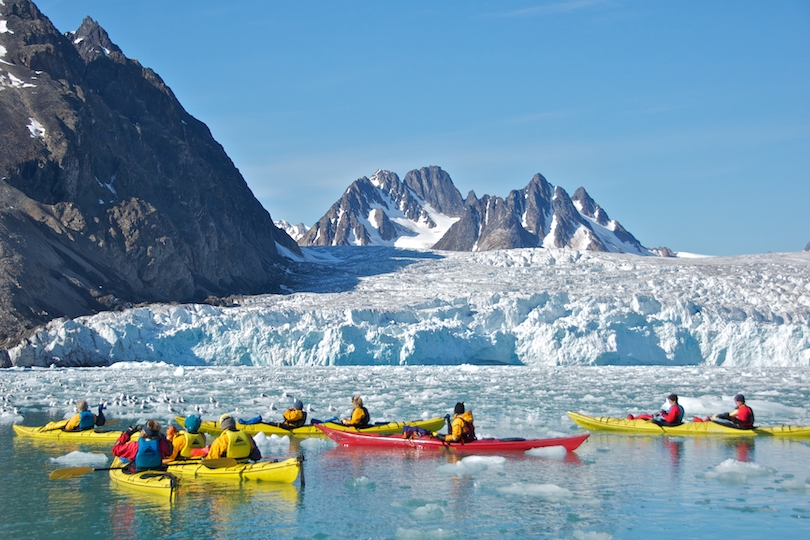
Far, far north from the Norwegian mainland is the island archipelago of Svalbard. Set well into the Arctic Circle, this far-flung destination is the place to come to witness the phenomenon that is Midnight Sun; during the summer, the sun doesn’t set here, never properly falling below the horizon for 24 hours.
Unfortunately, the opposite is also true of winter, when the sun never rises! Not part of Norway until 1925, today, visiting Svalbard is relatively easy, thanks to a surprising number of lodgings. This makes it easy to spot everything from polar bears and Arctic foxes to the magical Northern Lights.
6. Gullfoss
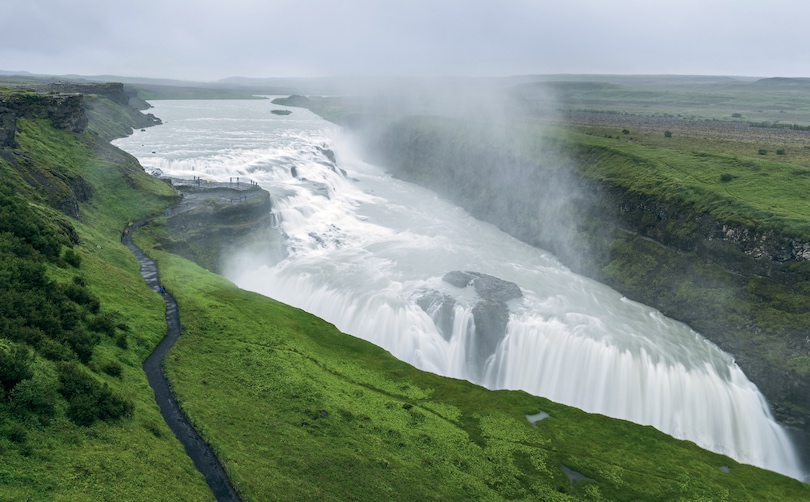
In southwest Iceland lies the startling natural wonder that is Gullfoss. Meaning “Golden Falls” in Icelandic, this waterfall is anything but ordinary. The Hvítá River, originating at the Langjökull glacier, runs its course through a canyon and then suddenly turns at a sharp angle to plunge 32 meters down its two stages before continuing.
The sheer power of nature here is easy to see; visit in summer for the full effect, when 140 cubic meters tumble down the falls every second. With more to see in the local area – like the hot springs of Geysir or the active geyser of Strokkur – as well as a few hotels nearby, staying at Gullfoss to explore further is a good idea.
5. Stockholm

Stockholm is a city of islands. Set on a Baltic Sea archipelago of 14 islands linked by a series of 50 bridges, the Swedish capital is a must-visit destination in the country. There’s Gamla Stan – or Old Town – a network of cobblestone lanes and pastel-colored houses, home to the 13th century Storkyrkan Cathedral.
Elsewhere in Stockholm , you can find the grand Royal Palace (completed in 1760), the Romanesque Revival style Stockholm City Hall. You can learn about the Nobel Prize at the Nobel Museum, and see an intact 17th-century sailship at the Vasa Museum. The open-air museum Skansen is an excellent way to glimpse Swedish life before modern-day luxuries.
See also: Where to Stay in Stockholm
4. Lofoten Islands
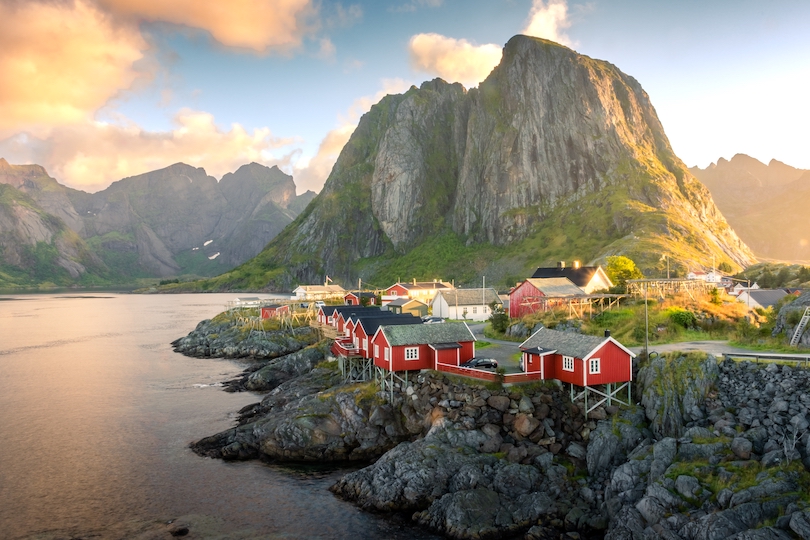
An archipelago extending from the northeast coast of Norway, Lofoten provides some truly dramatic natural backdrops for your travel adventures. One of the most famous things about Lofoten, besides its beautifully scenic setting, is its climate: it’s known for being strangely warm for its latitude.
Back to the nature now; keen rock climbers and mountaineers should make a beeline for Moskenesøya, while cyclists can enjoy a well-marked and particularly stunning cycle path from southerly Å, which goes on past Fiskebøl in the north. Otherwise, Lofoten is a warren of charming fishing villages with breathtaking natural surroundings, like Nusfjord on Flakstadøya.
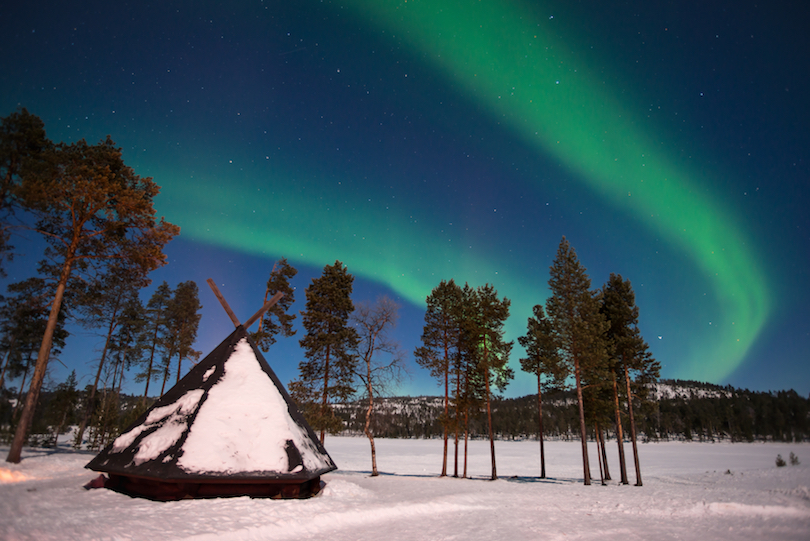
Except for the North Pole, there’s nowhere more northerly that’s as famous as this place. Lapland is a place for big kids and little kids alike; call him what you like – Father Christmas, Santa Claus, Saint Nicholas – this is his “traditional” home. Head to Rovaniemi to see if you can find his workshop.
Otherwise, Lapland – straddling the northern reaches of both Sweden and Finland – is the home of another traditional resident, the Sami people. Also known as Sápmi, Lapland is home to the original Ice Hotel, skiing opportunities, and chances to glimpse the Northern Lights. Head further north to discover the reindeer-herding Sami people themselves.
2. Vatnajokull National Park
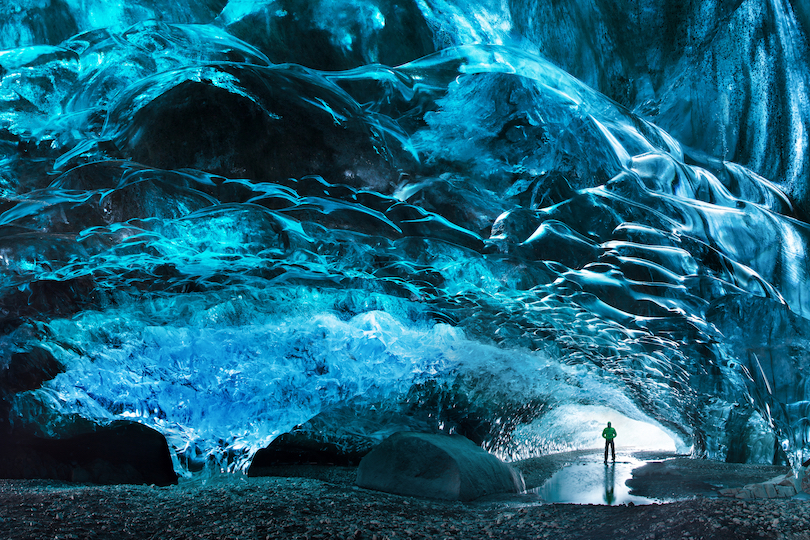
Vatnajokull National Park is the result of merging two extant Icelandic national parks, Jökulsárgljúfur and Skaftafell, with the giant ice cap that is Vatnajokull itself. As such, there are some incredible natural sights to see here. One of the most spectacular has to be Dettifoss; this waterfall is said to be Europe’s most powerful. Witnessing the water of the wide Jökulsá á Fjöllum falling an impressive 44 meters from one of the many hiking trails is awe-inspiring.
Elsewhere, there’s the caldera of Askja, where you’ll find the turquoise geothermal lake of Víti. Simply driving the ring road of this national park is an excellent way to watch nature unfold.
1. Fjords of Norway
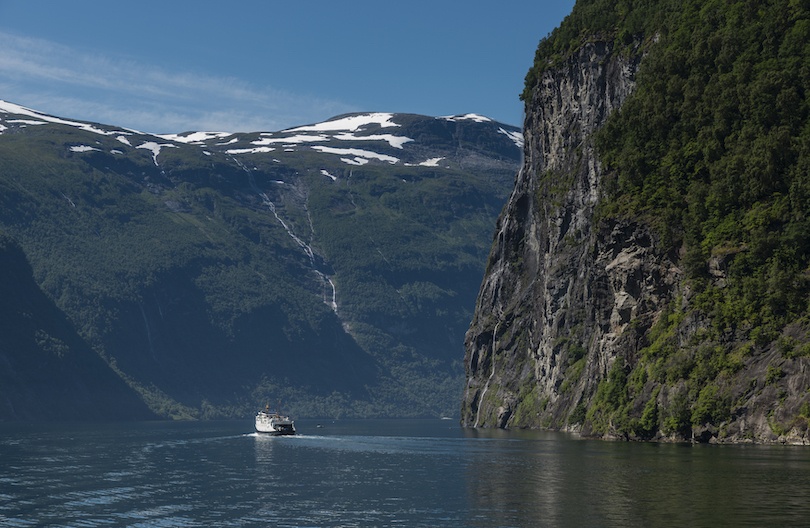
Norway is famous for its glacier-formed, U-shaped valleys that everybody knows and loves as fjords. Sognefjord may be its longest and deepest – cutting over 1,300 meters below sea level – as well as the country’s most famous – but it’s the sheer amount of fjords that make the Norwegian coast what it is.
There’s possibly the world’s strongest tidal current at Saltstraumen. Sørfjorden is a particularly dramatic sub-fjord of Hardangerfjorden. The mountain backdrop at Tafjorden is amazing. There have even been fjordal coral reefs found at depths of 50-100 meters. Whether you’re looking down on fjords, or on the waters looking up at the majesty of these valleys, any visit to the Norwegian Fjords will be truly stunning.
Map of Places to Visit in Northern Europe
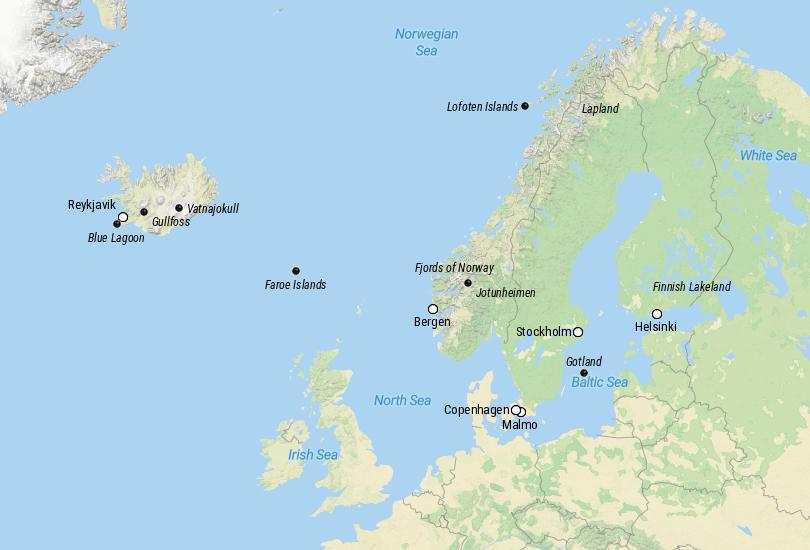
Share this post:

10 Best Places to Visit in Finland

10 Most Amazing Volcanoes in Iceland
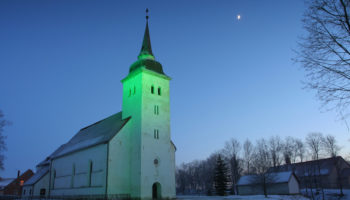
10 Best Places to Visit in Estonia
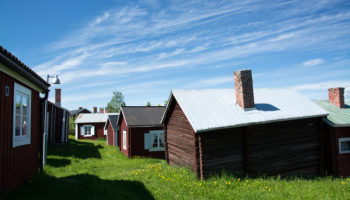
15 Most Charming Small Towns in Sweden
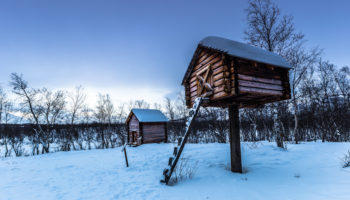
27 Top Tourist Attractions in Sweden
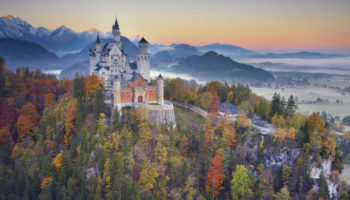
25 Top Tourist Attractions in Europe
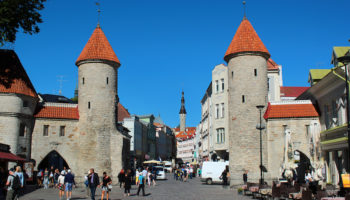
15 Best Things to do in Tallinn, Estonia
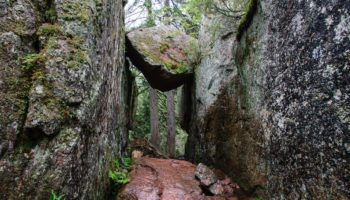
10 Most Beautiful National Parks Sweden
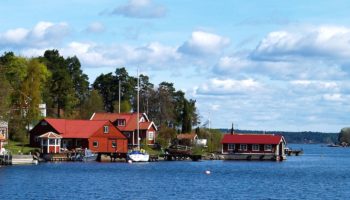
10 Best Places to Visit in Sweden
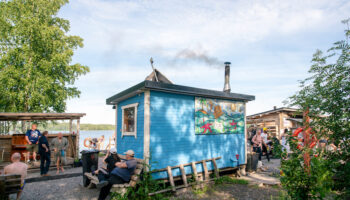
27 Top Tourist Attractions in Helsinki
Reader interactions, leave a reply cancel reply.
Your email address will not be published. Required fields are marked *
This site uses Akismet to reduce spam. Learn how your comment data is processed .
Best of Nordic Countries in 3 Weeks – Scandinavia Itinerary
Disclaimer: This article includes affiliate links to the products we earnestly love and recommend, meaning at no extra cost to you, we might make a teeny-weeny commission if you click on the link and decide to buy something. The money will be used to sustain this little cozy blog we call our virtual home.
Planning a trip to Nordic countries? We’d be happy to help you craft a perfect Nordic itinerary or, Scandinavia itinerary (as some may call it), or Northern Europe itinerary.
Itinerary for Scandinavian Countries: An Introduction
First off, let me tell you that a trip to Scandinavia is going to be the best trip of your life. Why? Well, Nordic countries are consistently being listed as the top happiest countries, consistently. Plus, they are stunningly gorgeous!
Nordic Countries or Nordics or Norden consists of five beautiful Northern European countries of Norway, Sweden, Finland, Denmark, and Iceland along with their associated territories of Svalbard, Greenland, Faroe Islands, and Åland Islands .
Why am I telling you this?
Because…
The terms Scandinavia (Scandia) and Nordics are used interchangeably by foreigners (I’ve been a culprit too before I explored the Nordic region) but they aren’t.
Finns and Icelanders are always quick to correct travelers who call them Scandinavians .
What’s the Difference between Scandinavian Countries and Nordic Countries?
The term ‘Scandinavia’ is commonly used ONLY for Denmark, Sweden, and Norway while the term ‘Nordic countries’ is used for Denmark, Sweden, Norway, Finland, Iceland, Greenland, Faroe Islands, and Åland Islands .
However, the associated territories of Svalbard (Norwegian archipelago) and Greenland are technically neither Scandinavia nor Nordics.
The Scandinavian Peninsula (not to be confused with the Scandinavian Region ) geographically comprises Norway and Sweden only.
To sum up, Northern Europe consists of the Nordics (Denmark, Sweden, Norway, Finland, and Iceland) and the Baltics (Estonia, Latvia, and Lithuania). Some definitions of Northern Europe also include the United Kingdom and Ireland .
I guess, this topic makes for another blog post. Let’s now move to Nordics itinerary, the sole reason you’re here 🙂
I’ll be using Scandinavia and Nordics, both terms in my post for the ease of getting found by people randomly searching the terms Scandinavia and Nordic Countries.
The Nordic region is one of the most beautiful and family-friendly regions in Europe. Also, it’s one of the most expensive regions in Europe. Believe you me, exploring the region is worth every penny.
Denmark, Sweden, Finland, and Norway are part of Europe’s Schengen Region. Read everything you need to know to score a Schengen visa for your Nordics trip.
Scandinavia Itinerary: Summer in Scandinavia
We spent 3 weeks in Scandinavia during the summer. The summer is magical here. It’s the time of the year when the sun refuses to go down and shines through the entire day and night. Seriously.
Summer and winter are, in fact, two extremes in Nordic countries.
If winter in Nordics brings sub-zero temperatures, dark days, snow-covered landscapes, and Northern Lights ; summer brings endless days, nightless nights, vibrant landscapes, and Midnight Sun.
The desire to witness the Aurora Borealis dancing in the night sky is such a mad rush among travelers all around the world that they overlook the region’s beauty during summer.
Witnessing the Midnight Sun in summer is as magical as the Northern Lights in winter.

Having said that, the Nordics region deserves two essential trips – one in summer and one in winter and some more to drink in its ethereal beauty.
It’s time to plan your Scandinavia travel !
Scandinavia Itinerary 21 Days: An Overview
Our itinerary lets you explore four epic Nordic countries in 3 weeks.
♥ Denmark ♥ Sweden ♥ Finland ♥ Norway
This is what a brief Scandinavia itinerary 3 weeks looks like –
C openhagen (6 nights) – Ystad ( 2 nights) – Molle ( 1 night) – Helsinki ( 3 nights) – Rovaniemi ( 2 nights) – Oslo (2 nights) – Bergen ( 2 nights) – Hardanger (1 night) – Flam ( 1 night) – Oslo ( 1 night)
Day 1: Fly into Copenhagen Day 2: Explore Copenhagen Day 3: Explore Copenhagen Day 4: Explore more of Copenhagen Day 5: Day Trip to Dragor Day 6: Day Trip to Helsingor Day 7: Road Trip to Malmo (Sweden) via Orseund Bridge Day 8: Explore Ystad Day 9: Explore Skane County. Drive to Kullaberg (Molle) Day 10: Kullaberg to Kastrup, Copenhagen. Fly to Helsinki. Day 11: Explore Helsinki Day 12: Day Trip to Porvoo Day 13: Fly to Rovaniemi Day 14: Explore Rovaniemi Day 15: Fly to Oslo Day 16: Explore Oslo Day 17: Oslo to Bergen train Day 18: Explore Bergen Day 19: Hardangerfjord Day 20: Flam Day 21: Flam to Oslo Day 22: Fly back home
Before we elaborate on our Scandinavia itinerary let’s first discuss the basics of a trip to Scandinavia.
Scandinavia Trip Itinerary: Things to Know Before You Go
Best time to visit scandinavia.
It all depends upon your choices. If you’d love to witness the white nights and want to soak in the Midnight Sun, plan during the months of June , July , and August .
If you dream of sleeping under the Northern Lights , September to March is the best time to go.
The months of May and September see fewer crowds and thus, are less expensive in terms of accommodations.

How much does a Trip to Scandinavia cost?
Scandinavia is infamous for being the most expensive region in the world. To some extent, it’s true. Scandinavia can be exorbitant if you’re not watchful about how you spend your money.
There are ways to cut your costs in Scandinavia –
- A little planning goes a long way. You save money when you plan and book well in advance.
- Prefer apartments over hotels.
- Shop at local grocery stores and cook your own food. If cooking isn’t your thing, you can go for pre-made meals from supermarkets. Aldi, Lidl, Kiwi, Rema 1000, Netto, and ICA are some of the budget-friendly supermarkets in Scandinavia. K-Market in Finland and Coop Prix in Norway are good discount stores.
- Food Market Halls like Kauppahallit in Helsinki or Torvehallerne in Copenhagen are another great option to cut costs on food. They are way cheaper than restaurants yet a great local food experience.
- Take Self-guided city tours and look for free attractions. Almost, all major cities in Scandinavia have tons of free and budget things to do and see.
- Buy City Tourist Cards like Copenhagen Card or Oslo Card that save money on attractions and transport. They work wonders when it comes to saving time, money, and hassle. You can buy them online and collect them at the airport.
- Bring an eco-friendly reusable water bottle. It saves money plus the environment. A water bottle in Scandinavia costs about $5.
- The Everyman’s Right (Right to Roam) in Nordic countries except Denmark makes it easy to camp in the wild. You can save a lot of money on accommodation if you’re traveling to Nordic countries during the summer.
- We found Norway the costlier of all other Nordic countries. You can maybe cut your time in Norway and spend more time in other Nordic countries to save some money.
We roughly spent about $2500 per person for 22 days in Scandinavia.
Getting to and from Scandinavia
From Asia , the USA, Australia, New Zealand, Africa, and the UK, the most convenient way of getting to and from Scandinavia is to fly. If you’re in Europe, you have the option to travel by train, bus, car, or ferry.
From India, only two airlines fly directly to the Scandinavian capitals. Air India flies into Copenhagen directly from New Delhi while Finnair flies into Helsinki directly from New Delhi. There are no direct flights to Oslo and Stockholm from New Delhi.
There are a few airlines that fly directly to the Nordic capitals from North America . Norwegian Air flies into Oslo, Finnair flies into Helsinki, and SAS flies into Stockholm, and Copenhagen, direct from New York.
We use and recommend Skyscanner for the best flight deals.
Getting Around Scandinavia
With a flexible range of transport options, Scandinavia is easy to navigate.
We used a rental car for most of our time in Scandinavia though we tried other modes of transportation like flights, trains, buses, and ferries to make our trip more varied and interesting.
Renting a car in Europe has its own set of rules. You can read our detailed guide to renting a car in Europe which will help you get started .
We always use and recommend Discover Cars for our car rental needs wherever we travel in the world.
We traveled by train from Oslo to Bergen which is considered one of the world’s most scenic train journeys (you gotta experience it), took a ferry from Stockholm to Helsinki, and boarded flights from Helsinki to Rovaniemi and Rovaniemi to Oslo.
I’d recommend taking a night train ( Santa Claus Express ) from Helsinki to Rovaniemi if you’ve more time on hand. Also, Norway in a Nutshell package is a great way to explore the dramatic fjords of Norway .
Make sure to book all your intercountry transportation tickets in advance.
It’s recommended to buy a Scandinavia Pass to get around Scandinavia on a budget .
A Detailed Scandinavia Itinerary: Explore Nordic Countries in 3 weeks
As always, our itinerary is packed with activities and leaves less time to just sit and do nothing. We love to explore and mini-me too loves to be on the move. She’s that restless.
This itinerary is made in a way that’ll fit all kinds of travelers, be they family travelers, or solo travelers, or couple travelers.
You can make slight changes and modify the itinerary as per your needs like it misses the famous hiking attractions in Norway (Trolltunga and Preikestolen) that can be added if hiking is what appeals to you.
First Destination: Denmark
Days to spend: 6 days.
You’ll start your Scandinavia exploration with the world’s most bike-friendly city and capital of Denmark, Copenhagen.
How to Get to Denmark
There are regular airline connections from the rest of the world to Copenhagen, Denmark. If you have got a direct flight, that’s awesome else book a flight with the least layover time.
You’ll fly into Kastrup International Airport in Copenhagen which is just about 15 minutes away from the city center.
You can rent a car at the airport or else you can take a train or bus to Kobenhavn H (Central Train Station) from where you can take a subway, bus, or taxi to reach your hotel or apartment in Copenhagen.
If you’re not renting a car, it’s best to book a hotel in and around the city center for ease of access.
Discover the Best Places to Stay in and around Copenhagen City Center, Denmark
Where to Stay in Denmark
Travelers usually keep Copenhagen as the base and prime destination in Denmark. Other cities worth visiting and spending a night or two in Denmark include Aarhus, Aalborg, Skagen, Ribe, and Odense. Dragor, Helsingor, and Roskilde can be visited on a day trip from Copenhagen .
Here are our recommendations for the best places to stay in Danish cities:
- Hotel in Copenhagen: citizenM Copenhagen Radhuspladsen
- Hotel in Aarhus: Villa Provence
- Hotel in Aalborg: Aalborg Hotel Apartments
- Hotel in Skagen: Skagenhus ved Kirken
- Hotel in Ribe: Den Gamle Købmandsgaard Bed & Breakfast
- Hotel in Odense: Hotel Odeon
- Hotel in Dragor: Dragør Hotel & Apartments
- Hotel in Helsingor: Charming and cozy annex
- Hotel in Roskilde: Ann’s cottage
Related Read: 10 Days in Denmark Itinerary
Day 1 – Arrive in Copenhagen
Today, you’ll arrive at the Danish capital, Copenhagen. The day is at leisure.
You can explore the streets of Copenhagen and get familiar with the city depending upon the time you get here or can head to your hotel to relax after a tiring flight journey.
Where to dine in Copenhagen on day 1?
Laundromat Cafe is quite a nice place to have a quick bite. Kids will love it.
Where to Stay in Copenhagen : We recommend CopenhagenApartment and citizenM Copenhagen Radhuspladsen .
Read our detailed guide to the best hotels in Copenhagen .
Day 2 – Explore Copenhagen
Start early to beat the crowds and make the most of your day.
The attractions you’ll be visiting today include:
- Frederik’s Church
- Amalienborg Palace
- Rosenborg Castle
- Statens Naturhistoriske Museum
- Round Tower
- Christiansborg Palace

Where to dine and drink in Copenhagen on day 2?
- Breakfast: Bowl Market Copenhagen
- Lunch: Torvehallerne or Restaurant Amalie
- Coffee and Snacks: Original Coffee ILLUM Rooftop
- Taste the traditional Danish pastry at Conditori La Glace, one of the historic cafes in Europe .
- Dinner: Riz Raz
Special Recommendation: A scoop or two of organic ice cream at Hansens Is .

You can visit all the Day 2 attractions on foot. The day-wise itinerary is crafted in a way that needs minimal walking.
Transportation and many attractions are free with the Copenhagen Card . It’s such a time and money saver!
Day 3 – Explore Copenhagen
This day is reserved for kid-friendly attractions. I mean, today you’ll explore the best things to do with kids and kids-at-heart 🙂
- Copenhagen Zoo
- Frederiksberg Palace
- Assistens Cemetery
- Jægersborggade
- Superkilen Park
- Experimentium

Recommended dining in Copenhagen for day 3:
- Coffee and Cakes: Hart Bageri
- Lunch: The Sixteen Twelve
- Dinner: The South Indian Frederiksberg
Day 4 – Explore more of Copenhagen or Take a Day-Trip to Roskilde
If you’re done with Copenhagen (which I doubt), you can take a trip to Roskilde .
Or you can explore:
- Freetown Christiana
- Gefion Fountain
- The Worker’s Museum
- The Copenhagen Lakes
- Tivoli Gardens

Food recommendations in Copenhagen for the 3rd day:
- Breakfast at Reffen
- Lunch: Restaurant Kastellet
- Coffee and Snacks: Mad & Kaffe
- Dinner: Tivoli Food Hall
Read our detailed 3 days in Copenhagen itinerary
Day 5: Day Trip to Dragør from Copenhagen
Head to Dragor , a cute little fishing town on Amager Island in Denmark.
The visit to this beautiful historic village gives you enough time to relax and take a break from the helter-skelter of sightseeing.
Make sure to take your kids to Den Blå Planet (National Aquarium Denmark), the largest aquarium in northern Europe. It’s on the way to Dragor.

If you plan to spend a night in this quaint village, we suggest booking the classic and beautiful Dragør Fort Hotel .
Where to eat in Dragor? Harborfront Dragør Strandhotel , and Restaurant Beghuset . Don’t forget to taste ice cream at Nam Nam Is .
Read our complete guide to Dragør, Denmark
Day 6 – Day Trip to Helsingor from Copenhagen
How can you visit Denmark and not visit Helsingor aka Elsinore , the home of Shakespeare’s Hamlet?
Encircled by Orseund, the Sound, and the expanse of water between Sweden and Denmark, Helsingor is a colorful town with cobbled streets and a rich history.
Kronborg Castle , a UNESCO World Heritage Site in Helsingor has been a perfect setting for Shakespeare’s Hamlet. The castle hosts Shakespeare’s Festival every summer where international stars portray Prince Hamlet.
You can also visit the Maritime Museum of Denmark, the Culture Yard by AART , and the Danish Museum of Science and Technology .

Where to eat in Helsingør? Værftets Madmarked and Elsinore Street Food .
Note: You can add Aarhus to your Denmark Itinerary if you have an extra day or two. You’d love its Aros Aarhus Art Museum and Infinite Bridge.
How to Get Around Copenhagen? For the most part, Copenhagen is very well accessible by foot and public transportation. A rental car is good for day trips but not suggested for city excursions of course for obvious reasons. Guided tours are also a pretty good option to explore the city without any tension.
We love and recommend Discover Cars to rent a car wherever you go.
Second Destination: Sweden
Days to spend: 3 days.
On the sixth day of your Scandinavia adventure, you’ll say goodbye to Denmark as Sweden welcomes you with a friendly and warm smile.
How to Get to Sweden
Our itinerary needs you to have a rental car as you’ll be exploring the Swedish countryside which is otherwise inaccessible by public transportation.
It’s quite easy to get from Denmark to Sweden by air, bus, or train. There are buses and trains from Copenhagen to Gothenburg, Malmo, and Stockholm.
If you are planning to explore the far north of Swedish Lapland like Kiruna and Abisko, there are regular flights by Norwegian Air and SAS from Copenhagen.
Where to Stay in Sweden
There are umpteen good stay options all across Sweden. Stockholm, being the capital and major city of Sweden offers a variety of hotels, apartments, and hostels for all budgets. Gothenburg, Gotland(Visby), Kiruna, and Skane (Ystad, Malmo, Molle, and Helsingborg) are other popular destinations in Sweden.
Malmo can be easily visited on a day trip from Copenhagen.
Here are the hotel recommendations for popular cities in Sweden:
- Hotel in Stockholm: NOFO Hotel; BW Premier Collection
- Hotel in Gothenburg: Hotel Vanilla
- Hotel in Visby: Hotel Villa Borgen
- Hotel in Kiruna: True Nature
- Hotel in Ystad: Charming Townhouse
- Hotel in Mölle: Pensionat Strandgården
- Hotel in Helsingborg: The Vault Hotel
Day 7 – Drive from Copenhagen to Malmo | Explore Malmo | Drive from Malmo to Ystad.
Take a beautiful drive to Malmo from Copenhagen via Öresund Bridge .
Check with your car hire company if your rental agreement allows you to cross international borders. Our car hire company gave us a paper that we showed at the border check.
If you don’t have a rental car , you can take a train (ACP Rail) or a bus (Flixbus, Netbuss, or Gråhundbus) from København H (Copenhagen Central Station).
Whichever mode of transport you choose, it usually takes about 40 minutes to reach Malmo from Copenhagen.

Great coffee with cakes and croissants at Noir Kaffekultur , that’ll be all you need for a great head start.
You’d love to check Turning Torso, Malmo Castle, and St. Peter’s Church before you have lunch at Sajvva , a great place in Malmo for vegans and vegetarians like me.
Once done with lunch, fasten your seat belt for another beautiful drive from Malmo to Ystad.
It’s a real delight to drive the awe-inspiring Sweden countryside.
We stayed at a lovely holiday cottage in Löderups Strandbad.
That’s all we needed – I mean a secluded cottage in the middle of the lush forest with a beach nearby, a perfect summer holiday.

Spend the day taking long walks through the forest and soaking in the warmth of the Midnight Sun while sitting at the beach with a glass of wine while kids cycle, run around, and play with the sand.

It’s always good to add such destinations to your otherwise action-packed itinerary. Isn’t it?
Here, you need to visit the nearest supermarket as you’ll have to cook your own dinner at your cottage.
If the idea of cooking on a vacation scares you, check out the best hotels to stay in Ystad, Sweden.
Day 8 – Explore Ystad
Ystad, a gorgeous town located in Skane county on the southern coast of Sweden with its cobbled streets lined with medieval, pastel-colored half-timbered houses, white-sand beaches, centuries-old historical sights, and ravishing rolling countryside all around is well worth a visit.
I instantly fell in love with its beauty.
Kurt Wallander’s crime series by Henning Mankell was set in Ystad. If you’re a Scandi-noir and Wallander fan, you can take one of the Wallander guided tours to see all the locations where the scenes were shot.

Don’t forget to visit the largest film studio in Scandinavia, Ystad Studios .
Where to eat in Ystad? Villa Strandvagen , Maltes Mackor , and Glassmakeriet .
Where to stay in Ystad? We recommend Hotell Bäckagården and Charming Townhouse .
Day 9 – Explore More of Skane County | Drive to Kullaberg
There are a whole lot of things to do in and around Skåne County (Scania) but we chose a few of those as we only had a day to explore Skåne.

We started our day with Ales Staner , a ship-shaped henge. It’s located in the tiny and beautiful village of Kåseberga . Legend has it that the ancient stone ship stands on the grave of a mythic king, King Ale.
Forget about history, the site where the stones are erected in the shape of a ship is utterly impressive. As soon as you hike the hill, you can’t help but admire the views overlooking the Baltic Ocean.

Our next stop was Skånes Djurpark in Höör Municipality, Skåne – a must-visit with kids. The zoo has more than a thousand wild as well as tame Nordic animals – elks, foxes, wolves, lynxes, bears, seals, and many more.
Kids had unlimited fun getting up close with animals, trying horse riding, enjoying the Shaun the Sheep theme park, and climbing the wooden bridges in the trees. Definitely, the best family fun in Skåne.

It was time for us to head to Kullaberg in Mölle, Sweden. It took us a little over an hour to reach Kullaberg Nature Reserve , a haven for outdoor lovers.
You can take scenic hikes, experience Porpoise Safari , check out the mysterious caves and coves, go fishing, admire the views from vantage points, paddle, swim, and so much more.
We enjoyed the Porpoise Safari in a RIB boat. The tour lasts for about an hour and costs Kr 450 per adult and Kr 300 per child.
We stayed at Pensionat Strandgården in Mölle. Wowzers it is! Highly recommended.
Where to eat near Kullaberg Nature Reserve? There aren’t many places to eat near the nature reserve. We tried Molle Krukmakeri and Ransvik Havsveranda and found them decent.
PS: And you can’t leave Sweden before you experience fika, one of the most beautiful coffee traditions around the world .
We wanted to extend the time in Sweden and explore Gothenburg and Stockholm and then take a ferry to Turku, Finland, or a flight from Stockholm to Helsinki, Finland but we came back to Copenhagen to catch our flight to Helsinki because car rental companies charge exorbitantly high if you pick your rental from one country and drop it in another. Check out 10 unusual things to do in Stockholm if you’re planning to add Stockholm to your Scandinavian itinerary.
Our car rental charges for 8 days (pick up and drop at Copenhagen Airport) were 8,000 INR ($ 100) and if we returned the car in Gothenburg, we’d had to pay 65,000 ($ 900).
Third Destination: Finland
Days to spend: 5 days.
You’d fall for this little country wrapped cozily into the far up north. Day 9 of the Scandinavia itinerary takes you to Finland.
How to Get to Finland
There are quite a good number of regular flights (Sichuan Airlines, Norwegian, SAS, and Finnair) from Copenhagen, Denmark to Helsinki, Finland. The journey takes a little less than 2 hours.
Where to Stay in Finland
Finland has awesome and unique stay options. For travelers, Helsinki remains the prime or first location in Finland. Summer or winter, you gotta plan a stay in Finnish Lapland to experience the Midnight Sun or the Northern Lights.
Here are our recommendations for Hotels in Finnish cities:
- Hotel in Helsinki: Hotel F6
- Hotel in Turku: Solo Sokos Hotel Turun Seurahuone
- Hotel in Porvoo: Small historic wooden house in Porvoo old town
- Hotels in Rovaniemi: Santa Claus Holiday Village ; Glass Resor t
- Hotel in Saariselka: Villa Karhunpesä ; Kakslauttanen Arctic Resort – Igloos and Chalets
Day 10 – Fly from Copenhagen to Helsinki | Explore Helsinki
Today, you have to drive back to Kastrup Airport (a 2-hour drive) and leave your car at the car rental drop to catch a flight to Helsinki .
Take a taxi, train, or bus to your hotel in Helsinki to drop off your bags and spend your day exploring the Finnish capital, Helsinki.
Take a self-guided or guided walking tour starting from Helsinki Central Station to explore the beautiful churches, charming streets, and markets of Helsinki.

Where to dine and drink in Helsinki on day 1?
- Lunch at Zucchini
- Coffee and Snacks at Karl Fazer Cafe
- Dinner at Kauppatori Market Square
Day 11 – Explore Helsinki
On your second day in Helsinki, you can go on island-hopping. Take a ferry from Market Square that takes you to the Suomenlinna Sea Fortress, Vallisaari, and Lonna .
Once you’re done with the island-hopping, have a cup of coffee and snacks at Cafe Regatta .

If you’re traveling with kids, take them to the Linnanmaki Amusement Park, or else you can try the famous Finnish Sauna at Löyly , one of the most popular activities in Helsinki .
Where to eat in Helsinki on day 2?
- Lunch at Juuri
- Coffee and Snacks at Cafe Regatta
- Dinner at Restaurant Savotta
Recommended Reading: Best things to do in Helsinki, Finland A First Timer’s Guide to Visiting Helsinki, Finland
Day 12 – Day Trip to Porvoo from Helsinki
Want a break from city sightseeing? Hop on a bus and head to the little fairytale town of Porvoo. Less than an hour away from Helsinki, Porvoo makes for a perfect day trip.
What’s so special about it? Well, you’ll know once you’re there 🙂
It’s so pretty that you’d want to just pack it in your bag and take it back home 😉

Stroll the cobbled streets adorned with pretty rows of pastel houses, museums, and cafes, and make sure to taste Runeberg’s Torte and Brunberg’s truffle .
If you’ve time, you can take a bus from Porvoo to visit Klovharun , fondly known as Moomin Island.
Where to eat in Porvoo? Ani’s Cafe , Zum Beispiel , Sinne , and SicaPelle are some of the best places to dine and drink in Porvoo.
If you plan to stay in Porvoo, please, please book this Small historic wooden house in Porvoo’s old town .
Here’s the ultimate guide to the charming town of Porvoo in Finland
Day 13 – Fly from Helsinki to Rovaniemi | Explore Rovaniemi
This day is solely for kids – the most awaited experience for kids. You are off to Rovaniemi – the official hometown of the kid’s beloved Santa Claus.
Norwegian Air and Finnair have regular flights from Helsinki to Rovaniemi. It takes about 1 hour and 20 minutes from Helsinki to Rovaniemi by air.
Santa Express Train is another good option provided you’ve enough time on your hands.
Pick up your rental car from Rovaniemi Airport and spend your day exploring Santa Claus Village – Cross the Arctic Circle, meet Santa Claus himself, feed the reindeer, and visit Husky Park.

Take that mandatory pic with the jolly man in the red!

Relax at your hotel and apartment before you start your hike to Ounsvara to witness the most unique and iconic natural phenomenon, the Midnight Sun .

Rovaniemi is one of the best places in northernmost Finland where you can experience full Midnight Sun when the sun stays above the horizon for about 70 days.
You can spot the magical phenomenon from May to August with June and July being the best months.
Where to eat in Rovaniemi on day 1?
- Lunch at Kotahovi Lapland Restaurant
- Coffee and Snacks at Coffee House
- Dinner at Restaurant Valdemari’s
Where to stay in Rovaniemi? Ukonloma Cottages , Kyyhkynen , Arctic Light Hotel , and Hostel Cafe Koti .
Day 14 – Explore Rovaniemi
Today, you’ll take a day trip to Ranua Wildlife Park , home to about 200 Arctic animals like polar bears, foxes, and lynxes.
Where to eat near Ranua Wildlife Park? We found the Wild Arctic restaurant good.
Try Rosso for Dinner and don’t forget to try Nordic’s pure ice cream by Arctic Ice Cream Factory . There are many outlets in Rovaniemi.
Read to know how a trip to Finnish Lapland in summer looks and feels like
Fourth Destination: Norway
Days to spend: 7 days.
Think Norway, think fjords. Majestic Norwegian fjords – there’s no match to them. There are 1000s of them dotting Norway’s coastline. It’s time to explore the sheer and unmatched natural beauty of Norway .
How to Get to Norway
Rovaniemi, Finland to Oslo, Norway is about 4 hours away by flight with a stopover in Helsinki. There’s no direct flight from Rovaniemi. You can come back to Helsinki and spend a day maybe before catching a flight to Oslo.
Where to Stay in Norway
Norway’s capital, Oslo has amazing accommodation options. Other cities of interest in Norway include Bergen, Flåm, Stavanger, Tromsø, Trondheim, the Lofoten Islands, Kristiansund, and Ålesund.
Here are the hotel recommendations for major Norwegian cities:
- Hotels in Olso: Thon Hotel Storo ; Camillas Hus
- Hotel in Bergen: Scandic Flesland Airport
- Hotel in Flåm: Flåm Ferdaminne
- Hotel in Stavanger: Historical apartments in the heart of the old town
- Hotel in Tromsø: Water-View Home
- Hotel in Trondheim: Affordable three-bedroom apartment
- Hotel in Lofoten: Sennesvik Apartments
- Hotel in Kristiansund: Blåbærdalen 20 Luksusvilla
- Hotel in Lyngstad: Ola Bua Near The Atlantic Road
- Hotel in Ålesund: Hotel Brosundet
Day 15 – Fly from Rovaniemi to Oslo | Explore Oslo
Your Norway itinerary starts in the capital city of Oslo.
From Rovaniemi, it’s about a 4-hour flight to Oslo including a short stopover at Helsinki. Take a shuttle train (Flytoget) to the city center and maybe a taxi from there to your hotel, drop off your luggage and freshen up before you start the sightseeing.
It’s always a good idea to book a hotel in the city center to save time and money on transportation.

On your first day in Oslo, you’ll explore:
- Oslo Opera House
- Frogner Park
- Slottsplassen
- Karl Johans Gate
- Nobel Peace Center
- Oslo City Hall

Where to eat in Oslo on day 1?
- Lunch at Tunco
- Coffee and snacks at Funky Fresh Foods – DogA
- Dinner at Freddy Fuego Burrito Bar Tjuvholmen
There are many awesome places to dine in Oslo but are expensive. I’ve suggested the ones we found cheap yet best – the absolute value of money.
Where to stay in Oslo? Mad Architect’s Shared Apt – Sørenga – Homestay, Thon Hotel Storo , and Camillas Hus .
Day 16 – Explore Oslo, Norway
The second day in Oslo starts with an Oslofjord cruise and then a ferry to the Bygdøy peninsula . The peninsula is brimming with famous Norwegian museums like the Kon-Tiki Museum, Fram Museum, Viking Ship Museum, and the Norwegian Museum of Cultural History .
You can’t visit Oslo with kids and not visit one of its amazing museums.

Make sure to grab an Oslo Pass to save money on museums and other major attractions in Oslo.
We recommend visiting the Norwegian Museum of Cultural History (Norwegian Folk Museum), Fram Museum, and Kon-Tiki Museum.
Dining recommendations for your 2nd day in Oslo: Mamma Pizza Osteria , Haralds Vaffel , Habits Coffee , and Oslo Street Food .
Try Statholdergaarden if you want to splurge on food.
Read our guide to the best things to do in Oslo, Norway
Day 17 – Oslo to Bergen on Bergen Railway | Explore Bergen
Day 16 of your Nordic Countries tour is beautiful. Today, you’ll ride one of the most scenic train journeys in the world, the Bergen Railway (Bergensbanen) from Oslo to Bergen .
This train journey is a part of the famous Norway in a Nutshell tour but that needs you to get down at Myrdal to board the Flåm Railway ( Flåmsbana ), another popular scenic train ride from Myrdal to Flam.
We didn’t take the package so traveled to Bergen.
The journey is exhilarating and the best introduction you can have to the Norwegian landscape.
Read all about the scenic train journey from Oslo to Bergen

If you book Norway in a Nutshell Tour , your transportation is managed by them but if you’re exploring Bergen (Gateway to the fjords) and Norwegian fjords on your own like us, the best way is to rent a car.
The car rental services aren’t available at the Bergen Railway Station which means you’ll have to catch a bus (Flybussen) to reach the Bergen Airport and rent a car.
Once you’ve rented a car, check in your hotel, relax, and spend the evening strolling the colorful lanes and pretty harbor of Bryggen and check out the Bergen fish market.

Where to dine in Bergen?
- Coffee and snacks at Lovetann Kaffebar
- Dinner at Trekroneren
Where to stay in Bergen? Thon Hotel Rosenkrantz Bergen , YM40 , Bjørnestrand Fjordside View , Scandic Flesland Airport
Day 18 – Explore Bergen
The entire day is dedicated to exploring Bergen . Ride the Fløibanen funicular and/or the Ulriken cable car to get 360-degree panoramic views over the city.

Visit the KODE Art Museums , especially KODE 4 which has Kunstlab where kids can learn the art while playing.

Next, you can visit Bergen Science Center Vilvite (kid-friendly) or Bergenhus Fortress depending upon the time and interest.
You can take the cruise along the Osterfjord if you’ve time and energy. The cruise leaves from the fish market pier. The last cruise leaves at 6 pm during the summer season and 2 pm otherwise.
Dining suggestions for 2nd day in Bergen:
- Lunch at Bare Restaurant
- Coffee and snacks at Godt Brod
- Dinner at the Horn of Africa
With more time, you can take one of many beautiful day trips from Bergen .
PS: We loved Bergen so much that the plan for the second visit is already on my mind. We explored Bergen in the summer and now are keen to witness the magic of Bergen in winter.
Day 19 – Drive to Hardangerfjord from Bergen | Explore Hardanger
The day finally is here when you’ll witness the majestic Norwegian fjord up close. A beautiful drive from Bergen to Hardangerfjord takes less than 2 hours.
The third-longest fjord in the world and second-longest in Norway, Hardangerfjord is wild and stunning.
There are many ways you can revel in the beauty of the fjord – hiking, walking, cruising, kayaking, and many more.

Where to eat in Hardanger? Hardangerviddahallen Restaurant & Cafe, Restaurant Fjell & Fjord, and Mabodalen Camping and Hyttesenter.
Where to stay in Hardanger? Hardangerfjord Hotel , Mo Gardsferie , Apartment in Herand , Vik Pensjonat Og Hytter , and Jaunsen Gjestegjevarstad .
Day 20 – Drive to Flam | Explore Flam
Today, drive the beautiful stretch from Eidfjord to Flam. There are many beautiful stops on the way to Flam like Voss, Gudvangen, and Stalheimskleiva .
Don’t rush but try to soak in the experiences.
You can opt for a Norled express boat from Bergen to Flam along the Sognefjord if you’ve enough time. The round-trip takes the entire day and the single journey takes over 5.5 hours. The boat leaves at 8:00 and makes brief stops at fjord villages on the way before it reaches Flam. The return trip starts at around 15:00 in the afternoon.
Once you reach Flam, take a fjord cruise or fjord safari through UNESCO Nærøyfjord , the most dramatic and wildest arm of the Sognefjord.

The three-hour tour passes through endless waterfalls, mountainside farms, little fjord villages, and colossal mountains.

One of the tours ( Heritage Taste Fjord Safari ) lets you get down to the beautiful village of Undredal , famous for its authentic goat cheese.
You can taste different varieties of cheese and jams at Eldhuset.
Once you’re done with the fjord cruise, board the Flamsbana for the most enchanting train journey from Flam to Myrdal and back.

Where to eat in Flam? Fretheim Hotel Restaurant, Flam Marina and Appartement Cafe, Green Norway Flam, and Bakkastova .
Where to stay in Flam? Flåm Marina , Flåm Ferdaminne , and Visit Undredal .
Related Read: 7 Days in Norway Itinerary 2 Weeks in Norway Itinerary
Day 21 – Road Trip from Flam to Oslo
Day 21. Sigh! We are almost done with our Nordic Countries exploration. Wait! The best is yet to come 🙂
Today, you’ll drive one of the loveliest road trips you’ve ever driven in your life. Believe you me.
The road trip from Bergen via Flam to Oslo passes through exciting tunnels, medieval churches, cute towns, mountain passes, national parks, dramatic fjords, and whatnot.
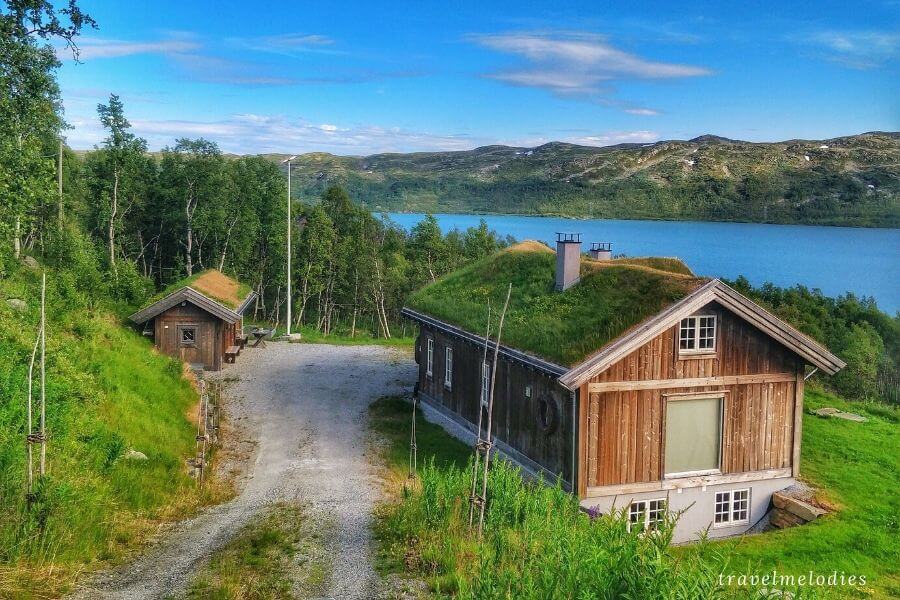
The entire road journey (300+ km) takes around 5 to 6 hours including the time spent at stopovers.
Here’s a detailed post about the road trip from Bergen to Oslo
You can retire to your hotel or check out the Holmenkollen Ski Museum and Tower in the evening. Climb the observation deck on top of the jump tower to enjoy the panoramic views over Oslo. The evenings are special as they bring beautiful sunsets over Oslofjord .
Day 22 – Fly Back Home
Finally, it’s time to say goodbye to the Nordics. I don’t like the endings especially when it comes to beautiful trips but as they say, “All good things must come to an end.”
You’ll fly out from Oslo to head home, wherever in the world it is. If you have a flight late afternoon or evening, you can spend some time exploring more of Oslo or maybe shopping for souvenirs. We recommend Way Nor for souvenirs.

Phew! This is an exhaustive guide to Scandinavia and we hope it helps travelers across the world to travel to this beautiful region in Northern Europe.
So, it’s basically a Denmark, Norway, Sweden, and Finland itinerary! You can add Iceland to this itinerary to explore the entire Nordic region. I purposely left Iceland as we have planned to visit it sometime soon during the Northern Lights season 🙂
Suggested Scandinavia Itineraries
For all those who don’t have 3 weeks to devote to the trip but still want to explore Scandinavia. Don’t worry, we have got you covered!
Here are suggested itineraries for Scandinavia for 15 days, 14 days, 12 days, 10 days, and 7 days:
Scandinavia Itinerary 15 Days
Day 1: Arrive in Copenhagen, Denmark | Explore Copenhagen
Day 2: Explore Copenhagen
Day 3: Take a Day trip to Kronborg Castle from Copenhagen
Day 4: Fly from Copenhagen to Stavanger, Norway | Explore Stavanger
Day 5: Hike Pulpit Rock
Day 6: Fly from Stavanger to Bergen | Explore Bergen
Day 7: Hike Trolltunga
Day 8: Take a Day Trip to Flåm to experience Norwegian Fjord Cruise (Nærøyfjord) and Flåm Railway
Day 9: A Scenic Train Journey or a Road Trip from Bergen to Oslo
Day 10: Explore Oslo
Day 11: Fly from Oslo to Stockholm, Sweden | Explore Stockholm
Day 12: Explore Stockholm
Day 13: Fly from Stockholm to Helsinki, Finland | Explore Helsinki
Day 14: Explore Helsinki
Day 15: Fly Back Home
Scandinavia Itinerary 14 Days (Bonus: Vibrant Estonian Capital of Tallinn)
Day 1: Arrive in Helsinki, Finland | Explore Helsinki
Day 2: Explore Helsinki
Day 3: Take a Ferry to Tallinn, Estonia | Explore Tallinn
Day 4: Explore Tallinn | Overnight Cruise from Tallinn to Stockholm, Sweden
Day 5: Explore Stockholm
Day 6: Fly from Stockholm to Copenhagen | Explore Copenhagen
Day 7: Explore Copenhagen
Day 8: Fly from Copenhagen to Oslo, Norway | Explore Oslo
Day 9: Explore Oslo
Day 10: A Scenic Train Journey or a Road Trip from Oslo to Bergen
Day 11: Explore Bergen
Day 12: Explore Flåm and the Norwegian Fjords
Day 13: Drive or Fly from Bergen to Stavanger | Explore Stavanger
Day 14: Fly Back Home
PS: Alternatively, you can join Norway in a Nutshell Tour on Day 10 that starts in Oslo and covers the beautiful Flåmsbana train ride and fjord cruise, and ends in Bergen. In that case, you can trade the day dedicated to Flam for the Trolltunga hike.
Scandinavia Itinerary for 12 Days: An Exciting Scandinavia Road Trip Itinerary
Day 3: Drive to Gothenburg, Sweden | Explore Gothenburg
Day 4: Drive from Gothenburg to Stockholm | Explore Stockholm
Day 6: Drive from Stockholm to Oslo
Day 7: Explore Oslo
Day 8: Drive from Oslo to Bergen
Day 9: Explore Bergen
Day 10: Explore Flam and Norwegian Fjords
Day 11: Drive from Bergen to Stavanger | Explore Stavanger
Day 12: Fly Back Home
Scandinavia Itinerary 10 Days
Day 3: Fly from Copenhagen to Stockholm, Sweden | Explore Stockholm
Day 4: Explore Stockholm
Day 5: Fly from Stockholm to Oslo, Norway | Explore Oslo
Day 6: Fly from Oslo to Bergen | Explore Bergen
Day 7: Take a Day trip from Bergen to Flåm | Cruise Nærøyfjord | Ride Flåmsbana
Day 8: Fly from Bergen to Helsinki, Finland | Explore Helsinki
Day 9: Explore Helsinki
Day 10: Fly Back Home
Scandinavia Itinerary 7 Days
Day 1: Arrive in Stockholm, Sweden | Explore Stockholm
Day 2: Fly or Board a Train from Stockholm to Copenhagen, Denmark | Explore Copenhagen
Day 3: Explore Copenhagen | Overnight Cruise from Copenhagen to Oslo, Norway
Day 4: Explore Oslo
Day 5: Fly or Board a Train from Oslo to Stockholm | Explore Stockholm
Day 6: Explore Stockholm
Day 7: Fly Back Home
Scandinavia Trip Itinerary: FAQs
What are the Scandinavian countries?
Denmark, Norway, and Sweden are Scandinavian countries, geographically. However, Finland, and Iceland, along with the Faroe Islands, Greenland, and Åland are also considered Scandinavian countries, traditionally. Ideally, they all together are called – Nordic countries.
How many days do you need to visit Scandinavia?
You need at least 10 days to explore the best of Scandinavia. 10 days in Scandinavia allows you to tick off the highlights of Denmark, Norway, Sweden, and Finland, however, it’d be a bit rushed trip. 2 weeks in Scandinavia are perfect to discover Scandinavia in a relaxed manner while 3 weeks in the region lets you discover the hidden gems or add some of the lesser known places.
What are the best months to travel in Scandinavia?
If you go by book, the summer months of June, July, and August are the best months to visit Scandinavia. It’s when the weather is just perfect, the days are endless, and the magic of the midnight sun adds to the experience. However, I feel winter in Scandinavia is extra special too because it brings the otherworldly northern lights and hygge , mysa , and koselig !
Is it expensive in Scandinavia?
Yes, Scandinavia is costly! Denmark, Sweden, Norway, and Finland rank on the top among the most expensive countries to travel to and live in the world. Yet, there are many ways you can visit Scandinavia on a budget if you choose rental vacation homes over hotels, cook your own food over eating out, visit free attractions, use discount passes, and plan well in advance. Also, planning to go during the low season also helps.
Which Scandinavian country to visit first?
It doesn’t matter which Scandinavian country you visit first. You can start in Sweden or Denmark or Norway or Finland depending on where there are a good number of direct as well as cheap flights to and from your home country available. Your Scandinavian itinerary mostly starts and ends in different countries.
Which country is better in Scandinavia?
Denmark, Sweden, Norway, and Finland; each Scandinavian country is different and more beautiful than the next. Denmark has world-class design and architecture, Norway has unearthly fjords and wilderness, Sweden has lush woodlands, pristine lakes, and islands, and Finland has stunning lakes, and traditional sauna culture, and it is home to the Santa Clause.
Is it easy to travel between Scandinavian countries?
Yes, traveling between Scandinavian countries is quite easy and comfortable. With extensive road, rail, air, and sea networks, getting around Scandinavia is a breeze. Express trains, overnight cruises, short ferry rides, long-distance coaches, low-cost flights – options abound. And, not to mention, a road trip around Scandinavia is the way to go if you have time.
What’s Scandinavia known for?
Scandinavia is famous for its Viking heritage, stunning landscape, endless forest cover, pristine lakes, magical fjords, gushing waterfalls, beautiful beaches, remarkable design, and architecture, royal palaces, pretty churches, unique culture, mouth-watering cuisine, charming towns, northern lights, midnight sun, and happy vibe. It’s one hell of a region!
So, when are you planning your trip to Scandinavia? If you need any further assistance as you plan to travel to Scandinavia, let us know in the comments section below. We’ll be more than happy to help!
Recommended Reading:
- Renting a Car in Europe
- Schengen Visa for Europe
- How to Plan a Trip to Europe
- Cheap and Free Things to do in Copenhagen
- 3 Days in Copenhagen Itinerary
- 13+ Incredible Day Trips from Copenhagen
- Best Hotels in Copenhagen for Families
- Dragør in Denmark
- Best Places to Visit in Denmark
- Cool Danish Words
- Trip to Finnish Lapland in Summer
- Best Things to do in Helsinki
- A First-Timer’s Guide to Visiting Helsinki
- Porvoo in Finland
- Where to Stay in Rovaniemi
- Best Places to Visit in Norway with Kids
- Oslo with Kids
- Where to Stay in Oslo
- Undredal in Norway
- The Train from Oslo to Bergen
- A Road Trip from Bergen to Oslo
- 7 Days in Norway Itinerary
- 2 Weeks in Norway Itinerary
- Beautiful Norwegian Words
- Cool Swedish Words
Save the Itinerary for Nordic Countries to Pinterest

Sharing is nice 🙂 If you have liked our post please share it with your friends and family and feel free to subscribe to our mailing list or you can also follow our stories on Facebook , Instagram , Pinterest , and Twitter .
Anjali Chawla
7 thoughts on “Best of Nordic Countries in 3 Weeks – Scandinavia Itinerary”
Hello Anjali! What a nice web travel spot you ve created. I am heading to Denmark, Sweden and Finland for 10 days with 3 kids ( 13 to 20 yrs.), mid january. I am from Argentina and that´s our summer holidays. Do you think it still would be an acceptable idea ( short days, cold cold cold ).
Hey Fernando!
I and Neha love it when our readers find our content helpful because that’s our ultimate goal 🙂 Thank you so much for your kind words.
Fernando, the plus points of visiting the Nordic countries in winter are – fewer crowds, lower costs, loads of winter activities, and a chance to witness Aurora Borealis while the downsides include chilly and windy weather, shorter days (translates to less exploration time), and closed roads (matters if road tripping is on your list). Also, many sights and activities remain closed or open on a limited schedule during winter.
Having said that, I’d say winter is a good time to go if your travel goal is to catch the northern lights and indulge in winter sports.
If you can postpone your plan then I’d recommend visiting from late May to early June when the weather is just perfect, days are long, crowds are limited, and all the sights and activities are open.
If you can’t put off your plan then make sure to pack well for your winter adventure as you’ve kids traveling with you. As they say, “there’s no such thing as bad weather, only bad clothes.” You gotta exercise caution while packing for your trip so you and your kids can feel comfortable during wintertime and enjoy snowy activities.
Be ready to layer up or bundle up. You must pack insulated, well-ventilated, and weather resistant jackets, waterproof lower, fleece leggings, long-sleeved tops, thermal underwear, warm sweaters to layer on tops, waterproof boots with a good grip, warm cap, war, and waterproof gloves, warm scarves, and thick socks. Make sure that the material of clothes is lightweight and quick dry.
Hope that helps. If you’ve any further questions or concerns, please let me know. I’m here to help!
Happy Travels!
Glad you liked the article and found it helpful. Hope it helps you plan your Scandinavia trip
The best information I read and don’t know even what is Nordic. It’s nice to know and learn other countries and one day we can visit this places.
So beautiful even looking only on the photos. Just saving money for the next holiday. Bon Voyage!
This sounds amazing! Thank your for your hard work in putting it together. I I’m not sure when we’ll be able to go, but it sounds like a dream vacation.
Excellent info – thank you! If I have 4 weeks to travel around these gorgeous countries, is there anywhere you’d add to the above itinerary?
If you have 4 weeks in Scandinavia, I’d suggest you to add 2 or 3 more days in Denmark to explore the charming cities of Aarhus and Odense and 2 to 3 days in Norway for Stavanger, Pulpit Rock Hike, or maybe a visit to Jostedalsbreen National Park. You can also refer to the itineraries for Denmark and Norway on my blog for more ideas.
Leave a Comment Cancel reply
© 2024 Travel Melodies. All Rights Reserved.
As an Amazon Associate, we earn from qualifying purchases.
- Skip to primary navigation
- Skip to main content
- Skip to primary sidebar
- Skip to footer

The Opinionated Travelogue of a Photo Maniac
- Middle East
- North America
- South America
- Pacific Islands
- FOOD & WINE
- TRAVEL GUIDES
- TRAVEL RESOURCES
- Rants & Raves
- Travel Blogger Interviews
- Contact Form
- Privacy Policy
- Featured Elsewhere

2 Weeks in Europe – How to Plan a Perfect Itinerary
Last Modified: May 5, 2024 // by Anda // 106 Comments
If you are planning a 2 weeks trip to Europe and need some itinerary ideas for your vacation you have come to the right place. As someone born and raised in Europe, I can give you some good advice when it comes to my home continent.
14 days may sound like a long trip, but not on this incredibly diverse continent. With so many attractions, sights to see and cultures to experience, your 2 weeks vacation in Europe will go by in the blink of an eye!

Table of Contents
How to Plan a Perfect Europe Trip Itinerary
• london, paris, and amsterdam, • lisbon, madrid, barcelona , • rome, florence, and venice , • prague, vienna, and budapest.
- • Berlin, Dresden and Wroclaw
- • Zurich, Lucerne, Lugano and Milan
- • Oslo, Stockholm, Copenhagen
- • Riga, Tallin, and Vilnius
- • Athens, Istanbul, Bucharest
- • Ljubljana, Split, Dubrivnik, Kotor
How to Plan a 2 Weeks Trip to Europe
- Tips for Spending 2 Weeks in Europe
A Final Note
If this is your first time in Europe, you probably have quite a few places on your Europe bucket list . Without knowing anything about you or your interests, I can only give you basic, generic advice.
Below is a list of 10 suggested itineraries for for a 2-week trip to Europe. The itineraries are grouped according to the different European regions. However, you can choose any combination from the cities listed here, according to your tastes and interests.
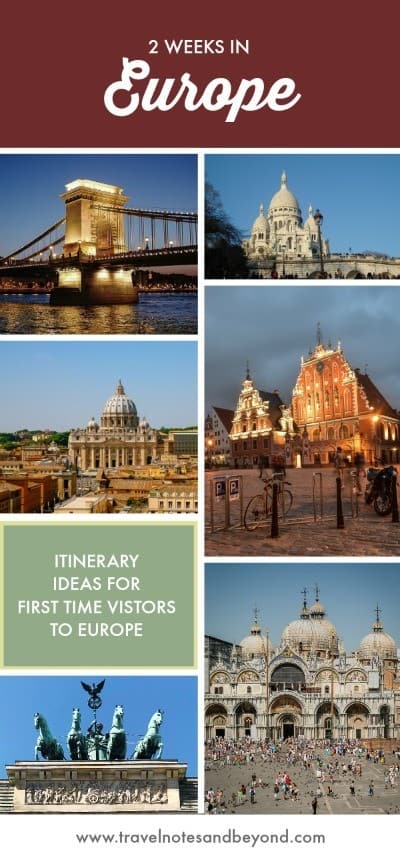
Best Western Europe Trip 2-Week Itinerary
These three cities have more than enough to keep you engaged for 2 weeks. You can easily spend the entire two weeks in Paris , if you were to visit all its amazing churches and museums.
London, Amsterdam and Paris are among the Europe’s greatest cities and enjoy a perennial popularity, despite the many problems they have been facing lately. I think they are worth seeing at least once, even though they are always crowded.
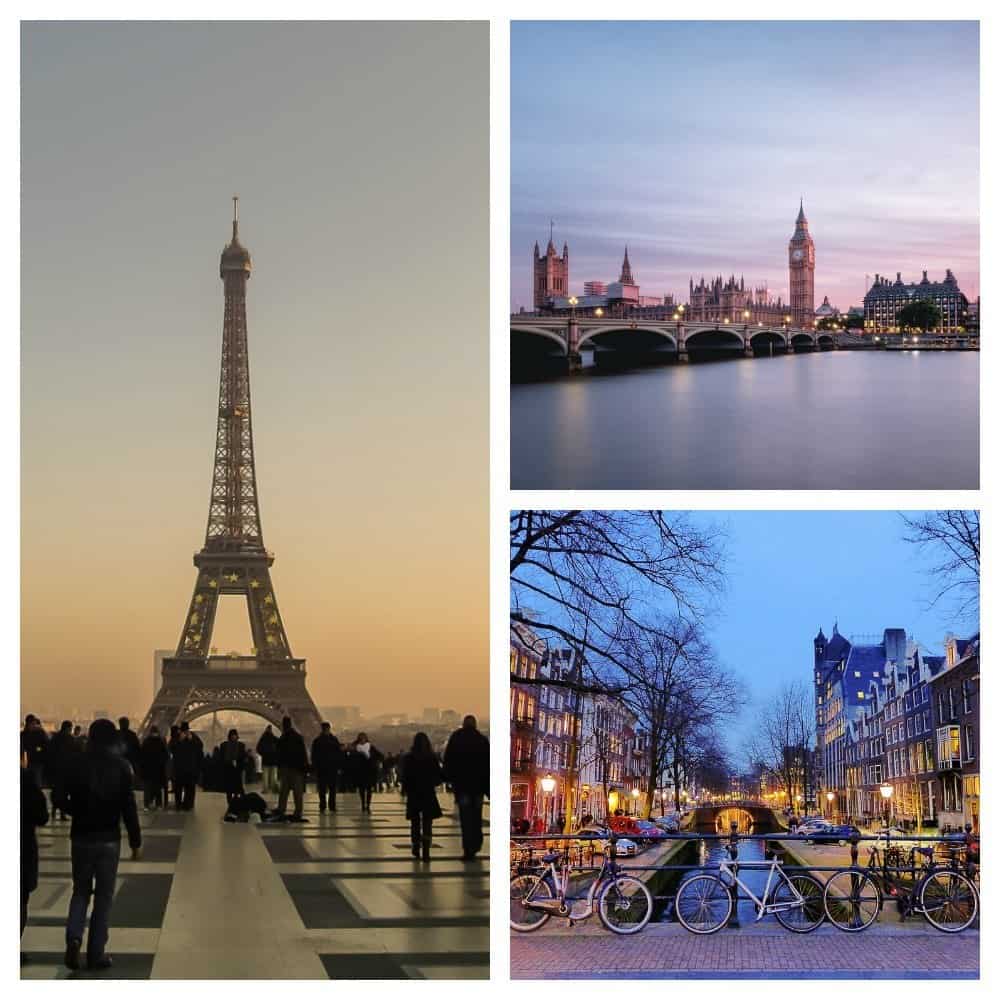
You have excellent direct flights, trains, or bus connections between all three. There are overnight trains between Lisbon and Madrid that run daily, departing at 11:34 p.m. and arriving in Madrid at 8:40 a.m. Also, there are direct flights, trains, or busses from Madrid to Barcelona.
All these Iberian cities are packed with culture, culinary delights and incredible landscapes. They are easy to reach from most major airports from around the world.
Although you could easily spend two weeks in Spain alone, visiting other historical places like Toledo , or Cordoba for instance, I suggest including Portugal in your European itinerary as well. Lisbon , its capital city, is not only very romantic and cultured, but also quite inexpensive.
Book this private walking tour of the highlights of Lisbon and enjoy the history of this city.
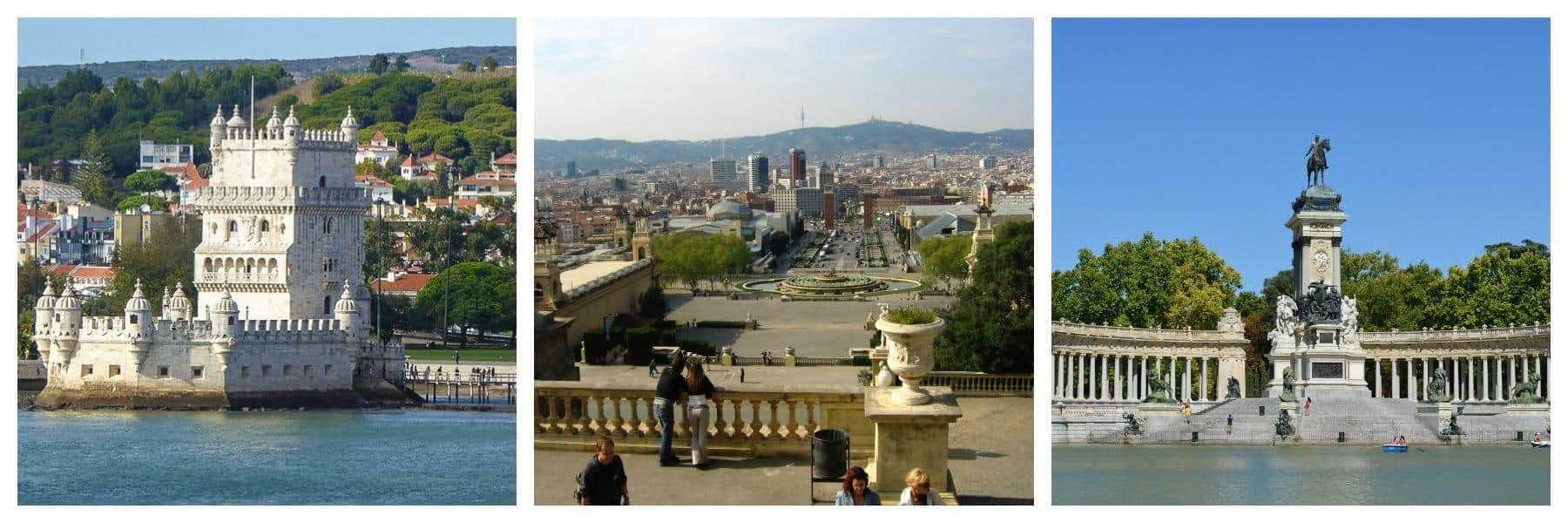
These are three of Italy’s most captivating and rewarding cities. If you like archeology, you’ll love Rome ! Florence and Venice are also very charming cities, although quite different from Rome. If you prefer to spend your time in one single country, this combination is one the best itineraries for a 2 weeks trip to Europe.
Italy has a wealth of archeological sites, most of which are concentrated in relatively compact areas. These three cities also have excellent train, bus, and plain connections (buy your ticket on omio.com ).
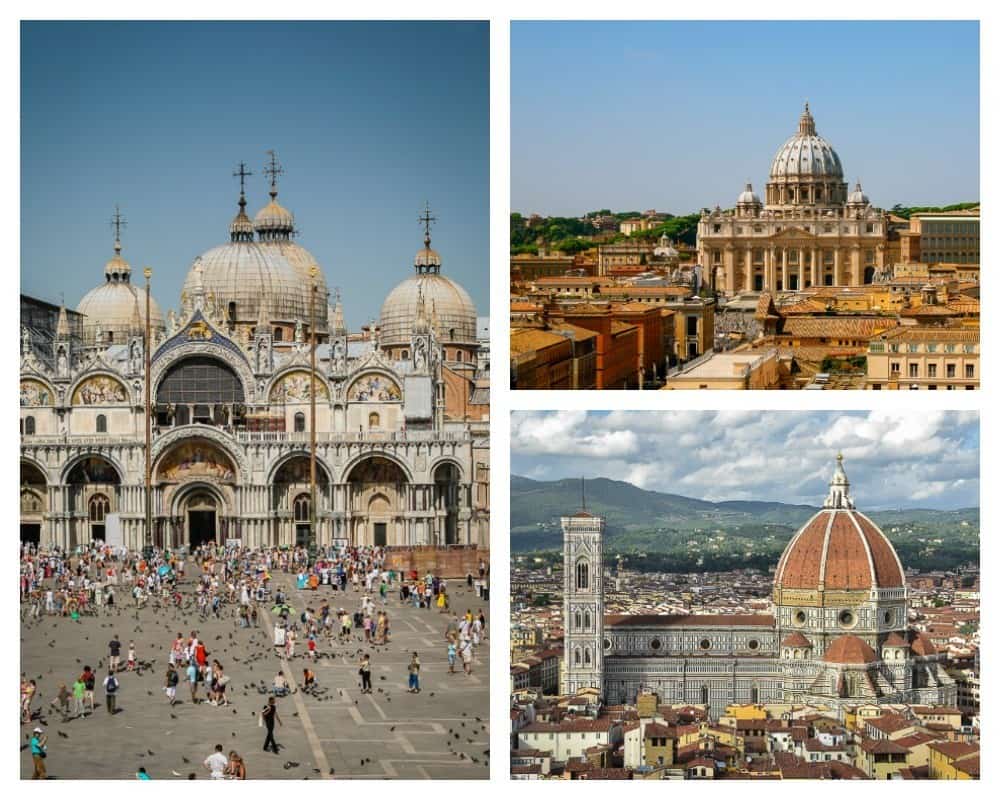
Sicily is another great place in Europe where you can easily spend 2 weeks. There are so many archeological sites and beautiful towns in Sicily to add to your list! I promise that you won’t get bored if you choose to spend your entire European vacation on this island.
Palermo alone can easily justify a 10-day Italy itinerary . You have good bus connections between cities, but Sicily is best explored by car . You can choose visit the nearby Malta if you go to Sicily.
Central Europe 2 Weeks Trip Itinerary
Central Europe is becoming increasingly popular. 30 years ago, cities like Prague , Budapest , Dresden, or Wroclaw were largely unknown to the world traveler. But after the fall of communism, Central Europe experienced a strong cultural and tourist revival.

These three capitals have it all: beautiful architecture, fascinating history, packed concert calendars, and delicious food. For those who want to tour Central Europe, this trip itinerary is perfect.
Traveling by rail is the best way to go between these three, as distances are relatively short. You can buy tickets at the station right before the train is scheduled to depart.
READ NEXT : Budapest Travel Tips and Practical Information for First Time Visitors
• Berlin, Dresden and Wroclaw
Combining the cosmopolitan Berlin with the phoenix-city of Dresden and the picturesque Wroclaw, will give you a great understanding of what makes this part of Europe so fascinating. You have direct trains between all these cities.

• Zurich, Lucerne, Lugano and Milan
You can never go wrong with Switzerland and the northern part of Italy! Cities like Lucerne, Zurich, Lugano and Milan have stunning scenery, art museums, old cathedrals, historic palaces, and more charm than you can imagine. However they are not very big, so 2-3 days in each one would most likely be enough.
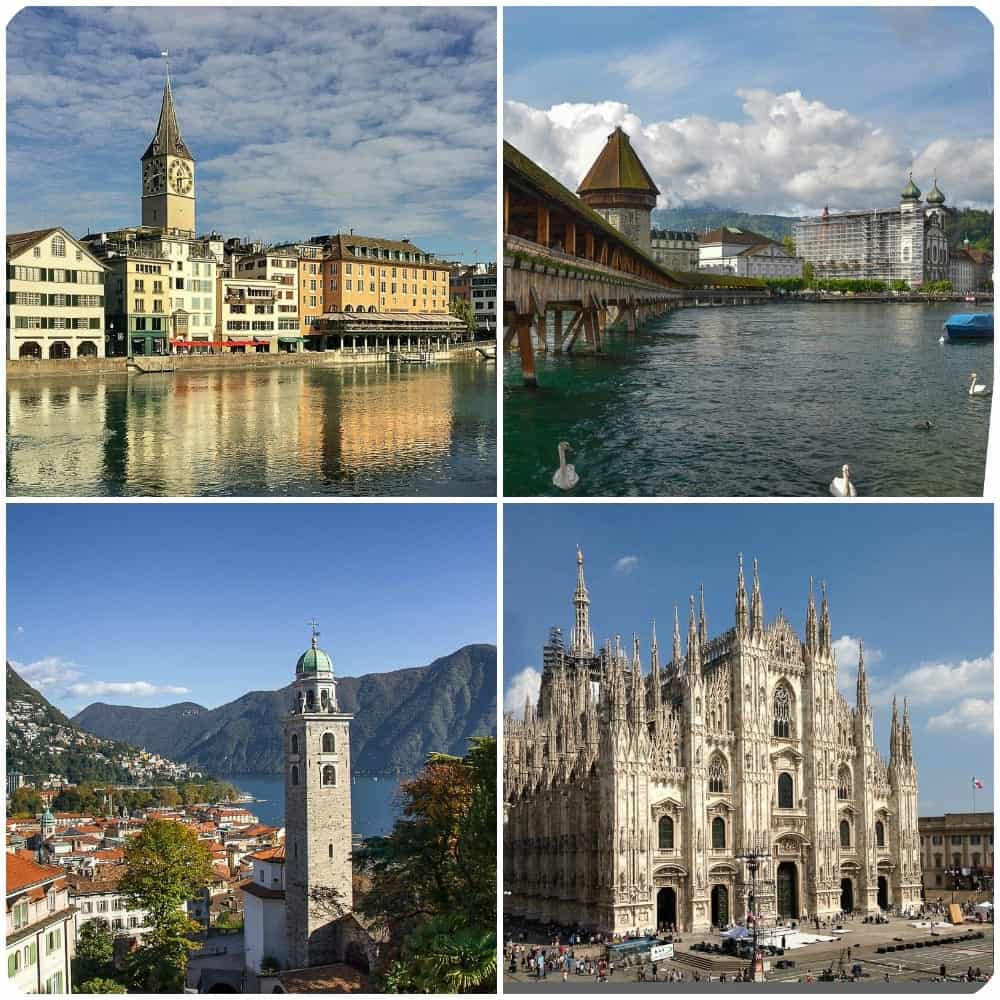
The best way to move between these cities is by rail. Switzerland is famous for its top of the line panoramic trains , so you can choose to travel from Lucerne to Lugano aboard the Gotthard Panorama Express. You can also take the same route on a non-panoramic train if you want to avoid paying the mandatory reservation fee.
READ NEXT : 10 Days in Switzerland Itinerary by Scenic Trains
Northern Europe 2 Weeks Itinerary
• oslo, stockholm, copenhagen .
These three cities are definitely in a league of their own. Although they can’t compete with Rome’s historic sites or with the charm of Paris, Copenhagen , Oslo and Stockholm have stunning architecture, world-class museums, and some of the best shopping and dining in Europe.
If you plan to spend your 2 weeks vacation in Northern Europe during the summer months, this trip itinerary is your best bet. While the rest of Europe is be boiling hot, Northern Europe enjoys much cooler temperatures and longer days in summer.

READ NEXT : 10 Fantastic Things to Do in Stockholm in a Week
• Riga , Tallin, and Vilnius
I can’t mention Northern Europe without including a tour of the Baltic capitals. The Baltic States of Latvia, Estonia, and Lithuania weren’t even on the map when I was growing up. But like many other European countries that lived in the shadow of the Soviet Union till the 90s, they have enjoyed a true renaissance in the past years.
If you want to travel somewhere your friends haven’t even heard of, you should visit the Baltic capitals. Plus these are among the cheapest countries to visit in Europe .

South-Eastern Europe – 2 Weeks Trip Itineraries
The Balkan Peninsula is the most culturally diverse in Europe. This region has also an extremely varied topography. Bordered by the Adriatic and Ionian Sea to the west, Aegean Sea to the south, the Sea of Marmara to the southeast and the Black Sea to the east, the Balkan countries are stunningly beautiful.
There are so many great destinations in South-Eastern Europe, that it’s difficult to decide which ones to include into your trip itinerary. Here are two suggestions:
• Athens, Istanbul, Bucharest
If you plan to build your itinerary around these three cities, you could spend 3 days in Athens , 7 days in Istanbul and 2-3 days in Bucharest . Or you can choose spend your entire 2 weeks trip to Europe by visiting just one country. We did that last year and took a road trip in the Peloponnese. It was an unexpected success, it was pleasant and we had a great time there. Peloponnese is one of the less explored parts of Greece, but is so beautiful that you won’t believe. It has plenty of beach town, some of which are nicer and more sophisticated that the Ritzi Greek island, like the beach tow of Nafplio .
Countries like Greece , Turkey, or Romania have plenty of amazing sites to keep you entertained and engaged for 14 days.

The best way to travel between these 3 countries is by plane. Between Istanbul and Athens you an use Pegasus Airlines (a budget airline) and between Istanbul and Bucharest you can use Turkish Airlines.
• Ljubljana , Split , Dubrivnik, Kotor
These four cities will take you through 3 of the most beautiful countries in the Balkans: Slovenia, Croatia and Montenegro . The best way to travel between these cities would be by car or by bus, as there are no train connections between Split and Dubrovnik.
For those who want to rent a car to drive through the Balkans, I recommend this 14 days Balkans road trip itinerary . If you have a car, you can extend your itinerary to some other points of interest in this region.
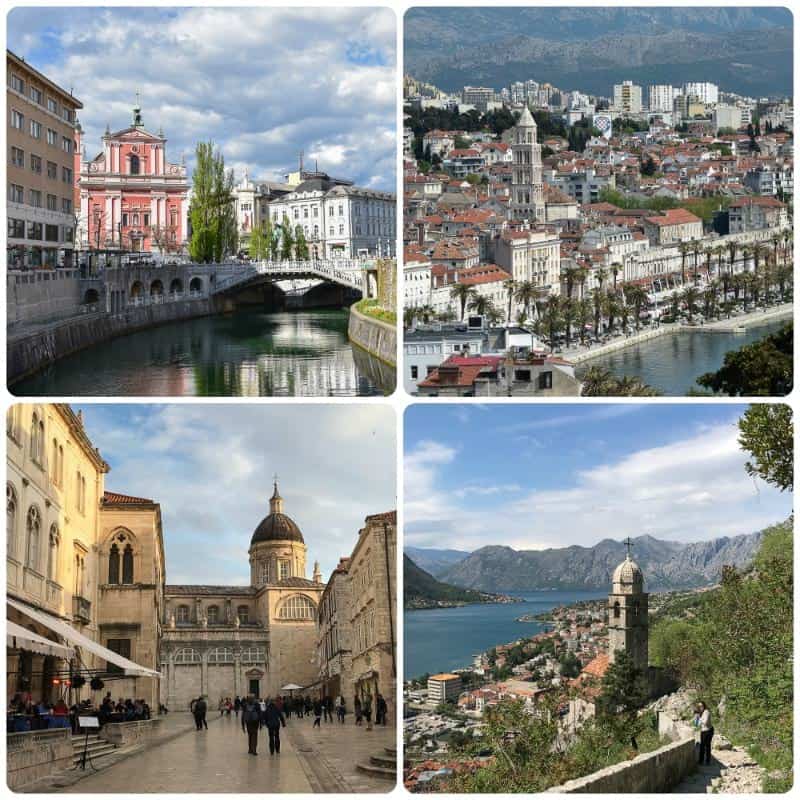
Planning a trip to Europe? Read next: 12 Tips for Traveling to Europe Like a Pro
Being born and raised in Europe I always get asked these two questions: when is the best time go to Europe and what is the best itinerary for a first time visit to Europe. My answer it’s always the same: it depends what you want to do in Europe and how much time you can spend there.
If this is your first time in Europe and all you have is 14 days, there are a few things to consider before deciding what to add to your list:
• Keep your travel plans simple
Most first time visitors to Europe are determined to see as much as possible on that first trip. Keep in mind that Europe is a big and diverse continent. There is a lot to see everywhere you go. Fitting all your bucket-listed locations in a 2 weeks trip to Europe is nearly impossible.
• Start with the most popular cities
Your first trip to Europe is not the best time to go off the beaten path. I recommend sticking to the big cities, even though they are more crowded. Major European cities have it all: top notch museums, beautiful architecture, great restaurants and a vibrant nightlife.
Besides, they are big transportations hubs and are cheaper for flying in and out of Europe.

• Choose to visit places that are close to each other
The closest major European cities are at least two hours apart, whether you travel by car, by train, or by plane. Transit between cities takes at least half a day, if you consider the time you need to check out of one hotel and check into your next one. Therefore, you won’t be able to do much sightseeing on the day you travel.
• Plan to spend at least 3-4 days in each city you visit
While it’s possible to cover more than half a dozen countries in your 14 days in Europe, just running between destinations doesn’t mean you actually visited them! If you want to see at least the major sights, you should plan to spend a minimum of 3-4 days in each city you visit.
• Book an open-jaw ticket
If you plan on touring a specific region or doing a multi-destination trip, you can often save a lot of time and money with booking one.
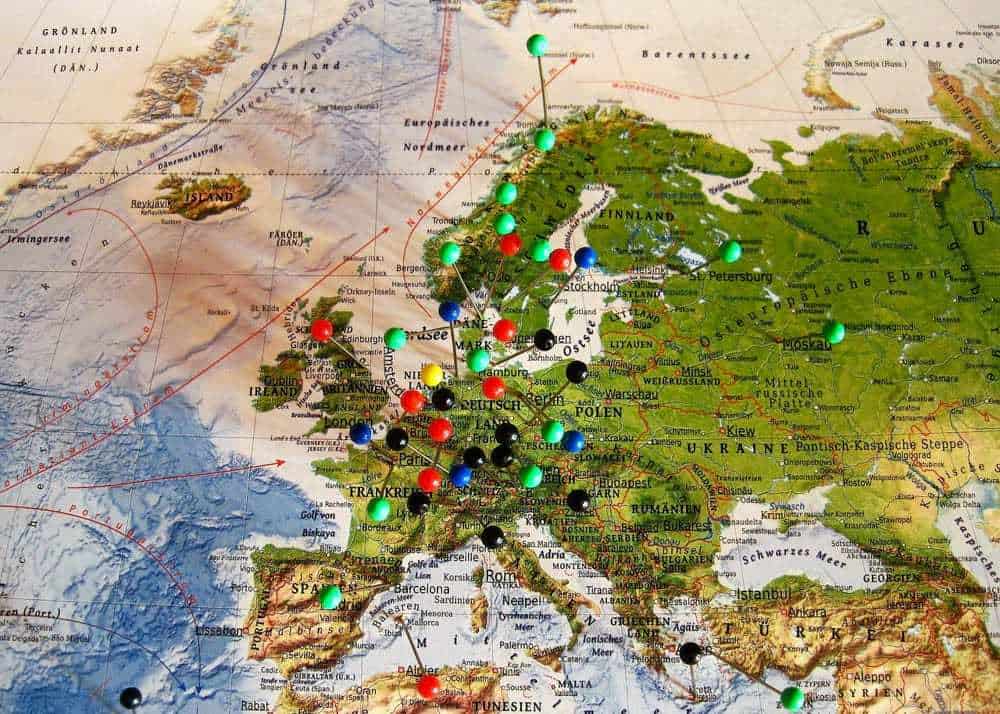
Once you’re further along in your planning process, you can use our Travel Resources page for the best deals in airfare, accommodations and local guided tours.
• Rent a car only if you are planning to travel outside the big cities, where parking is expensive and difficult to find. Nonetheless, sometimes renting a car will save you a lot of time and is obviously more comfortable. We usually use Discovercars when we travel in Europe.
Tips for Spending 2 Weeks in Europe
• book accommodations in the city center .
Hotel rates are higher in the city center, but it’s worth paying the extra dollars if you can afford it. You’ll save time and money on transportation.
• Use Hotel Alternatives
AirBnB or VRBO for lodging instead of booking hotel rooms, especially if you travel in a bigger group. They are a much better deal and have beautiful apartments all around the world. For the same price you would pay for an average hotel, you could rent an entire apartment.
• Don’t exchange money in the airport
Airports, train stations, or tourist areas have the worst exchange rates. But if you look for an exchange office outside these areas, your hard earned money can go a way longer way. If no exchange booths are around, use the ATM machines throughout the city.
• Consider using public transportation
Driving a car Europe is an expensive and inconvenient complication. None of these European cities were built with cars in mind, so the roads are crowded and full of restrictions. Rather than worrying about parking fees, one way streets, and pedestrian zones, consider using public transportation during your 2 weeks in Europe.
• Travel by train, or use budget airlines
Train travel through Europe is one of the best ways to see the continent. The rail network is extremely developed and train service is very reliable. For longer distances, flying one of the many European airlines is also a great option.
There are over a dozen budget airlines in Europe that fly anywhere on the continent for unbelievably low prices. They charge extra for seats and luggage, but even so you can fly for as low as €30-40/one way.
• Dress comfortably
Dressing comfortably when you travel to Europe is very important, but avoid looking like a tourist. Not sure how to blend in with the locals? Read my guide about how to dress like a European .
Buy the best shoes you can afford. I can stress enough the importance of wearing comfortable shoes while traveling in Europe. Many of the old European cities are still paved with cobble stones which are very rough on your soles.
• Travel off season
Everyone wants to travel when the weather is stable, but summers can be brutal in Europe: big crowds, expensive accommodations and airfare, busy trains and public transportation and very hot.
The best time to visit Europe is in fall or in spring, when temperatures are milder and there are less crowds. December is also a very popular time of year to visit Europe, when most European cities dress up for the holidays .
• Get acquainted with the European lifestyle
Most travelers to Europe expect to encounter cultural differences, yet when confronted with them they are always caught off guard. I wrote a very detailed post about what will surprise you as a first time visitor to Europe. These are very useful tips that you will need before traveling to Europe.
READ NEXT : 15 Cheapest Countries to Visit in Europe
This guide is a good resource if you intend to visit Europe independently. However, if you prefer an organized tour there are plenty of great tours of Europe to choose from.
Hope the itineraries above gave you some idea on how to travel Europe in 2 weeks. And if you like a place you saw, make a plan to return and explore it more in depth. Two weeks in Europe will not be enough to see this magical continent.
Did you enjoy this post? Please pin it to help other travelers to Europe:
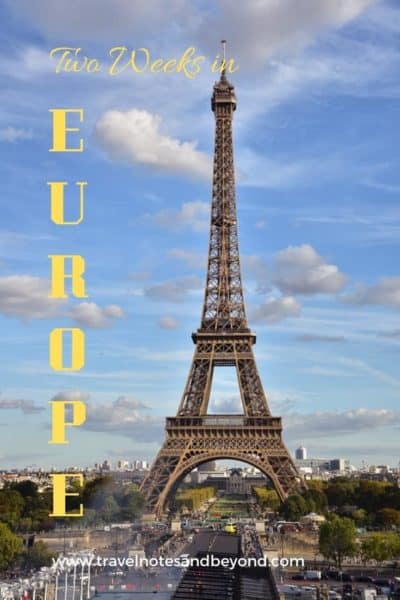
RELATED POSTS:
- 10 Most Beautiful European Cities to Visit in Your Lifetime
- Prague vs Budapest: Which City Is Better?
- Travel Tips For Europe (Don’t Get Caught by Surprise)
- What to Buy in Paris – 15 French Souvenirs Everyone Will Love
Anda is an award winning travel writer, avid globetrotter and passionate photographer. She is the voice behind "Travel Notes & Beyond," a collection of stories and travel impressions from her wanderings around the world. When she is not busy writing, traveling, or editing photographs, you can find her hiking in the foothills behind her house together with her husband and their dog.

Reader Interactions
Vipin Singh
January 13, 2024 at 6:56 am
Greetings from Singapore Anda. I am an avid traveler but have only done Asia so far. I am planning my first Europe trip in this upcoming June, mid month. I have circled down to 4 cities that iam keen on going to. But now, after reading much online, i figured that it will be more ideal to include just 3 cities in my itinerary. I had London, Paris, Rome, Spain (Madrid/Barcelo) in mind initially. I am looking for advice to reduce one city if needed for this trip. I have 13 days to spend (including arrival date to London in the morning before 7am. And excluding departure date) Appreciate your reply.
January 16, 2024 at 2:24 pm
Since this is your first trip to Europe, I’d go to London, Paris and Rome. I’m sure you won’t regret it.
Chetan Sahu
October 7, 2023 at 5:59 am
Planning my dream 2-week European adventure, and this guide is a goldmine of itinerary ideas! From the iconic cities to hidden gems, it’s packed with invaluable tips for an unforgettable trip. So, which European journey will I embark on? The possibilities are endless!
Chandra Bdr Gurung
July 6, 2023 at 11:43 pm
Excellent advice for those who are first-time visitors. This blog really impressed me. Europe has some really interesting sites to visit.
Ana Delos Santos
April 28, 2023 at 10:55 am
Hi, this is really helpful for 1st time Travelers in Europe. Just want to also ask you, for a 2 week Europe Trip, what do you advise to those traveling with Kids that wanted to visit countries in Europe with an Entry and Exit point from the Philippines? Thanks for the possible response. God bless you.
April 28, 2023 at 11:58 am
I am not aware that coming from the Philippines (with or without kids) may pose any problem for entering any country in Europe. However, if you want further more detailed information you should check the respective country’s entry requirements. Sorry I can’t be of more help.
basil swamy
March 22, 2023 at 11:36 am
Looking for Europe tour starting from India, for honeymoon would like to explore Europe. Places need to cover Norway Amsterdam Brussels Paris Switzerland Pissa Florence Rome Venice
Travel dates will be 9Jun to 29Jun It should be not very expensive , reasonable place to stay either good apartment or good Hotel You can suggest if some needs to be cut short or some other place. Do not want any museum or historical place to cover. It should be main and popular area only.
March 22, 2023 at 7:16 pm
I’m sorry, but I am not a travel agent, Basil. You can use my post for reference in order build your own itinerary.
July 13, 2022 at 2:52 pm
Great guide – but overwhelming!! My wife and I are taking our first trip to Europe next year – a long kid- and COVID- delayed 20th/25th/30th anniversary! – and want to make the most of our 3 weeks. But you just listed 31 must-see cities, and suggested 3-4 days per city!! 🙂
My wife wants to “see the highlights” – if we never can come back, what should we make sure we see? I think we’d probably be best served by a managed tour, but maybe I can cobble together something with even hand-holding? 🙂 Advice would be *so* appreciated!
July 13, 2022 at 6:16 pm
Hi Rick, Thanks for reading my guide. I have indeed 31 must-see cities in Europe, but those are 10 independent itineraries and each one of them is for two weeks. If you want to spend 3 weeks in Europe you definitely won’t be able to include all those places in your itinerary. I can give you a few suggestions for a 3-week itinerary, but planning the trip in detail will require a lot of effort from your part.
You’ll need to research each destination and decide what you’d like to see once you get there, book hotels, check timetables for trains and busses, or maybe rent a car in some places, etc. Since I don’t know anything about your travel style, I can’t tell you whether to attempt this trip on your own, or book a guided tour. Many people prefer to be care-free when they travel and just sit back and enjoy. We like to travel independently and do our own planning, but I can assure you it’s not easy. One other option would be to book local guided tours in each country, but travel independently between countries.This way you’ll have more control over what countries you may want to visit.
In regards to the “highlights” of Europe, there are so many! But regardless of what you choose, you shouldn’t include more than 4 countries in 3 weeks because you’ll have to account for the days you loose when moving from one place to another. Here are my suggestions. My first choice for Europe would be Italy, France and Spain. They are rich in culture and architecture and have gorgeous scenery. My second choice is Portugal, Switzerland and Croatia. Not as culturally rich as Italy, or France, but surely breathtakingly beautiful. If you are looking for less expensive destinations, Central and Eastern European countries are more budget friendly (Czech Republic, Hungary, Poland, Romania).
I hope this helps. I have lots of European destination on my blog in case you want to do some further reading. And remember: no matter what country you choose, you’ll love Europe!
July 6, 2021 at 11:40 am
Hi there Anda!
Me and my are planning eloping and then honeymooning to Europe. Neither of us have been and I have family in the Sicily area. I originally wanted to go to Hawaii as I am an avid beach lover and have been to many in search of the most beautiful beach. My finance enjoys the beach, but is definitely more of a historian. So, I would like to encompass a little of both. We plan on late September or sometime in October….14 days. What are your thoughts? Do you think we should use a travel agent? Thanks so much!
July 6, 2021 at 1:24 pm
Hi Carrie, September-October is a great time of year for visiting Italy and I think Sicily is a wonderful choice if you like beaches. It has plenty of historic sites, so it’s the best of both worlds: history and beaches. I have a lot of information about Sicily on this blog, so for further reading you can go under Destinations > Europe > Italy > Sicily and read more. I also have a very informative post about driving in Sicily, should you decide to rent a car for your trip.
I don’t believe you need a travel agent to design your itinerary or make reservations for you. At the bottom of my home page there are some links that you can use to check out prices. I also have a Resource Page if you need more information on car rental and lodging. And if you need more itinerary ideas, read this post: https://travelnotesandbeyond.com/10-days-in-italy-itinerary/ . It includes 4 itinerary ideas for Italy to choose from. Please let me know if you need any further assistance.
March 1, 2021 at 10:40 am
This is very informative. My husband and I have been to several countries in Europe, but not our son. He wants to go to Germany, and I think with more than 2 weeks travel time that we will have, a visit to several cities in Central Europe will make sense to us. My friend in Zurich will be happy to take us around.
March 1, 2021 at 7:38 pm
Hope you’ll get to visit Germany, Umiko. I have relatives in Münich and go to Germany quite often.
January 27, 2021 at 3:03 am
Hi Anda, I have to say, this is a great itinerary for first time travelers. I’ve been living in Europe for almost 2 years now but I still have not seen most of the places in this list and I would consider myself a “first time traveler” to most of these destinations. It gave me tons of ideas though once we finally get to travel again and I love your pctures.
January 28, 2021 at 2:05 pm
Thanks, Marielle.
I love Croatia
January 9, 2021 at 6:09 am
Absolutely stunning! Thank you on a detailed impressive guide!
January 9, 2021 at 10:51 am
Thanks, Karlo.
October 22, 2020 at 8:00 am
Hi Anda! Thank you for all of your articles and tips! I’m trying to soak everything in while planning for a 2-week trip next August 2021. I know you said August is the worst time to go to Europe but I am to be a part of a bridal entourage early that month and have no leeway in that regard – hoping to make the best of it! What are your suggestions for 3 first time Europe travelers to make the MOST of our time but with about three days locked in at London for the ceremony? I was thinking of coming a week before the festivities and staying a week after, putting the wedding in the middle of the two weeks – if that makes sense. Please help! Thank you so much, Christine
October 22, 2020 at 4:59 pm
Hi Christine, A wedding in London sounds like a great reason to visit Europe. The good news is that London is not so hot in August as other cities in Europe. Here are my recommendations for you:
1. I would get the wedding out of the way and then go on with my travel plans. Or leave it for the end of the trip, but not place it in the middle.
2. I would avoid big, crowded cities (like Paris or Rome) where the asphalt radiates even more heat in summer. Keep in mind that many of the buildings in Europe don’t have air conditioning, so there is very little relief from the heat.
3. Rather than big cities, I would visit places that have a breeze, or have access to the Mediterranean, or the Adriatic Sea. My personal favorites for summer are the French Riviera (Nice, Monaco, Cannes), Italy (the Amalfi Coast, or Sicily), Croatia’s Dalmatian Coast (Dubrovnik, Split, Pula, etc.) Italy, France and Croatia seem like good options for you since they are also close to England.
4. Other great countries to visit in August are: Austria, Switzerland and Germany. For instance, you could spend 1-2 days in Vienna, then go to Salzburg and use it as a base for wonderful day trips in the Alps. Or stay 2 days in Zurich and do a Switzerland itinerary. You can also do a combination of countries, but I wouldn’t visit more than two considering that you already have London on your list.
Hope this helps. Please let me know if you have any further questions. I’m sure your trip is going to be great!
October 18, 2020 at 11:25 am
Hi: A friend and I would like to visit somewhere in Europe for 2 or so weeks, and stay in a smaller village and “live” like a local. Yet, also be close enough to other places or countries to take day trips via public transportation. Any suggestions?
October 19, 2020 at 4:47 pm
Your friend could stay for instance in one of the many villages on the French Riviera (like Ezé Village) which are close to Nice,and visit the the entire coast in two weeks. Or perhaps stay in one of the villages in Tuscany, which are close to Florence, and many other fascinating places in Italy.
RAJEEV JAIN
October 6, 2020 at 10:14 pm
Me & my wife wants to cover Europe in 20-30 days. Just for your information I had travelled to Italy & covered Rome, Florence, Venice & Milan. I want to cover other countries & beautiful cities of Europe. Can you suggest best time & an itinerary to visit except July/August when the weather is pleasant & one can travel in budget.
October 7, 2020 at 4:23 pm
Hi Rajeev, late September to early October is a great time to travel to Europe. So is spring, late April to early June. As for an itinerary, you can cover a lot of territory in a month in Europe. I would suggest visiting some of the countries in the Balkans (Croatia, Montenegro, Slovenia).I have a complete itinerary for the Balkans on my blog, if you are interested. Also, you could visit the Baltic countries (Estonia, Lithuania, Latvia) and Sweden. Eastern European countries like Hungary and Romania are also good choice for a fall visit. Hope this helps.
Mitos Soria
February 13, 2020 at 6:19 am
Hello, me my friend will be traveling to Europe in August 2020 ( I know not a good time to go there) for the first time. We have 2 weeks to go to cities we prefer. And that is Italy and Paris. We are in for outlet shopping, visit museum and architectures. Can you recommend us a place to go to met our preferences? And if we would add one more country what would that be? By the way we are flying from Manila. Thank you very much.
February 13, 2020 at 11:09 am
Hi Mitos, even though August it’s kind of hot in Europe, I’m sure you’ll have a lot of fun. Especially if you plan to go shopping, hahaha! Paris and Rome are great places to shop and so is Milan and London. I also like shopping in Vienna, where they have a big pedestrian area (the Graben) lined up with stores. All these cities have magnificent architecture, old churches and palaces that you can visit. Prices are a little higher in Europe than they are in Asia or the US, but I love shopping there just the same. They have so much trendier clothing stores than we do. My favorite one is Massimo Dutti, you should check it out.
SHYAMSUNDER GAIKWAD
February 2, 2020 at 3:29 pm
Hi Anda, Me and my wife plan to travel to Europe for about 10 to 14 days(depends) from the first week of August’2020 (After my sons final semester Exams). Flight ticket are yet to be booked. This would be our first trip to Europe. We plan to cover Europe in six visits, this would be our first. Both of have past our half century mark and have taken a sabbatical. Could you please suggest us an Itinerary? Is August a good time to travel
February 2, 2020 at 3:30 pm
Hi Shyamsunder, August is one of the worst times to go to Europe: it’s hot, it’s expensive and it’s crowded. I know you may be bound to your son’s vacation time, so if August is the only time you have available, I would suggest going to Northern Europe. You can visit Sweden, Norway, and the Baltic countries (Lithuania, Estonia and Latvia). Either that, or choose to spend your entire vacation in southern Italy, in places close to the sea (Capri, Positano, Cinque Terre, or Sicily).
January 27, 2020 at 1:23 pm
Thanks for your insight and prompt response. Travel planning can be overwhelming and your site has been extremely helpful. The more I dig into options and different itiniraries my gut keeps saying to stick with Italy and you helped confirm this even more! Another thought was to combine a 7n cruise but again my gut (and hubby) prefers a land based trip. So sticking with Italy it seems just 3 cities maybe better (based on your suggestion) with day trips mixed in…Venice, Rome & Florence. Initial plan was for Cique Terre which maybe too much. The idea of Lake Cumo is a really good one! Now need to explore those logistics!
Anda Galffy
January 27, 2020 at 1:28 pm
Glad I could be of help, Sandra. Just one last note: keep in mind that Rome is a big city, rich in history and archeological sites. You will need at least 4-5 days to explore it properly. Have a wonderful trip.
January 27, 2020 at 1:22 pm
Hi Anda, Just found your site and love the information. We are late in planning our 20th anniversary trip to Italy in May. We have 16 days so 14 nights exculuding travel. This is our first time to Europe (other than Greece) in a very long time. Initial thoughts are fly into Venice 2n, Florence, 4n, Cinque Terre 4n, Rome 4n – Now second guessing about all Italy (which I know is all good) but maybe adding Amsterdam or another city and subtracting days from Italy. Any thoughts input appreciated!
Hi Sandra, first of all congratulations on your 20th anniversary! Italy is a great choice to mark this important event in your life and I’m sure this will be a trip to remember. My personal opinion is that Italy has so much to offer that it’s not a good idea to add Amsterdam to the mix. The two-week European itineraries I recommend in my post are for people who want to get a feel of Europe and explore some of the big cities. I think you’ll be better off spending all your time in Italy and exploring as much as you can there. Instead of Amsterdam, you could go to Lake Como, for instance. It’s a very romantic destination for an anniversary.
January 18, 2020 at 10:37 pm
Anda So glad I found your site. I’m in the beginning stages of planning a trip for late 2020 (Christmas time) for my husband and myself. I think you’ve helped me decide on Italy. Christmas is the only time he has vacation so we’re locked in to that time of year. We’d both like to see Pompeii, so I was thinking Naples to Rome and ending up in Venice. We have 2 weeks, so I think we could take our time and stop if we’d like to see something along the way. What do you think about going to Italy this time of year? Are trains reliable in winter? Thanks for any help you can give me. Karen
January 19, 2020 at 12:01 am
Hi karen, Italy is actually a great choice for winter, particularly in December when you’ll have the Christmas markets everywhere. Prices may be still pretty high because of the Holidays, but there will definitely be less crowds. You may expect colder weather in Northern Italy (Rome and Venice), but the Amalfi Coast (Pompeii and Naples) will be beautiful. I don’t think you’ll have any issues with the trains. It doesn’t snow often in northern Italy and even if does, the weather doesn’t impact public transportation. I think you’ll enjoy Italy tremendously! It’s a great place to visit. You may want to check this post as well if you are traveling to Rome: https://travelnotesandbeyond.com/best-areas-to-stay-in-rome/
cybele ryan
January 23, 2020 at 3:35 pm
Anda what wonderful information. My husband and I planning a trip to Europe in mid May for two weeks. Thinking about flying into Switzerland or Austria, dipping down into Italy then on to Slovenia and Croatia. We are told Slovenia is very similar to Italy. We could stay in Slovenia and train over to Venice for the day, avoiding crowds ect. Any ideas? take the train, rent a car?Thank you! Cybele
January 23, 2020 at 5:52 pm
Train is probably better for the day trip. Besides, in Venice you won’t have any need for the car.
December 31, 2019 at 4:44 am
Hullo Anda, your article literally saved my life. I have read it twice and sucked in as much of your advice so thank you. I am black and I was wondering if you have any specific advice for a black travelers in Europe. What is the general reception for black africans in Europe? I may be overthinking it, but I am worried that it may be negative. Your honest thoughts will be appreciated. thanks.
December 31, 2019 at 3:39 pm
I’m truly happy that my article was of help to you. I don’t think you have any reason to worry about traveling to Europe as a black person. As far as I know, Europeans are quite open and welcoming to any race and nationality. I think you’ll have a wonderful time there.
December 28, 2019 at 6:04 am
Thankyou for the suggestions. We are planning to visit Europe from US for two weeks from April 24 to May 9 . Our itenrary idea is to arrive in Paris > Milan > Venice > Cinque terra> Florence > Rome . While at florence we planned to visit Pisa for half day Will this be aggressive or Do-able? Can you please suggest on how many days each city require to explore? Thanks in Advance
December 28, 2019 at 9:15 am
Hi Satya, What you are listing here looks like a very busy itinerary. All these cities are loaded with attractions. Besides, you need time for transportation between the different destinations and time to check in and out from the hotels. Rome and Paris require at least 3 days each. Milan you can probably do in a day, but for Florence, Venice and Cinque Terre you’ll also need a minimum of two days. My suggestion would be to leave Paris for another time and concentrate on Italy.
December 28, 2019 at 7:44 pm
Thank you Anda
December 26, 2019 at 10:30 am
Hi Anda, Thankyou for the detailed itenenaries. We are planning for Europe trip during last week of April for two weeks. Our plan is to arrive in Paris and depart back from Rome. So planning for Paris> Fly to Milan> Venice> Cinque terra > Florence> Rome . Is this agressive or Doable? Do you recommend driving from Milan to Rome for this trip? Can you help me with how many days we will needing to explore these places? Appriciete your help on this.
December 18, 2019 at 12:59 pm
Hi Anda, I am planning a trip with my wife and 2 kids (3 & 9) to visit Europe in Mid-June. we are planning to spend 14 days and planning to land in Paris then train to Zurich > Interlaken (might add Zermatt if time permits) > Venice > Florence > Rome. Does this sound doable in 14 days? Any tips and recommendations? Should we get the Euro Rail Pass or buying individual trip will be better and cheaper option? Thanks.
December 18, 2019 at 7:27 pm
Hi Ali, your plan sounds great for two young adults who can move fast. However, with two kids in tow and using public transportation (not having your own car) this sounds like a very busy itinerary. You need a minimum of 3 days in the big cities like Rome and Paris. As for Zurich, Venice and Florence, you could probably spend only 2 days in each city. But even if you do that, you’ll be left with only two days, which is not enough time if you want to squeeze in Zermatt and Interlaken. I understand you are planning to use Rome as your departure city, but exploring it with a 3-year old will be very difficult. Rome is huge and truly overwhelming, even for adults. I would suggest spending more time in Switzerland instead, which is a friendlier place for small children. You can buy a pass for the scenic trains and go from Zurich to Lucerne, Interlaken, Zermatt, St.Moritz, Engadin and maybe cross over to Lake Como in Italy. The Glacier Express is a fantastic train and goes from Zermatt to St. Moritz. Your kids are going to love the train rides. I wrote a few posts about our train trip through Switzerland, in case you need more information.
November 14, 2019 at 4:16 pm
Hi, my husband and I have plan 13 days trip 11 nights for travel to Barcelona, Switzerland, Munich and Amsterdam. The 1st arrival destination has decided is Barcelona as we want to catch the football match. 2nd destination we not sure want to start from Amsterdam, Munich and end in Switzerland or vice versa. Is it possible to squeeze Milan or Paris in between by the way?
November 14, 2019 at 5:09 pm
You can easily squeeze one day in Milan on your itinerary, Agnes. I wrote a post about how to spend a day in Milan, in case you are interested you can check it here: https://travelnotesandbeyond.com/one-day-on-the-streets-of-milan/ . From Barcelona you can go to Milan, then to Switzerland, Munich and Amsterdam. Not sure exactly what means of transportation you intend to use in Europe, but it makes sense to do it this way rather than jump from Spain all the way to the Netherlands. In regards to Paris, I would leave it for another trip. There is too much to see there to be able to squeeze it into this itinerary. You’ll need at least 3 days for it, while Milan can be done in one day.
November 5, 2019 at 6:20 pm
Hi Anda.. Greetings from Malaysia.!! Great advice for first time traveller to europe. Me and my friends planning to come over to europe in may next year. We are having some difficulties choosing places to visit as europe is super big and all the places look so beautiful. We will be landing in amsterdam. I would love to go paris,london n also swiss. And we have only two weeks to cover and we have no idea where to start. Super confussed. First time in europe.! Thank you.
November 5, 2019 at 9:30 pm
Hi Reva. Since you land in Amsterdam you could probably do Amsterdam, Paris and London. You need to spend at least 3 days in each of these cities in order to see at least the main points of interest. You probably have time to see one city in Switzerland as well. I would recommend Lucerne, since it’s a smaller one and can be done in about two days. Hope this helps.
September 14, 2019 at 4:10 am
Great suggestions! Planning a trip next June ( I know, I know), your suggestions are great.
September 14, 2019 at 2:10 pm
I’m glad if you found my suggestions useful. Thanks, Jackie.
April 21, 2019 at 6:25 am
Anda, thank you for the very informative article. Loved going through it and your detailed responses to the questions below. I and my wife are planning to travel in August(2nd and 3rd week). We have zeroed in on France(only Paris) and Italy. I know the temperature will be on the higher side, but I guess should be a breeze considering we are from India 🙂 (or are we way off the mark?) What according to you are good destinations to include in the itinerary in Italy, beyond Rome, Venice, and Florence)?
April 21, 2019 at 9:31 am
Hi VB, since your trip to Europe in in full summer, I would suggest a couple of destinations closer to the water. In Italy you can add Cinque Terre and maybe Lake Como. Both of them absolutely spectacular. In France, just about an hour away by plane you can go to he French Riviera. The coast is much cooler and absolutely spectacular. You have places like Nice, Monaco, Cann, Antibes, plus the many perched villages along the coast that are absolutely a dream to visit. Hope this helps.
April 9, 2019 at 8:56 am
I was trying to plan a 20th anniversary trip for myself and my wife in July, 2020. I was planning on just doing a Western trip visiting London, Paris, Brussels, Amsterdam, and Berlin but now I’m worried it’s going to be too hot. We already live in Charleston, South Carolina (US) which is miserably hot in the summer so we always try to find cooler places to go.
I was thinking of this route because there are now direct flights from CHS to London and I get employee discounts at Hilton properties (about $50 USD/night). There are hotels all within 1.5 miles of the train station in each of those cities so this would be most economical.
I would rather visit Northern Europe because of the cooler weather and because my family immigrated from Sweden. However,, there are no Hilton properties in any of the Scandavian cities except Stockholm.
I’m just wondering if you think it is worth it to spend a lot more to visit Northern Europe or just battle the heat and crowds to visit Western Europe.
April 9, 2019 at 10:15 am
Hi Michael, Europe is very hot and humid in summer, as you already know. I would rather spend a little more and go to countries like Norway, Sweden or the Baltic countries (Estonia, Latvia and Lithuania). I believe there is a Hilton in Riga as well, if I am not wrong). However, you may want to look into Airbnb as an alternative if you can’t find a Hilton. Most of the time they are way cheaper than a hotel and you get much more for your money.
April 7, 2019 at 11:25 am
This is a great guide! I’ve been searching everywhere for ideas on how to go about a European trip. I’ve never been so I wasn’t sure where to start. Is it possible to do a trip with London, Paris, Amsterdam, Rome, Florence, and Venice? What would be the beat way to do that?
April 7, 2019 at 8:54 pm
Squeezing 7 cities of this size into a 2 weeks trip seems too much to me. I would recommend keeping it at 4, at the most. You will spend too much time on the road and too little time visiting the sites. Florence and Amsterdam could be done in about 4 days, if you just want to rush by, but the other cities requires way more time for proper visiting. I would not advise you to add more than at the most 5 cities to your itinerary, unless you have more than just 2 weeks.
April 6, 2019 at 3:28 pm
Hello Anda,
This article is very informative and useful as I am planning a graduation gift for my girlfriend this summer. She’s a mechanical engineer and loves architecture, but has never been to Europe. I do plan on 2 weeks, give or take a few days. Do to the traveling being in June (not the best time), where would you recommend going? Regarding weather, locations, travel season, etc. I’ve only been to France but was there for wine industry. I’m fine with traveling by train or by car as I have done both. Please let me know if you have any questions or concerns. Thank you for your time!
April 7, 2019 at 9:01 pm
Hi Nick, I’m glad you found my post useful and informative. Summers in Europe may be very hot, so I would recommend you go to Northern Europe, where the weather is much cooler. And if your girlfriend loves architecture, she will have a blast visiting cities like Stockholm and Riga. I would recommend the Baltic countries and Sweden. You don’t need to drive there. You can fly between the cities for very little money.
March 31, 2019 at 7:45 am
Hi, Anda. I’m taking my daughter to Europe in May. Got a great R/T flight into (and out of) Barcelona. We will be there 2 weeks, and I’d like to add 3 other cities. She really wants to go to Florence (but not Rome??♀️). We plan to book a rail pass and Air BnBs. Any recs for our 3 must-see cities. She’s 20 and has never been to Europe.
April 1, 2019 at 1:00 pm
Hi Stacy, Barcelona is a very exciting destination for young people. I’m sure your daughter will love it. You’ll have to decide how many countries you want to include in your two weeks trip. You have quite a few choices in Spain, if you decide to stay only there. You can spend 3 days in Barcelona, then go towards the west and Visit Madrid (3 days), Toledo (a day trip from Madrid), Granada and Sevilla. From there you can fly back to Barcelona. Or you can spend a few days in Barcelona, then go to Paris, Milan and Florence. The second option includes 3 countries, but it will give your daughter a taste of some of the most impressive cities in Europe. Hope this helps.
February 26, 2019 at 9:36 am
I will be visiting Europe for two weeks in may and would like to know what do you suggest we could see as we will arrive in Rome and depart from Paris.
February 26, 2019 at 4:56 pm
Hi Rhea, May is one of the best times to visit Europe. The weather is just perfect and the tourist season is not in full swing yet. Since I don’t know you and your interests, I would make some suggestions based on my own taste and experience. Both Rome and Paris are very big cities and you might want to allow yourself at least 3 days in each one of them. They are packed with attractions, ranging from historic sites and landmarks, to museums, art galleries, parks and restaurants. In Rome you might want to concentrate on the historic center (including the Vatican) and allow yourself a little time to simply wander the streets and admire the beautiful architecture. I wrote a post about the best areas to stay in Rome that will give you an idea about what attractions are in the different parts of the city ( https://travelnotesandbeyond.com/best-areas-to-stay-in-rome/ ). While you are in Italy, you might also want to include Florence and Milan in your itinerary. Florence is not very big and it quite easy to explore (great for art galleries and museums). You could spend 2 days in Florence and one day in Milan ( https://travelnotesandbeyond.com/?s=one+day+in+milan ). From Milan you could go to Switzerland and maybe take a scenic train trip through Zermatt, Interlaken, Lucerne).Or you may go directly to France and visit Marseille, Lyon and then Paris. If this is your first time in Europe I would suggest keeping it simple. Probably just Italy and France would be enough. For Paris, you might want to refer to this post that will give you an idea about what you can see in 3 days: https://travelnotesandbeyond.com/?s=3+days+in+paris . I hope this helps and I hope you’ll come back with some great memories from your trip to Europe.
January 31, 2019 at 9:46 pm
Hi Anda Me and my husband are planning a trip to Europe for 2 weeks in early May 2019. As of now we are planning to visit Prague, Vienna, Budapest & Greece. Could you please suggest if its doable also if its the good time to visit these places.
P.S : We will be visiting Europe for the first time and we are more inclined towards scenic and natural beauty , could you please suggest more affordable options.
Many Thanks ! Parul
January 31, 2019 at 10:20 pm
Hi Parul, Europe is beautiful at any time of year, but particularly in spring. Vienna, Budapest and Prague are very close to each other so can move easily from one to the next (either by train or by car). Trains are very affordable in Europe, especially if you buy a pass. I suggest spending 3 days in each one of these cities to at least get a taste of what they have to offer. You could leave Greece for last, as you will need to take a plane to get there. In regards to affordability, Europe in generally expensive. However, you will find Budapest (and Greece) more affordable overall. For lodging I use Airbnb or VRBO (Vacation Rentals By Owner), as I get more for my money. Hope this helps.
Vaibhav Jain
February 2, 2019 at 10:21 am
Hey, thanks for this informative and detailed info about getting around in Europe.. every word made sense to me.. I just want a small suggestion from you.. I am solo traveller and will be starting my itinerary as “Prague (2n)-Copenhagen (4N)-Budapest (2N)- Barcelona (3N)- Amsterdam (2N)” in total of about 13 N starting from 13 th March 2019.. My question is : I want to add another city between my trip from Copenhagen to Budapest as I think 4 Nights will be too boring in there.. so can you please suggest which place to add in for 1 N ??? I am getting some real good deals for Brussels, Berlin, Milan… for Ryan Sir & Easy jet from Copenhagen.. please enlighten me for this as I am super confused ??? Thanks in anticipation ….
February 2, 2019 at 3:18 pm
Your itinerary seems pretty busy for 13 days. All these cities you selected make wonderful destinations in themselves. You could easily spend 13 days in each one of them and still have plenty to see and do. My suggestion would be to spend 3 nights in Prague or in Budapest, rather than trying to squeeze in another city into the itinerary. Europe is packed with attractions and if you were to spend any less than 3 days in a big city you’ll be rushing too much. However, if you want by all means to include another city, you can try Milan. You can just concentrate on visiting the Duomo and the area around it and that would be enough for one day. Hope this helps.
October 1, 2018 at 10:41 am
My family has a two week planned trip to Europe and I am having difficulty picking a third location to visit in addition to London & Paris. I am glad I came across your website which is full of good ideas. I could use some help picking a third city and places to stay. One of my challenges for the trip is traveling around Christmas which I understand the trains close.
Some of the other questions I have are: How long is it recommended to be at an airport before a flight between cities like London & Amsterdam? Is taking a train recommended even though it takes twice as long.
Where are the best areas to stay in London, Paris, Amsterdam and Ghent? We would like to rent an apartment in each city.
We arrive at 6:15am on 12/21 in Gatwick and leave on 1/3 in the evening out of Heathrow. What might be the best itinirary taking into account Christmas and New Years?
Thanks, Michael
October 3, 2018 at 10:24 am
Hi Michael, I’m afraid I can’t make any specific recommendation in any of these cities. We usually stay in Airbnb apartments when we don’t stay with friends or relatives in Europe.
Rob+Ann @TravelLatte(.net)
July 27, 2018 at 4:36 pm
You are so right, Anda – Two weeks in Europe will fly by! We love your itinerary ideas though. Two weeks is such a short time for so many great places to see and enjoy, but these really help make the most of the time. Can’t wait to get back and explore more!
Jennifer Melroy
July 27, 2018 at 2:38 pm
I love exploring northern Europe. The cities have a charm that the rest of the continent lacks. I can’t explain it, but they do. I always feel like they are more welcoming as a city. Plus Stolkhom has the best museums to visit.
Suruchi Mittal
July 24, 2018 at 10:36 am
That is a complete exhaustive guide on Europe. I liked the way how you have divided the itinerary and it is going to be super helpful while we plan up our trip. The 2 weeks really seems like a less time now, for Europe.
Cynthia | Adventuring Woman
July 23, 2018 at 5:12 am
You’ve covered all the important things! I agree that Paris, Amsterdam and London should be #1. I really want to do Vienna, Prague and Budapest. Also the Balkan itineraries. So true that it’s best to spend time really experiencing a place, rather than running around between them.
July 22, 2018 at 12:27 am
These are good itineraries for those who want a quick glimpse of certain areas of Europe. Im not sure on the Nordic ones, I think I need a bank loan for that one. 😀 I found after exploring much of Europe, to see better history, buildings, parks, scenery etc, is to get away from the cities and find the true heart of each country. However, first timers, these are good plans BUT make sure you come back for some more European fun 🙂
July 22, 2018 at 10:58 am
One visit to Europe is never enough, Dabik.
July 21, 2018 at 11:55 pm
Although I agree with you to start with the more popular cities in your first ever trip to Europe and to make sure that all the cities you’re visiting are geographically close to each other (and you’ve grouped them out perfectly), I also think that visiting only the bigger cities in countries like Switzerland, Austria, Greece don’t give you a real flavour of what the country is about. For example- going to Athens and not Santorini would be something I’d not recommend at all! Or going to Zurich and Lucerne but not Interlaken. Having said that, if one wants to focus only on the bigger cities and not venture to the smaller towns and villages, then these itineraries make perfect sense!
July 22, 2018 at 11:00 am
Of course, Medha. Visiting only the bigger cities will barely touch the tip of the iceberg, so to speak. These itineraries are intended for first time visitors to Europe and it is implied the subsequent visits would be necessary to really get the feel of many of these countries.
Christina Pfeiffer
July 21, 2018 at 11:09 pm
Your itineraries certainly highlight the diversity of Europe. There are so many different countries to visit it’s hard to choose! One of the things I love about Europe is that no matter where you go, there’s history, culture and cobblestone streets to discover. Hmm, I think I’m due for another trip to Europe soon!
July 21, 2018 at 11:35 pm
That is so true, Christina. I love everything about Europe!
July 21, 2018 at 9:35 pm
I am a big fan of itineraries! I have created several I want to follow. Sometimes, an itinerary does not work for one particular year but then it is feasible later. From your list, I want to do Northern Europe and the Berlin-Dresden-Wroclaw. I am with you on staying 3-4 days on a city. I do not like to rush places.
July 21, 2018 at 10:19 pm
Planning is part of the fun when you travel, isn’t it?
July 21, 2018 at 9:13 pm
I love your recommendations! I’d love to go and visit Europe one day and this guide will come in very handy. Indeed 2 weeks is such a short time to see the entire continent, but good to know that you can still see as much as long you plan well (especially considering the geographical location and transportation availability).
July 21, 2018 at 10:18 pm
I didn’t realize you haven’t been in Europe, Marvi. Hope you’ll get there soon. You’ll love Europe, I promise!
Jill Chapman
July 21, 2018 at 7:40 pm
I haven’t been to Europe for five years so I am very excited to be heading there this fall. Great tips – we’ve already used a few – booked hotels in the city center or air bnb’s and are traveling off-season a bit but I hope to utilize more when I’m there.
July 21, 2018 at 8:05 pm
I hope you are going to have a great trip, Jill.
July 21, 2018 at 5:31 am
Great idea’s, even for a European. We need to discover more things close to home.
July 21, 2018 at 8:06 pm
Well, if you live in Europe you probably have visited all these places, Wendy.
Lyn aka The Travelling Lindfields
July 21, 2018 at 4:09 am
What a useful post. I think those of us who travel frequently forget that there is a lot of basic stuff we just take for granted.
July 21, 2018 at 10:00 pm
So true, Lyn.
July 21, 2018 at 12:45 am
I have spent quite a bit of time in Europe but I still have so much to see. I would love to do your Balkans roadtrip, I haven’t been to that area yet.
July 21, 2018 at 10:01 pm
The Balkans make one of the best European itineraries, Anisa. You should definitely do that road trip.
July 20, 2018 at 6:27 pm
These are all great ideas. Isn’t it such a gift to be able to spend two weeks exploring?? We love to spend 3 days in cities so we know where we want to return… I also love to pair big cities with smaller towns, too. It’s a great to experience both sides of the coin in the same country. I would love to do your Balkan itinerary! Those places all just look beautiful!
July 21, 2018 at 10:05 pm
I love exploring smaller cities too, Sara. However, for first time visitors it’s always better to start with the more popular sites.
July 20, 2018 at 5:02 pm
Great tips for first-time visitors, especially if you have only two weeks. I wish I’ve been to all the destinations you covered … if we could only travel when I was still living in the middle of it ;).
July 21, 2018 at 10:06 pm
Yep, I hear you! I have the same frustration, Emese.
July 20, 2018 at 4:17 pm
Great advice for first time travelers! We did a similar trip, to your first itinerary, when we went to Europe the first time. Ours was London, Paris, Munich, and Amsterdam. I have to agree that giving yourself 3-4 days in each place is ideal. I ended up feeling like I didn’t see much in London, because we were only there for two days of our trip. Thankfully, we were able to return to London for a longer period later.
Tomas Novak
July 20, 2018 at 1:31 pm
As I live in Prague – kind of a center of Europe. It’s pretty easy for me to do this short trips and I think I visited more than half of this cities. I like how you group them in smaller trips by three. I just have to visit the Baltic states and Balkan… hopefully next year. Thanks for your tips
July 21, 2018 at 10:12 pm
It’s much easier to do these trips when you live in Europe, Thomas. The challenge is for people who travel there from far away.
California Globetrotter
July 20, 2018 at 1:11 pm
What a great itinerary you’ve put together, Anda! You’ve hit up all the best cities and I also recommend 3-4 days in each city!
July 21, 2018 at 10:13 pm
I’m glad you agree with me, Lolo. Now that you live in Europe it’s much easier for you to see all these other smaller cities on week-end trips.
Rhonda Albom
July 20, 2018 at 12:51 pm
I think two weeks is a great intro and taster for Europe. Europe is addictive and by the end of those two weeks you’ll already be planning on which areas you want to concentrate on for your next visit. I agree that you should spend three to four days in each city in order to get comfortable and enjoy the feel of the city.
July 21, 2018 at 10:17 pm
Hahaha, you are so right that traveling to Europe becomes addictive. Everybody I know wants to return there to see more.
Priscilla Willis
July 20, 2018 at 6:23 am
Great tips, Anda. Your suggested Itineraries are perfect – it’s difficult to fully experience a destination when you try to do and see too much!
July 20, 2018 at 9:52 am
Good to hear from you, Priscilla. I know you just came back from a trip to Europe. Hope it was fun.
July 20, 2018 at 9:53 am
Good to hear from you, Priscilla. I know you just came back from Europe. Hope you enjoyed your trip.
March 28, 2020 at 11:11 pm
Anda looking for a 14 day itinerary first time in Europe. This is for my 25 Anniversary. Looking to bring my 3 daughters ages 25/22/20. Also looking to invite my in laws 65/72. My wife is first generation born in the states from Hungary. My 72 year old father in-law has a bad ankle is there scooters to rent or would it be a pain in the butt to travel everywhere with it. Also ball Parker cost per person along with either plane or rail tickets to hop around
March 28, 2020 at 11:41 pm
This looks like a multi-generational reunion and a great celebration. Since your wife is of Hungarian descent, you might want to take a trip to Central Europe that would include Hungary as well. I think all of you are going to love Budapest! You could probably do Prague, Vienna, and Budapest and spend at least 3 days in each of these big cities. There are also a few side trips that you can take around them. I wrote extensively about these three destinations, in case you need some ideas on things to do, places to stay and eat in each one of these cities.
Leave a Reply Cancel reply
Your email address will not be published. Required fields are marked *
Save my name, email, and website in this browser for the next time I comment.
COPYRIGHT NOTICE
All rights reserved © Travel Notes & Beyond. The material on this website is protected by copyright law. Republishing the content on this blog (including text, photography, etc.) is strictly prohibited.

AFFILIATE PROGRAM DISCLOSURE
Some of the pages and posts of this blog contain links to products and services that may be useful for my readers. When clicking on these links you will have the option to purchase or register for a service at no extra cost to you, but doing so can help me offset the costs associated with running this blog. Thank you for your support!

One-week Northern Europe by train itinerary
Posted on Last updated: June 5, 2024
Explore Northern Europe by train in just one week on this rail itinerary which takes you from Amsterdam to Bruges, Paris and through the Swiss Alps on the Bernina Express scenic train to Milan.
* This site contains affiliate links , where I get a small commission from purchases at no extra cost to you.
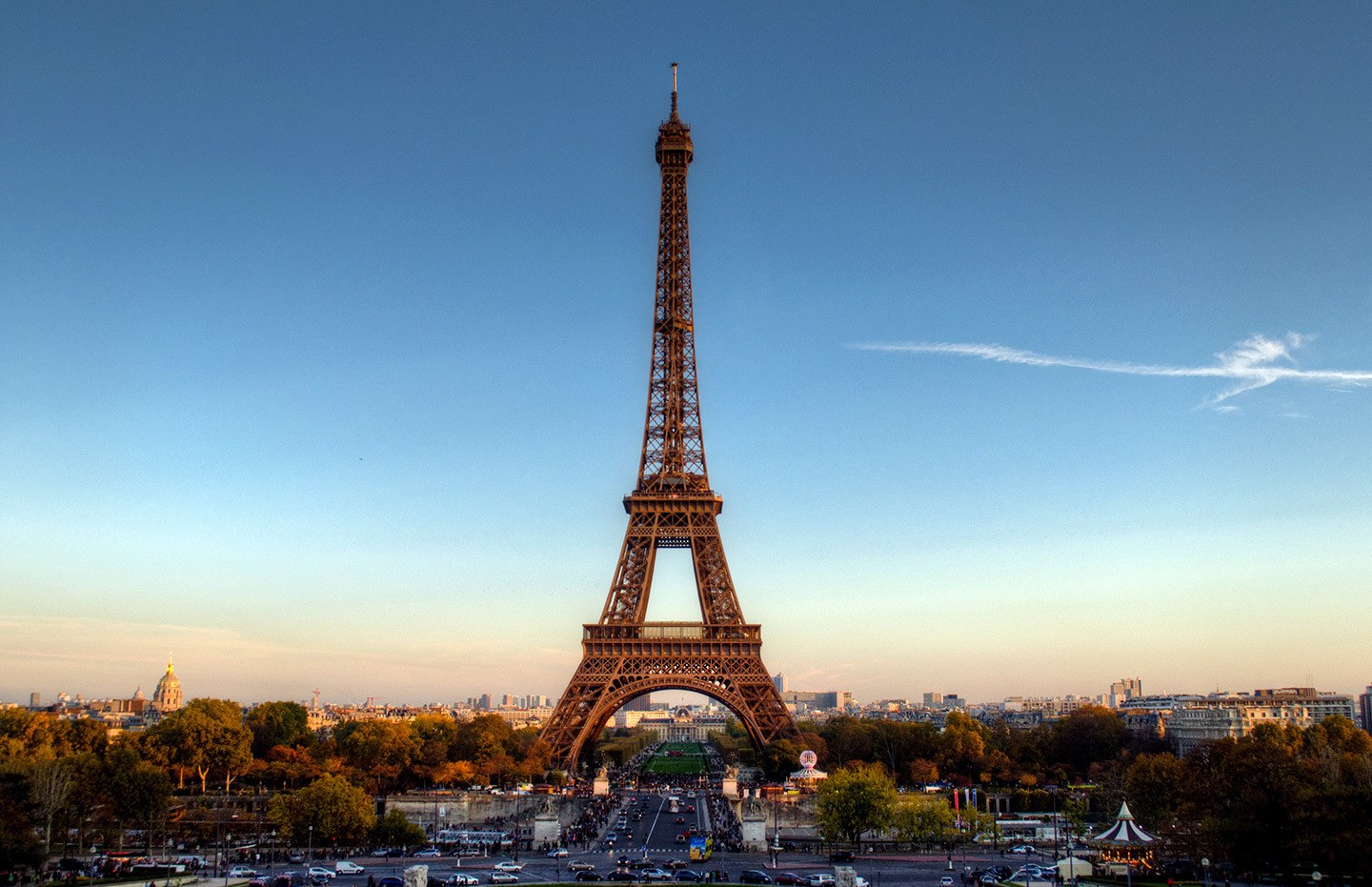
This journey through Northern Europe by train takes you through five countries – from the canals of Amsterdam and Bruges to the cosmopolitan cities of Paris and Milan, travelliing through the Alps on board one of Europe’s most beautiful train journeys.
This one-week Northern Europe rail itinerary shows you which trains to take, how much they cost, how to book and what to see along the way. Take the trip in summer for Alpine flowers, sunset boat trips and picnics under the Eiffel Tower, or try it in winter for Christmas markets, ice skating on Amsterdam’s canals and snowy mountain scenery.
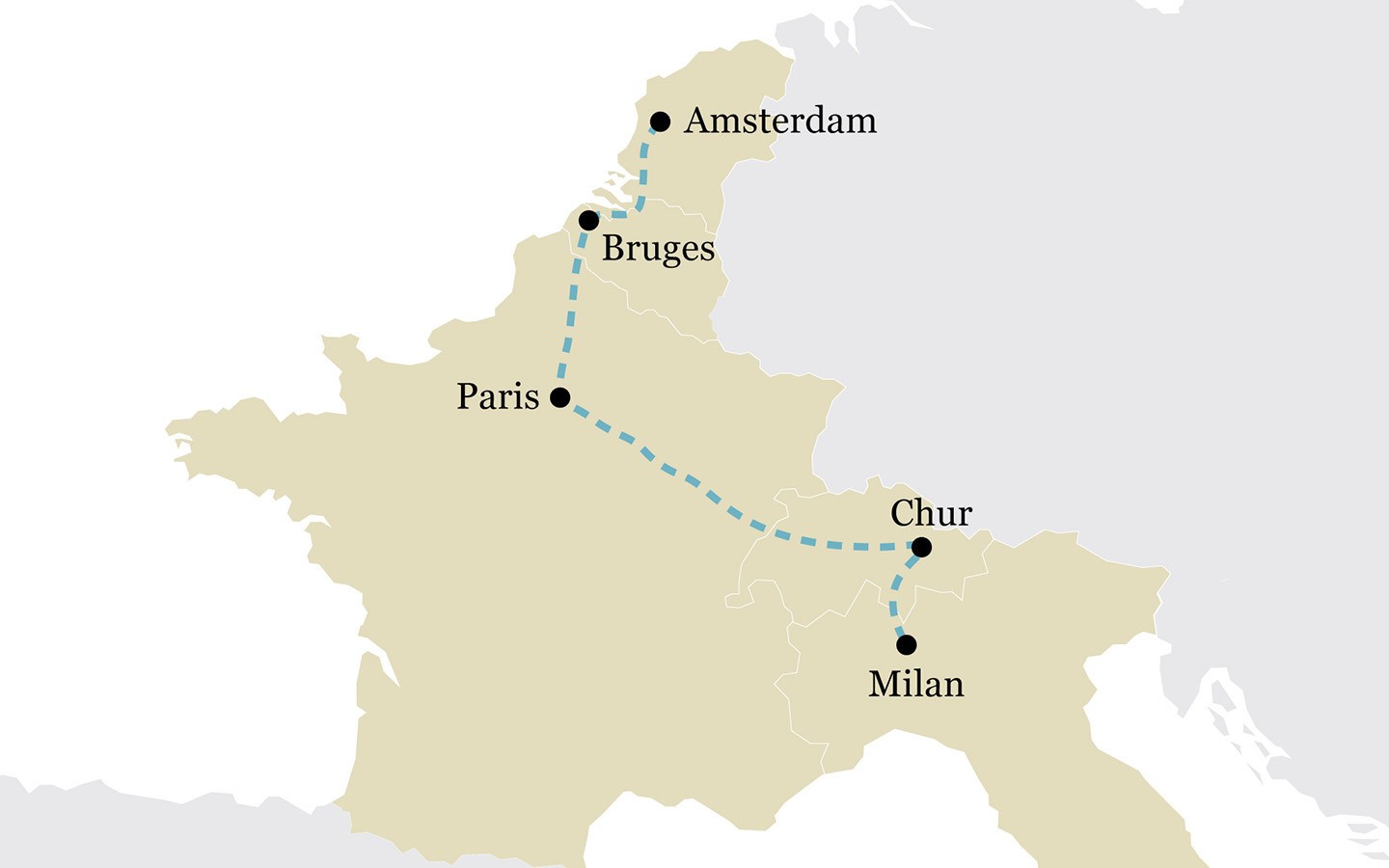
Day 1: Amsterdam
Start your Northern Europe by train adventure with a full day in Amsterdam . Take a walk around the UNESCO-listed Canal Ring, a UNESCO World Heritage Site which has 50km canals and 1500 bridges, lined with gabled merchants’ houses and colourful flower boxes. Or cruise the canals to see some of the city’s waterside highlights on a boat trip .*
Museum-hop your way through world-class artistic treasures at Amsterdam’s Rijksmuseum and Van Gogh * museums, or take a trip back in time at Rembrandt and Anne Frank’s houses. Relax in the green oasis of the 120-acre Vondelpark on a sunny day, where you can often see open-air music and theatre performances during the summer.
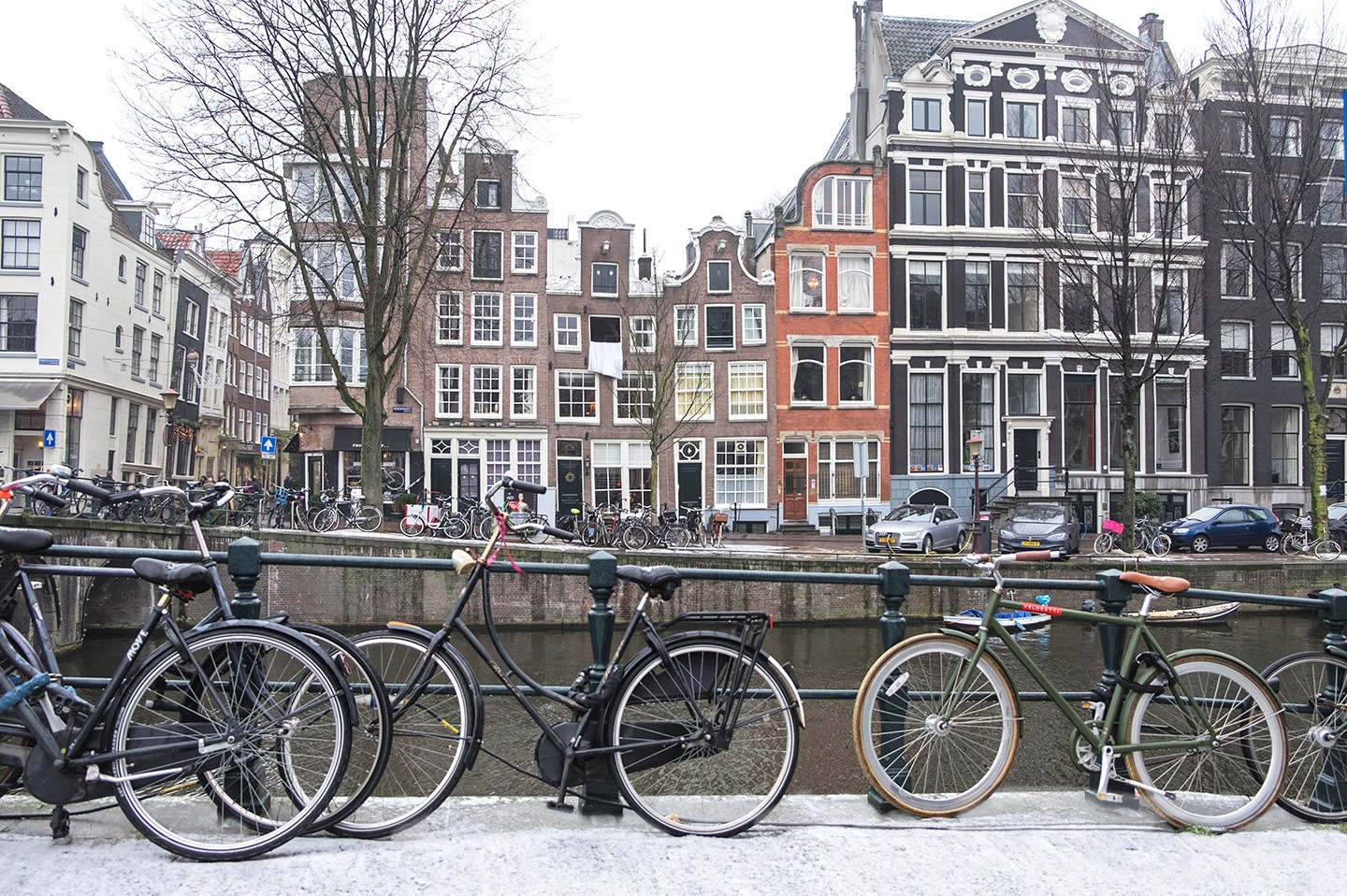
Or hire a bike and explore some of the city neighbourhoods away from the crowds, like cool De Pijp and the Albert Cuyp Markt, or Amsterdam-Noord with its redeveloped industrial buildings which are home to the EYE Film Insititute and NDSM Wharf.
Where to stay in Amsterdam: Dutch brand citizenM are known for their colourful style and quirky décor, with affordable city centre rooms. Their Amstel Amsterdam * hotel is on the edge of the canal ring. They only have one category of compact but comfortable room, and there’s also a communal lounge, café and bar plus free bike hire for guests.
Read more: Visiting Amsterdam on a budget
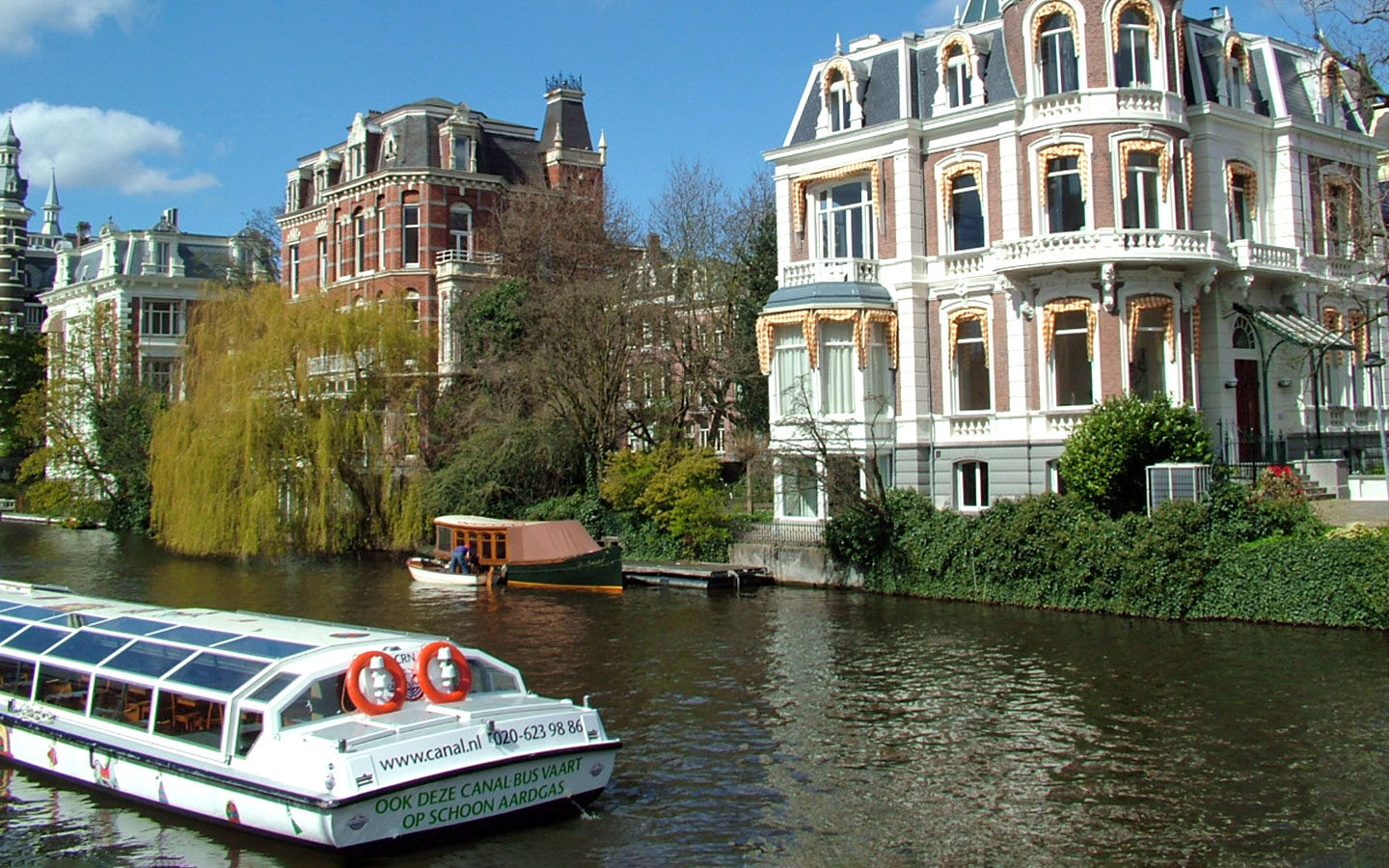
Day 2: Amsterdam > Bruges
The next morning, take an early train across the border into Belgium and the pretty city of Bruges with its canals, cobbled streets and medieval towers. Amsterdam to Bruges takes 3 hours 15 minutes – catch the 08.15 high-speed Thalys train from Amsterdam to Brussels Midi, then change onto the 10.29 InterCity train which arrives in Bruges at 11.30.
Spend the afternoon exploring Bruges . Visit the historic Grote Markt (market square) and climb to the top of the 13th-century Belfort belfry tower’s 366 spiral stairs for panoramic views out across the city rooftops. Or you can take a horse and carriage ride around the old town and check out Belgian and Flemish artworks at the Groeningemuseum.
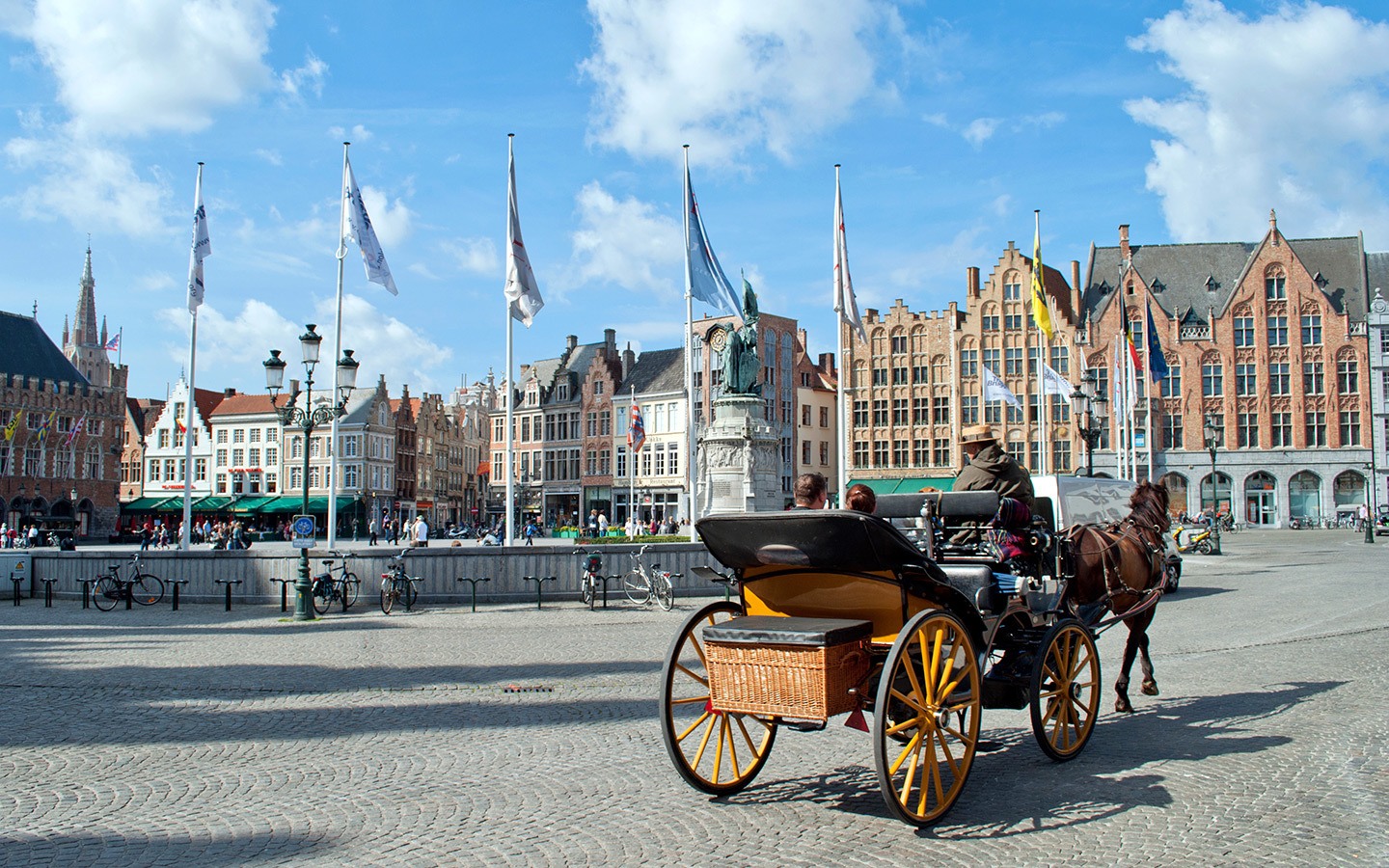
Bruges is famous for its beer and chocolate. If the first takes your fancy then visit De Halve Maan for a brewery tour and beer-inspired lunch, and try some of the ‘t Brugs Beertje pub’s 300 different Belgian beers. Or if you prefer chocolate then the Choco-Story * tells the story of chocolate-making, and you can taste quirky flavour combos at The Chocolate Line.
Where to stay in Bruges: Bariseele B&B * is located 10 minutes from the Grote Markt. It has three large en-suite rooms which each have a kitchenette with fridge, coffee maker, microwave and toaster. Rates include a tasty continental breakfast which can be served in your room. And it’s been certified by the eco-friendly Green Key scheme.
Read more: A weekend in Bruges, Belgium: 2-day Bruges itinerary
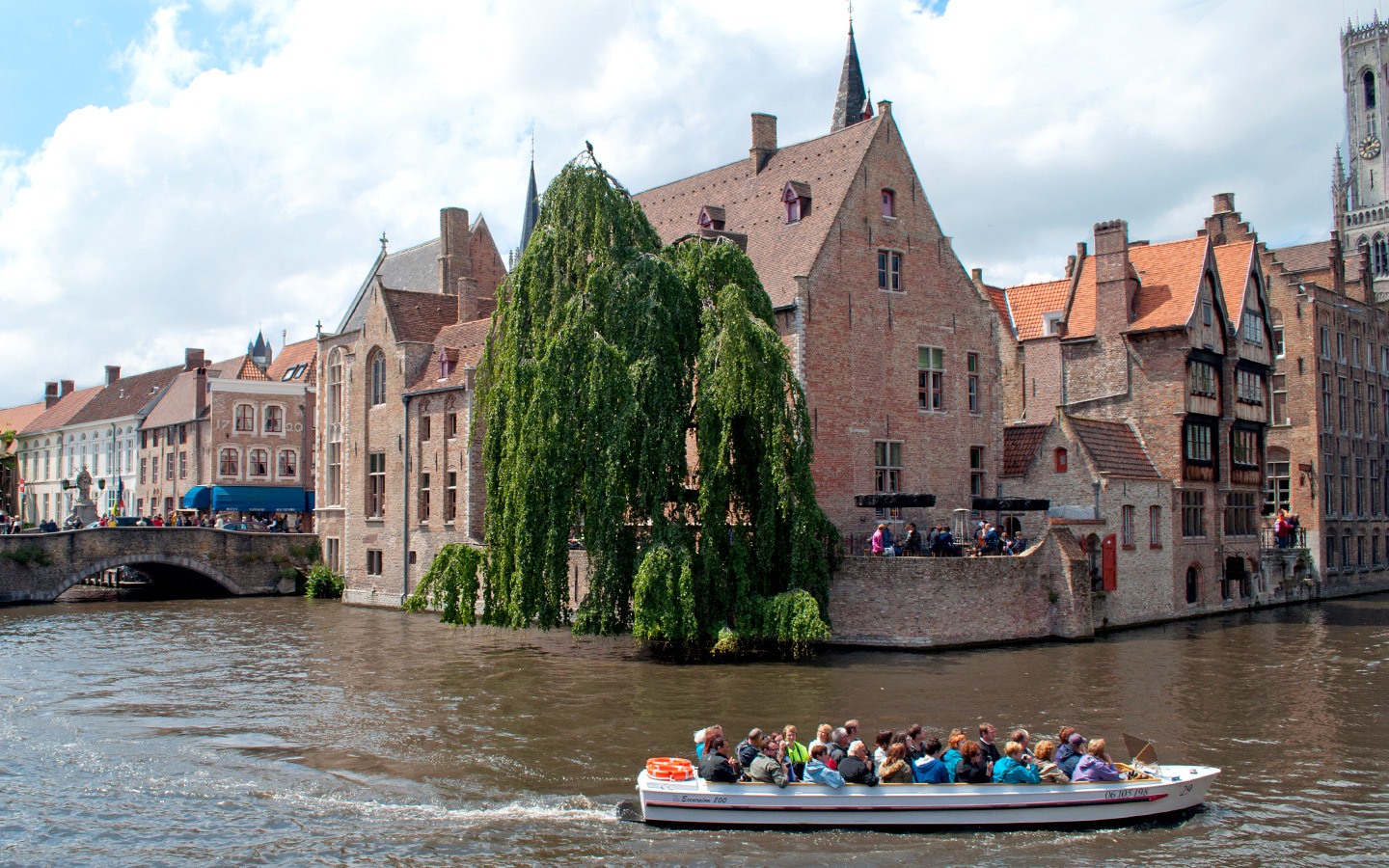
Day 3: Bruges > Paris
Finish your time in Bruges with a boat trip along its canals. It’s known as ‘Venice of the North’ (one of many!), with canals built in the Middle Ages as a trade link to the North Sea. Start from the Rozenhoedkaai (Quay of the Rosary) – probably the city’s most photographed spot – for a 30-minute tour past bridges, waterside houses and gardens.
Then take the 3-hour train journey to Paris . First catch the 13.10 InterCity train from Bruges to Brussels Midi, which arrives at 14.08 (tickets on this route are valid on any train, so you could also leave earlier and spend a few hours in Brussels). Then take the 14.43 high-speed Thalys service from Brussels, arriving into Paris Gare du Nord at 16.05.
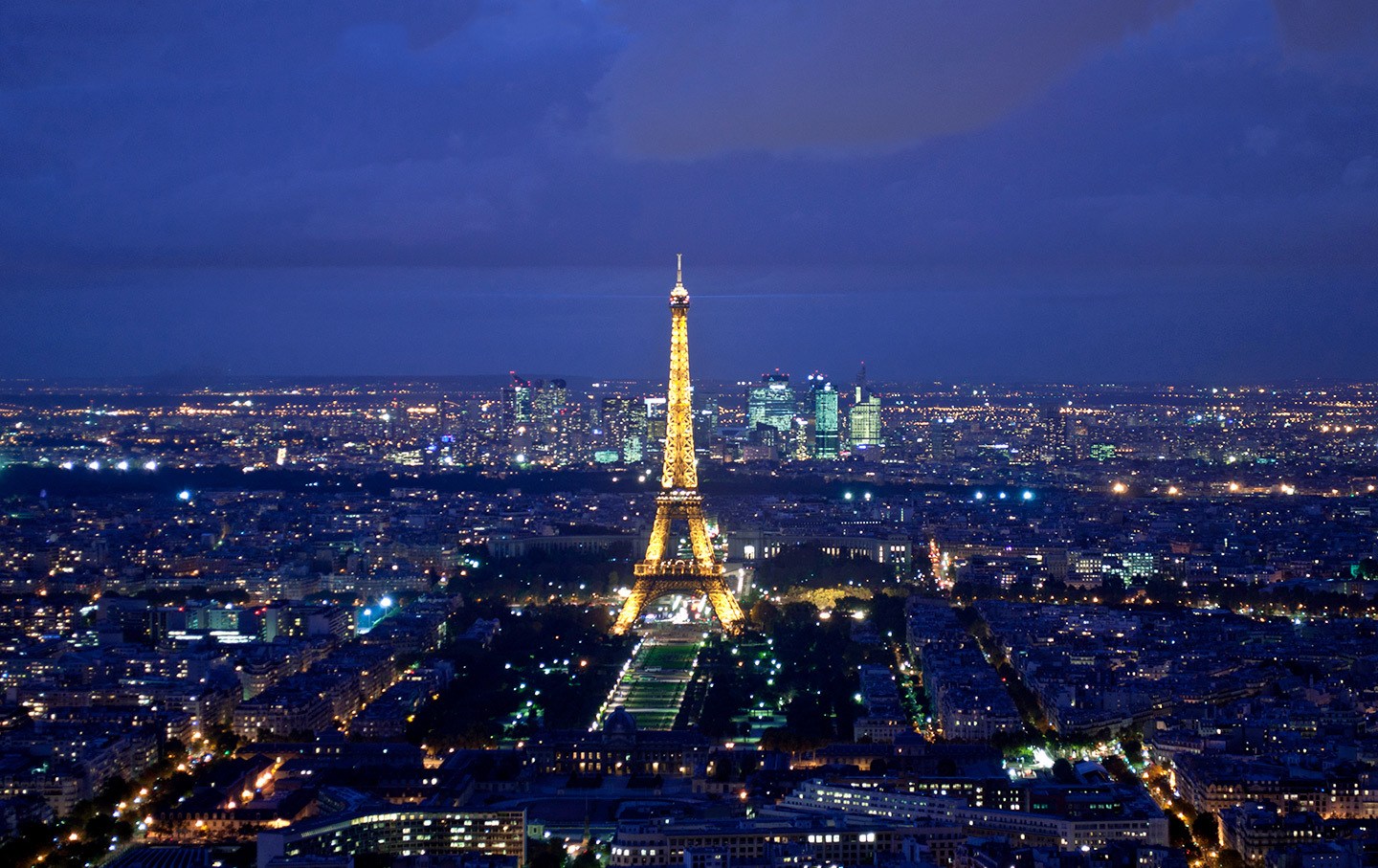
Spend the evening in Paris – you could climb the Montparnasse Tower to watch the Eiffel Tower sparkle on the hour over a cocktail in the Skybar. Take a dinner cruise * along the Seine to see the city lights. Catch a performance at the Paris Opéra or cabaret at the Moulin Rouge. Or just feast on French food and wine in one of the city’s restaurants.
Where to stay in Paris: Le Relais Montmartre * is tucked away in a quiet street at the heart of Paris’ arty hilltop neighbourhood of Montmartre, close to Sacré-Cœur Basilica and the Place du Theatre. Rooms are cosy, colourful and full of character, with floral prints and antique furniture. And there’s a peaceful patio where you can escape the city crowds.
Read more: Visiting Paris on a budget
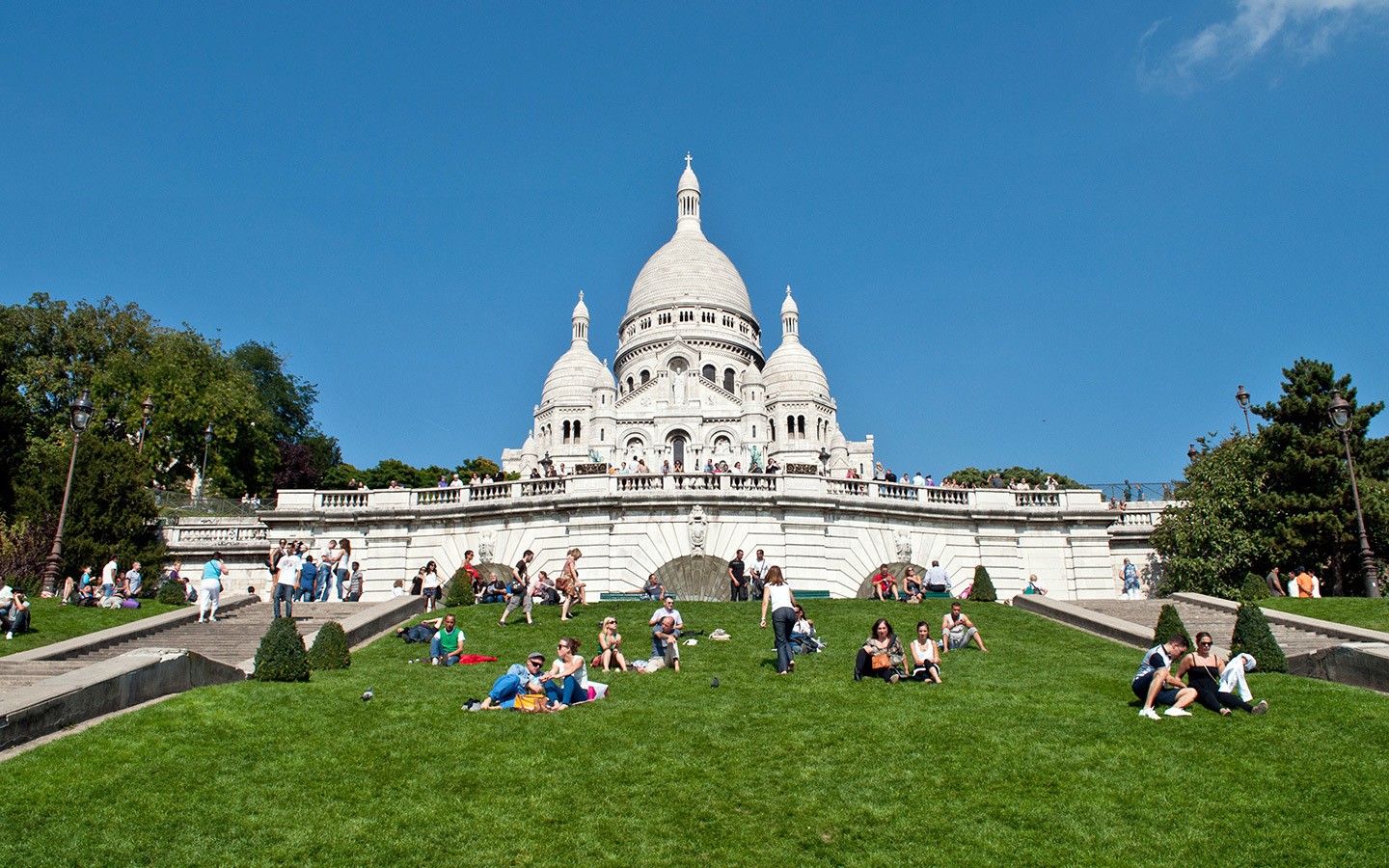
Day 4: Paris
Today you have a full day to spend in Paris. You could climb to the top of the Eiffel Tower * or Arc de Triomphe to admire the views, visit big-name museums like the Louvre and Musée d’Orsay, browse book stalls along the Seine or admire the stained glass in Sainte-Chapelle, eat macarons from Ladurée or shop the boutiques of the Champs-Élysées.
Take a walk though the intellectual and bohemian neighbourhood of St Germain . Explore the artistic history of Montmartre . Or follow in the footsteps of movie legends with a tour of film locations around the city, from black and white classics to modern blockbusters.
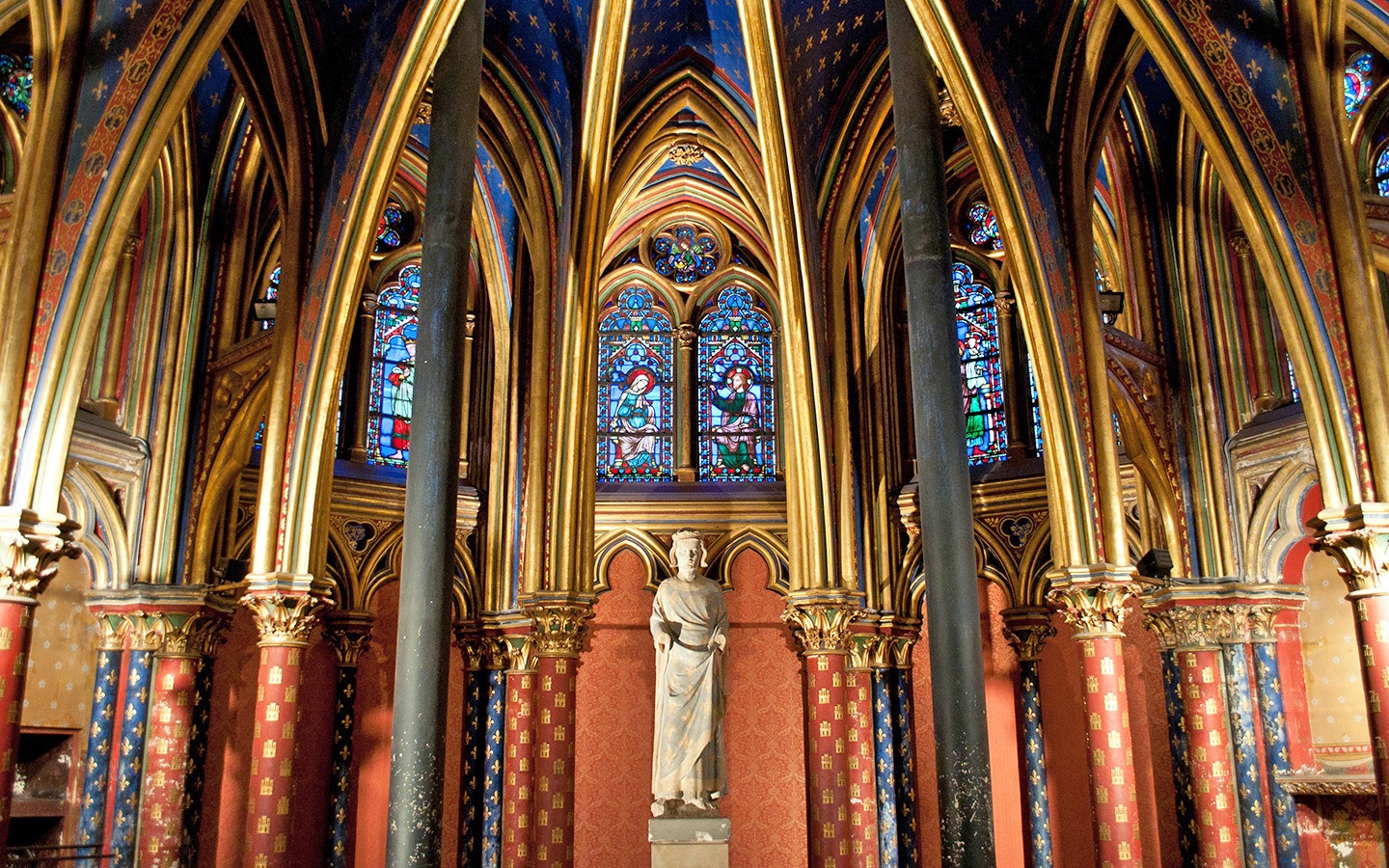
Or if you’ve already seen the city’s big-name sights, why not explore some of Paris’ unusual attractions ? Take a walk along the Promenade Plantée or La Petite Ceinture, both former railway lines which are now parks. Or visit quirky museums dedicated to fairground rides, sewers and stuffed animals, and discover Paris’ steampunk-inspired Métro station.
Read more: Things to do in Paris in spring , autumn and winter
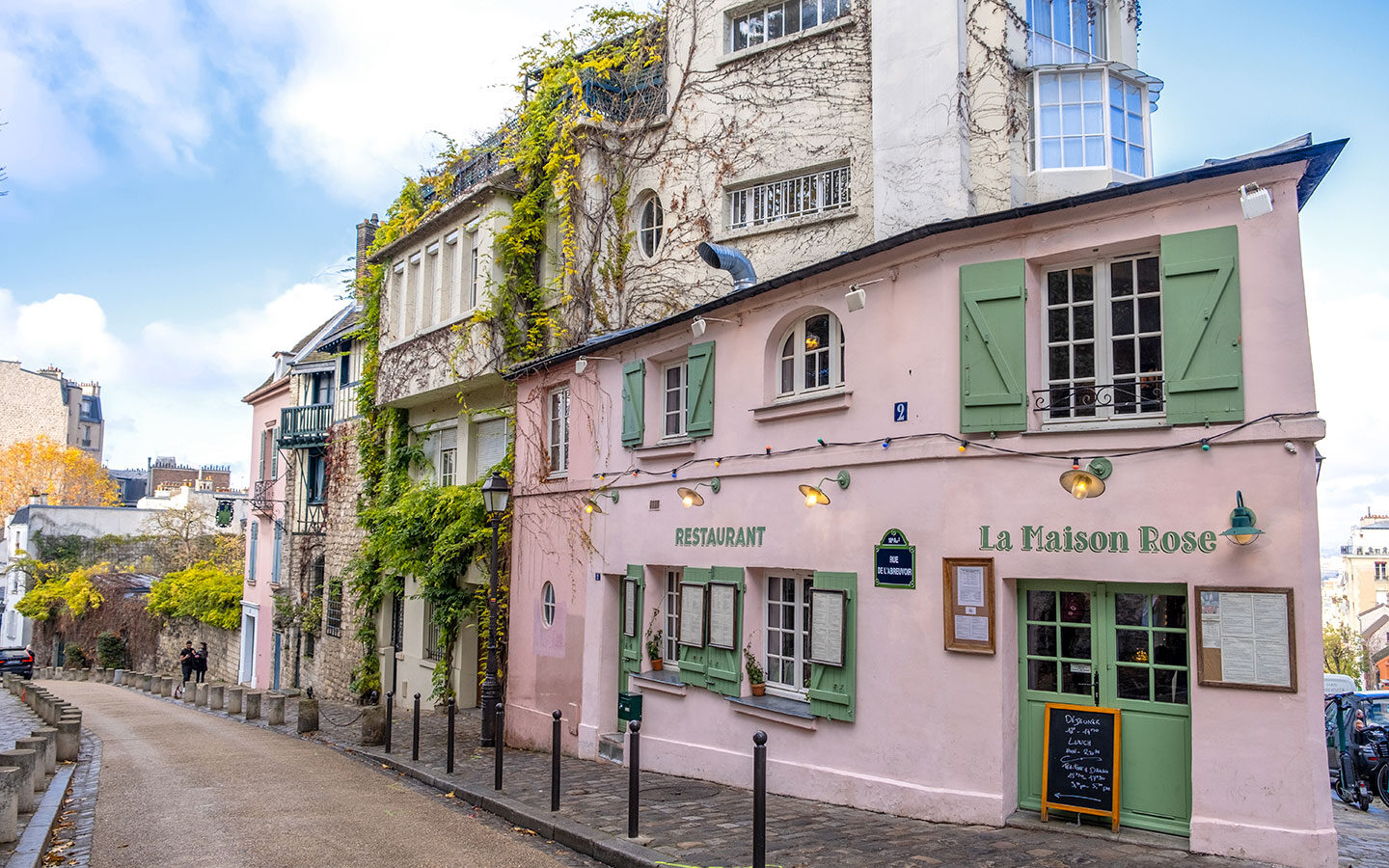
Day 5: Paris > Chur
Next morning, take the 5 hour 30 minute train journey to Chur in Switzerland. Catch the 10.20 high-speed TGV Lyria train from Paris Gare de Lyon to Zürich Hauptbahnhof, arriving at 14.26. Then change onto the 14.38 InterCity train which gets into Chur at 15.52.
Take an early evening walk around the car-free old town of Chur. Switzerland’s oldest city lies on the banks of the Rhine and is surrounded by vineyards and mountains. Climb up to the Haldenhüttli for the best view over the city then enjoy tasty local dishes like cheese fondue, barley soup or capuns (dumplings wrapped in a chard leaf).
Where to stay in Chur: The Romantik Hotel Stern * is a traditional-style hotel in a 360-year-old building which has a cosy Weinstube (tavern) and a rooftop terrace in summer. There are a a good range of different room categories, from economy to deluxe and apartments, and they offer free pick ups from the train station in a vintage Buick.
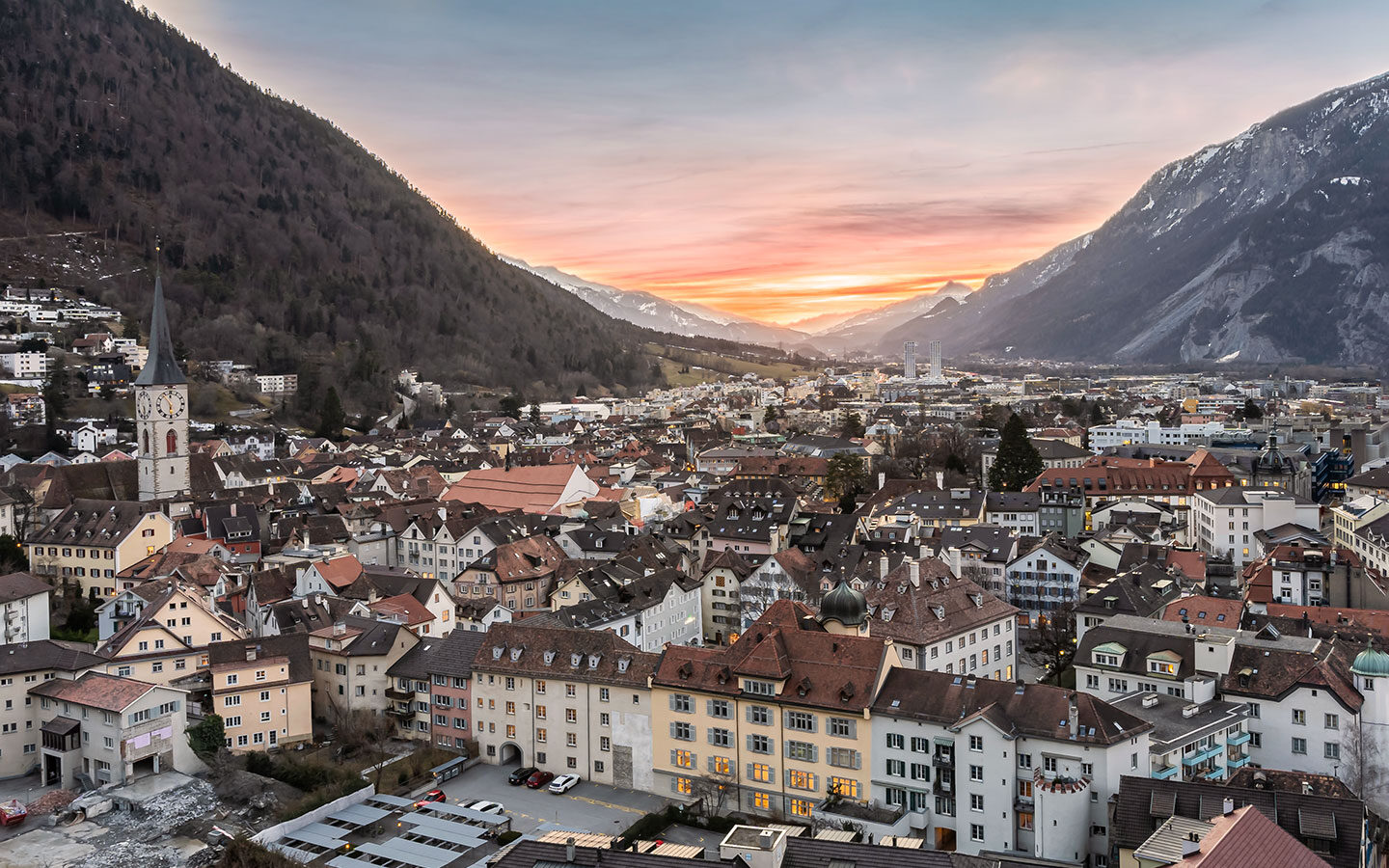
Day 6: The Bernina Express
Spend the next day travelling to Milan on board the Bernina Express – it’s one of Europe’s most scenic train journeys and a real highlight of the trip. The Bernina Express runs through the spectacular scenery of the Swiss Alps, passing hilltop castles and traditional mountain villages and crossing bridges and viaducts as it follows the River Plessur.
After passing the swanky ski resort of St Moritz it climbs up into the Upper Engadin valley to its highest point at 2253 metres before descending back down to Tirano.
Catch the 08.28 Bernina Express train from Chur, which takes just over four hours, arriving into Tirano Rhätische Bahn station across the border in Italy at 12.49. Then cross the square to Tirano Trenord station where a local train takes you on to Milan for the evening. The train leaves Tirano at 13.08 and arrives into Milan Centrale at 15.40.
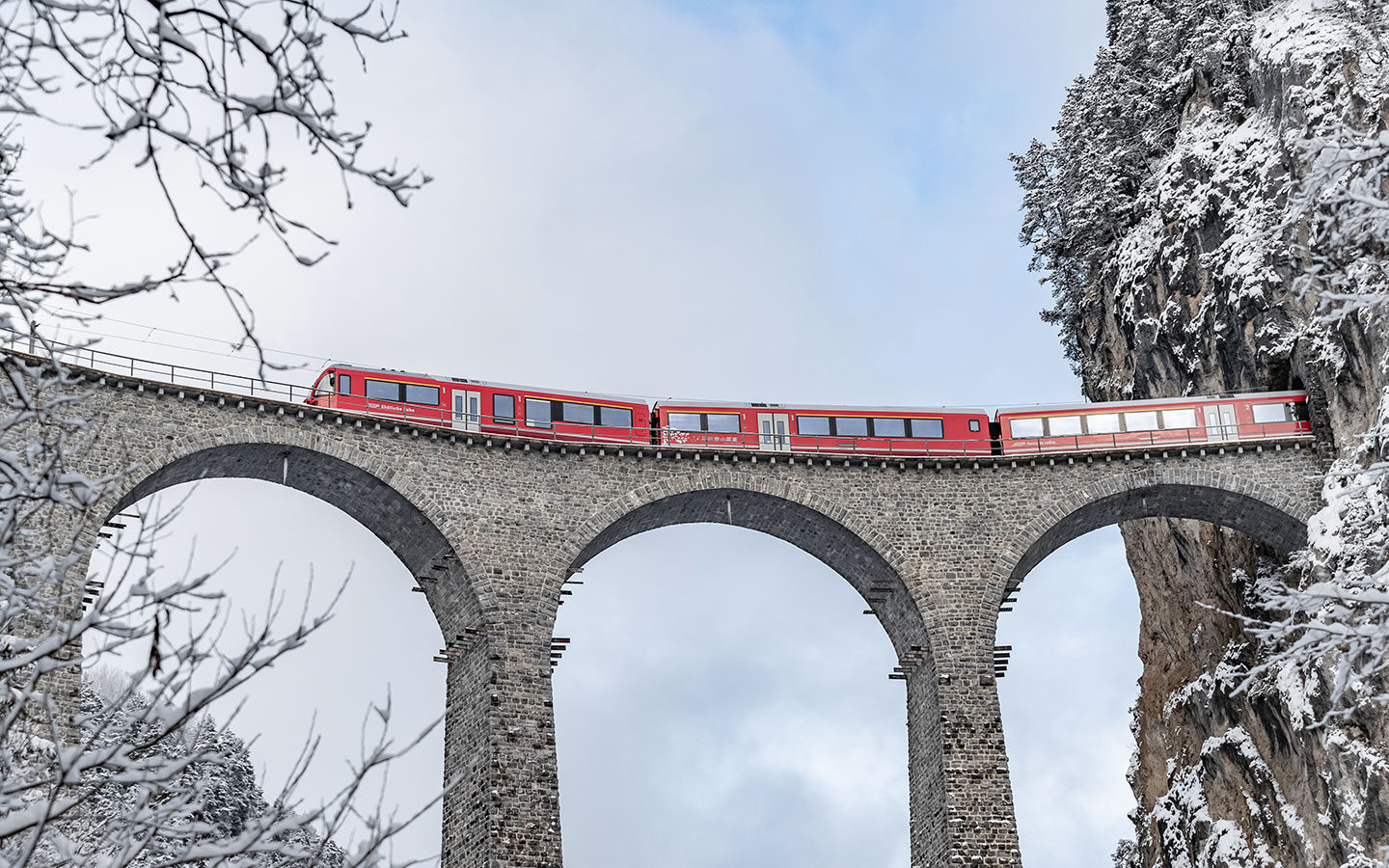
To ride the Bernina Express panoramic train, you need to pay an extra reservation fee on top of the usual ticket price (otherwise you’ll be in a normal train and have to change along the way) – this varies through the year. It’s CHF 26 (€26) from June–September, CHF 24 (€24) from March–May and in October or CHF 20 (€20) from November–February.
Where to stay in Milan: Sina The Gray * is a boutique hotel is close to Milan’s Duomo which overlooks the Galleria Vittorio Emanuele II shopping arcade. Its rooms are smart and modern and have subtle African-inspired touches to the décor – some also come with their own private gym or Turkish bath. There’s also a terrace and bar.
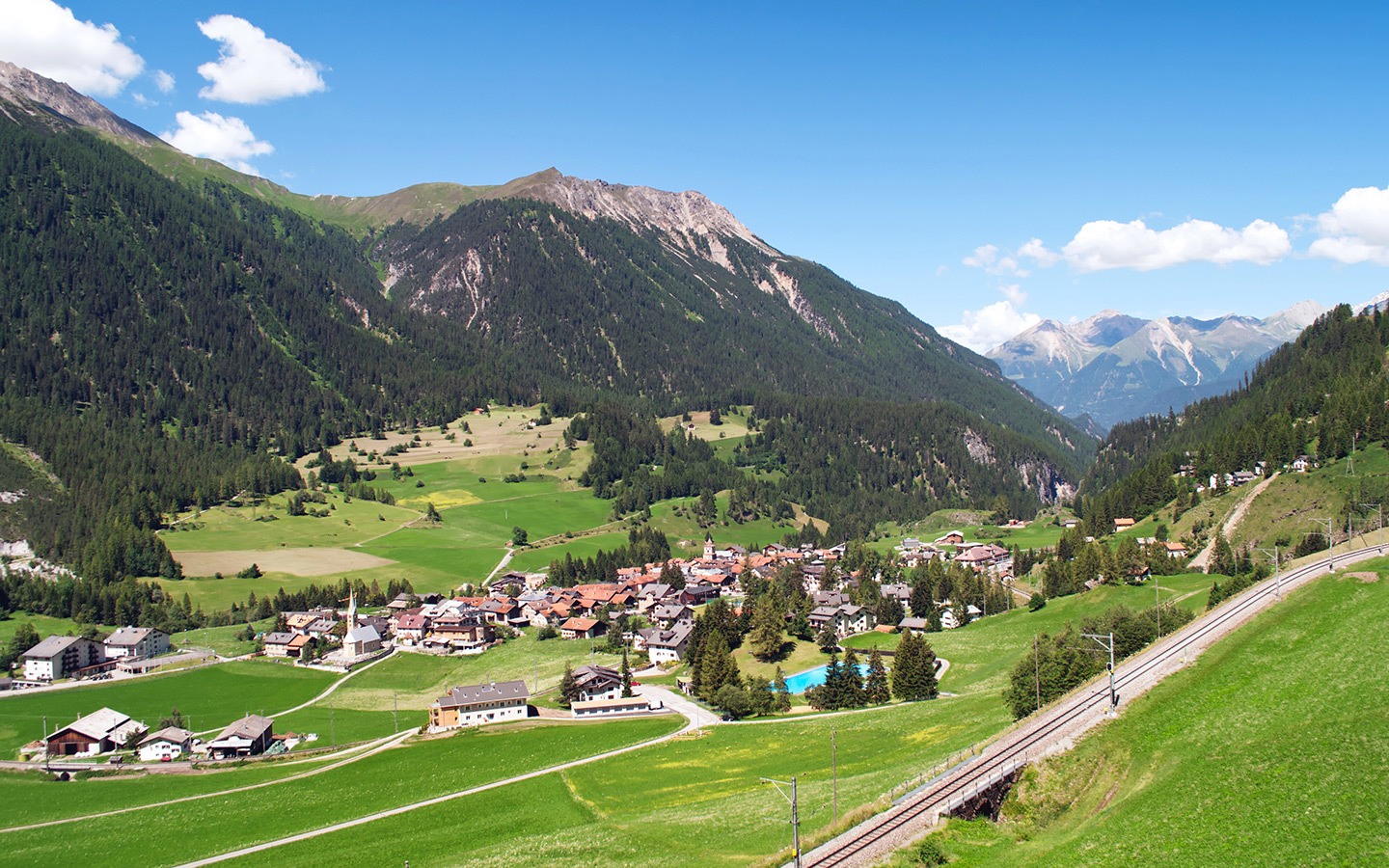
Day 7: Milan
Then spend the final morning of your Northern Europe by train trip shopping and sightseeing in the Italian fashion capital. Explore the lavish monuments of the centro storico , visit the museums in the huge Castello Sforzesco or shop the grand Galleria Vittorio Emanuele II, one of the world’s oldest and most glamorous shopping malls.
Then if you’re flying home, the Malpensa Express train connects the city’s Cadorna, Central and Porta Garibaldi train stations with Milan Malpensa airport, taking 43 minutes. Or you can pre-book a private transfer to the airport with Welcome Pickups .*
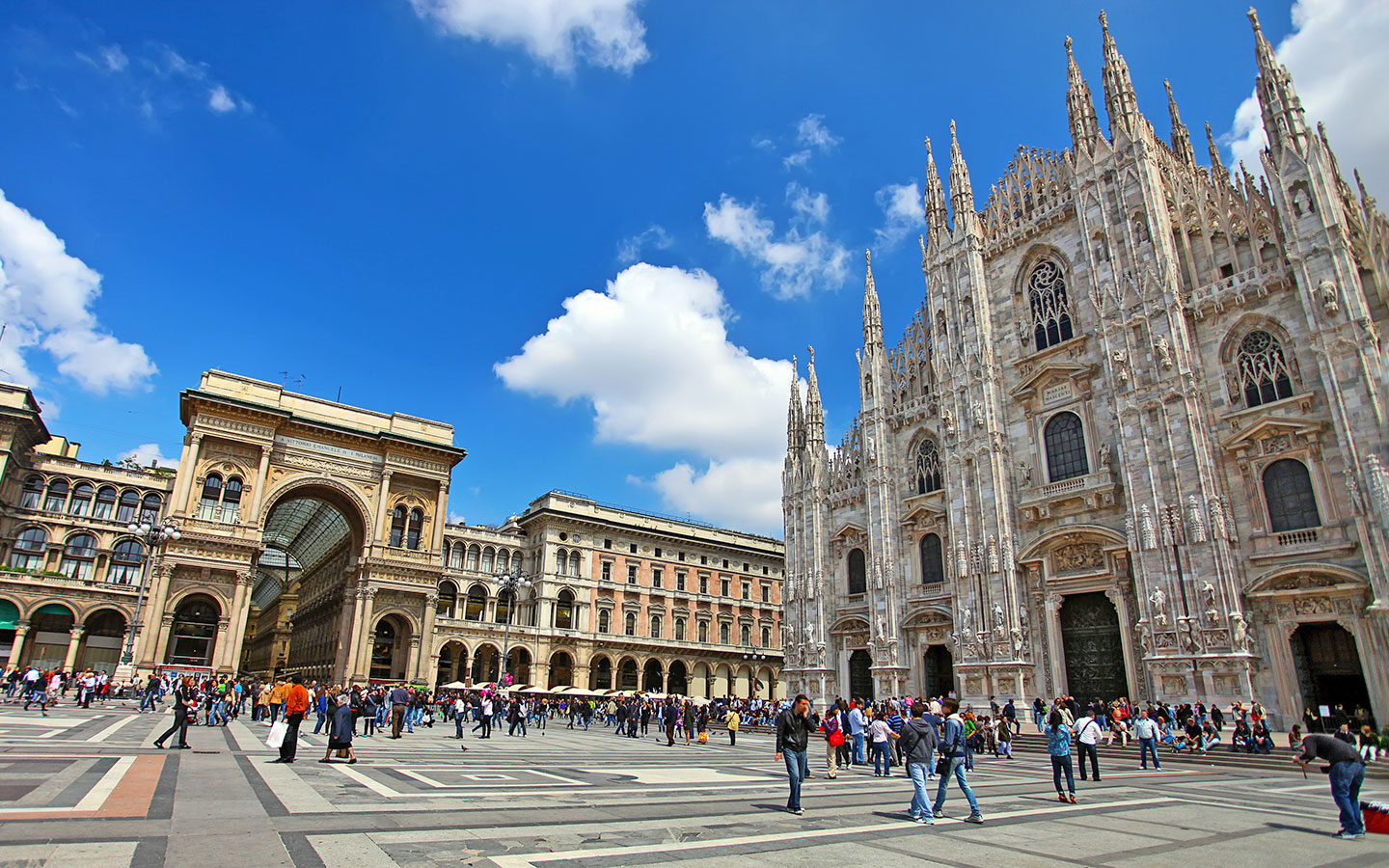
If you’ve got more time to spare, it’s less than an hour by train from Milan to the lakeside town of Como , where you can take a boat ride across the lake to glam waterside villages like Bellagio and Varenna. You could also head 3 hours south to Levanto and pick up the coastal train through Italy’s Cinque Terre . Or travel 2 hours 30 minutes east to Venice where you can add on the one-week I taly by train itinerary to make this into a two-week trip.
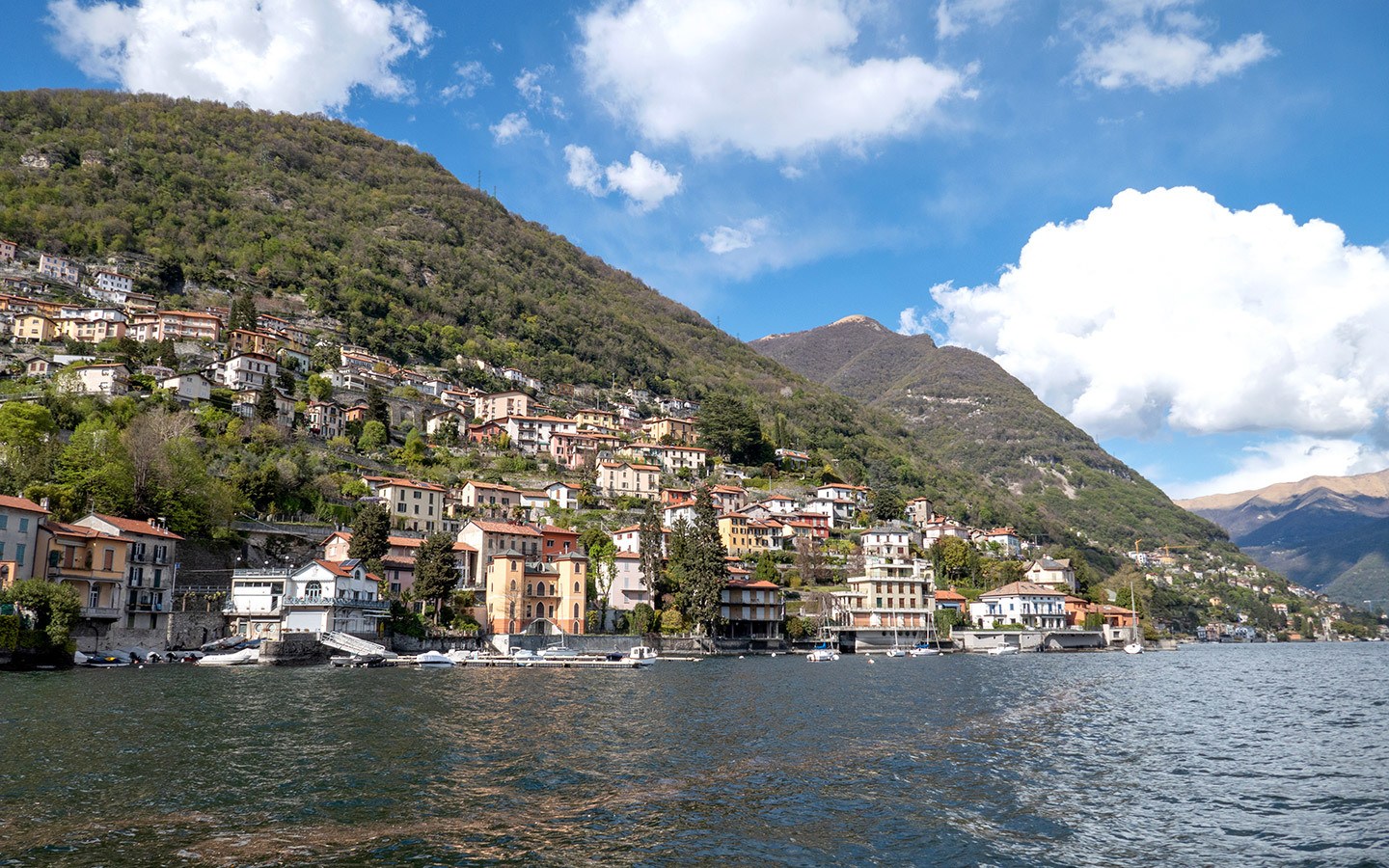
How much does it cost?
When you’re planning a European rail trip, you can either book individual tickets or get a railpass, which can be a better deal if you’re under 28, want more flexibility or are booking late. Here’s how the prices break down for the two different options on this route.
Individual tickets
Ticket prices vary depending on how early you book, with a limited number of cheap tickets available. So book as early as possible – on most routes you can book 3–4 months in advance – but beware these tickets are non-transferable so you’re tied to a specific train. Using the cheapest fares, the cost of trains on this route starts at €231 per person.
- Amsterdam > Bruges: from €36
- Bruges > Paris: from €56
- Paris > Zürich: from €29
- Zürich > Chur: from CHF 25.80 (€26)
- The Bernina Express: from CHF 52 (€52) + CHF 20–26 (€20–26) reservation fee
- Tirano > Milan: €11.50
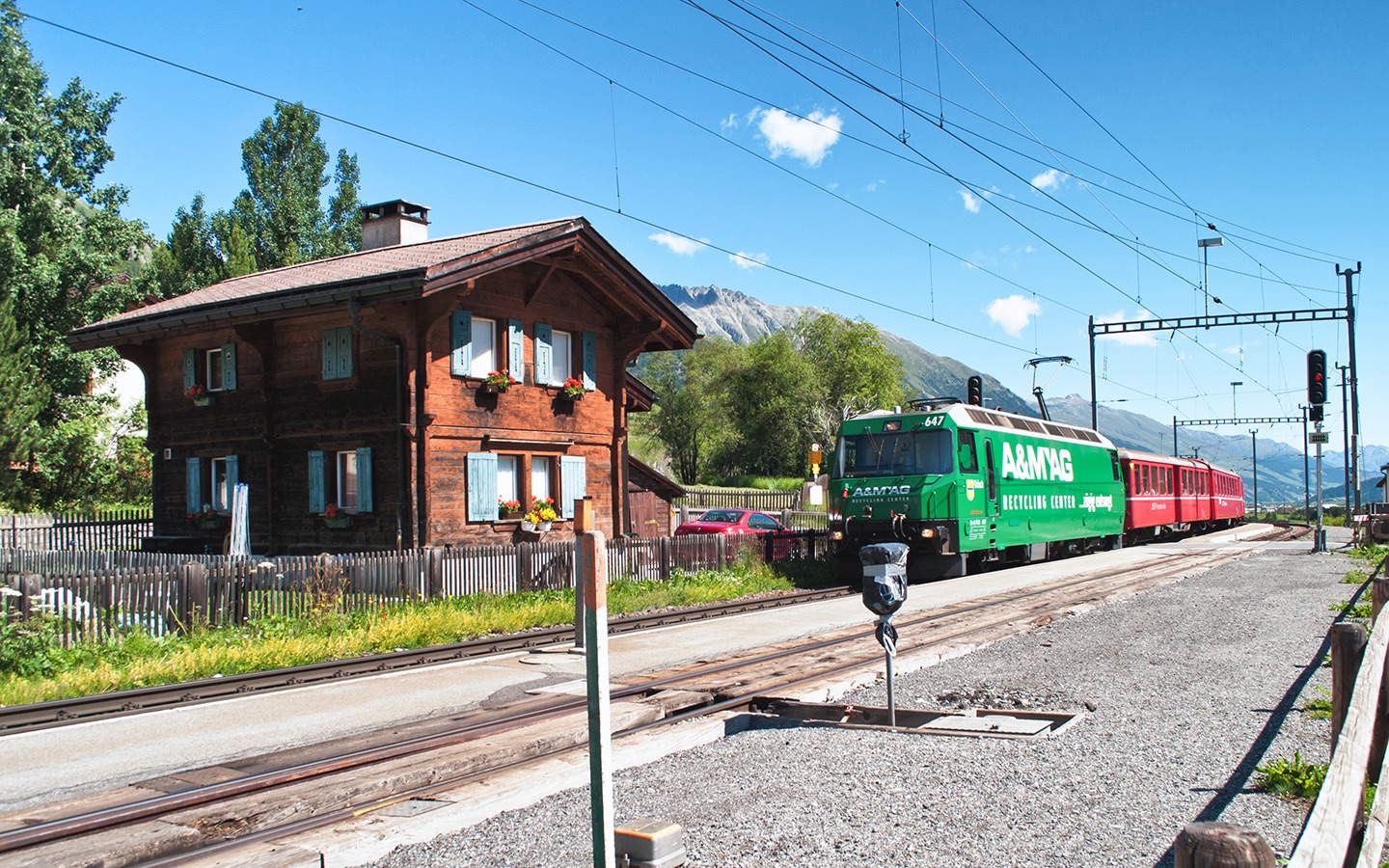
The railpass option
There are also various rail passes available through InterRail (for European residents) and Eurail (for non-European residents), which cover individual countries or the whole region and are valid for different periods of time, varying from four days to three months.
The Northern Europe by train itinerary involves four travel days across two countries, so the best option is the Global Pass for 4 travel days within 1 month . This costs €246 for adults, €185 for youths (aged 12–27) or €221 for seniors (aged 60+) in second class.
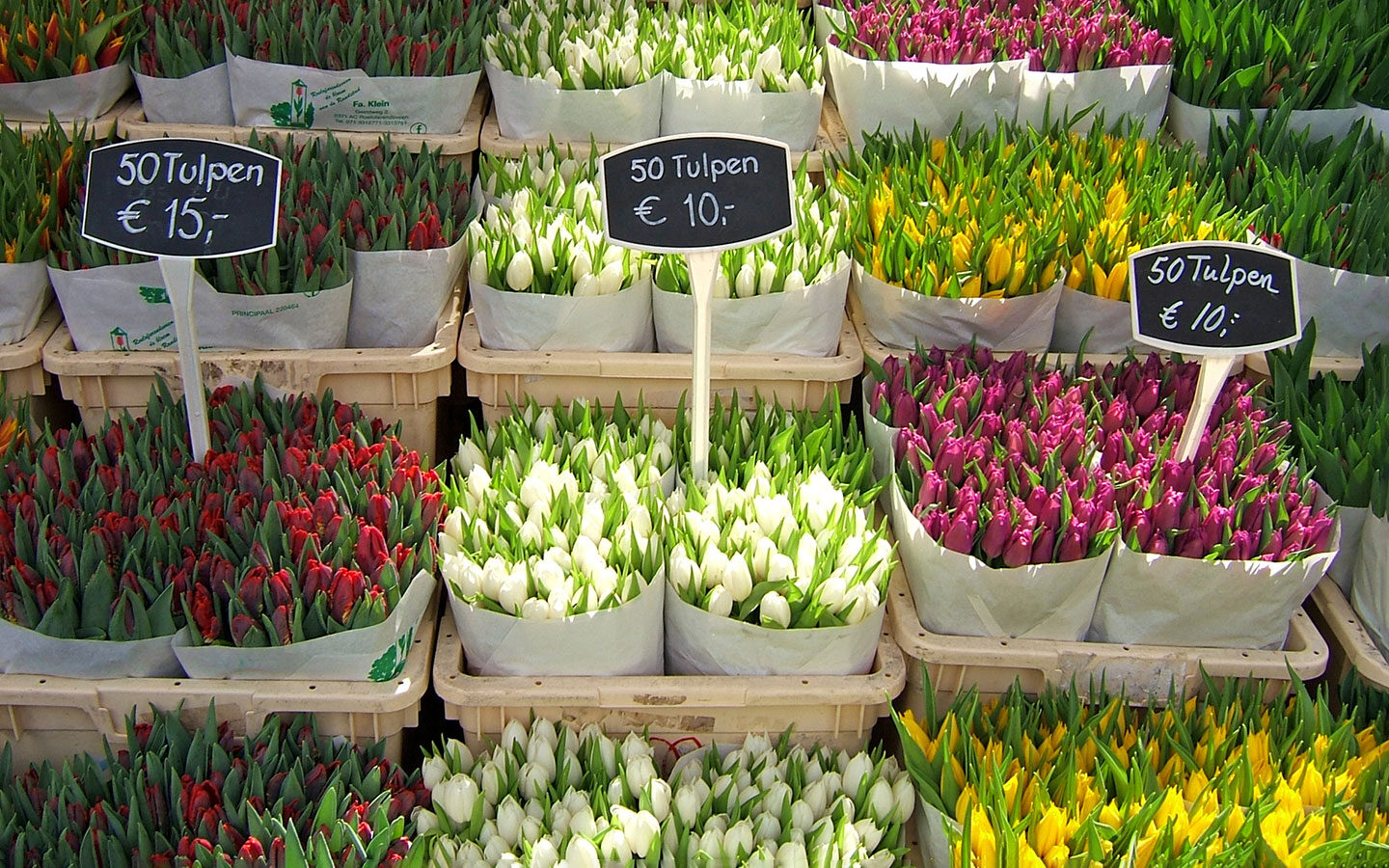
As well as the pass, you also need to pay an extra compulsory reservation fee in some countries and for certain trains – usually high-speed or sleeper services. For this trip, the reservation fees come to €98–€104, depending on what time of year you’re travelling. This is broken down as below, meaning the overall railpass cost starts from €344.
- Amsterdam > Bruges: €22
- Bruges > Paris: €27
- Paris > Chur: €29
- The Bernina Express: CHF 20–26 (€20–26)
Reservations can be made at any train station or online through the InterRail/Eurail reservations service for a fee of €2 (except for the Bernina Express which must be reserved through Rhaetian Railway ). I’ve recommended the quickest and easiest routes. But you can often avoid reservation fees by taking local trains which usually don’t require reservations – though they’re likely to be slower and involve more changes along the way.
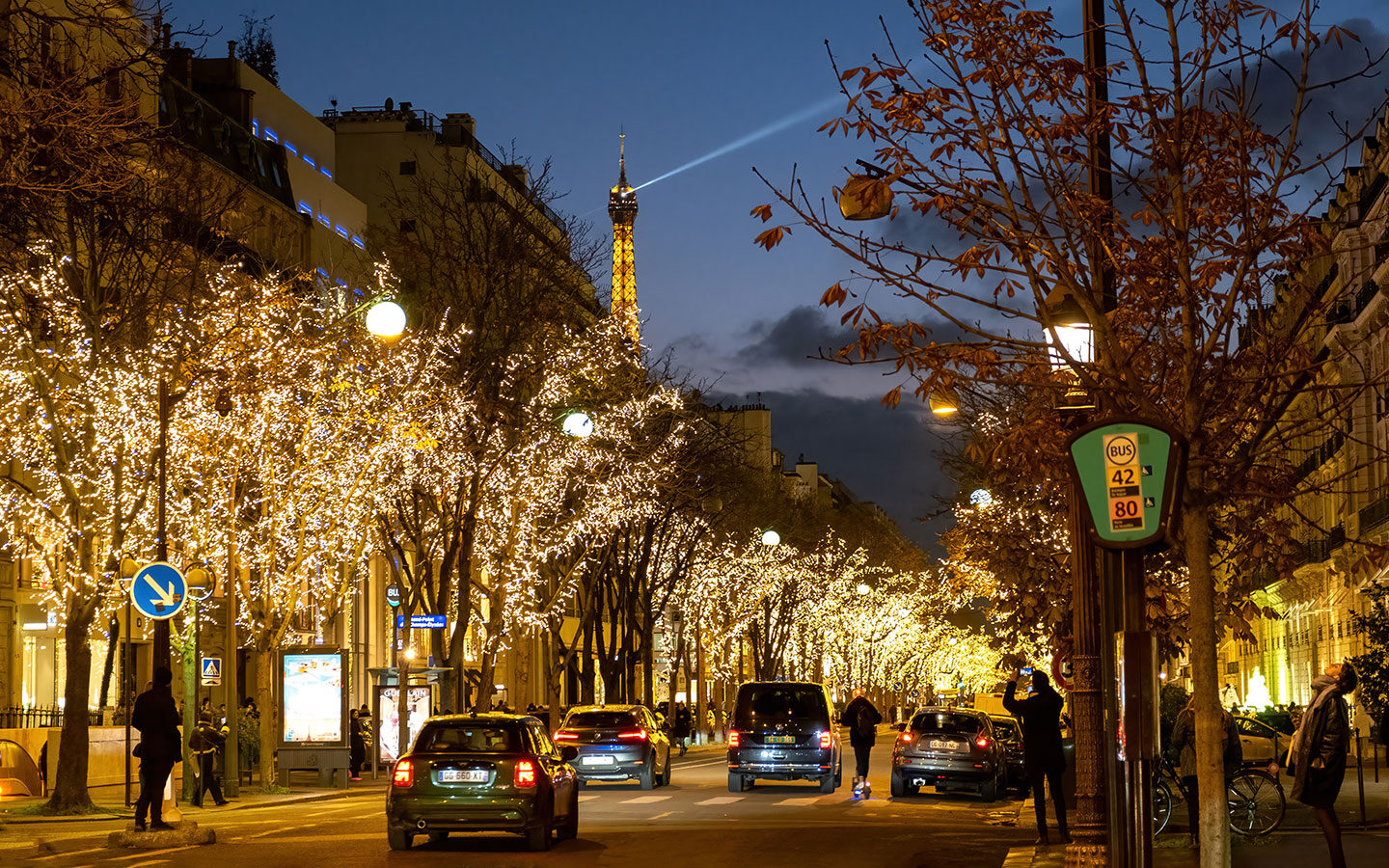
How to book
There are a variety of websites where you can book European trains, but often the best deals are though the official railway company sites for each country. For this trip these are:
- Amsterdam > Bruges: NS International
- Bruges > Paris: B-Europe
- Paris > Zürich: SNCF Connect
- Zürich > Chur: Swiss Railways
- The Bernina Express: Swiss Railways (use Rhaetian Railway for seat reservation)
- Tirano > Milan: Trenord
You can also book tickets for European trains with Omio * or The Trainline . The advantage is they cover multiple countries, you can see prices in €, £ or $, use international credit cards and print or use mobile tickets, but they do charge a small booking fee.
Don’t want to do it yourself? You can also book this One-week Northern Europe by train itinerary * as a package through our partners Byway, the world’s first flight-free holiday platform. And you can save £100 off your first booking using the code LUCE100 if you book before the end of June 2024.
Save for later
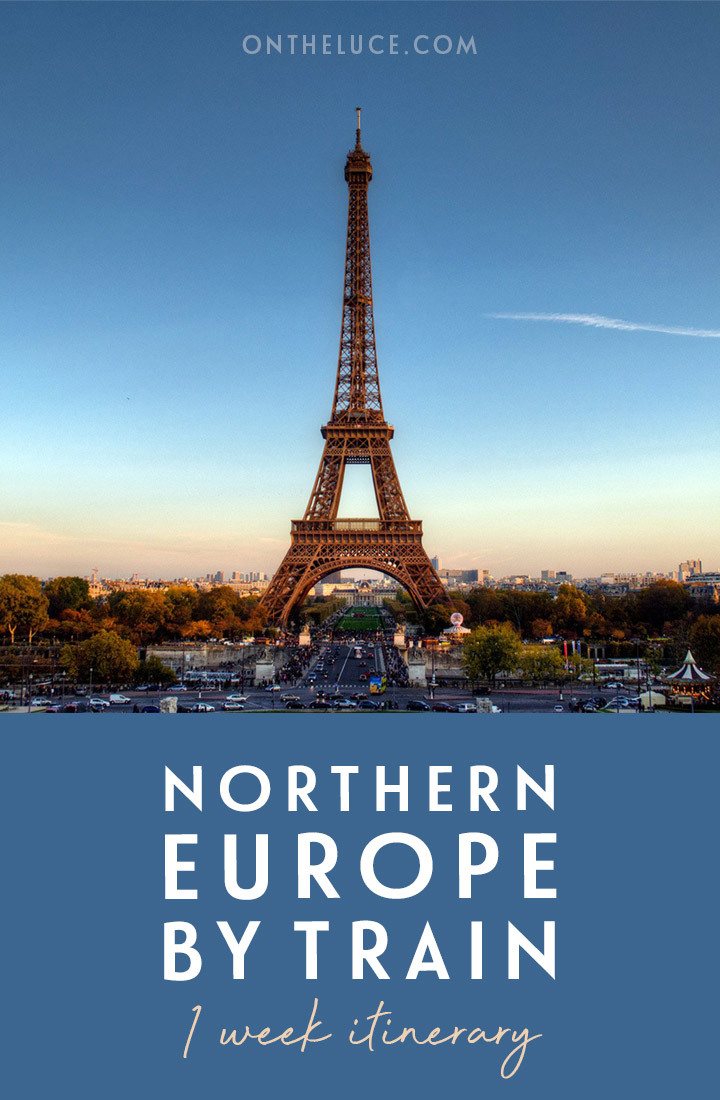
You might also like
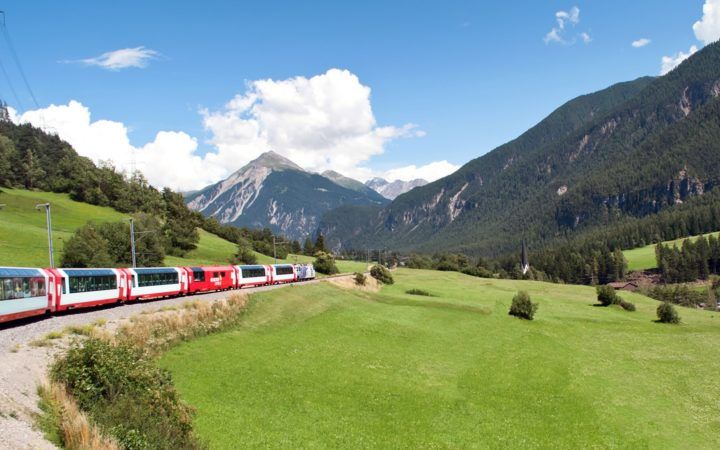
Europe by train: Five great one-week rail trip routes
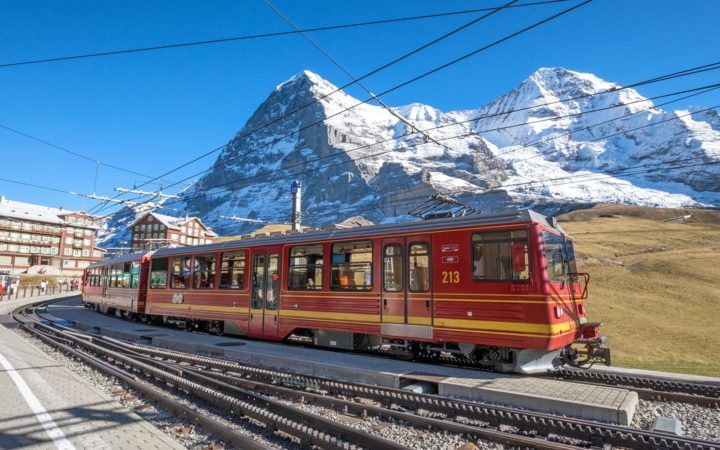
Tips for planning a European rail trip on a budget

European night trains: Seven great sleeper services
Saturday 28th of January 2023
This looks great. Do you recommend a travel/tour company that can do the booking. We have a group of 8. Thanks Mark
Lucy Dodsworth
Sunday 29th of January 2023
Hi Mark, both Railbookers and Byway organise custom rail trips and should be able to book for you.
JoAnn Michelsen
Wednesday 10th of November 2021
Thank you for this wonderful information. Can this itinerary be taken in reverse? I want to go from Pisa, Italy to Amsterdam. I do not want to go to Paris.
Thank you for your help.
Hi, yes that should be no problem – it's just under four hours from Pisa to Milan by train then you can do the trip in reverse from there/

- Destinations
- Car Rentals
- Airport Transfers
- Things To Do
- Bikes Booking
- Travel Visa
- Event Tickets
- Travel Insurance
Travel Guide
Backpacking itinerary guide for northern europe.
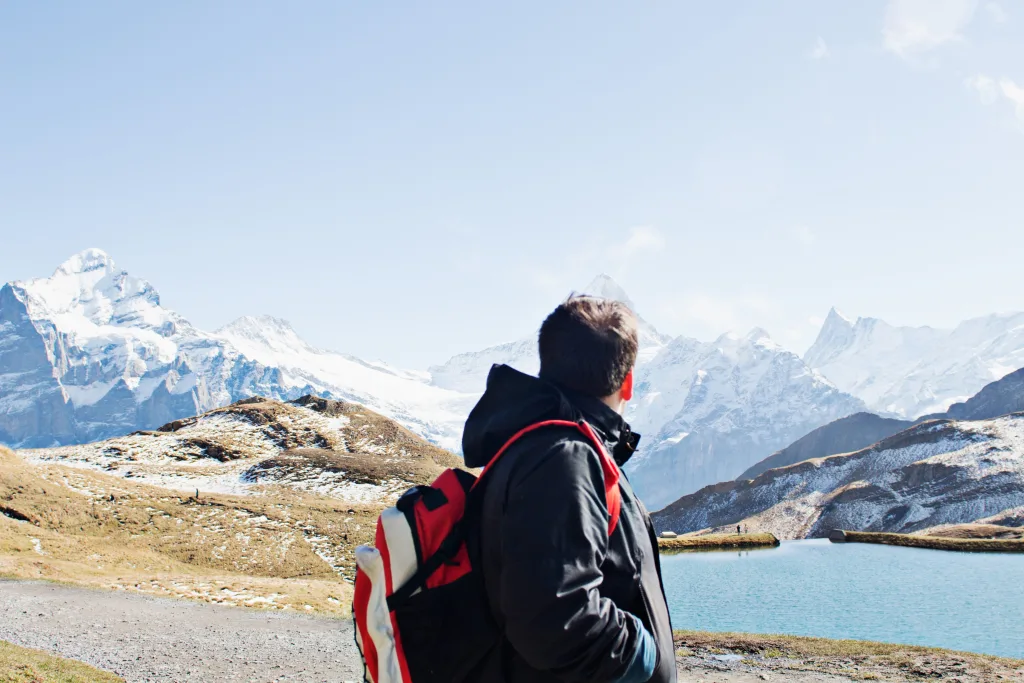
Northern Europe
A trip to Northern Europe offers a fascinating blend of natural beauty, cultural richness and modern sophistication. The region showcases breathtaking landscapes such as fjords, forests and spectacular northern lights. Travelers can explore vibrant cities with breathtaking architecture, famous museums and steeped history. Furthermore, Northern Europe prides itself on sustainability, offering environmentally friendly tours and a glimpse of developing and thoughtful countries Whether they immersing themselves in Nordic traditions, trying interesting foods or experiencing outdoor activities, Northern Europe is enriching And promises an unforgettable travel experience.
Creating a comprehensive itinerary for Northern Europe can be an expensive and complex task, as it encompasses many countries with diverse cultures, landscapes and attractions. Here is a suggested itinerary that include key destinations in Northern Europe. Also, consider the best time to visit as Northern Europe can experience severe weather.
Destinations:
- Arrive in Copenhagen and explore sights like the Little Mermaid, Nyhavn and Tivoli Park.
- Take the train or bus to Stockholm and visit Vasa Museum, Gamla Stan and Ebba Museum.
- Visit Oslo and explore famous sites like the Viking Ship Museum, the Holmenkollen Ski Museum and the Royal Palace.
- Visit the beautiful coastal town of Bergen and walk on the nearby fjords. Explore Bryggen harbor and the Fløibanen funicular.
- Fly into Tromsø or take a long-haul bus to see the Northern Lights (seasonal), dog sledding and winter activities.
- Visit Helsinki and enjoy the vibrant design by visiting Suomenlinna Sea Castle and Helsinki Cathedral.
- Take the train or ferry to St. Louis. Petersburg and explore the Hermitage Museum, the Bloody Savior Church, and Peter Paul’s Castle.
- Take a boat ride to Tallinn and explore its well-preserved medieval old town, Toompea Castle and Alexander Nevsky Cathedral.
- Take a bus or train to Riga and discover its beautiful Old Town, Art Nouveau architecture and Riga Central Market.
- Visit Vilnius and explore its beautiful old town, Gediminas Castle and Trakai Island Castle.
- Visit Warsaw and visit the Warsaw Uprising Museum, Royal Castle and Lazienki Park.
- Take the train to Krakow and explore the historic Old Town, Wawel Castle and the Auschwitz Memorial.
- Go to Berlin and visit landmarks like the Brandenburg Gate, Check Point Charlie and the Berlin Wall Memorial.
- Take the train to Hamburg and explore the harbour, the Miniatur Wunderland and the historic Speicherstadt district.
- Go to Amsterdam and explore the canals by visiting famous museums like the Van Gogh Museum and the Anne Frank House.
- Visit Brussels, explore the Grand Place Atomium, and enjoy Belgian chocolates and waffles.
- Finish the trip in Paris. Explore the Eiffel Tower, Louvre and Notre Dame Cathedral, and discover the city’s art and food.
When planning your trip, remember to consider your travel preferences, interests, and budget. Flexibility is also important while traveling around Northern Europe
Happy Travels!
Leave a Reply Cancel reply
Your email address will not be published. Required fields are marked *
Save my name, email, and website in this browser for the next time I comment.

11 EPIC 2-Week Europe Itinerary Options [2024 UPDATE]
Trying to plan a 2-week Europe itinerary but don’t know where to start? This complete Europe travel guide will help you figure out which region in Europe is best for you and which itinerary would best suit your travel preferences!
Europe tops the list of leading destinations for travelers across the globe with its pristine, Mediterranean beaches, medieval history, sumptuous cuisine, and picturesque landscapes. But, with so many countries and options to choose from, finding a 2-week itinerary to suit your needs can be daunting!
With over a dozen European countries under my belt and years of personal traveling experience, I have created the best itineraries to suit every traveler. From the beachbums to the hikers, and the history buffs to the nature enthusiasts, there is a European itinerary for everyone!
Here is my list of the best itineraries across the continent, each containing the top activities of the region. I’ve also included tons of useful information on how to plan your trip, how to select the countries you should visit, and more!
Happy Travels!
11 Incredible 2-Week Europe Itinerary Options
Whether you want to visit Central, Western, or Northern Europe, we have a special itinerary for every travel style and budget!
✈️ Now, before you set out your door en route to the airport, be sure to check out these Essential Tips for Traveling to Europe for the First Time ! Even if it’s not your first trip to the continent, you’re likely to find some helpful tips for your next go-around.
✈️1. London & Paris: 2-Week Europe Itinerary

This combination makes for a fantastic Eastern Europe itinerary! With so much to see and do in both, you’ll want at least a few days in each to explore the nooks and crannies of these gorgeous cities.
This trip can be shortened to fit within one week, but keep in mind these are two of the largest cities in Europe.
They have a lot of incredible sites and activities to offer that you won’t want to miss out on, not to mention you’ll need some time to sit back and enjoy a cup of tea (or a glass of wine) and a freshly baked croissant!
Day 1 : Arrive in London Day 2 : Big Ben, the Tower of London, the London Eye Day 3 : Buckingham Palace and the Changing of the Guard Day 4 : Walking Tour of the City Day 5 : Harry Potter tour Day 6 : Train to Paris: Eiffel Tower and the Arc de Triomphe Day 7 : Les Champs-Élysées and the Notre Dame Day 8 : Museums: Orsay and Louvre Day 9 : Explore some neighborhoods: Montmartre and Le Marais Day 10 : Day Trip to the Palace of Versailles Day 11 : Picnic in the Luxembourg Gardens Day 12 : Get lost in the Latin Quarter Day 13 : Paris Catacombs and catch a show at Le Moulin Rouge Day 14 : Return home
With 20 arrondissements in Paris and over 600 square miles in London, it’s safe to say the possibilities are endless when designing a trip to these cities. But, you really can’t go wrong!
Each day can be customized to fit your goals. Looking to relax by the Seine and have a picnic? Do it. Not really into shopping? Skip the Champs-Élysées and spend time listening to the singing bells of the Notre Dame Cathedral.
In London, opt to check out the local art scene and make your way through its numerous museums.
Looking for a day trip from London? Windsor Castle, Bath, and Stonehenge are most popular for visitors looking to escape the chaos of the city for a day, and with their incredible cultural heritage and stunning architecture, there’s no wondering why.
London and Paris offer fantastic opportunities to immerse yourself in Europe while avoiding complex itineraries and long-haul journies between destinations. Pair them together for a classic 2 week Europe trip full of beauty, romance, and charm.
Related Articles on Paris
✔️ Why Visit Paris? 25 Reasons to Visit Paris, France ✔️ Is Paris Safe? A Full Guide on Safety in Paris ✔️ Souvenirs from France: 45 Unique French Souvenirs ✔️ Best Time to Visit Paris: 7 Things to Consider ✔️ 27 Incredible Day Trips from Paris ✔️ 17 Beautiful Beaches Near Paris ✔️ 27+ Magical Things To Do in Paris at Night ✔️ Wine Tours in France: 15 Top-Rated French Wine Tours
✈️2. Amsterdam, Bruges & Luxembourg City: 2-Week Europe Itinerary

Medieval architecture, sweeping canals, and charming squares await in these three cities seemingly based on a storybook. Evidently frozen in time, the magic of these cities can be felt by even the most jaded of travelers, and surely won’t disappoint your inner child!
Stroll the windy, cobblestoned alleyways and take a boat ride through the web of canals in Amsterdam and Bruges, but find yourself watching the changing of the guard and getting lost in the Casemates du Bock of Luxembourg City.
These cities offer everything from traditional design to modern cafés and boutiques and represent the epitome of European travel.
Day 1 : Arrive in Amsterdam Day 2 : Bloemenmarkt & Canal Boat Ride Day 3 : Red Light District (if it’s your style) & Jordaan neighborhoods Day 4 : Van Gogh Museum & Anne Frank House Day 5 : Day Trip to Zaanse Schans Day 6 : Optional Day in Brussels & train to Bruges Day 7 : Train to Bruges Day 8 : Canal Boat Ride & Belfry of Bruges Day 9 : Rozenhoedkaai (Quay of the Rosary) & Market Square Day 10 : Train to Luxembourg City Day 11 : Casemates du Bock & the Grund Day 12 : Walking tour of the Old Town Day 13 : Day Trip to the Mullerthal Trail Day 14 : Return home
Now, you’re probably wondering why I’ve chosen Bruges over Brussels… and the answer is simple. I’m all about getting out of the basic tourist spots (Bruges is still very touristy, but has far more medieval character and beauty to it), and going beyond the first train stop in a new country.
Yes, while traveling from Amsterdam to Bruges, you will most likely be stopping in Brussels. I’m not going to tell you not to get off the train, but I will say that when debating between Bruges vs Brussels , I can honestly say that most people choose Bruges over Brussels.
My best suggestion is to add a day to your trip so you have time to explore both.
Luxembourg City may be small, but it certainly packs a punch. Often overlooked by travelers, it is a true gem that has so much to explore.
Have some extra time? Head up north to the Mullerthal Region of Luxembourg where you’ll find dreamy, moss-covered forests scattered with graceful waterfalls and filled with tall trees (it reminds me of the forests depicted in The Hobbit films!)
These cities have so much to offer and this is one of my personal favorite European itineraries on this list… just remember to bring a camera and good walking shoes.
Related Articles
✔️ One Day in Bruges: The Ultimate Bruges Itinerary ✔️ One Day in Ghent: The Ultimate Ghent Day Trip ✔️ One Day in Brussels: A Brussels Itinerary for First Time Visitors ✔️ The Perfect 3 Days in Belgium Itinerary ✔️ 17 Authentic Souvenirs from Belgium to Bring Home ✔️ Paris or Amsterdam: A Complete Comparison ✔️ Barcelona vs Lisbon: The Ultimate City Comparison ✔️ The Perfect Day Trip to Luxembourg from Brussels ✔️ Amsterdam in Spring: Why Spring is the Best Time to Visit Amsterdam ✔️ 2 Days in Amsterdam: The Ultimate Amsterdam Itinerary ✔️ 25 Authentic Souvenirs from Amsterdam To Bring Home ✔️ One Day in Amsterdam: Full Guide & Best Things To Do and See
✈️3. Chamonix, Courmayeur & The Matterhorn (Zermatt): 2-Week Europe Itinerary

Fellow hikers and adventure seekers, this is the trip for you! Surrounded by the breathtaking Mont Blanc Range and the various snow-capped peaks of the Alps, there is no end in sight to hiking trails of all difficulty levels and spectacular landscapes worthy of a thousand photos.
Even if you aren’t someone who enjoys a good hike, there are plenty of options to take cable cars up these majestic mountain ranges to enjoy the stunning scenery. Trust me, your pictures won’t do your experience justice.
Coming from someone who jumped off the Mont Blanc Range (with a paraglide strapped to me!), the sights are truly unparalleled, and you won’t believe you ever even debated the option of skipping it.
So, here is my best 2-week Europe itinerary for exploring this region to the fullest, just be sure to bring a jacket (yes, even in summer) if you plan on making your way up to the top of these mountains!
Day 1 : Arrive in Chamonix, France Day 2 : The Montenvers Train to Restaurant le Panoramique Day 3 : Aiguille du Midi Cable Car Day 4 : Adventure Activities (Hiking, Paragliding, or Snow Sports) Day 5 : Explore th e c harming Alps town Day 6 : Train to Courmayeur Day 7 : Skyway Monte Bianco Cable Car Day 8 : Explore the quaint villages of the Aosta Valley (Dolonne, La Saxe, Entrèves and Villair) Day 9 : White Water Rafting Day 10 : Train to Zermatt Day 11 : The Gornergrat Railway (Europe’s highest mountain railroad) Day 12 : The Matterhorn (learn about it here ) Day 13 : Ski Day Day 14 : Return home
Chamonix , Courmayeur, and Zermatt not only provide stunning scenery at altitude but also at the ground level in the center of lovely villages and neighborhoods. Nestled between sections of the magnificent Alps, these towns provide a cozy, small-town feel you don’t get in other places in Europe.
Being encircled by the striking mountains is both awe-inspiring and rejuvenating and should be experienced by travelers of all types! Do yourself a favor, and head to the French, Swiss, and Italian Alps on your next European getaway.
✈️ When it comes to bucket list experiences, Chamonix often tops the list for Europe. If it’s already caught your eye, be sure to check out this Ultimate Europe Bucket List: 101 Experiences to Have in Europe as well!
✈️4. Barcelona & The French Riviera: 2-Week Europe Itinerary

As one of my personal favorite destinations in all of Europe, Barcelona is a true gem. Boasting sweeping coastlines and a vibrant art scene, it can easily be combined with the nearby French Riviera for the ultimate beach vacation.
If this magical city is high on your European bucket list, be sure to check out my list of the Best Things To Do in Barcelona at Night !
Combined with the magic of the French Riviera, beachbums will have their fill of endless crystal clear waters, and soft, white-sand beaches to get between their toes!
This is the ultimate vacation for those looking to relax and unwind in the Mediterranean with a little European flair.
Day 1 : Arrive in Barcelona Day 2 : Antoni Gaudi’s Park Güell and Walking Tour Day 3 : Beach day Day 4 : Las Ramblas, the Gothic Quarter, El Born, Gràcia, and El Raval Day 5 : Train to Dramont Day 6 : Beach day in Dramont & stroll the Old Town Day 7 : Day trip to one of the Cote d’Azur islands Day 8 : Beach day in Nice & explore the Promenade des Anglais Day 9 : Day Trip to Cannes and walk the Boulevard de la Croisette Day 10 : Optional beach day or hiking day Day 11 : Day Trip to Antibes Day 12 : Day Trip to Monaco Municipality Day 13 : Optional beach day or hiking day Day 14 : Return home
With some of the best beaches in not only Europe but the world, the French Riviera should not be overlooked by anyone, regardless if you are someone who could spend 10 hours or barely last 10 minutes on a beach.
The panoramic scenery is simply breathtaking and the region boasts exciting activities, too.
Windsurfing, paddleboarding, kayaking, hiking, and snorkeling are just a few activities visitors can enjoy during their stay. Not to mention the coveted secret gems tucked between rock formations all around the region that are filled with clear waters, tropical fish, and few tourists.
While Barcelona and the French Riviera are situated an approximately 9-hour train ride from each other with line switches, your efforts will be well rewarded.
Aim to set aside a minimum of 10 days for this trip, but preferably 2 weeks to ensure you have ample time to rejuvenate on the warm, Mediterranean beaches without feeling rushed.
✈️5. The Best of Italy: 2 Week Europe Itinerary by Train
Italy is one of the most popular destinations on any 2 week Europe trip and for good reason! With everything from its fresh cuisine, Mediterranean beaches, cliffside villages, snowy mountains, and historical cities there’s something for everyone.
While it’s easy to spend a month in Italy and not go down the same street twice, not everyone has that kind of time (but if you do… go for it!)
This itinerary is designed for slightly longer than 2 weeks because less time won’t allow you to see all the major sites as well as relax and enjoy your time on the beaches and really explore the towns.
Of course, you can always cut some sites and activities out, but be sure to choose wisely. This is my best Italian itinerary for those looking to get lost in the birthplace of their family’s heritage, or simply live like a local and eat delicious food. Mangia!
Day 1 : Arrive in Milan Day 2 : Duomo di Milano Cathedral & strolling the streets Day 3 : Train to Venice & boat ride along the Grand Canal Day 4 : St. Mark’s Square & The Bridge of Sighs & Rialto Bridge Day 5 : Train to Cinque Terre Day 6 : Roam the fishing village & Cinque Terre hike Day 7 : Beach day Day 8 : Train to Florence & Climb the Steps to Duomo overlooking the city Day 9 : Giotto’s Campanile & Palazzo Vecchio & Museums Day 10 : Train to Rome & the Colosseum (a UNESCO World Heritage Site) Day 11 : Train to Naples for the best pizza in Italy Day 12 : Rent a boat or take a day tour to Capri Day 13 : Train to Positano (Amalfi Coast) & explore the city Day 14 : Positano Beach Day 15 : Train to Bari & explore the old town Day 16 : Train back to Rome & return home
Italy often receives high recognition for one of the most popular destinations in Europe, and it definitely deserves it. There truly is something for everyone and with their convenient train system, there’s no end to the itinerary possibilities.
✔️ Pro Tip: Keep in mind that the trains can change sporadically so be sure to arrive early to ensure you’re at the right departure gate!
✈️6. Iceland’s Ring Road : 2-Week Europe Itinerary

Iceland’s infamous Ring Road is well known for its awe-inspiring sites and magical landscapes. To really discover the best this loop has to offer, opt to rent a car and drive at your own pace. This way, you’ll be able to allow yourself ample time at each stop and not be on a tour bus’ schedule.
Renting a car and planning a road trip can have its fair share of frustrations, so if you would enjoy some assistance with your bookings, transfers, and ensuring you’re going to see the best the area has to offer, check out Nordic Visitor’s Self Drive Tours !
They have local travel experts handpick your accommodations, offer free transportation from the airport, set up your Enterprise car rental, and create a comprehensive itinerary designed specifically for you.
While you can technically complete Iceland’s Ring Road in about 7-10 days, we suggest spending 2 full weeks. This will not only allow you to take your time in each place, but it will also increase your chances of spotting wildlife and the northern lights!
Day 1 : Arrive in Iceland & Blue Lagoon Day 2 : Snaefellsnes Peninsula and National Park Day 3 : Snaefellsnes Peninsula and National Park Day 4 : Goðafoss Waterfall in Northern Iceland Day 5 : Whale Watching in Húsavík Day 6 : Ásbyrgi Canyon Hike Day 7 : Dettifoss and Selfoss Waterfalls & Lake Myvatn Day 8 : Eastern Iceland Fjords and Fishing Villages Day 9 : Explore the local Fishing Villages Day 10 : Skógafoss, Fjaðrárgljúfur, and the Black Waterfall Day 11 : First Half of the G olden Circle Day 12 : Second Half of the G olden Circle Day 13 : Day Trip to Vik Day 14 : Reykjavík & Return Home
For optimal time in each major site on this itinerary, I highly recommend setting aside at least 12 days to complete this trip. It can be done in 7 days, but you’ll have less time at each location, and may end up feeling rushed or missing out on some exciting opportunities Iceland has to offer!
This trip can also be done in either direction: clockwise or counterclockwise. But, if you’re someone who likes to leave the best parts of a trip until the end, I suggest starting in Reykjavík and heading clockwise around the loop (how it is laid out above).
This saves some of the most beautiful parts of the country for last which can be a great way to end your Icelandic vacation.
Both a popular tourist destination and secluded island, Iceland makes for a magical 2 week Europe itinerary with its countless, giant waterfalls, black sand beaches, striking mountains, and windswept coastlines.
Be sure to pack warm layers no matter what season you plan on traveling and always, always, always pack a bathing suit… there are dozens of gorgeous hot springs all over the island!
✔️ Pro Tip: If you plan on visiting in winter, be sure to rent a vehicle with high-quality snow tires and chains. Service can be limited and food and gas stops can be few and far between. Ensure your vehicle comes with 24/7 roadside assistance and always carry extra blankets, food, and water in the vehicle. To figure out how to budget for a trip to Iceland, check out this guide: Is Iceland Expensive? The Ultimate 2024 Breakdown
✈️7. Oslo, Stockholm & Copenhagen: 2-Week Europe Itinerary

These cities are some of the most vibrant (both culturally and literally) in all of Europe! Walk the colorful streets along Nyhavn harbor in Copenhagen , swim in the Baltic Sea surrounding Stockholm, or take in the picturesque scenery from the Bygdøy Peninsula in Oslo.
Sweden, Norway, and Denmark are a part of the Schengen Area of Europe which signifies a zone of countries involved in the protection of freedom of movement of people and have similar laws regarding external borders and fair judicial systems.
These countries boast a high quality of life and low criminal ratings, making them fantastic destinations for everyone! You can expect to meet friendly, hospitable people, and experience a relaxed, positive vibe while exploring the region.
For families traveling with kids to older couples and everyone in between, Oslo, Stockholm, and Copenhagen make for the perfect 2 weeks Europe itinerary!
Day 1 : Arrive in Oslo Day 2 : Explore the City Day 3 : Bygdøy Peninsula & Museums Day 4 : Akershus Fortress & the Royal Palace & Mathallen Food Hall Day 5 : Oslo Fjords Tours Day 6 : Fly (or take a train) to Stockholm & Gamla Stan Old Town Day 7 : Explore the City Day 8 : Swim in the Baltic Sea & Canal Boat Tour on the Royal Canals Day 9 : Day trip to Ørland Day 10 : Fly (or take a train) to Copenhagen Day 11 : Strøget & The Old City Day 12 : Nyhavn Harbor Day 13 : Rosenborg Castle & Christiansborg Palace Day 14 : Return Home
Oslo sits in a network of fjords, all offering incredible views of the surrounding landscapes and dramatic vistas, so it would be silly not to take advantage of a boat ride through these fjords for a spectacular vantage point.
Bookings can be made through the highly rated company, Fjord Tours , several months in advance here !
As for Stockholm, be prepared to witness extremely fine, white sand beaches and picturesque harbors throughout your stay. Some of my family’s heritage goes back to the municipality of Ørland , an island connected by a striking bridge with beautiful gardens, stunning beaches, and unique history.
Easily reached in under 2 hours by car, this island makes for a great day trip away from the more touristy city of Stockholm.
If you love to travel or often seek out those quintessential European towns, there’s a good chance you have seen at least a picture of the famous Nyhavn Harbor in Copenhagen.
Lined with colorful, cookie-cutter buildings and elegant schooners, this town is one of the most sought after in all of Europe. Be sure to stroll the harbor at night for the ultimate romantic experience!
✈️ Planning this trip for your honeymoon? Be sure to check out these 9 Incredible European Honeymoon Itinerary Options for 1 Week, 2 Weeks, + 1 Month !
✈️8. Munich, Prague, & Vienna: 15 Days Europe Tour Itinerary

These popular tourist destinations are well known across Central Europe for their lovely squares, medieval architecture, and pedestrian-only cobblestoned streets. But, that’s not all!
Full of traditional European charm and romantic ambiance, there’s no wonder why this is one of the most popular European itineraries among tourists.
For the ultimate experience, I highly recommend traveling during the off-season in September, during Germany’s world-renowned Oktoberfest festival. Traditional German activities combine with endless food and brews, authentic lederhosens, and dancing!
You will also get to experience lower accommodation and flight costs ( bonus! ) during this time of year.
Head to Germany, Czech Republic, and Austria to immerse yourself in the classic charm of old-world Europe while diving deep into the contemporary lifestyles of modern Europeans.
Day 1 : Arrive in Munich Day 2 : Marienplatz Square Day 3 : Oktoberfest (if visiting in September, highly recommended!) Day 4 : Day Trip to Nymphenburg Palace Day 5 : Train to Prague Day 6 : Wenceslas Square & Old Town Square & Astronomical Clock Day 7 : Charles Bridge & The Lesser Town & Prague Castle Day 8 : Lennon Wall and St. Vitus Cathedral Day 9 : Train to Vienna Day 10 : The Hofburg & Belvedere Palace Day 11 : Catch a Showing at the Vienna State Opera House Day 12 : Day Trip to Schönbrunn Palace Day 13 : Hundertwasser House, Austrian Gallery Belvedere, and Austrian National Library Day 14 : Travel west to Salzburg Day 15 : Return home
For the most convenient method of travel among these countries, I highly suggest using the Eurail . With frequent trains between dozens of European cities daily, there’s no stressing about how to get from one destination to the next, but just be sure to book your train tickets as soon as they become available. This typically occurs between 60-120 days prior to your travel dates.
Munich , Prague , and Vienna are also extremely walkable, leaving no reason to rent a car.
Have more time for travel? Consider tacking on other popular destinations including České Budějovice in the Czech Republic and Salzburg in Austria (home to famous composer Wolfgang Mozart).
If you’re a fan of sophisticated music and shows, be sure to get tickets to a play at the Vienna State Opera House… one of the most paramount opera houses in the entire world!
✈️9. Athens & The Greek Islands: Europe Itinerary 3 Weeks

There is so much more to Greece than just delicious feta cheese (yes, it is incredible) and beautiful sunsets. Think whitewashed villages painted with deep blue rooftops, rugged coastlines, white and black sand beaches, and marvelous ancient ruins.
Also, the entirety of the islands are covered in vibrant, blooming wildflowers adding supreme brightness to the country. So, if you have time for a 21 days in Europe itinerary, you won’t regret spending it in Greece!
Even if you aren’t a beachbum, this itinerary has something for everyone. Are half-day hiking treks more your style? Check out Mount Ida on the island of Crete or Mount Zeus on Naxos (supposedly Zeus’ birthplace) for sensational views of the rugged coastlines and crystal clear, blue waters of the Meditteranean.
In Greece, you can also expect to find incredible cuisine boasting fresh, local ingredients grown on the islands. Fish, grilled meats, olives, taramasalata, and other dips are highly popular among both locals and visitors.
If you aren’t really interested in most of these foods, don’t fret, they also have some options more geared for tourists.
Ferries frequent between islands all over Greece, so be sure to check out some of the other islands available on your route, and if you have time, spend a day there!
Each island is unique in both design, scenery, and activities, so be sure to do a little bit of research if the islands I have mentioned below don’t seem to excite you. But, to be honest, I truly believe anyone could enjoy themselves on this Greece itinerary!
This Europe itinerary has been created for 3 weeks since we believe that is how long you’ll need to get a really good feel for each island’s unique characteristics. If you only have 2 weeks, simply remove a couple of the islands that are on the itinerary below.
Day 1 : Arrive in Athens Day 2 : The Parthenon & The Acropolis Day 3 : Ferry to Mykonos Day 4 : Delos Ancient Greek Ruins & Little Venice Day 5 : Beach Day (highly recommend Ftelia Beach & Elia Beach) Day 6 : Ferry to Naxos Day 7 : Apollo Temple & The Old Town Day 8 : Beach Day (highly recommend Plaka Beach & Mikri Vigla Beach & Kato Koufonis i) Day 9 : Ferry to Santorini (also known as Thera) Day 10 : Akrotiri Archaeological Site & Watch the Sunset on Oia Day 11 : Akrotiri Lighthouse & Explore Fira (the capital) Day 12 : Visit the Village of Pyrgos Day 13 : Beach Day Day 14 : Day Trip to Anafi Island Day 15 : Beach Day (highly recommend Kamari and the black sand beach of Perissa) Day 16 : Ferry to Crete Day 17 : Elafonisi Isle Day 18 : Rocca a Mare Fortress & Heraklion Day 19 : Beach Day (highly recommend Vai Beach) Day 20 : Beach Day (highly recommend Preveli Beach) Day 21 : Ferry back to Athens & Return Home
Whether you want to spend your Greek Island vacation basking in the sun on one of the hundreds of beaches and secret coves or you want to discover the truth behind the lost city of Atlantis at the Akrotiri Archaeological Site , this culturally extravagant country should have its very own 21 days in Europe itinerary.
Although it is often combined with a trip to Italy, I believe there is so much to do and see on the 6,000 islands of Greece (yes, you read that right) to give it the spotlight it deserves.
This trip can be shortened if you’re willing to pack more into your days, but be sure to factor in some time to relax and unwind, because Greece is one of the best places in the world to just sit back and enjoy the view.
✈️10. An Irish Road Trip: 2-Week Europe Itinerary

Rolling hills, scenic vistas squared off by stone wall boundaries, and sheep… so many sheep! Don’t let me forget to mention the gorgeous, rugged coastlines, vibrant shades of green, and endless pubs bustling with traditional Irish music that will make you dance the night away, I know I did!
Ireland is one of my favorite places in Europe and I highly suggest adding it to your 2 week Europe itinerary or creating an entire trip centered around this one country (like I did!)
Road trips are a great way to go at your own pace and really take the time to appreciate your surroundings and truly relax. Ireland is just the place for that.
Ireland is a destination filled with wonderful, hospitable people, beautiful scenery, and inspiring heritage that will entice you to keep coming back. On my next trip to Ireland, I’ll be road-tripping once again since I truly believe it is the best way to see the beauty of this country.
Day 1 : Arrive in Dublin Day 2 : Guinness Factory & The Temple Bar Day 3 : Drive to Kilkenny & Kilkenny Castle Day 4 : Drive to Cork & stroll Wild Atlantic Way Day 5 : Sightseeing in Cork & Blarney Stone Day 6 : Drive to Killarney – Sightseeing & Ross Castle Day 7 : Killarney National Park Day 8 : Drive to Dingle on the Dingle Peninsula Day 9 : Slea Head Drive up to Adare – short pitstop on route to Limerick Day 10 : King John’s Castle & The Hunt Museum Day 11 : Drive to Cliffs of Moher & stay in Doolin Day 12 : Pub crawling through Doolin Day 13 : Drive to Galway & Trad On The Prom (Traditional Irish music and dance show) Day 14 : Drive to Shannon airport and return home
Ireland always leaves a lasting impression on my heart. There truly is nowhere like it in the world that makes you feel so “at home” while overseas!
From the people to the music and the breathtaking scenery, not to mention the endless charming pubs overflowing with refreshing brews, Ireland is one of my favorite places in the world and should have its very own 2 week Europe itinerary.
Have I convinced you to travel to Ireland? Be sure to check out these other helpful resources!
✔️ Ultimate Ireland Packing List: 22 Important Items You’ll Need ✔️ The Perfect Two Days in Dublin Itinerary ✔️ 7 Best Rated Cliffs of Moher Tours from Dublin ✔️ 19 Perfect Day Trips from Dublin ✔️ The Greatest Ireland Itinerary and Guide: Routes + Tips for 1-3 Weeks in Ireland ✔️ Where to Stay in Cork Ireland – A County Cork Guide ✔️ Dingle Accommodation: Where to Stay in Dingle Ireland ✔️ Is Dublin Safe? An In-Depth Look at Safety in Dublin, Ireland ✔️ 27 Authentic Souvenirs from Ireland to Bring Home
✈️11. The Best of Portugal : 2 Week Europe Itinerary for Families

Ever had a pastel de nata (traditional Portuguese egg custard tart) while strolling the windy streets of Lisbon? If not, it will change your life! In Lisbon , you’ll find a sea of red clay roofs perched on a hilltop above the ocean.
In Porto , vibrant buildings rest side by side on a harbor, surrounded by iconic bridges and large street markets.
Then, there’s the Algarves … an entirely different world set on the far south of the country.
The southern coast of Portugal boasts stunning beaches enclosed by intricate cliffs and vibrant wildflowers. If you’re up for a little swimming (or kayaking!), you can find secluded beaches hidden away by the sea that reveal themselves with the outgoing tide.
The Algarves offer some of the most spectacular coastlines across the Mediterranean and Europe, so if you’re a true beachbum, you had better add them to your 2 weeks Europe itinerary!
The best part about Portugal is that it’s extremely family-friendly. From the beaches to the cities, it’s easy to get around, everything is relatively affordable, and there are tons of family-friendly hotel options everywhere you go.
Day 1 : Arrive in Porto Day 2 : Douro River Sightseeing Cruise & Miradouro da Vitória Day 3 : Extra Day in the Douro Valley Day 4 : Explore the Baixa, Bolhao, & Ribeira Districts Day 5 : Train to Lisbo n and sightseeing Day 6 : Torre de Belém & Ride Tram 28 & Alfama District Day 7 : Train to Sintra & Pena Palace Day 8 : Quinta da Regaleira , Castelo dos Mouros, and Cabo da Roca Day 9 : Train to Lagos Day 10 : Kayak or Boat Rental around the caves Day 11 : Beach Day Day 12 : Walk the streets of Faro and souvenir shopping Day 13 : Beach Day Day 14 : Train to Lisbon and return home
Portugal offers everything from bustling city life to remote beaches, all with vibrant scenery and quirky design! There’s something special about Portuguese culture; it combines traditional European style with fresh, modern urbanity.
Looking for fresh seafood? Just wait until you get the chance to pick your very own fish or crustacean out of a tank and have it cooked right there for you… now, that’s fresh!
Portugal not only offers a wide range of delectable foods but also boasts stunning artistry in the form of hand-painted and hand-crafted pottery. There is no end to the exciting opportunities waiting to be had in this beautiful region.
Portugal is one country that should be included on any 2-week Western Europe itinerary!
Related Articles on Portugal
✔️ 9 Top-Rated Wine Tours from Porto ✔️ 25 Authentic Souvenirs from Portugal: What to Buy in Portugal ✔️ 21 Best Portugal Packing List Items for 2023: What to Wear in Portugal ✔️ The Ultimate Day Trip to Sintra Guide & Itinerary ✔️ The 10 Best Beaches in Cascais – Your Ultimate Beach Guide
✈️ If all of these trips sound amazing but you aren’t sure where to start, read up on How to Plan a Trip to Europe in 9 Easy Steps to ease your travel worries!
2-Week Europe Itinerary Country & City Suggestions

✔️ For First-Time Europe Travelers :
If this is your first time visiting Europe, I suggest selecting an itinerary that allows you ample time to explore each destination (or choose just a single destination!)
My London & Paris and Munich, Prague & Vienna itineraries are perfect for beginners with their simple method of travel and common weather and style similarities, allowing you to pack with ease.
✔️ For the Beach Bums :
Looking to relax on some of the most beautiful white-sand beaches in the Mediterranean and across Europe? My Barcelona & The French Riviera , The Best of Italy , Porto, Lisbon & The Algarves , and The Greek Islands itineraries are your best options for that. Gorgeous coastlines and turquoise blue waters await!
✔️ For the Hikers :
If you’re seeking some sweet hikes offering panoramic vistas and rugged landscapes, check out The Alps: Chamonix & Courmayeur & The Matterhorn , The Greek Islands , and Iceland’s Ring Road itineraries.
✔️ For the Foodies :
Want to eat your way through a country (or several?) I’m the same way! Be sure to take a look at my itineraries for Italy , France , Munich , Prague , and Vienna . In my experience, these have been some of the best places to find incredible food.
Although, when traveling throughout Europe, I have rarely had a bad meal so be open to trying new things.
Squid ink pasta, flambéed octopus, and Ireland’s black pudding all left a lasting impression on me, so don’t be afraid to get out of your comfort zone and experience the cuisine that makes a country unique!
How to Plan a 15 Days Europe Tour Itinerary
So, you know you want to embark on a trip to Europe. Fantastic! That’s the first step. Next, I am going to show you exactly how to decide which countries to include on your 2 week Europe itinerary, how to get around, and how to choose your accommodations.
➡️ Step 1: Which Countries Should Be On My 2-Week Europe Itinerary?

This one can be daunting, to say the least! There are dozens of countries you can choose from, and finding one that’s right for you can be tricky. After all, you don’t want your first experience to be a dud, so let’s put a little research into finding out what you are looking for out of your trip.
You can also check out my travel suggestions above to get a good idea of some itineraries you might enjoy based on your travel style!
Ask yourself: what am I looking for? Beautiful beaches, windy, cobble-stoned streets, medieval history and architecture, luxurious cuisine, famous museums, mountains, traditional folk music?
What is it that makes you say “Yes! That’s what I want to do on my vacation” . Once you find your “wow” factor, you can start to narrow down which country or countries you want to visit.
I suggest making a list to help you keep track of the ones you especially want to visit, then crossing items off your list based on the following factors:
➡️ Step 2: How Much Time Do I Have to Travel in Europe?

Do you plan on traveling to Europe for a few days, a week, 2 weeks, a month, or more?
Knowing your timeline will really help you decide on how much of a region you can cover. Depending on your travel style (i.e. backpacker vs luxury), a few days to a week can usually only give you enough time to really discover a single country or a small region between countries.
If you have more than a week available, consider combining a couple of countries to get the most out of your trip! My itineraries above range from 10-18 days, but can be easily shortened by removing an activity or region.
The bottom line is you can squeeze as much or as little into your time as you want, but think about how you want to feel when you get home. Do you want to have seen a ton of amazing sites , but be tired ?
Or would you rather take your time and possibly see less, but feel rejuvenated on your return from vacation? Your answer to this should guide how much you try to fit into your time.
➡️ Step 3: Getting Around on Your 2-Week Europe Itinerary

Is it possible to do a 2 week Europe itinerary by train? Yes! Train travel is extremely popular across Europe and offers thousands of different route possibilities. So, don’t be so certain that flying will automatically be faster and easier (or cheaper!)
Dealing with airports can cause a lot of unwanted stress during a trip, so do a little research and see how far you are from your destination. If you’re already in Europe, train travel might be the better option. Not to mention it is far more scenic.
➡️ Step 4: Choosing Accommodations for Your 2-Week Europe Itinerary

Are you traveling to a big city like Paris or London, or to a remote island off the coast of Greece?
Depending on your destination, you’ll want to choose an accommodation that fits both your style and your needs. For me, I like to stay in unique places that offer something more special than a chain hotel can. I enjoy local bed & breakfasts, Airbnb’s , and cabins that bring me closer to the local beauty of a particular place.
When in Paris, I enjoyed staying in tall lofts that overlooked the city, but in Ireland, I opted for charming b&bs and cottages with fields of cows.
It’s all about getting immersed in the culture of a specific place and enjoying where you stay because if you don’t like where you’re staying, it can really put a damper on your trip (trust me!)
➡️ Step 5: Departure

So you have decided where you are going, how you are getting there, and your accommodations. Now, all you have to do is get ready for departure! Plan your ride to the airport or train station ahead of time and pack up all your travel documents and necessities.
I always suggest leaving a printed copy of your passport in your home country and one in your luggage in case it were to be lost or stolen. This way, you or a family member can help prove your citizenship and return home.
Also, print copies of your flight tickets, accommodations, and any train or bus tickets in case your phone gets wet or lost.
Departure is the most exciting part of a trip for me… just before you leave when the anticipation of experiencing a whole new world really sets in. Enjoy this time, because when you return, you’ll be itching to get back on another plane.
This is what we in the travel world call “the travel bug” , and once you’re hooked, you’ll never want to stop traveling.
Map for Planning Your 2-Week Europe Itinerary
You can use this map to start planning your route and to get an idea of where the countries that you may want to visit are located.
For example, while combining a trip to France with Spain would be both simple to plan and efficient, adding a trip to Romania with France may be a bit difficult.
Europe Itinerary 2 Weeks Budget

Depending on your travel style (budget vs luxury) , the season of travel, how many people you are traveling with and if any of them are dependents (i.e. children, in-laws, etc.), and your destinations, this will vary greatly.
Below I have provided a list of guidelines for average costs on budget, mid-range, and luxury travel during the peak season and shoulder season. Budgets will vary from country to country, so be sure to do individual research on each country that you plan on visiting.
➡️ Accommodations per night:
Budget : €10-€70 (single occupancy) Mid-Range : €80-€160 (double occupancy) Luxury : €180-€400+ (double occupancy)
➡️ Flights per person:
Shoulder Season (from the U.S.) : between €200-€500 Peak Season (from the U.S.) : between €500-€1,100
➡️ Food per person per day:
Breakfast: €2-8 Lunch: €5-15 Dinner: €10-35
FAQ: 2-Week Europe Itinerary

Is Europe Safe?
Yes and no. Just like every country in the world, each country within Europe is going to have its safe and not-so-safe areas. It’s impossible to generalize Europe as a whole as “safe” when anything can happen there just like anywhere else in the world.
If you are worried about feeling safe on your trip to Europe, do some research (but not too much!)
If you are heading to Berlin, Germany , then research some best practices for traveling around the area. Is it safe to walk around at night? Are there any streets or neighborhoods you should avoid?
All of that information can be easily found with a quick Google search. Do your best to not overdo it though since you’ll likely just end up making yourself more nervous.
Once you have a good idea about the more seedy areas of a destination, you’re all set. Do your best to avoid them on your trip then follow other basic precautions such as walking in groups, not trusting strangers, and only ordering rides through reputable companies (like Uber).
✔️ Pro Tip : If you research where you live, you’ll probably find equally unsettling results… but that doesn’t stop you from living there, does it? No. So, don’t let safety precautions about a new destination scare you!
When is the Best Time to Visit Europe?

Most people you ask this question to are going to say that the summer months between late May and August are the best time to visit Europe.
And while they would be correct in terms of weather and longer summer hours, they are forgetting to mention that this is also when you’re going to be surrounded by swarms of tourists.
What does this mean for you? Well, for starters, you can practically guarantee long wait times at restaurants, landmarks, and attractions each day of your vacation. I’m sure that the idea of standing in line for every part of your day doesn’t really appeal to your idea of “vacation”, right?
Additionally, this is also when prices skyrocket in terms of flights, accommodations, tours, and food. If you’re looking to visit Europe on a budget, then avoiding the summer months is key.
If you prefer fewer tourists in your pictures, shorter wait times, and want to spend less money, then I highly suggest visiting during the off-season months of April through May and September through October .
During these months, you’ll find incredible deals on flights, accommodations, and even tour groups, so you can live the luxury life in Europe without emptying your wallet!
✈️ If you feel like taking the budget route or simply like to take the less traveled path, check out these amazing Backpacking Europe Routes for 2 Weeks !
How Many Days is Enough to Visit Europe?

1-2 weeks is usually enough time to visit Europe depending on what you want to do and see. But, if you’re honestly attempting to see all of the different regions of Europe, well… you’re going to need a lot more time than that!
For us, we found a 10-day European itinerary to be optimal. This amount of time typically allows travelers to explore at least a few different cities in several countries or travel to numerous locations in one specific country.
It allows provides enough time for both sightseeing and rest days, so you can return from your vacation feeling excited and refreshed.
Among the itineraries listed below, you’ll find schedules ranging from 10 days to 3 weeks. But, if you only have 7 days for your European itinerary you can easily transform one of my shorter itineraries into something that has been customized to fit your time needs.
Also, if you can finagle a 1 month Europe trip itinerary, then you can easily add on destinations or time to one of my other itineraries!
Is 2 Weeks Long Enough for Europe?

No, 2 weeks is not long enough to see all of Europe. But, it is long enough to see and do a lot in just a few countries in Europe!
Even though it doesn’t look like it on a map, Europe is huge. It would take somebody years to really see all of the best sites and do all of the best activities in each country in Europe.
In just 2 weeks, you’re going to be seriously limited on time. But, that’s okay! Instead of trying to squeeze too much into your itinerary, opt to choose just a few countries (or even just one country!) and do everything you want in those countries.
If you try to see and do too much, you may end up feeling rushed, overwhelmed, and disheartened when you realize how much stuff you’re going to miss out on.
For example, if you’re thinking of including France on your 2 week Europe itinerary, you wouldn’t go to just Paris and call it a trip. I mean, you could … but you’d be missing out on Normandy, the wine regions, the French Alps, the French Riviera… you get it.
Trust me when I say: “It’s far more valuable to see everything in one country than to see the bare minimum in five countries.”
So, while a 2-week Europe itinerary is not long enough to see and do everything on the continent, it is long enough to get a really good taste of what Europe has to offer!
How Many Countries Should I Visit in Europe in 2 Weeks?

Owing to the continent’s great public transportation system and small size in comparison to other continents, you can get around quite easily and efficiently in Europe.
But, every country has SO much to do and see, so it’s going to depend on where your interests lie.
If you are only interested in seeing the capital city in every country (definitely not recommended), then you could probably see between 8-10 countries during your 2 week Europe itinerary.
But, if you want time to relax, explore, and wander around a few different places, then between one and four countries is the sweet spot in our opinion .
This way, you have plenty of time to see all of the major sites in each place, and you don’t have to spend your entire vacation rushing from place to place.
Coming up with multi-week Europe itinerary ideas can be stressful, but if you stick to this general rule of thumb you can practically guarantee you’ll have a pleasant trip!
What is the Best Way to See Europe in 2 Weeks?

Unfortunately, even though Europe is far more compact than the U.S., Africa, Asia, or South America, it’s still very big and can’t be seen in just two weeks.
But, that doesn’t mean that you can’t get a really good taste for what Europe has to offer in that time! You simply need to be diligent in picking efficient routes and travel methods so you can get the most out of your 2 week Europe trip.
Over the years, we have found that the best way to get around Europe is to take advantage of their amazing public transportation system… the Eurail!
With thousands of routes to thousands of destinations, there really is no limit to where you can go with a Eurail pass. You can choose your pass based on your needs, so if you want one pass for just France for 10 days, you can book it!
If you want a monthly pass that allows you to go from country to country whenever you decide, you can do that too!
Europe’s train system is affordable, dependable, convenient, and very easy to use which is why most travelers take advantage of it.
I don’t recommend renting a car in Europe unless you plan on taking road trips to very specific towns and villages that aren’t accessible by train.
The roads in Europe, generally speaking, tend to be uneven, bumpy, covered in potholes, full of pedestrians, and made of broken cobblestones. Many European roads are also one-way and street signs aren’t always in English.
It’s far easier to take the train from place to place, then take day trips to smaller towns and villages and use a bike or the metro to get around the big cities.
How Should I Get Around Europe?

In our opinion, the best way to get around Europe is via train travel on the Eurail. Car rentals are also a great way to get around in Europe since they allow you to be completely on your own schedule and see the smaller, off-the-beaten-path villages and towns.
However, it really depends on the country (Ireland is a great country to do a road trip with a rental car!), but most of the time I would recommend just taking the train or flying between countries if you aren’t comfortable with a rental in a foreign country.
The European trains can be exceptionally scenic, but they aren’t always the most efficient. If you are traveling between countries with a big distance between them, it’s usually a more efficient option to fly.
If driving a car across Europe doesn’t scare you, then you also have the option of renting an RV or camper van and living in it while you travel! This can saves you tons of money on accommodations and eating out, so it’s a win-win if you have the time to drive everywhere.
✔️ Pro Tip : If you do plan on driving everywhere, keep in mind that you may need an international driver’s license depending on the countries you go to. Also, not all car rental companies allow you to bring rental cars over international borders, so you may need to rent multiple cars from multiple different agencies. If you plan on putting your car on a ferry to Europe so you can avoid this hassle, it’s going to cost you a very pretty penny…
Do I need a Visa to Go to Europe?

Depending on your citizenship, you may or may not need a Schengen Visa to enter the EU (European Union).
U.S. citizens do not need a visa to go to Europe. As a tourist, you are allowed to spend up to 90 days in 26 European countries visa-free. However, if you are a foreign national living in the U.S., you may or may not need a visa depending on your nationality.
Here is the list of countries that Americans can visit without a visa for up to 90 days.
There is a list of over 100 countries that will be required to obtain a Schengen Visa to enter the EU. You can take a look at the list here .
Is Europe Expensive?

In general, Europe is expensive. But, depending on where you decide to visit, it can actually be quite affordable!
Portugal, for example, offers some of the lowest rates on tourist accommodations, tours, attractions, and food across the continent. Switzerland, on the other hand, is continually listed in the top 3 list for most expensive countries in the world. Norway and Iceland aren’t far behind, either.
If you want to stay on a budget during your 2 week Europe itinerary, choose your destinations wisely.
Of course, not eating out at every meal and not doing every attraction you see will help immensely, but in the end, the destination is going to play a big role in how much money you spend overall.
Is $10,000 Enough for 2 Weeks in Europe?

$10,000 is absolutely enough for 2 weeks in Europe (depending on your travel style) . While Europe is known for some pricy destinations, $10,000 can indeed get you a comfortable and memorable two-week trip. It’s all about how you budget and plan.
That budget can cover your flights, accommodation, meals, transportation within Europe, and even some fun activities and souvenirs. You can save by staying in lesser-known hotels or bed & breakfasts instead of luxury resorts.
Eating at local markets and cafes rather than high-end restaurants can also give you a taste of authentic cuisine without breaking the bank. Don’t forget that some of the best experiences in Europe are free: exploring the cities, admiring architecture, and basking in the rich history.
I would even go as far as to say that $10,000 can be disproportionate to what you’ll need for a 2-week trip if you’re traveling solo or with one other person, since I’ve returned to Europe many times, each never exceeding $2,000 for 7+ days with my husband.
Of course, we’re light packers and usually stay in mid-range hotels with a focus on our budget, but we definitely do a lot of exciting activities when we’re in town too! If you aren’t flying first or business class, aren’t staying in luxury 5-star suites, and you book your accommodations in advance with some attention to seasonal rates, you’ll be able to visit Europe for far less than $10,000.
What is the Average Cost of a Two Week Trip to Europe?

The average cost of a two-week trip to Europe can vary greatly based on several factors, such as the time of year, the countries you’re visiting, your accommodation choices, and how much you plan to sightsee or dine out. But as a general range, you might expect to spend anywhere from $2,500 to $3,500 per person, including flights.
This estimate includes modest accommodations (think 3-star hotels, bed & breakfasts, or vacation rentals), meals at a mix of inexpensive local spots and nicer restaurants, public transportation, and admission fees for major attractions.
Remember, this is just a ballpark figure. If you travel off-season, eat more meals from food trucks and the supermarket, or stay in budget accommodations, you could spend much less.
Conversely, if you opt for luxury hotels, dine at high-end restaurants, and take part in exclusive tours, your costs could be significantly higher. The key is to budget accordingly and plan your trip based on your personal preferences and financial comfort zone.
By setting your budget ahead of time, you’ll be able to create a 2-week European itinerary that fits your budget needs without sacrificing too much on the things you want to enjoy!
What Currency is Used in Europe?

Since 1999, the European Union has used the Euro . If you’re coming from the U.S., it will look similar to Monopoly money… but don’t be fooled.
It actually has a higher value than the U.S. dollar and many other currencies, so when you exchange your money you’ll get fewer euros in return.
For example:
✔️ $1 USD = 0.91 euros ✔️ $1 CAD = 0.73 euros ✔️ $1 AUD = 0.68 euros
So, while it doesn’t almost look like play money, don’t forget that it’s actually a very expensive currency to hold so you don’t want to be careless with it.
Do Most People Speak English in Europe?
During your 2-week Europe itinerary, you’ll find that many people do speak English, especially in the capitals and main cities. English is taught in most European schools from a young age, so much of the working class can understand and speak English.
However, you will find smaller towns and villages where the locals don’t know much English at all, if any. This is especially true in the smaller towns of France, Belgium, Spain, and even Italy. This is why it’s important to brush up on your language skills before your trip!
If you’re heading to France , Spain , Luxembourg , Germany , or similar, you can use my French and Spanish articles to help you start learning! They are all linked at the bottom of this post for your convenience .
The Top-Rated Tours in Europe
Even if you prefer to roam on your own, there are some amazing tours offering unique experiences that you won’t get unless you book a tour in Europe.
I, personally, am not a fan of group tours, so I wouldn’t recommend these unless I didn’t truly believe they would improve your travel experience. Take a peek at some of the tours below and decide if one may be right for your trip.
If you’re traveling with a group, check out the private tours … psst! They’re really great for introverts 😉
✔️ Normandy D-Day Small-Group Day Trip with Omaha Beach, Cemetery & Cider Tasting ✔️ Montmartre Hill Sweet & Savory French Gourmet Food & Wine Tasting Tour ✔️ Champagne Day Trip with Moet&Chandon, Reims Cathedral & Family Winery from Paris
✔️ Barcelona Tapas and Wine Experience Small-Group Walking Tour ✔️ Montserrat with Cogwheel train, Tasting in a Boutique Winery with Tapas or Lunch ✔️ Full-Day Tour Ávila and Segovia from Madrid with Tickets to Monuments Included
✔️ Sintra Full-Day Private Tour – A Journey through Wonderland ✔️ Lisbon Traditional Boats – Sunset Cruise
Netherlands
✔️ Day Trip to Zaanse Schans, Edam, Volendam and Marken from Amsterdam ✔️ Amsterdam Canal Cruise in Classic River Boat With Drinks & Dutch Cheese
✔️ Brussels Chocolate Beer Waffle and Belgian Whiskey All-in-One (Small Group) Tour ✔️ Private Tour: Treasures of Flanders Ghent and Bruges from Brussels Full day
✔️ Austrian Apple Strudel Cooking Class including Lunch in Salzburg ✔️ Hallstatt Small-Group Day Trip from Vienna
Czech Republic
✔️ The Best of 2 Countries in 1 Day: Bohemian and Saxon Switzerland ✔️ Cesky Krumlov: Full-day tour from Prague and back ✔️ Prague Foodie Tour
✔️ Semi-Private Standard | Santorini Catamaran Cruise with Meal and Drinks ✔️ Full-Day Private Tour: Essential Athens Highlights plus Cape Sounion and Temple of Poseidon ✔️ Private Biblical Tour of Ancient Corinth & Isthmus Canal from Athens & Corinth ✔️ Athens Highlights: A Mythological Tour
✔️ Small-Group Tour of Colosseum Underground, Arena, and Forum ✔️ Small-Group Wine Tasting Experience in the Tuscan Countryside ✔️ Cinque Terre Day Trip from Florence with Optional Hiking
Switzerland
✔️ Tandem Paragliding Experience from Interlaken ✔️ Lucerne Walking and Boat Tour: The Best Swiss Experience ✔️ Chocolate Flavours Tours Geneva: 3-hour Chocolate Tasting and Old Town Visit
✔️ Grand Day Trip around Copenhagen ✔️ The Art of Baking Danish Pastry
How to Visit Europe on a Budget

Europe is expensive, there is no denying that. But, there are tons of ways to travel Europe on a budget! Don’t believe me? I visited a dozen European countries on a college student’s budget and got to see everything I would still want to see today had I not gone then.
Take my advice and follow these steps:
✔️ Visit Multiple Countries
What? Yes. The more countries you visit on one trip, the cheaper it tends to be. Of course, this depends on which countries you visit, but you can save a ton of money by traveling to multiple countries via train travel and cheap flights.
If you want to visit France and Spain from the U.S., you wouldn’t fly to France then fly back to Spain the following summer, would you? Well, some people would and I can guarantee they wish they didn’t spend the money on 2 roundtrip flights instead of just one multi-city flight.
✔️ Eat with the Locals
If there is a street food cart or cafe overflowing with locals, eat there. I can practically guarantee the food quality is going to be insanely good and the prices will be a lot more reasonable than if you were to sit down at a restaurant.
Anywhere you go or walk by where a waiter immediately runs up to you with a menu, just keep walking (also politely say “ no, thank you ” of course). These are usually tourist restaurants and the prices will be sky-high compared to most other eating establishments.
You can also save money by getting food at grocery stores (the food quality is almost always very good) and eating small meals on the go.
Want my other best tips for visiting Europe on a budget? Get them at the bottom of this post!
✈️ Now that you have everything you need to know for planning a trip to Europe, be sure to take a peak at these 5 Things You Must Include on Your Travel Essentials List !
Scams to Look Out For in Europe

✔️ The Pickpocket
The picture pretty much explains what pickpocketing is. When you’re distracted and someone comes along and snatches something off of you, whether it be your phone, wallet, jewelry, or something valuable, it’s sneaky stealing and you need to watch out for it.
Typically, most places around Europe are very safe and all you need to do is follow basic safety precautions (i.e. stay with people you trust, don’t walk alone at night, etc. etc…).
But, pickpockets are extremely common across Europe and unsuspecting tourists are at the heart of the problem.
Don’t be silly and leave your phone on a cafe table when you go to the bathroom. Don’t leave your purse hanging on the back of your chair and don’t leave anything valuable where people can easily see and take it.
✔️ The Active Petitioner
See people yelling at or coming up to tourists looking for them to sign a petition? Keep walking.
Most of the time, whatever they are petitioning is fake. Why? Because they are either trying to get your personal information (i.e. name, phone number, or email) so they can send you spam, or they are just trying to distract you while you get pickpocketed.
If you see a petitioner, just keep on going.
✔️ Street Games
Whether it be dice, playing cards, cups, or the like, don’t play and don’t stand around to watch. The players get scammed owing to the fixed dice or playing cards and the onlookers get pickpocketed.
Again, only watch street artists from afar to prevent falling victim to scams and petty theft.
✔️ Streetside ATMs
Very popular in Prague, scam artists will actually put an invisible scanner over the card reader so they can steal your information when you go to withdraw money.
Additionally, streetside ATMs are designed to make you withdraw insanely high amounts of money with no option for small bills.
If you need currency, only use ATMs found inside a secured building with cameras. Never use an ATM you see on the street.
Other Helpful Resources for Europe
Packing List for Europe in Winter: A Full Country by Country Guide Minimalist Packing List for Females Traveling to Europe 30+ Best Places to Visit in Europe in December 25 Best Places in Europe for New Years Celebrations 73 Best Places to Visit in Europe in January 2024 30+ BEST Places to Visit in Europe in March 2024 30+ BEST Places to Visit in Europe in April 2024 28 Best Places to Visit in Europe in July (from a Backpacker!) 20 Best Places to Visit in Europe in May 2024 (Weather & Tips!) Is Azerbaijan in Europe? The Facts for 2024 Is Norway in Europe? Norway & the EEA EFTA States
If you’re heading to Europe and want to brush up on your French or Spanish, check out our language resources below!
✔️ Good Morning in French: 17 Helpful French Greetings ✔️ Good Night in French 17+ Ways (& Audio Pronunciation) ✔️ What Time Is It in French 11+ Ways: How to Ask and Tell Time in French ✔️ Saying No in French 31+ Ways (& Audio Pronunciation) ✔️ 33+ Ways to Say Thank You in French (with Audio) ✔️ How to Say Nice to Meet You in French 15+ Ways ✔️ 1-10 in French: Learn to Count from 1-10+ in French (with Pronunciations)
~ Spanish ~
✔️ How to Say Goodnight in Spanish 33+ Ways ✔️ Learn Numbers 1-100 in Spanish (with PDF Guide)
How To Travel Around Europe On A Budget
With just pennies to my name, I figured out how to travel to some of the most expensive countries in Europe…
Hint: you won’t be staying in hostels!
Overall, no matter when you decide to visit, where you decide to go, and who you decide to travel with, a trip to Europe is always a good idea! You can find everything from enchanted castles, ancient ruins, stunning beaches, snow-capped mountain ranges, bustling cities, and everything in between on this enticing continent.
I hope you found some useful ideas in this article and are inspired to start planning your very own 2-week Europe itinerary .
Hey there! I'm Emily Concannon, a seasoned globetrotter who has backpacked her way across over a dozen European countries, immersing myself in the diverse cultures, languages, and cuisines of the region.
My passion for travel transcends personal experiences; I've spent years learning how to transform my globetrotting knowledge into personalized itineraries for fellow travelers worldwide.
With a tally of 26 countries (and counting!) under my belt, my day job involves extensive research on different countries which often leads me to booking a new adventure every chance I get!
- Northern Europe Tours
- Northern Europe 10-Day Itinerary And Tours
Northern Europe 10-Day Tours and Itineraries
See the top Northern Europe 10-Day tours and itineraries. Select from 29 10-Day tours in Northern Europe with a total of 70 genuine reviews. Each of Bookmundi's 10-Day Northern Europe itineraries are carefully handpicked.
29 Trips in Northern Europe with 70 Reviews

- Starts Copenhagen, Denmark
- Ends Stockholm, Sweden
Scandinavian Escape
- Best price guaranteed
- No booking fees
- Tour Type Group Tour
- Activities City sightseeing & Cultural, religious and historic sites City sightseeing , Cultural, religious and historic sites & Art and architecture 'data-more-tripid='37659'>+1 more
- Accommodation Hotel
- Transport Coach & Ferry
- Age Range 10-99 yrs
- Operated in English
- Brochure Price: US$ 3,020
- Special Deal (34%): - US$ 1,020
- Total Price from: US$ 2,000
- Aug 18 Only 4 seats left
- Sep 29 Only 3 seats left
- View More Jan 1, 2019 Jan 2, 2019 Jan 3, 2019

- Starts Reykjavik, Iceland
- Ends Reykjavik, Iceland
Iceland Explorer
- Tour Type Small Group Tour
- Activities Natural landmarks sightseeing & Cultural, religious and historic sites Natural landmarks sightseeing , Cultural, religious and historic sites , Volcanoes , Waterfalls & Glaciers 'data-more-tripid='19210'>+3 more
- Transport Bus
- Age Range 16-99 yrs
- Brochure Price: US$ 5,098
- Special Deal (6%): - US$ 298
- Total Price from: US$ 4,800
- Jun 23 Only 2 seats left
- Aug 04 Only 6 seats left

- Starts Helsinki, Finland
- Ends Warsaw, Poland
Helsinki to Warsaw
- Activities City sightseeing & Cultural, religious and historic sites
- Accommodation Hotel & Resort
- Brochure Price: US$ 1,845
- Special Deal (24%): - US$ 441
- Total Price from: US$ 1,404
- Oct 09 Only 1 seat left
- Dec 31 Only 4 seats left

- Ends Oslo, Norway
Northern Lights of Scandinavia
- Activities Adventure
- Accommodation Hotel & Tent
- Transport Coach & Flight
- Age Range 5-99 yrs
- Oct 23 Only 8 seats left
- Jan 01 10+ seats left

- Ends Helsinki, Finland
Capitals of Scandinavia
- Activities City sightseeing
- Brochure Price: US$ 3,775
- Special Deal (15%): - US$ 566
- Total Price from: US$ 3,209
- Jun 16 10+ seats left
- Jun 23 Only 7 seats left

- Starts Bergen, Norway
Magic of Norwegian Fjords and Stockholm
- Trip customizable
- Activities Beach & Food tours Beach , Food tours , Train tours & Cruise 'data-more-tripid='40994'>+2 more
- Transport Bus, Train, Boat, Coach & Taxi
- Age Range 8-95 yrs
- Jun 27 10+ seats left
- Jul 11 10+ seats left

From Copenhagen to Helsinki
- Activities City sightseeing & Walking tours City sightseeing , Walking tours & Art and architecture 'data-more-tripid='42702'>+1 more
- Transport Boat, Bus, Ferry & Private Vehicle
- Age Range 15-99 yrs
- Jun 19 10+ seats left
- Jun 26 10+ seats left

Introduction to Spitsbergen
- Activities Polar expeditions and cruise
- Transport Flight
- Age Range 18-99 yrs
- Jun 19 Only 8 seats left
- Jul 22 Only 8 seats left

- Starts Oslo, Norway
Intro to Spitsbergen: Fjords, Glaciers and Wildlife of Svalbard
- Tour Type Cruise Tour
- Activities Cruise & Polar expeditions and cruise
- Accommodation Hotel & Ship Cabin
- Transport Cruise Ship & Flight
- Age Range 8-99 yrs
- Operated in English, French, German
- Brochure Price: US$ 11,795
- Special Deal (30%): - US$ 3,539
- Total Price from: US$ 8,256
- Jun 19 Only 3 seats left
- Jul 22 Only 4 seats left

Iceland: Land of Fire & Ice
- Activities Geysers & City sightseeing
- Transport Private Vehicle & Boat
- Age Range 1-95 yrs
- Jun 16 Only 4 seats left
- Jun 30 Only 5 seats left

Norwegian Fjords Charms And Traditions With Stockholm
- Activities City sightseeing & Art and architecture
- Transport Coach, Ferry, Train, Private Vehicle, Bus & Taxi
- Jun 21 10+ seats left
- Jul 05 10+ seats left

- Starts Frankfurt, Germany
German Trek End Stockholm
- Activities City sightseeing & Beach City sightseeing , Beach , Walking tours & Art and architecture 'data-more-tripid='42707'>+2 more
- Transport Boat, Bus & Ferry
- Jun 17 10+ seats left
- Jun 24 10+ seats left

- Ends Bergen, Norway
Scandinavian Discovery
- Activities City sightseeing & Beach City sightseeing , Beach & Honeymoon 'data-more-tripid='36250'>+1 more
- Accommodation Ship Cabin & Hotel
- Sep 06 Only 2 seats left

- Starts Stockholm, Sweden

Premium Sweden and Norway
- Activities Cruise & Beer and drinks tasting Cruise , Beer and drinks tasting , Sightseeing Tours & Walking tours 'data-more-tripid='43489'>+2 more
- Transport Private Vehicle, Train & Boat
- Brochure Price: US$ 8,015
- Special Deal (10%): - US$ 801
- Total Price from: US$ 7,214
- Jul 06 Only 4 seats left
- Aug 03 Only 10 seats left
Northern Europe 10-Days Tour Reviews
Other durations.
Free cancellation on most trips
Sign-in to unlock instant trip discounts. Create wish lists and save up to USD 1,500.

Get our Rail Planner app
Plan your trip, get extra discounts, and show your Pass as you go.

Our favourite spring routes
Celebrate spring with these 7 off-the-beaten-path train routes

All about seat reservations
Everything you need to know about booking your seats

Alternatives to Busy Routes
Travel between popular European cities without seat reservations

Through our Chatbot in the bottom right corner.

Ask the Community
Browse questions from fellow Interrail travellers, or ask your own!
- Plan your trip
Northern Europe
- Order overview
- Reservations overview
- My Trips & Travelers
- {{translatedTraveler}} {{#promotional}} {{currencySign}} {{standardPrice}} {{/promotional}} {{quantity}}x {{currencySign}} {{finalPrice}}
- Child {{childPasses}}x FREE
- {{translatedPassType}}
- {{translatedValidityPeriodDescription}}
- {{translatedClass}}
- Remove Pass(es)
- {{variant.localizedTravelPackDescription}} {{quantity}}x Free
- {{variant.localizedPassUpgradeDescription}} {{quantity}}x {{currency}} {{price}}
- Your order will arrive by {{expectedDeliveryDate}} 1 x {{currency}} {{price}}
Your cart is empty
Routes and itineraries
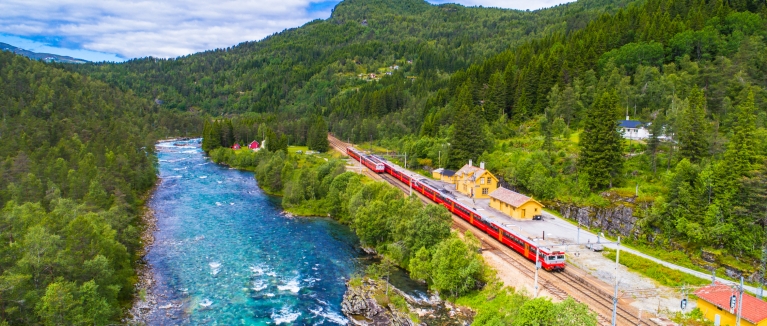
Stunning Norway
Enjoy the best of Norway with this scenic rail trip along fjords and waterfalls.
- Includes Stavanger, Oslo, Bergen, Trondheim and Bodo
- Travel time: 7 days or more
Check this itinerary →
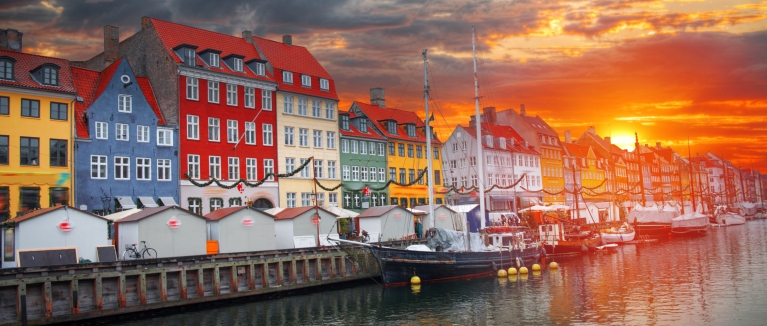
Scandinavian sun
Travel Scandinavia in summer for cool cities and the most spectacular nature.
- Includes Copenhagen, Bergen, Oslo, Roskilde, Stockholm and more
- Travel time: 14 days or more
Discover Scandinavia →
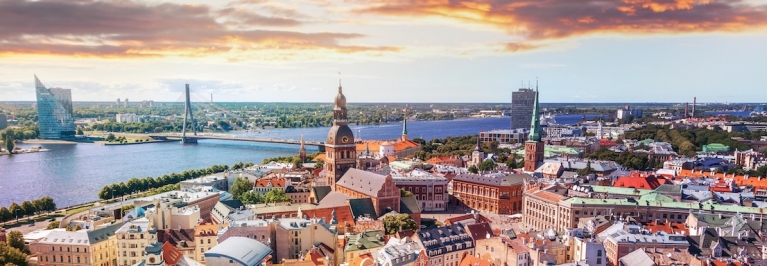
Baltic adventures
Explore Estonia, Latvia and Lithuania with this great itinerary.
- Includes Kaunas, Vilnius, Riga, Tartu, Tallinn and more
Explore the Baltics →
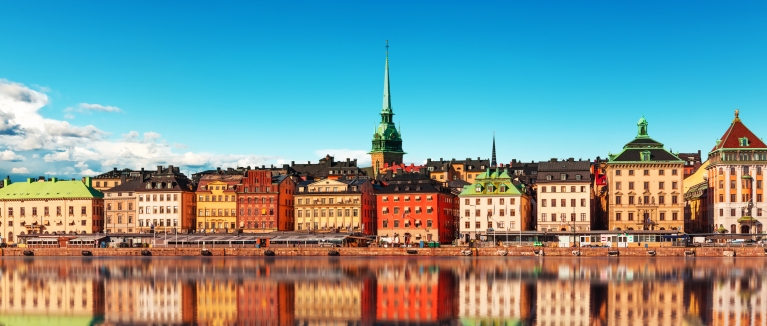
Stockholm Guide
Find out all the hotspots in Stockholm with our comprehensive City Guide.
- Includes all attractions in Stockholm and tells you how to get around
Discover Stockholm →
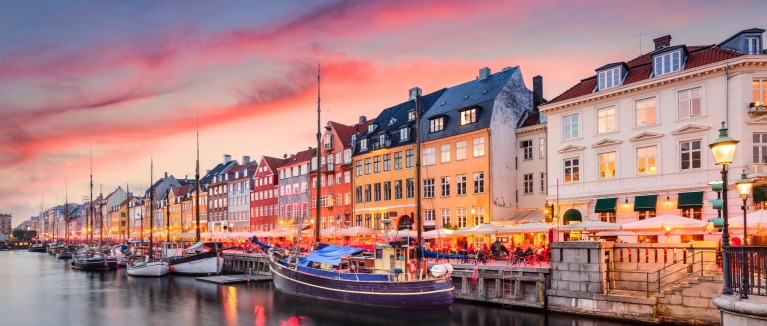
1 day in Copenhagen
Let us show you how to make the most of 24 hours in Copenhagen.
- Includes the major attractions in Copenhagen and some budget tips
Discover Copenhagen →
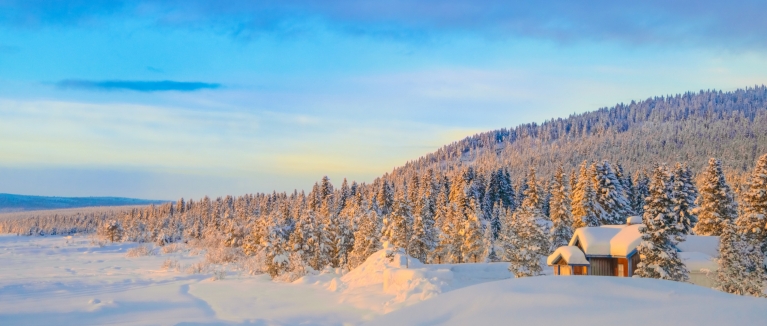
A Swedish winter
A journey to the Arctic Circle to see the Northern Lights.
- Includes Stockholm, Kiruna, Abisko and more
Enjoy winter in Sweden →
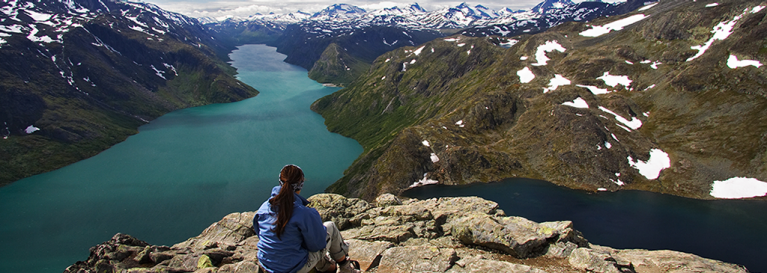
More trips in northern Europe
Most relevant for northern europe.
- Norway in Winter
- Includes Oslo, Bergen, Trondheim and Bodo
- Finland in Winter Includes Helsinki and the Santa Claus Express to Lapland
- 1 week in Lithuania Includes Vilnius, Trakai, Kaunas, Klaipeda, Nida and Siauliai
- 10 Winter rail tips Includes Finland, Norway and Sweden
- Europe's 10 best scenic train rides Includes Oslo to Bergen
Featuring Northern Europe
- 2 weeks in Europe: Sweden to Italy Includes Stockholm
- 10 destinations off the beaten track Includes the Lofoten Islands (Norway)
- Top 5 Europe Winter destinations Includes Sweden
- Get inspired by fellow travellers Includes Norway and Sweden
- Interrailing in Spring Includes Sweden
- 5 best Halloween destinations in Europe Includes Copenhagen
Other regions in Europe
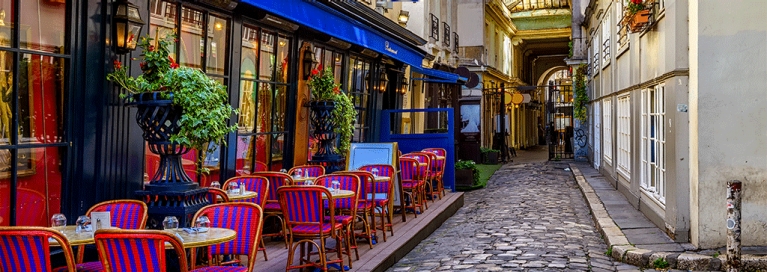
Change of currency
You cannot change the currency once you have a Pass in your cart. Remove the Pass, and then change the currency on the website header.

2 Weeks in Europe: 6 Itineraries
DISCLAIMER: This post might have links to travel services and products that we enjoy. We might make a commission from it at no extra cost to you.
Europe is a continent consisting of 44 countries with diverse languages, climates, and cultures . It has numerous world-famous landmarks preserved from years upon years of history.
Spending 2 weeks in Europe will cover plenty of amazing places. It’s not much, but a good start, especially if it’s your first time here.bulga
Another great thing about Europe is that the places are close to each other, you can reach most of them via train, buses, and driving. Land borders separate the countries. However, many of them practice free movement across borders.
This continent has peninsulas, islands, and varied landforms, as well as seas, lakes, and other bodies of water. There are infinite fascinating places to see, foods to taste, and activities to try out during your 2 weeks in Europe.
TIP : This is a long-form article, I highly recommend you check the Table of Contents below to help you navigate the page easier and faster.
THINGS TO KNOW BEFORE VISITING EUROPE
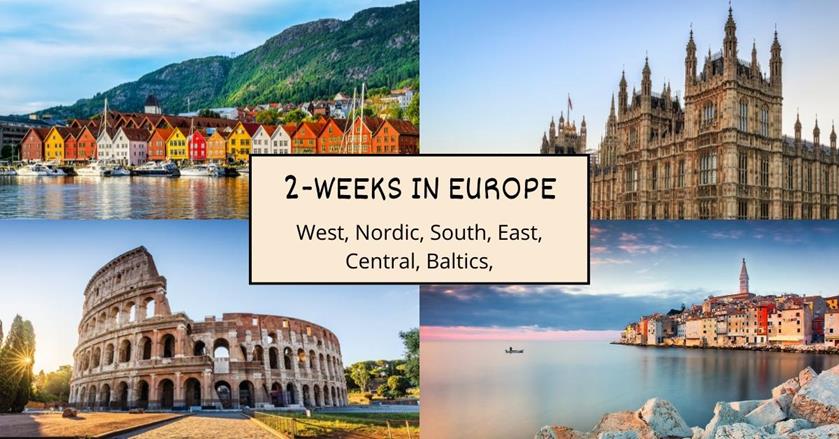
Before you go book your flight and hotels, take a look at the information below first. It will help you visualise and plan your itinerary better. You can get ideas on when to go, how to travel around, and what to pack.
When is the best time to go to Europe
This depends on what you plan to do. Most people go to Europe during summer, but of course, if you want to ski, come between December and February. I personally love going in spring and summer, during autumn, it’s also very pretty but it rains a lot.
You might want to consider travelling during the off-season because this is when there are fewer travellers and the prices of accommodations and tours aren’t sky-high so you’ll be able to save quite a bit.
Getting around Europe
The best way to get around Europe is to rent a car especially if the country you’re visiting are next to each other or have an open border agreement. It’s cheaper and gives you freedom of your time.
However, if you are crossing countries and they are not next to each other, you are probably better off flying than doing a long drive. Check first if your driver’s license is valid in Europe and check what type of cars each country you are going to have.
For example, Italy, Spain, and France are known for using a stick or manual transmission. While the UK and Ireland drive on the left.
Buses and trains are quite reliable and affordable. But there are also domestic flights which are affordable as long as you don’t pack too much unless you are willing to pay extra.
Language and currency
There are over 24 official languages in Europe. You should be able to get around with English but it’s important to also learn basic words to show respect for each country’s culture and easily communicate with locals.
Luckily though, most countries in Europe use Euro, except in the UK, Nordic countries, and maybe some countries in East Europe. It’s easy to pay with credit cards but carrying cash with you for emergencies is still advisable.
Visa and COVID-19 policy
Each country has different visa rules, however, if your destination is an EU member, they have the same visa policy; 90 days visa-free for visitors with a passport from North America, some Latin America, some Southeast Asia and East Asia, and most Oceania. This also applies to non-EU countries such as Switzerland and Norway.
For visitors with a passport from the EU or a European country, you should have freedom of movement for unlimited time except for some nationalities such as the UK and countries in East Europe.
Europe is open to COVID-1 vaccinated tourists. If you are unvaccinated, best to check if your destination has extra entry requirements. Depending on the airline and destination, you might be required to submit a test before boarding.
Wearing a mask is no longer required in many places in Europe, but it’s smart to carry one just in case you get to countries that still require them. Read about the EU reopening .
What is the average cost for 2 weeks in Europe
As diverse as the European culture is, the cost also varies a lot. The budget for 14 days in Europe depends on a few things such as the countries, type of tours, accommodation, and how you plan to move around.
$800 in Eastern Europe will not work for Scandinavia. $800 is a tight budget, but it might work for more affordable countries such as Eastern Europe or the Baltics (assuming this excludes the flights to the region and back). $1,000 will be fine for southern-east Europe, and $1,500 will be decent for central Europe. While west Europe and the Nordics plan to spend around $3,000.
The accommodation will cost the most expensive, but the food can be budgeted. Then the transportation. You can either use public transport or rent a push bike when moving around the cities. Take the bus or train when travelling to the next country or ride a plane.
Travelling during the peak season will also cost a lot more. Check under each itinerary to see the average cost of a 2-week trip in Europe.
Other basic travel tips
Planning a trip can be exhausting and often overwhelming. To make it a bit easier, I use travel sites and services that have flexible cancellation policies in case I change my mind or my travel dates. Here’s a list of travel tools I use. From flight selections, affordable hotels, wide-range options for car rentals, and even affordable travel insurance.
TOP PLACES IN EUROPE (pinned map)
Click the icon on the top right to enlarge the map. Credit: map data: Google
2 WEEKS IN EUROPE ITINERARIES
I will show your six itinerary options to choose from for your 14 days in Europe. Covering multiple countries and featuring famous attractions that are historical, cultural, and outdoor activities.
Deciding where to spend your 2 weeks in Europe can be hard. Should it be in Spain or Portugal? How about both? Should you visit Rome or Paris ? When unsure, there are a few things you can do to see which places are more suitable for you.
For example, Rome would be ideal if you love historical sites such as ruins. Perhaps you like history, but in the form of art, then Paris is the one. For food lovers, don’t miss visiting France, Spain, Italy, and Greece.
Itinerary #1 South Europe: Spain and France or France and Italy
We have two sub-options in our first itinerary for your 2 weeks in Europe. This includes either Spain and France or France and Italy. Spain is well-known for its lively culture, flamenco, arts, and literature, as well as its wines, beaches, and, of course, football.
If you feel like this itinerary is a little too expensive, you can instead go to Portugal. Take a look at how to spend 2 weeks in Portuga l or even just a few days in Lisbon. Spending 14 days in Southern Europe is a good place to do your first trip to this continent.
France, on the other hand, is well-known for macarons, wine, champagne, great pastries, as well as fashion, museums, and other historical sites. You could also do many water activities in France or if you plan to come during winter, you can head to the Alps for some skiing.
Italy is loved for its opera, its art cities, unique scenery, and good food. They are also among the four fashion capitals, with luxury brands, and of course, who could forget the Vespa?
If you have never been to Italy, make sure you visit Venice, Rome, Florence, and the southwest coast, where you can visit Naples for Amalfi and Sorrento. You can also consider 2 weeks in Greece for this itinerary. Not to mention, the south is a famous region to spend honeymoon in Europe .
Spain for 7 days
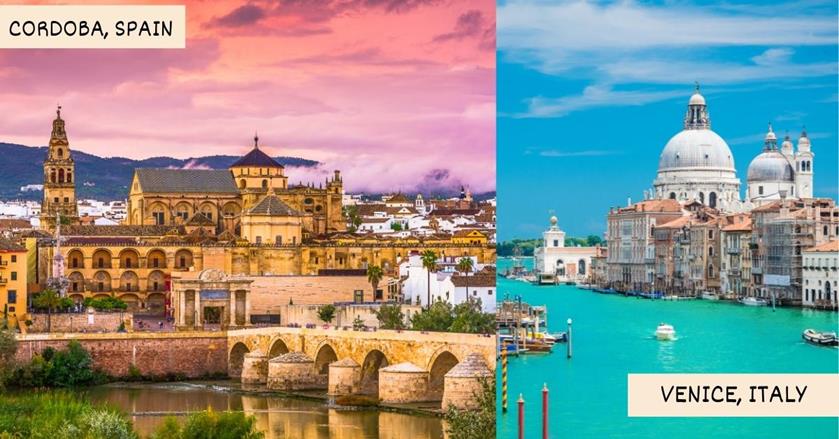
Spain is one of the most popular destinations in Europe, not only for foreign visitors but also for other European nations. With its stunning beaches, yummy food, and very welcoming culture, Spain is undeniably a must-visit when you come to Europe for 2 weeks.
Most people go to Madrid, the capital of Barcelona, a coastal city. However, if you want to get away from big crowds, head to Seville, Valencia, or even Zaragoza. For young travellers who love to dance and party, Ibiza is a top spot, while Palma, Tenerife, and Gran Canaria are awesome islands to explore and spend your vacation in.
We have a specific 2 weeks in Spain itinerary , which might help you plan a trip there if you decide to spend your trip in one European country only.
Here are some of the top-rated attractions in Spain :
- Alhambra and Generalife in Granada
- Palacio Real in Madrid – get your ticket in advance
- El Escorial near Madrid
- Aqueduct of Segovia – north of Madrid
- Sagrada Familia and Gaudi Sites in Barcelona – check tour prices
- Great Mosque in Cordoba, near Seville
- Guggenheim Museum in Bilbao
- Beaches of Gran Canaria
France for 7 days
Some of the options to reach France from Spain include flying, taking a train, riding the bus, using rideshare or driving. The most recommended option is to ride a plane, but if you have plenty of time, you should consider renting a car and driving on your own. We have an article with 3 different itineraries on how to spend 2 weeks in France .
France is a country famous for many reasons. The food is great, it is rich in culture, the abundance of historical sites, and thousands of wineries to explore. France is also known for Tour de France and is a great holiday destination any time of the year. You should geat a hop-on hop-off bu s that will take you to the top attractions of Paris.
Paris is an obvious place to visit, but if you don’t like big cities or have been here before, you can consider other places. For history buffs, head to Calais, Dunkirk, and Normandy. For those who love the outdoors, check out Lyon, Marseille, Nice, and Bordeaux (aka the Basque region).
Here are some of the top attractions n France:
- The Louvre in Paris – book a guided tour
- Cathédrale Notre-Dame de Chartres near Paris
- Eiffel Tower in Paris – get your skip-the-line ticket in advance
- Chateau de Versailles in Paris – visit with a garden access
- Mont Saint Michel
- Loire Valley Chateaux
- Côte d’Azur aka French Riviera in the South
- Provence for lavender fields
- Chamonix-Mont-Blanc for skiing in the Alps
Italy for 7 days
To reach Italy from France, you could either take the train or fly but taking the train is preferred by most tourists and locals alike because you’ll be able to reach your destination in less than five hours anyway. There are tons of routes to choose from if you want to see some interesting scenery and plan to drive instead.
2 weeks in Europe have to include Italy. It is loved for its dishes to die for, beautiful castles, amazing hiking trails, and warm culture. Just like in Spain and France, wine in Italy is world-class and their historical sites are well preserved.
Before you book anything, decide where you want to go. Rome and Venice are the top places to visit in Italy. But if you have been there, it’s time to explore Florence, Milan, Bologna, and Genoa in the north. For the south, head to Naples, Sicily, and all the way to Palermo. Check out our 4 itineraries for 2 weeks in Italy .
Some of the top tourist attractions in Italy include :
- Colosseum in Rome – get your ticket in advance to skip the very long queue
- Spanish Steps in Rome
- Trevi Fountain in Rome
- Venice Grand Canal – don’t skip the romantic gondola ride
- Gode Palace and St. Mark’s Basilica in Venice – explore with a tour guide and secure a ticket
- Leaning Tower of Pisa
- Vatican City near Rome; Basilica of St. Peter, Sistine Chapel & Vatican Museums – you can visit this in one go
- The Uffizi Gallery in Florence
- Cathedral of Santa Maria del Fiore in Florence
- Lake Como near Milan
- Cinque Terre
- Amalfi Coast
- Pompeii and Mount Vesuvius in Naples – visit this and the entirety of Naples on a day trip from Rome
Travel cost
These three destinations are one of the most expensive places in Europe. Budget around $2,000 for a 2-week trip around Spain, France, and Italy not including the flights from your location and back. Accommodation will be the most expensive cost while food is quite affordable in these places.
Of course, if you want to travel with luxury, you can easily spend $3,000-$5,000 which will allow you to stay at 4-5 star hotels, dine at fancy restaurants, and take a private car with a driver anywhere.
For those on a tight budget, $1,500 is possible , however, you will likely stay at youth hostels and share a room with other people in dorm/bunk rooms or even look at Couchsurfing. You can also save more money by looking at ready-to-eat meals at grocery stores or cooking in the hostel is possible. Join a free walking tour where you will be expected to give a tip based on the tour guide and the tour itself.
Itinerary #2 Central Europe: Germany and Poland
For this next itinerary, we’ll be covering 2 weeks in Central Europe, which consists of the countries Germany, Poland, Switzerland, Liechtenstein, Austria, Czechia, Slovakia, and Hungary. However, in this itinerary, we’ll only be covering Germany and Poland.
Germany is well-known for its cathedrals, castles, palaces, and colourful architecture, as well as its sausages and beers. It has many historical sites relating to World War I and II. Berlin is loved for being vegan-friendly, but meat-eaters shouldn’t have a problem finding their way around restaurants either.
Conversely, Poland is famous for its food, stunning geography, folklore, history, and friendly locals. In Poland, you’ll find Europe’s most ancient forest, Medieval Castle, the infamous Auschwitz-Birkenau Camp, amazing museums, and more.
Apart from that, you can also visit theme parks in Poland, such as Engerylandia Theme Park, Rabkoland, and Aquapark Sopot.

Germany for 8 days
Germany has so many things to offer that it would take 8 days to satiate your curiosity, and even then, you would barely scratch the surface. Don’t overwhelm yourself trying to see everything in 8 days. If you want t visit Germany only, we have these 2 weeks in Germany itineraries .
Most people will go to Berlin or Munich, but there are also other cities such as Hamburg, Frankfurt, Nuremberg and Cologne to name a few. I highly recommend you rent a car to move around easier, but taking a domestic flight or the train is also easy and affordable.
If you’re going to Berlin, the best way to see all the top attractions is by buying a hop-on hop-off bus with live a tour guide .
Here’s a list of the top attractions in Germany:
- Brandenburg Gate in Berlin
- Berlin Wall
- Cruise the River Spree – book a 2.5-hour boat tour
- Museum Island in Berlin
- Sachsenhausen Memorial – visit with a tour guide
- Neuschwanstein Castle near Munich
- Linderhof Palace near Munich – book a combo tour with Neuschwanstein Castle
- Marienplatz in Munich
- Pay respects at Dachau Concentration Camp – join a tour from Munich
- Kölner Dom in Cologne
- The Black Forest, Baden-Württemberg, near Stuttgart
- Miniatur Wunderland at Port of Hamburg
- Bamberg and the Bürgerstadt near Nuremberg
Poland for 8 days
There are tons of modes of transportation from Germany to Poland, including boarding a plane, using rideshare cars, trains, buses, or driving. Flights between these two countries are frequent and affordable.
Poland has a dark history, but the country is more than that. It has stunning lakes, UNESCO sites, and rather interesting cuisine, and it is in the top 20 safest countries in the world – a great place to discover if you are travelling alone.
Poland also has the biggest castle in the world, and many believe that vodka originated in Poland. In winter, you can ski in Poland, which is more affordable than France, Switzerland, and even Italy.
Many foreigners get confused and think Krakow is the capital of Piland, but it’s actually Warsaw. Apart from these two cities, you can also visit Gdansk, Wroclaw, Katowice, and Lublin. Most of the cities are connected via buses and trains hence moving around during your 2 weeks in Europe shouldn’t be a problem.
>>TIP: Check out our 2 weeks in Poland post if you prefer to explore that country on a single trip. There are two itineraries to choose from.
Here are some of the top tourist attractions in Poland:
- Wieliczka Salt Mine near Krakow
- Auschwitz- Birkenau Camps near Krakow – book a guided tour or combine it with the Wieliczka Salt Mine tour
- Oskar Schindler’s Enamel Factory in Krakow
- Wawel Royal Castle in Krakow
- Warsaw Old Marketplace
- Lazienki Park in Warsaw
- Malbork Castle near Gdansk
- Morskie Oko Lake and Hot Bath Pools near Zakopane – check tour prices
- Crooked Forest near Szczecin
Travel cost:
Central Europe in general can be costly, but only if you plan to visit Germany, Austria, and Switzerland. Poland and Czechia are both affordable destinations compared to their neighbouring countries. $2,000 will take you a long way if you choose one expensive place to spend a week and the other one is a more affordable country (e.g Germany and Poland or Switzerland and Czechia).
You can save even more money if you focus on Poland or Czechia only or book a trip to Switzerland just for 2-3 days instead of an entire week.
$5,000 will be a great budget for a luxury trip . This is suitable for couples who are on their honeymoon or retiree travellers. For young visitors and backpackers, you can probably get away with $1,000 to $1,500 for the 2 weeks trip .
Accommodation in Germany, Switzerland, and Austria is costly but affordable in Poland and Czechia. Rely on using public transportation in all countries, such as buses and trains, instead of renting a car or flying.
Itinerary #3 Baltics: Lithuania, Latvia, Estonia
The Baltics are one of the most affordable regions in Europe. Although it has its fair share of tourists, the streets and attractions don’t get too busy, even during the summer season. It’s an awesome place to spend your 2 weeks in Europe vacation without being surrounded by a big crowd.
Lithuania is famous for its natural scenery, including forests, lakes, flatlands, and other landscapes. There are also historical spots here to visit, and you must try their local ciders. I personally loved their local food, especially beetroot. If you’re a foody, check this Vilnius food guide for a list of must-try dishes.
Conversely, Latvia is known for its UNESCO World Heritage Sites and art nouveau architecture. It’s on the coast, hence if visiting during summer, don’t forget to dip your toes.
Last but definitely not least is Estonia, which is famous for its dense woods, thousands of uninhabited islands, and rich history. It experienced a boom in tourism recently since it implemented a digital nomad visa.
Estonia is among Europe’s most linguistic nations, is one of the countries with the cleanest air in the world, and half of the country is made up of forest, which probably explains the great air quality. We also have two itineraries specifically for 2 weeks in the Baltics only or 2 weeks in Eastern Europe itineraries .
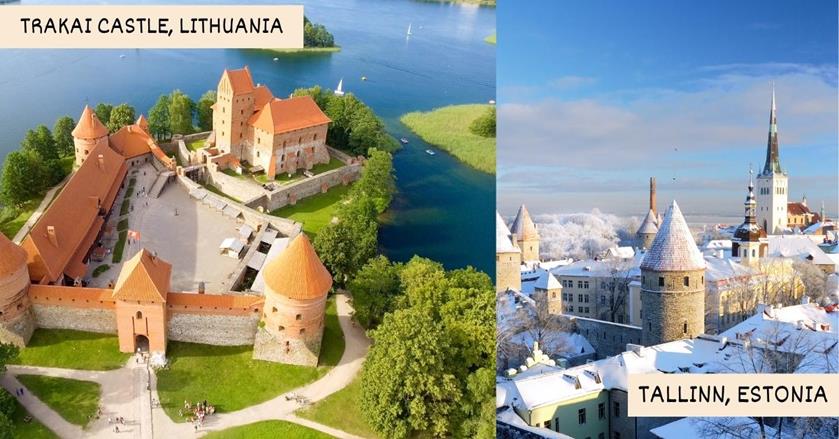
Lithuania for 5 days
Lithuania is rich in cultural preservation, so much so that UNESCO considered their folk dance as one of the intangible cultural heritages. They also have one of the oldest languages, even older than Greek, German, and Celtic, and the oldest tree in Europe could be found here as well.
With five days in Lithuania, you can do and see a lot of things. You can cover at least two major cities; the capital city Vilnius, and the cultural art city of Kaunas. If it’s warm enough, head to the coast and visit Klaipeda.
Here is a list of the best places to see in Lithuania:
- Gediminas Castle Tower in Vilnius
- Vilnius Cathedral Square
- Hot Air Balloon Flight – over Vilnius or Trakai Castle
- Energetikos ir technikos muziejus in Vilnius
- Museum of Occupations and Freedom Fights and A.Mickiewicz Memorial Museum in Vilnius
- MO Muziejus in Vilnius
- Gates of Dawn in Vilnius
- Three Crosses Monument in Vilnius – join a full-day tour from Vilnius
- Walk around Uzupis
- Trakai Castle near Vilnius
- Kaunas Castle
- Devils’ Museum in Kaunas
- Hill of Crosses near Šiauliai
Latvia for 4 days
You can go to Latvia from Lithuania by driving, riding a bus, plane, or taking the train. The most recommended option is through riding a bus as it is the cheapest and fastest. Latvia is also a great destination during summer. You can take a swim on its sandy beaches, lakes, and rivers.
You can either spend the entire 4 days in Riga, the capital city or take day trips to see Gauja National Park and Turaida Museum Reserve for example. You can also explore Riga on a segway tour .
Here are some of the top tourist attractions in Latvia :
- House of the Black Heads in Riga – get your ticket in advance
- Riga Cathedral
- Three Brothers, Latvian Museum of Architecture
- St. Peter’s Church
- The Freedom Monument in Riga
- Shop souvenirs at Riga Central Market – join a food-tasting tour
- Gauja National Park outside of Riga
- Rundale Palace and Museum ner Jelgava
Estonia for 4 days
To reach Estonia if you’re coming from Latvia, you could board a plane, ride a bus, take the train, or drive. The most recommended option would be to ride a plane as it’s the fastest, but the cheapest option would be to take the bus.
Estonia is very unique, they have islands but are inhabited – and that makes them interesting to visit. There, you can go fishing, sailing, canoeing, kayaking, and for those who love birds, birdwatching is a popular thing to do in Estonia.
Tallinn, the capital, is obviously the most popular destination. However, with 2 weeks in Europe, around the Baltics, you can also head to Parnu and Tartu – both are located in the south of Estonia. Go to Haeska, Kabili, and Matsalu for birdwatching and wildlife experiences.
Here are some of the sights to see in Estonia :
- Tallinn’s Old Town
- Lennusadam Seaplane Harbor in Tallinn
- Lahemaa National Parl – sign up to a day trip
- Patarei Prison Exhibition/Communism Prison in Tallinn
- Parnu’s Beaches
- Alpakafarm near Parnu
- Estonian National Museum in Tartu
- Tagurpidi Maja (Peapeal OÜ) / Upside Down House in Tartu
- TYPA Letterpress and Paper Art Centre in Tartu
- Kuressaare Castle in Saare
- Join a 3-hour food tour
Travelling around the Baltics is one of my favourite destinations and one I recommend if you’re on a budget. You will still experience the European culture, walk through the alleys and paves with cobbled stone, and eat delicious meals.
It’s honestly possible to travel here for around $1,000 for those on a budget . You will stay in a hostel and consume street food or grocery store meals. The tours also don’t cost that much. Accommodation is around $25 to $35 a night, but transportation is cheap.
$2,000 is the average cost where you get to have a private room and try out a few local restaurants. For a luxury trip, $3,000 will get you very comfortable.
Itinerary #4 East Europe: Hungary and Croatia or Romania and Bulgaria
East Europe is a massive region. You will have to choose 2-3 countries to cover during your visit and perhaps next time, you go to new places. Right now, we’ll only cover 4 destinations for your 12-day in Europe itinerary; Hungary and Croatia or Romania and Bulgaria.
Croatia has so much to offer, but in the last few years, being the filming location of Game of Thrones, this country attracted more tourists. Aside from that, they also have stunning waterfalls and gorgeous Adriatic Islands, among other landscapes.
Hungary on the other hand is famous for its ruin bars, paprikas, and goulash. It also has sought-after outdoor and public thermal bars and great nightlife. Outside the city, Hungary has a lot of nature preserves and can be an affordable ski destination in winter.
Bulgaria is the oldest country in Europe and has tons of hot springs. It’s undeniable how affordable Bulgaria is as a travel destination. It also sits right on the Black Sea, a popular spot during summer.
Nightlife in Bulgaria is another reason tourists come here for its affordability. Speaking of cuisine, the traditional Bulgarian food is something of a must-try.
Romania is famous for its Carpathian Mountains, Salt Mines, and Medieval Fortresses. Just like Bulgaria, it’s also located on the Black Sea. One might want to visit Romania since it’s famous for being the home of Dracula.
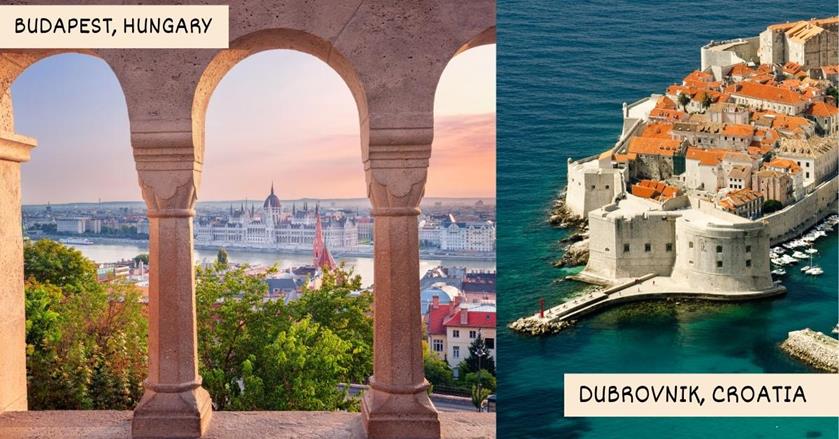
Hungary for 7 days
Hungary, like many other European countries, is a landlocked country. But it doesn’t mean you can’t enjoy summer in Hungary. This country has over 1,000 natural springs water, hence, the popularity of its thermal baths.
Budapest is not the only city worth visiting in Hungary, you should also consider Debrecen and Szeged. While Balaton Uplands National Park is the spot to you want to go hiking, join wine tours, and be around nature.
Here are some of the top tourist attractions in this country :
- Hungarian Parliament Building in Budapest
- Budapest’s Széchenyi Thermal Bath – book a full-day spa
- Buda Castle
- Buy souvenirs at Central Market Hall
- Take a boat cruise Danube River in Budapest – check cruise prices
- Matthias Church in Budapest
- Esztergom Basilica
- The Caves of Lillafured near Miskolc
- Lavender field at Tihany
Croatia for 7 days
It is relatively easy to travel to Croatia if you’re coming from Hungary as they are neighbouring countries. You could travel by bus, by train or by driving. Any option is fine, but the cheapest option would be to ride the night bus.
As mentioned before, Croatia is now popular for being the filming location for Game of Thrones, but there are other places to see in this magnificent country. Just like its neighbouring country of Italy, Croatia is also a fantastic beach destination and so much more affordable.
Zagreb is the capital of Croatia and a must-visit, then you can go to the coast. The most popular city is Split and Dubrovnik, but Zadar, Hvar, and Pula are an equally stunning area for swimming and other water activities.
Want to spend 14 days in Croatia ? Our guide has three itineraries you can check out and see which one suits you best.
Some of the top tourist attractions in this country include :
- Dubrovnik’s Old Town Walls – join a walking tour
- Trsteno Arboretum, Trsteno near Dubrovnik
- Dubrovnik’s Lovrijenac Fort
- Visit Game of Thrones filming locations – book a tour
- Nikola Tesla Technical Museum in Zagreb
- Diocletian’s Palace in Split – enjoy a walking tour with a local guide
- Blue Cave, near Split – book the 5 island boat tour
- Krka Waterfalls, near Split – visit on a boat tour
- Plitvice Lakes National Park near Zadar
- Kornati National Park near Zadar
- Euphrasian Basilica in Porec
- Pula’s Roman Arena
- Swim at Galebove Stijene in Pula
- Explore Brijuni/Brioni National Park near Pula
- Mulini Beach in Rovinj
Romania for 7 days
A massive country in East Europe, Romania has a lot to offer. From national parks, vibrant cities, historical sites, and beach access to the Black Sea. Bucharest is known for great nightlife, but apart from that, it’s also rich in cultural and historical spots.
Other than Bucharest, you have to go to the Transylvanian region, known as the home of Dracula. If it’s warm enough, head to Constanza, while Brasov and Cluj-Napoca are the areas to go to during winter for skiing and other winter activities.
Here are some of the places you could visit once you reached Romania:
- Romanian Athenaeum in Bucharest
- Grigore Antipa National Museum of Natural History in Bucharest
- National Museum of Romanian History in Bucharest
- Dimitrie Gusti National Village Museum in Bucharest
- Vaser Valley Forestry Railway
- Bran Castle aka Dracula’s Castle in Transylvania – book a tour combo with Peles and Brasov trip
- Sighisoara Historic Center
- Covered Stairway in Sighisoara
- The Clock Tower in Sighisoara
- The Black Church in Brasov
- Peles Castle near Brasov – book a 2-day tour from Bucharest to visit Brasov, Sibiu, and Sighisoara
- Bucegi Natural Park near Brasoc
- Transylvanian Alps
Bulgaria for 7 days
Just south of Romania, you can reach Bulgaria by train, bus, or driving. The quickest option would be to drive, which would take you more or less five hours, but the cheapest option is by riding a train.
Another country with the best nightlife, Bulgaria is popular with young tourists. But it doesn’t mean non-partygoers cannot enjoy Bulgaria. This country is a great place to explore the outdoors. There are many hiking trails and to ski here, you don’t have to spend too much.
Head to the capital city, Sofia, but for winter sports, you can go to Bansko, Borovets, and Pamporovo. If you are coming during the warm months, you can still go to the Black Sea by heading toward Varna.
Some of the top spots in Bulgaria are:
- National Palace of Culture in Sofia
- Sofia History Museum
- Rila Monastery – visit with combo tour to Boyana Church
- Seven Rila Lakes – check tour price from Sofia
- Tsarevets Fortress in Veliko Tarnovo
- Belogradchik Rocks
- Prohodna Cave in Karlukovo
- Krushuna Waterfalls
- The Rose Valley near Kazanluk
- The Ancient Theatre of Philippopolis in Plovdiv – join a tour of Plovdiv, Asen’s Fortress, and Bachkovo Monastery
- Pirin National Park near Plovdiv
- Thracian Tomb of Sveshtari near Shumen
East Europe is one of the most affordable regions in Europe. The accommodation alone can range between $20-$30 while food and the use of public transportation are also very affordable.
It’s easy to travel on a budget in eastern Europe, around $800 is feasible for backpackers and young travellers. If you want to be comfortable, $1,000 will be great and get you your own private room and dine at restaurants. $2,000 can easily be a luxury trip in this region for a 2-week adventure.
Itinerary #5 Nordic: Iceland, Norway, and Denmark
The next option would be the Nordic countries, which consist of Norway, Iceland, Sweden, Finland, and Denmark. However, in this itinerary, we will only cover Norway, Iceland, and Denmark.
Norway is also known as the Land of the Midnight Sun. It is famous for its fjords, lakes, and magical skies (Aurora Borealis), as well as Viking culture and folklore.
Iceland is also famous for a lot of natural wonders such as geysers, active volcanoes, and glaciers. You could also see the Northern Lights here. Iceland is relying 100% on renewable energy; hydropower, and geothermal.
Last but definitely not least is Denmark, which is well-known for its coastal towns, architecture, Royalty, and cuisine. Copenhagen is a must-visit. If you find yourself with extra time, you can hop on a train and head to Sweden.
You can also just visit Denmark, Norway, and Sweden using our 2 weeks in Scandinavia itinerary .

Iceland for 4 days
Iceland is the land of fire and ice, and you might be wondering why. They have glaciers but have volcanically heated pools at the same time, where you could swim all year round. That’s pretty fascinating.
Aside from that, it is also a literary-focused country. In fact, one out of ten Icelanders will publish a book even at least once in their lifetime.
Iceland is not a big country, but spending four days here is plenty. Most tourists love staying in Reykjavik, but you don’t have to. If you want to save money, you can stay outside the city and rent a car instead. You can easily move around in your own car, which means it doesn’t matter if your hotel is not in the city.
We have a complete guide and itinerary for 2 weeks in Iceland .
Top attractions in Iceland:
- Drive the Golden Circle
- Blue Lagoon – get your ticket in advance including Kerid Volcanic Crater
- Gullfoss Falls
- Seljalandsfoss
- Silfra – snorkel between 2 tectonic plates between North American and Europe
- Þingvellir National Park
- Jökulsárlón
- Chase the Northern Lights – join a tour to find the best spot
- Icelandic Phallological Museum
- National Museum of Iceland
- Reykjanesfólkvangur
- Whale Watching near Reykjavik – book a cruise
- Eystri-Fellsfjara / Diamond Beach
Norway for 6 days
You will need to ride a plane to reach Norway if you’re coming from Iceland. The fastest route takes more or less 6 hours. However, the journey would be worth it because there are so many sights and sceneries once you reach Norway.
This includes the world’s longest road tunnel and the world’s most remote island, among others. This is also an amazing place to ski during winter.
Many tourists usually go to Oslo and Bergen, but you can also add Stavanger, Kristiansand, and Tromso to your itinerary of 2 weeks in Europe.
If you want to see Fjords, you have to head west; from Trondheim all the way down to Stavanger. Check our 2 weeks in Norway itinerary list if you only want to see this country.
Here is a list of some of the best places to visit in Norway:
- Bygdoy Peninsula in Oslo
- Vigeland Sculpture Park in Oslo
- Viking Ship Museum in Oslo
- Naeroyfjorden
- Akershus Fortress in Oslo
- Oslo’s Fjords – check tour prices or a cruise to Nærøyfjorden, Flåm, and Stegastein
- Hanseviertel Bryggen in Bergen
- Sognefjord near Bergen
- Osterrjod and Mostraumen near Bergen – join a cruise
- Pulpit Rock (Preikestolen), in Stavanger
- Lofoten Islands
- Geirangerfjord
- Arctic Museum in Tromso
- Find the Northern Lights from Tromso – book a guided tour
- Atlantic Ocean Road
Denmark for 4 days
To reach Denmark from Norway, the best would be to take a plane. There is also a car ferry service, but with a limited time, it’s not ideal. Denmark has the oldest Monarchy in Europe.
Denmark is a small country but popular not only in Europe but around the world. For many years, it has been voted the happiest country in the world. It’s also known for being safe for tourists, the home birth of lego, and has the oldest monarchy in Europe and the oldest flag in the world.
Naturally, visitors will go to Copenhagen, but since the country (excluding Greenland and the Faroe Islands) is not that big, 4 days in Denmark is plenty
You can explore the entirety of Copenhagen and even have time to go to Odense, where the famous children’s book author Hans Christian Andersen was born. You can actually get to the city centre from Copenhagen airport in just 13 minutes – a great way to save time.
Here is a list of some of the best attractions in Denmark:
- The Little Mermaid (Den Lille Havfrue) – explore Copenhagen in a day
- Freetown Christiania
- The King’s Garden
- Amalienborg
- Rosenborg Castle
- Tivoli Gardens – get your ticket in advance
- Botanical Garden
- The Round Tower
- Memorial Anchor
- Copenhagen Opera House
- Walk around Strøget
- Ny Carlsberg Glyptotek
- Christiansborg Palace
- Danish Architecture Centre
- Ofelia Plads
- Legoland in Billund
- Hans Christian Andersen’s Childhood Home
- H. C. Andersens House
Nordic and Scandinavia is undeniably the most expensive place to travel around Europe. Accommodation alone could run $100, and dining and consuming alcohol are costly as well. But taking the bus and train is a little bearable.
To ensure that you will enjoy your 2 weeks in Europe around this region, plan to spend about $2,000 . If you are on a budget, you can probably do it for $1,700 but no less. But for l uxury, your trip cost will really skyrocket up to $5,000 .
Itinerary #6 West Europe: The UK, Netherlands, and Belgium
The last itinerary option for your 2 weeks in Europe includes the countries the UK, Netherlands, and Belgium, also known as the west of Europe.
The UK is popular for many things, including its monarchy, culture, history, and performers. Being the home of four different countries; England, Scotland, Wales, and Northern Ireland, you can easily say that it’s worth a visit. From bustling cities, amazing hiking trails, pubs to check out, and castles to explore.
There are tons of iconic places in the Netherlands despite it being a small country. The Netherlands is famous for many things . Here, you’ll be able to see windmills, cheese markets, bulb fields, and earthenware, among others. The Netherlands also have plenty of historical spots to discover including Anne Frank’s House.
The last country on our list is Belgium. They have high-quality chocolates, hence the name Belgian chocolate. This country is also well-known for waffles and beer and is the home to NATO headquarters.
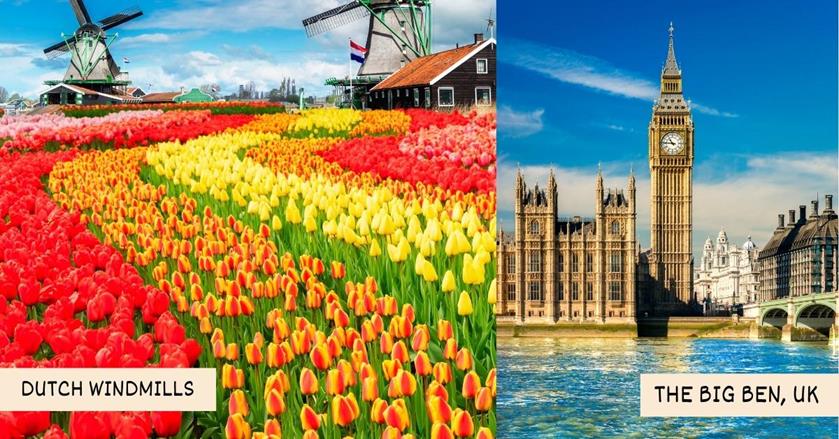
The UK for 6 days
There are many things to see in the UK, and six days is definitely not going to be enough. But don’t panic. If this is your first time here, list the attractions you really want to see first. The world-famous Big Ben, London Eye, and River Thames can all be found here, and that’s just in London.
If you have been here before, perhaps, you can now explore less popular areas. Perhaps, you can focus on hiking instead of being in the city or just spend 14 days in England only, especially if it’s your first time.
It’s undeniable that the UK has the most famous monarchy in the world. London alone has a lot of attractions related to the British Monarchy and historical places. In order to make the most out of your trip, the recommended duration of stay is at least five days.
ALSO READ: 2 weeks in the UK , 2 weeks in England , and 2 weeks in Ireland and Northern Ireland itineraries.
List of some best places to see in the UK :
- Tower Bridge
- Stonehenge – book a combo tour with Windsor Castle and Bath
- Buckingham Palace
- The British Museum
- Tower of London and Crown Jewels Exhibition – buy your ticket in advance
- Kensington Palace
- Madame Tussauds – get your skip-the-line ticket
- Shakespeare’s Globe
- St. Paul’s Cathedral
- Book a Harry Potter tour – Warner Bros. Studio
- Scotney Castle
- Bodiam Castle
- Warwick Castle
- Lake District National Park
- Dean Village
- Edinburgh Castle – book a skip-the-line tour
- Palace of Holyroodhouse
- Loch Ness, Glencoe, and the Scottish Highlands – check the tour price from Edinburgh
- Loch Lomond & The Trossachs National Park
- Titanic Belfast – join a guided tour
- Crumlin Road Gaol
- Giants Causeway – visit with a stop at Dark Hedges, Dunluce, and Belfast
- Free Derry Corner
- The Derry Walls
The Netherlands for 4 days
You could either ride the train or drive if you want to reach the Netherlands from the UK. Once you reach the Netherlands, you could experience the biggest ice skating tour in the world, or join a cycling tour. You can also know more about world-famous painters like Van Gogh and Rembrandt.
Four days sounds too little but you can actually do a lot while in the Netherlands. You can of course explore Amsterdam, and head to The Hague, Rotterdam, and Groningen.
Some things to see and do in The Netherlands:
- Jordaan and Amsterdam’s Canals – book the famous canal cruise
- Anne Frank House
- Rijksmuseum
- Mauritshuis
- Van Gogh Museum – enjoy with an audio guide
- The Windmills of Kinderdijk
- Hoge Veluwe National Park
- Valkenburg Castle Ruins
Belgium for 4 days
To reach Belgium, you could ride the train, ride a bus, use rideshare, or drive. The cheapest option would be to use rideshare and the most recommended option would be to ride the train. It would take you almost 3 hours to reach your destination.
The popular cities in Belgium are Brussels which is the capital, Ghent, Antwerp, and Bruges. You can take buses, trains, or rent a car to travel between cities. Don’t forget to go try different beers and waffles which are two of my favourite part of my visit.
Popular attractions in Belgium:
- Grand Palace
- Atomium – get your entry ticket in advance
- Sign up for the famous Hungry Mary’s beer and chocolate tour or join chocolate making class
- Manneken Pis
- Day trip to Bruges and Ghent – enjoy with a tour guide
- The Canals of Bruges
- Battlefield in Flanders
- Belfry of Bruges
- Basilica of the Holy Blood
- Bruges Beer Experience
- Sint-Salvatorskathedraal
- Gravensteen
- Museum Aan de Stroom
- The Rubens House
What I enjoy about travelling in western Europe is how it’s honestly a pricey place but it can be done on a budget. If you think you can stay on your feet for long hours and walking around is not a problem, you can easily cut costs by taking the bus or taxi. The accommodation will surely get you, but dining can be affordable.
The street food in all these countries is fun, globally diverse, and easy to find. For budget travellers, $1,700 is required for your 2-week trip and most likely requires you to stay in a youth hostel. $ 2,500 offers comfort and a bit of luxury where you can dine at nice restaurants. $4,000 means you can stay in hotels right downtown and near the top attractions, With this budget, you can even hire taxis during your entire trip.
SUMMARY OF 2 WEEKS IN EUROPE
There are so many countries to choose from if you plan to visit Europe. Fortunately, Europe has amazing transportation between cities and countries, making it easy to travel around even with limited time.
When planning your 14-day itinerary for Europe, don’t try to cram it too much. It’s better to travel a bit slower, see fewer places, but be able to enjoy and process everything you have seen and experienced. Europe is not going anywhere, you can always visit again and check out a new place.
I hope that you found these 2 weeks in Europe itineraries helpful in planning your own.
TO SAVE THIS ITINERARY, PIN THIS IMAGE BELOW:


7 Day Northern Italy and Switzerland Itinerary

Published: 3/8/2024
The Complete Itinerary for Our Northern Italy and Switzerland Trip
If you’re planning a trip to northern Italy and Switzerland , I’m laying out our entire itinerary in this post.
In November 2023, I flew to Milan, Italy with my sister-in-law. We crafted an epic week in both the Lombardy region of northern Italy and Switzerland’s Ticino canton. Although we never get more than an hour away from Milan Malpensa Airport, our week included everything from big city bustle and culture, leisurely lakeside dining, and hikes through the Swiss Pre-Alps.
This itinerary includes three nights in Italy’s business and fashion capitol, Milan . From there, we’ll hop on a train in Milan Central and pop across the border to Lugano, Switzerland . After two days of soaking up leisure and luxury of Lugano, we return to Italy to round out our week with time on Lake Como .
You’ll be amazed by how easy it is to explore the Italian Lake District by train. Since we’re spending this week in a very concentrated area of Europe , you’ll never be on a train for more than 1.5 hours. This maximizes sightseeing opportunities and allows you to soak up the area’s culture and striking landscapes.
So let’s jump in and start exploring these beautiful and rewarding parts of Italy and Switzerland.
This post may contain affiliate links. When you purchase something through these links, I receive a small commission that helps me create this blog’s content. There’s no extra cost to you.
Table of Contents
Day one: arrive milan, day two: milan highlights, day three: milan explorations, day four: travel to lugano, switzerland.
- Day Five: Lugano, Switzerland Explorations
Day Six: Travel to Lake Como, Italy
- Day Seven: Como City, Italy
About This Itinerary
Getting around, where to stay, conclusion: 7 days in northern italy and switzerland.
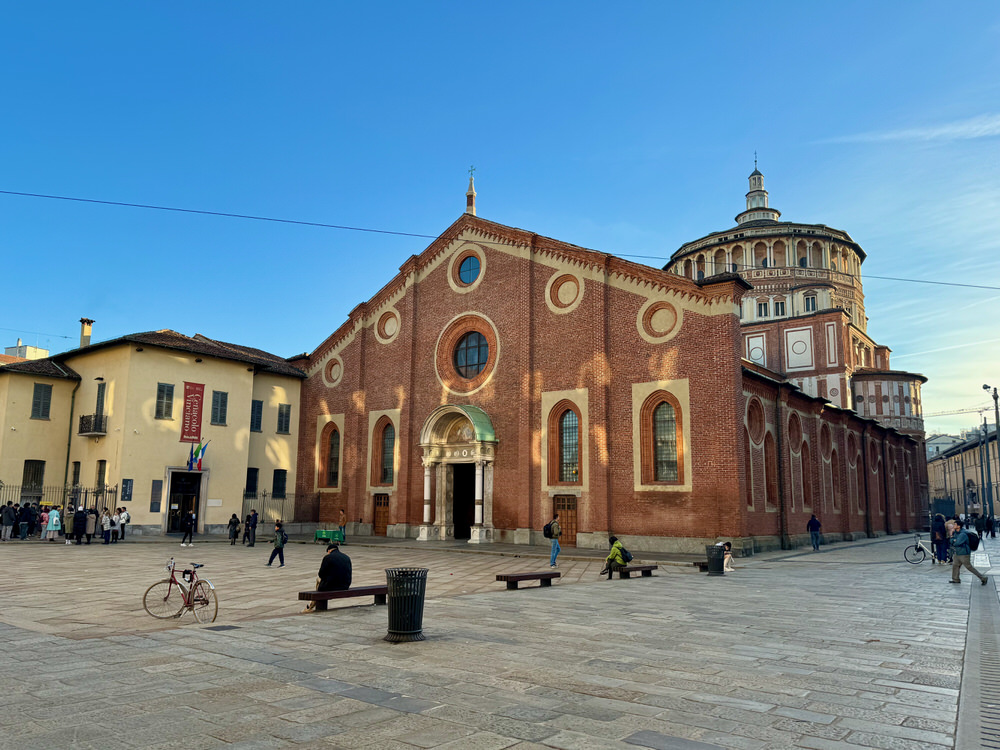
We took an overnight flight from JFK and arrived at Milan Malpensa Airport in the mid-morning. After a speedy trip through customs, we grabbed our luggage, and headed to the Malpensa Express terminal which connects right to the airport.
One of my favorite things about Milan is how user-friendly it is. Instead of having to faff about with tickets in our jetlagged state, you can just use a tap credit card (or ApplePay) to the board the train. You tap your card again at the turnstiles at your destination so it can properly calculate your fare.
Since we were staying just west of central Milan, we took the Malpensa Express to Milan’s Cadorna station . From there it was about a half mile walk to our Airbnb . If we had taken the train to Milan Central – which I think is most people’s first instinct – we would have added a 20-minute subway ride to our journey.
Our Airbnb host kindly accommodated an early check-in. We did a little jetlagged exploration of our neighborhood on Viale S. Michele del Carso near the Conciliazione subway station. After we’d grabbed lunch and some breakfast supplies, we turned in for a nap before starting our Milan explorations in earnest later that afternoon.
Day One Waypoints
We signed up for a two-hour walking tour of central Milan through Airbnb experiences. This was an excellent introduction to Milan. Since it was just the two of us and our excellent tour guide, Ruth, the tour was extremely tailored to our interests.
Points of interest included most major Milan landmarks including Sforzeco Castle , Brera , La Scala Opera House , Galleria Vittorio Emanuele , Duomo Cathedral , and Peck grocery store.
Day One Eats
Our Airbnb was located on a bustling neighborhood street. We hit up the nearest bakery – Panificio Pastore – for lunch, where I had the shocking realization that I still can’t speak Italian. Despite the language barrier, I ended up with a very tasty panzerotti.
I figured my lack of fluency in Italian – a language I’ve never studied – must be because I was undercaffeinated. We headed across the street to Franci’s espresso bar . Since it was after 11 a.m., I played it safe and got “un caffe” – that is, an espresso – rather than a cappuccino.
Since our walking tour ended right in the Piazza del Duomo, we hit up Ravizza 1871 for our first-ever aperitivo experience . We were immediate converts.

This is the sort of sightseeing day that I get told is impossible when I write about it. However, I can assure you, we really did see all of these Milan things in one single day. It only took us 14 hours!
If you want to leave your hotel or apartment at 8:30 a.m. and return around 10:30 p.m., you can absolutely replicate this day in Milan ! I’m not sure I 100% recommend it – but we did sleep really well this night . . . .
Day Two Waypoints
We started the day off strong with a guided tour of Da Vinci’s The Last Supper . From there, we walked to the Starbucks Reserve Roastery where we enjoyed affogatos made with approximately one pint of vanilla ice cream.
We spent about an hour going through the galleries at Pinacoteca di Brera located on the first floor of the Palazzo Brera , then popped into the building’s “back yard” to the Orto Botanico di Brera . From Brera, we made it back to Piazza del Duomo just in time for a tour of Milan’s Duomo cathedral . We toured both the rooftop and the interior.
I popped into Peck , a gourmet delicatessen, to pick up a panettone to bring home for my Christmas celebrations. Jokes on me – I actually ended up with a pandoro , which was amazingly delicious. We then took our first Milan subway ride to Bar Basso , home of the Negroni sbagliato . Our day ended along the Navigli canals .
Day Two Eats
Really busy sightseeing days often go hand-in-hand with slightly disordered eating. Happily, we started off the day strong with breakfast in our apartment. Since we had some time to kill in between checking in for our Last Supper Tour and the actual tour, we popped into nearby Leonardo Bistrot on Corso Magenta for an espresso.
On our way from Palazzo Brera to the Duomo, we popped into Bistrot El Birocc on Via Brera to grab something fast we could eat on the go. While this bistro isn’t well-reviewed, we enjoyed prompt, speedy service as well as tasty sandwiches.
We hit the popular aperitivo (really more of an apericena) spot La Hora Feliz . This was meant to be an appetizer, but we were pretty hungry by this point and the massive buffet was just too tempting.
After spending most of the day in a calorie deficit, we decided to make up for last time and hit up L’Altro Luca & Andrea for some traditional Milanese fare along the Grand Canal in Navigli.

After visiting basically all of the Milan “must see” attractions the day before, we enjoyed a slower pace today. We still didn’t get home until well after 10:30 p.m. I love the point in a trip where a destination starts to click.
We spent a lot of time on the Milan metro today. Nothing tricks you into thinking you’re a local faster than successfully using the public transportation.
Day Three Waypoints
We had a great experience at a Pasta and Tiramisu making class in the Casoretto neighborhood near Milan Central. After three hours of cooking and dining, we took the subway to central Milan, where we capitalized on the beauty sunshine by wandering through Parco Sempione to Arco de Pace . We also visited the famous bone chapel in Chiesa di San Bernardino alle Osso .
Our night ended at the Teatro alla Scala , attending the Onegin ballet.
Day Three Eats
We of course got to eat the pasta we made during our class with Pietro. For dinner, we went to a charming bistro near our apartment: Larky .

All good things must come to an end. After nearly 72 very full hours in Milan, we headed to Milan Central to board a train to Lugano, Switzerland .
Because of its close proximity, Lugano is often included in a tour of northern Italy and the Italian Lake District. You can do Lugano as a Milan day trip, but I think it’s better to spend at least an overnight in Lugano .
Don’t believe folks who tell you that Lugano is the same distance by train from Zurich as it is from Milan. It took us less than 1.5 hours by train to reach Lugano from Milan Central. From Zurich, it takes 3 hours.
One advantage of accessing Lugano from the north is that it’s easier to catch the celebrated Bernina Express , which is itself a UNESCO World Heritage site. However, the Bernina Express doesn’t actually stop in Lugano. Instead, you buy a bus ticket that will take you from Lugano to the Bernina Express’s terminus in Tirano, Italy. We skipped it this go-round.
Day Four Waypoints
We settled in on a Zurich bound train for an hour and 20 minute ride up to Lugano. Upon arrival, we checked into the Grand Hotel Villa Castagnola . We immediately started to soak up Lugano’s leisure vibes and enjoyed a laidback afternoon enjoying our room’s balcony and garden view.
After a while, we decided to stroll along the Lake Lugano waterfront, visiting Parco Ciani and Piazza della Riforma along the way.
Day Four Eats
Il Fermento is a brew pub located right along the waterfront in downtown Lugano. It was the perfect spot for today’s aperitivo.
We ended our night with an epic food and wine event at Restaurante Arte de Lago . This Michelin star restaurant is run by Grand Hotel Villa Castagnola although it’s located in a separate building right on the waterfront about a block away from the hotel. The restaurant also hosts an art gallery with rotating exhibits. We opted for the tasting menu with wine pairing .
While the entire experience was fun and memorable, at the price point I just can’t in good faith tell you this is a “can’t miss” Lugano thing to do. I’m kind of like Ron Burgundy and teleprompter: I will eat anything you put in front of me. I’m not sure my palette is refined enough to truly appreciate a fine dining experience.
Day Five: Lugano Explorations

I’d been looking forward to exploring Lugano for decades. Yes this is another trip inspired by a novel : Sharon Creech’s Bloomability to be specific . We couldn’t have asked for a better day: it was our fifth mild, sunny day in a row! I’m glad I didn’t put a rain jacket on my Milan packing list !
Day Five Waypoints
We took the funicular to the top of Monte Bre , where we enjoyed stunning views of Lugano, Lake Lugano, surrounding foothills, and the Swiss Alps . Once we’d drunk in the view, we started a long descent down Monte Bre on a well-signed path to the medieval town of Gandria .
To return to Lugano, we caught a passenger ferry boat at the Gandria dock. After a little souvenir shopping in Lugano, we return to our hotel for some well-earned soak time in the pool and sauna.
Day Five Eats
After a few days of Airbnb apartment living, I was really looking forward to an impressive European breakfast spread. The Grand Hotel Villa Castagnola didn’t disappoint with an array of hot breakfast foods, pastries, cakes, yogurt, cereals, juices, and more. Most notable was a tray of honeycomb!
After our hike and boat ride, we popped into the elegant Grand Café al Porto in downtown Lugano for a late lunch. Because our lunch was so late, we settled on a light supper at our favorite Lugano haunt, Il Fermento .

All too soon, it was time to say good-bye to lovely Lugano. But don’t worry – we’re not leaving the Italian Lake District just yet!
Day Six Waypoints
After breakfast we wandered back into downtown Lugano for a little souvenir shopping. Since it was Tuesday, we stumbled upon the Lugano Farmer’s Market . Ashley also found the perfect Switzerland souvenir: Swiss Army knives!
Eventually we made our way to the train station and took a 30-minute ride to Como City on Lake Como in Italy.
The reason we decided to include Como City on this trip was because they were the only city in the Milan area that had their Christmas market up and running in late November. (If we hadn’t been concerned about the Christmas market, we probably would have ended up in a more celebrated Lake Como destination like Bellagio.)
We spent a fair amount of time exploring the Christmas market – including spending an hour skating on the rink in Piazza Cavour . We also toured the Como Cathedral .
Day Six Eats
We arrived in Como just in time to hit Osteria de Gallo for a late lunch. This was very fortuitous timing since the busy restaurant usually requires reservations unless you come after lunch or dinner rushes. Their homestyle regional menu changes daily.
We hit up Hemingway Bar for aperitivo which doubled as a light supper. Their champagne cocktails are one of the best things I’ve ever tasted.
We tried multiple times to find a good gelateria on this trip, but because we were traveling in the off-season, we found them all closed by early evening. We settled on gelato at our hotel’s restaurant. While it wasn’t the same experience, it wasn’t any less tasty.
Day Seven: Como City Explorations

I will admit, I was not particularly excited about Como City when we planned our travels. However, as is so often the case with destinations I’m reticent about, I ended up loving it. I’m not sure if it was because we’d firmly settled into our travel pace by the time we arrived or because we left while we were still having fun, but Como ended up being my favorite place on this trip.
While we didn’t doing any popular Lake Como excursions like take a boat to Varenna, we found more than enough to fill a day right in Como City .
Day Seven Waypoints
Let’s be honest, when you visit Switzerland and Italy, one cable car ride isn’t enough. We started our day off with a funicular to the small town of Brunate located about halfway up Monte Boletto. This mountain flanks Como City’s eastern side.
From the funicular station, we continued our upward climb: hiking about 25 minutes to the viewpoint at Faro Voltiano , a memorial lighthouse celebrating Como inventory Alessandro Volta.
After taking the funicular back to town, we did a little souvenir shopping at the Christmas market and in the Como Old Town area. Sadly, the day ended with a train ride to Milan Malpensa, where we checked into an airport hotel and prepared for our journey back to the States the next morning.
Day Seven Eats
We loved Osteria de Gallo so much that we returned again for lunch a second day. While my pork shank and polenta wasn’t as much to my tastes as the meatloaf I’d had the day before, it was an excellent example of regional cuisine. Ashley tried their red table wine, which was very nice.

If you read through this and thought, “wow, there’s a lot of northern Italy and Switzerland you didn’t cover,” you’re right. While I didn’t realize until the end of our trip that we never got more than an hour away from Milan Malpensa Airport, we intentionally kept our travel scope pretty small.
There’s so much to see in Milan and the Italian Lake District, that we wanted to spend as much time as possible with our boots on the ground actively sightseeing. If you use this itinerary, in total, you’ll spend less than three hours in transit during this entire week – and that’s factoring in the commute from Milan Malpensa to central Milan on the Malpensa Express.
So while you won’t see northern Italy highlights like Venice, the Dolomites, or Turin, I really do think this itinerary offers a great immersion into the Lombardy region of Italy and the small Italian-speaking part of Switzerland. If you must cover more ground on this trip, I’d shave off a day in Milan and turn your Lugano experience into a day trip.
However, since you’ll often find discounted tickets to Milan Malpensa Airport, this trip makes a great introduction to the Lombardy and Ticino regions of Italy and Switzerland. You’ll have all sorts of amazing northern Italy and Switzerland destinations to explore on your next Italian/Swiss adventure!

We traveled from town to town in northern Italy and Switzerland by train. I booked our tickets online about 2 months ahead of time and they worked perfectly.
- For train journeys originating in Italy, book your tickets through Italia Rail .
- For train journeys originating in Switzerland, book your tickets through SBB CFF FFS .
We had assigned seats for our trip from Milan to Lugano. The rest of the time, we used regional trains to get around. These tickets were actually valid for four hours around the boarding time I’d booked them for. We really appreciated this flexibility, but the trains were definitely more crowded with fewer places for our luggage.
From a souvenir standpoint, bringing my large roller bag was a great decision. But it was definitely a pain on our commutes. Several of the trains didn’t have large luggage racks and we ended up sitting in seats with the bags wedged in front of our knees. Next time I’ll forego bringing home a full-sized pandoro and just use my carry-on bag.
When we were at our destination, we used a mix of public transportation – including subway, bus, and taxi – to get around. However, all our destinations were very walkable, so we mostly depended on our feet.

Milan Lodging
We stayed in this Airbnb in the San Vittore neighborhood near the Santa Maria delle Grazie and The Last Supper . Our street was filled with shops, restaurants, espresso bars, and bakeries. We loved pretending we were locals. I definitely gained an understanding of why so many people love living in Milan after three days based here.
If this apartment doesn’t work for you and your group, there’s no shortage of other lodging options in Milan .
Lugano Lodging
I embraced Lugano’s luxury and leisure vibes and booked two nights at the Grand Hotel Villa Castagnola . Although it’s not centrally located, its position on the far east end of town right at the base of Monte Bre actually worked out perfectly for us.
The hotel offers a gym, salon, pool and sauna area, three restaurants (one in a separate building near the waterfront), meeting rooms, libraries, and garden. We ended up with a fantastic view of both Lake Lugano and the gardens. If you want a five-star property, the Grand Hotel Villa Castagnola is definitely worth the splurge. Otherwise, check out these other Lugano hotels .
Como City Lodging
We spent one very pleasant night at the Albergo Terminus Hotel . This four-star hotel conveniently located right on the waterfront offers a spa, restaurant, and boutique as well as a variety of rooms ranging from single rooms to deluxe suites.
While the shared spaces in the hotel felt a little dark and cramped (the building was originally built as a spa), we had a beautiful suite with a massive bathroom, comfortable sitting area, and a great view overlooking Piazza Cavour. The best part of our stay was the gorgeous breakfast spread. Seriously, don’t miss it.
You can also check out other Como City lodging .

To be honest, a week will never be enough time in Italy and Switzerland. However, if you want to maximize your time in the Milan and Italian Lake District, this 7-day itinerary gets you to all the best sites in Lombardy and Ticino.
I designed this trip to be a truly immersive experience with the perfect balance of sightseeing, outdoor adventure, and delicious food.
You really don’t have to cover much ground to fill your week with Milan masterpieces like Da Vinci’s Last Supper and the Milan Duomo cathedral, beautiful views of the Swiss Alps from the foothills in Lugano, or amazing regional cuisine beside Lake Como.
With ample public transportation options, it’s easy to travel around northern Italy and Switzerland without a guide. You can opt to either stay in the lap of luxury at a five-star hotel or find a cozy apartment that will accommodate any budget.
I hope this post inspires you to book tickets to Milan, Italy so you can experience this beautiful corner of Europe yourself!

Hi! I’m Ada, a travel writer based in northern Minnesota, on a mission to see the world. I use this travel blog to provide practical, no-nonsense travel tips and itineraries for both domestic and international travels.
Home Airport:
European Christmas Markets
Where I’ve Been:
If you liked this Northern Italy and Switzerland Itinerary, check out these posts!

Ada is a travel writer based in northern Minnesota. She’s spent two decades as a freelance writer. She’s lived in three countries and has visited all 50 states. In addition to traveling the world, she runs a Boundary Waters outfitters and helps people plan canoe trips and other outdoor adventures in northeastern Minnesota.
Other Recent Articles
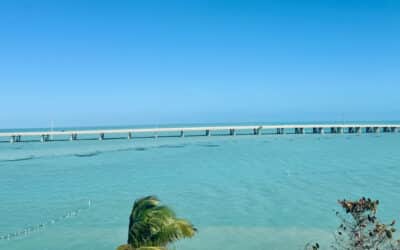
Best Stops On A Florida Keys Road Trip from Miami to Key West
Whether you’re driving from Miami to Key West or just day tripping on the Florida Keys Overseas Highway, you’ll want to include these 10 stops in your drive.

Key West Packing List For A December Visit
My Key West packing list has you covered with what to wear for a winter visit. My complete (& printable!) packing list makes packing for Key West, Florida a cinch.

What To Do in Grand Rapids Michigan For A Stellar Weekend
Wondering what to do in Grand Rapids Michigan? This guide rounds up all the best things to do in Grand Rapids including restaurants, mansions, events, art, gardens, and more.
Thanks for signing up!
Thanks for visiting nordicvisitor.com! For the very best browsing experience on our website, we urge you to upgrade to the most recent version of your browser . Some of our site features may not function properly on older versions.
- Travel Update
- Search Suggested Results View All Results
- EUR (€)
- GBP (£)
- Self-Drive i
- Privately Guided i
- Guided Small Groups i
- Northern Lights i
- Honeymoon & Romance i
- Ice & Snow Hotels i
- Multi-Country Tours i
- All Travel Styles
- Show all tours
- Best Sellers
- Special Offers
- Scandinavia
- Switzerland
- United Kingdom
- Book With Confidence i
- Why book with us i
- Booking Terms i
- Sustainability Policy i
- Manage Booking
- Privacy policy
Iceland Bíldshöfði 20 110 Reykjavík +354 578 20 80 View Map
Sweden Scotland View Details
Northern Europe Tour Packages
Whisk yourself away on a Northern Europe tour, where all the planning has been done for you. Imagine chasing the northern lights, touring ancient castles, or experiencing vibrant Scandinavian cities. You can choose how you want to travel on a customisable trip with Nordic Visitor.

Top Ways to Explore Northern Europe
Discover Northern Europe your way with these top travel styles. You could enjoy the freedom of exploring at your own pace on a road trip, coastal voyage, or train journey. Or learn from a knowledgeable local guide when you opt for a small group tour or privately guided trip.
Self-Drive Packages
Small group tours, northern lights tours, privately guided trips, nordic cruises, train tours, independent tours, most popular northern europe tour packages.
These top trips come highly recommended by our customers. Add the Nordics to your wish list if you’re craving dazzling glaciers, deep fjords, and artistic capitals. Or if it’s verdant hills, crumbling castles, and historic cities that you’re after, head to Scotland and Ireland.
Highlights of Norway
Hurtigruten cruise, norwegian fjords & expert tour guide.
Highlights of Scotland
Scottish highlands, loch ness & isle of skye.
Natural Wonders of Iceland
The ring road & snæfellsnes, highlights of scandinavia, sweden, denmark & norway, destinations.
Discover 14 delightful destinations across the North.
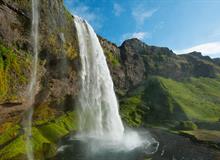
Nordic Visitor Reviews
Read what our wonderful guests had to say about their Nordic Visitor trips.
Amy Woods United States
I have already recommend Nordic Visitor to several friends and family members! We had an absolutely amazing trip and... read more
I have already recommend Nordic Visitor to several friends and family members! We had an absolutely amazing trip and I can't wait to come back! Everyone was helpful and patiently answered all of my questions. I'm very happy we chose Nordic Visitor for our trip and I would choose them again!
Jennifer United States
On our trip, we met a few other Americans. Told them about Nordic Visitor and they were impressed. I found Nordic... read more
On our trip, we met a few other Americans. Told them about Nordic Visitor and they were impressed. I found Nordic Visitor's website very user-friendly. I love that all the documents sent was super easy to just hand the concierge and the 2 excursions we booked already had our names down. I loved the 2 excursions in the package we chose. Overall, it exceeded my expectations and I'm so glad I chose this particular trip.

Check out these special offers to save up to 15%.
Get in touch with one of our local travel experts
Whatever your needs, we are here to help. If you have any questions about our packages or services, please do not hesitate to contact us.
Why Choose Nordic Visitor

Book With Confidence
Secure your trip your way with Nordic Visitor. Book a tour with as little as 10% deposit. With a 20% deposit or more, you will receive our Cancellation Protection free of charge. You can also pay the full price right away to guarantee today’s exchange rate. Terms & conditions apply.

Trusted local travel experts
Established in 2002, Nordic Visitor is a leading travel agency in Northern Europe. Book with us and you’ll have your very own dedicated travel consultant that’s passionate about your destination. They’ll use their insider knowledge to plan the trip of a lifetime for you.

Great reviews
Nordic Visitor is dedicated to the best service quality, and this is reflected year after year when Tripadvisor awards us with their Certificate of Excellence. We also take great pride in our customer feedback: 97% of our travellers say they would recommend us to friends and family.

You are in good hands
Our 24/7 helpline means that we’re there for you throughout your tour. Rest easy knowing there’s a regional expert just a call away should anything unforeseen happen, like unusual weather or events. In this case, we’ll amend your itinerary as needed while keeping you safe and informed.
Flexible tour options
Nordic Visitor packages are designed to include the best routes and attractions, but it’s also easy to customise your trip. Tailor your tour online by adding extra nights and optional excursions. Or speak to your dedicated consultant to find out how your itinerary can be personalised.

Full financial protection
With Nordic Visitor, you have peace of mind knowing your tour arrangements with us are 100% financially protected. Your payments are safeguarded as we comply with European Union laws on Package Travel regulations. This guarantees you a refund in the unlikely event of insolvency.

Handpicked hotels
Head out exploring, safe in the knowledge there’s a carefully chosen accommodation waiting for you at the end of each day. You’ll sleep soundly in places we’ve personally selected based on their location and high standards of comfort and cleanliness. So simply check-in, relax and recharge.
When to Travel
Summer and winter offer plenty of memorable ways for you to experience Northern Europe. Picture yourself exploring the Norwegian fjords under summer’s midnight sun, or watching the aurora dance across Iceland’s dark winter skies.
Summer Tours
Winter tours, themed europe travel packages.
No matter your interests, you’ll find something to inspire you. Indulge in a luxury travel experience, uncover Northern Europe’s most romantic spots, or stay in a glittering ice hotel. Plus, if you’re travelling with kids, there’s also a range of carefully designed family-friendly trips to choose from.
Honeymoon & Romance
Multi-country tours, ice & snow hotel, northern europe highlights.
Explore Europe with Nordic Visitor, and depending on where your wanderlust takes you, immerse yourself in jaw-dropping scenery or buzzing cosmopolitan cities. Soon you could…
- Discover top sights on Iceland's Golden Circle: Geysir , Gullfoss waterfall and Þingvellir National Park
- Soak up breathtaking Norwegian scenery as you ride the Flåm Railway or explore the Lofoten Islands
- Experience Glen Coe and encounter historic Scottish sites, like Skara Brae and Urquhart Castle
- Marvel at the iconic Matterhorn , ride mountain railways and stroll around medieval cities in the Alps
- Enjoy the famed hospitality of the Irish in Dublin , before journeying to the striking Cliffs of Moher
- Immerse yourself in the UK’s rich heritage when you visit cities like London and Edinburgh
- Visit the capital cities of Stockholm , Copenhagen and Oslo , where you can tour ancient Viking ships
- Travel to Lapland in winter to chase the northern lights and try thrilling activities like snowmobiling
- Venture to the likes of Spitsbergen in Svalbard, or Ilulissat in Greenland for a memorable Arctic escape
Frequently Asked Questions About Northern Europe Tours
If you’d like more information about going on a Northern Europe tour, read on. We’ve answered the most frequently asked questions here for your convenience.
It’s good to know that when you choose Nordic Visitor, you can Book With Confidence , safe in the knowledge that your payments are protected. To find out about our processes and payment details, check out our booking terms and FAQs .
1. WHAT COUNTRIES IN NORTHERN EUROPE CAN I VISIT?
Nordic Visitor can plan an unforgettable trip for you to any of these European countries:
- • Iceland
- • Scotland
- • Ireland
- • The UK
- • Norway
- • Switzerland
- • Sweden
- • Finland
- • Denmark
- • Greenland
We also offer Northern Europe packages in the following destinations:
- • Scandinavia – a group of countries, comprising Norway, Sweden and Denmark
- • The Alps – visit Austria, Germany and Switzerland on an Alpine getaway
- • Lapland – a region spanning the northern reaches of Sweden and Finland
- • Svalbard – a remote Norwegian archipelago located in the Arctic Circle
2. IS NORTHERN EUROPE SAFE TO VISIT?
Northern Europe has very low crime rates and is a safe place to visit. In fact, the Global Peace Index rates the Nordic nations as some of the most peaceful countries in the world.
It's also good to know that the destinations you can visit with Nordic Visitor all have excellent, modern healthcare services.
You can check the latest guidance for visiting Northern Europe on our Travel Update page.
3. WHAT IS THE CLIMATE OF NORTHERN EUROPE?
In Northern Europe the climate varies a lot between seasons. This means that your experience of a destination will be different depending on the time of year that you’re travelling. Happily, this just gives you more reasons for a return visit.
The spring and summer season is from May to September in Northern Europe. This time of year tends to bring drier and milder weather. And the region’s warmest average temperatures range from around 13°C (55°F) in parts of Iceland to 21°C (70°F) in southern Sweden.
If you’re planning an Arctic adventure to Svalbard or Greenland in summer, it’s worth remembering the average temperature at this time of year will be lower. For instance, July is the warmest month of the year, with an average temperature of around 7°C (45°F).
In general, Northern Europe’s winter months, from October to April, tend to be chillier. That said, the Gulf Stream prevents the region from becoming as cold as countries at similar latitudes, like Canada.
For example, in Nordic Visitor’s Northern European winter destinations, the lowest average temperatures vary from approximately -11°C (12°F) in Lapland to 7°C (45°F) in Ireland. Meanwhile the average winter temperature in Iceland is usually around 1°C (34°F).
You’ll find more specific climate information in these Northern Europe travel guides:
- • Iceland weather and climate conditions
- • Scotland weather and climate conditions
- • Norway weather and climate conditions
- • Lapland weather and climate conditions
- • Ireland weather and climate conditions
So, leave behind thoughts of the hot climes found in Southern European destinations, like Rome, Italy. And instead, focus on what you can see in Europe’s north: spectacular displays of the northern lights, pristine landscapes, geological wonders, and more.
4. WHEN IS THE BEST TIME TO TOUR NORTHERN EUROPE?
The best time to visit Northern Europe really depends on how you want to explore and the attractions you wish to discover.
If you are looking to visit when temperatures are mild, then book a tour during the spring and summer months. Between April and September, you’d get to see lush green landscapes and enjoy long days, which is perfect for outdoor activities like hiking.
As well as this, the midnight sun is in full swing in certain areas such as Iceland, Northern Norway and Greenland. This is a phenomenon where the sun doesn’t set for weeks or months.
On the other hand, from around October to March, you could experience snow-dusted landscapes, wintry activities and festive traditions. The dark night skies also provide the ideal backdrop for spotting the northern lights.
Check out these travel styles for seasonal tour ideas:
- • Summer tours in Northern Europe
- • Winter trips in Northern Europe
- • Northern lights packages in Northern Europe
- • Christmas tours in Northern Europe
5. WHERE AND WHEN CAN I SEE THE NORTHERN LIGHTS IN EUROPE?
Aurora borealis activity is strongest closer to the North Pole, so your best bet is to visit Iceland, Norway, Lapland and Svalbard to catch sight of the northern lights. These destinations are located within or near to the Arctic Circle, where you have a higher chance of seeing the aurora.
Occasionally you can spot them in other parts of Northern Europe, such as Scotland. But sightings are much rarer as it’s further away from the Arctic Circle.
If you’re keen to see this natural phenomenon in Europe, then book your trip for the winter months, when the nights are long. This will give you more hours of darkness to search for the northern lights.
Read these guides for more information about the aurora borealis:
- • What are the northern lights?
- • How to see the aurora borealis
- • Best times and places to see the northern lights in Europe
6. WHAT'S THE BEST WAY TO TOUR NORTHERN EUROPE?
The North is made up of many distinctive countries and cultures, and there are plenty of ways to experience them. The best way to travel depends on what you want to do and how flexible you’d like the tours to be.
Self-drive packages of Northern Europe are very popular as they let you set the pace and travel further for excursions, attractions and restaurants. You can take your time discovering top sights and explore off the beaten track.
Another excellent way to travel is with a knowledgeable guide and a small group of fellow travellers. Our escorted group tours of Northern Europe give you the opportunity to learn from a local. They’ll take you to each attraction and share their knowledge and favourite spots.
Nordic Visitor only organises small minibus tours, for a more relaxed and personal experience compared to large coach trips.
If you want something exclusive and would prefer to travel alone or with friends or family members, then choose from our private Northern Europe tours . You’ll have a local guide all to yourselves for a more personal experience.
Northern Europe independent packages combine the best of self-guided travel with escorted excursions. You’ll get to enjoy guided tours and activities with local experts, but then have free days to explore on your own.
In the Scandinavian countries, you could journey by rail on a train tour of Northern Europe , or sail the seas on a Nordic cruise package . Both are convenient ways to travel in Norway, Sweden and Denmark, with stunning views and enchanting stops along the way.
Plus, if you opt for a multi-country tour, you can discover as many as five nations in one trip. For instance, you could combine the Nordic and Scandinavian nations of Norway, Denmark, Sweden and Finland with Estonia, in the Baltic States.
If you want more information, contact our team and they will help you decide which travel style would suit you best.
7. DO I NEED A VISA TO GO TO NORTHERN EUROPE?
Fortunately, if you’re arriving from North America, Australia, Japan, or New Zealand, you will not need a visa to visit Northern Europe. You must have a valid passport with at least 6 months left before it expires.
If you’re visiting from outside of these places, you will need to apply for a Schengen visa to enter the Nordic countries. This is a short-stay visa that permits you to travel to Schengen Area member countries for up to 90 days.
The Schengen visa doesn’t apply to Scotland, the rest of the UK, or Ireland. But citizens of the EU, EEA and Switzerland can visit without a visa. If you’re travelling from elsewhere, you may need to apply for a Standard Visitor visa for Scotland and the UK, or a Short Stay ‘C’ visa for Ireland.
8. CAN I CUSTOMISE MY NORTHERN EUROPE TOUR?
Yes, it’s easy to tailor your tour online. As you go through the booking steps, you can add extra nights, room upgrades and optional excursions to your itinerary. For instance, if you’re travelling to Iceland, you might like to include an extra day at the end of your trip for visiting the Blue Lagoon.
That said, if you have something more bespoke in mind, please contact your dedicated travel consultant. Just let them know what you’d like to do and where you’d like to go. From here, they’ll use their insider knowledge to create a memorable travel experience for you.
What’s more, your trip can be customised based on your interests, or we can add special touches to a honeymoon tour in Northern Europe .
Although most of the ways that you can travel with Nordic Visitor are easily tailored, it’s worth noting that small group packages are less flexible.
This is because you, and the rest of the group, will be following a fixed itinerary for the guided portion of your tour. You can still extend your stay by adding extra nights at the start or end of your trip.
9. CAN I CHOOSE THE ARRIVAL DATE?
Depending on the time of year you’ll be travelling to Europe, there will be a number of Nordic Visitor tours to choose from. With a range of seasonal packages and a variety of start dates, you’re sure to find an arrival date that suits you.
When you’re booking your trip online, you’ll be able to select your preferred start date from the tour’s availability calendar.
10. WHEN SHOULD I BOOK MY FLIGHT TICKETS?
It’s a good idea to check what times and dates are available for flights upfront, but we advise holding off on buying them until your tour is booked. Once your travel consultant emails you to let you know that your trip is confirmed, you can go ahead and purchase your flights.
Your Nordic Visitor vacation package includes accommodation and a detailed, personalised itinerary. Waiting until we have made these arrangements means that you can select the flights that work best for your tour. Plus, if you have any questions you can ask your dedicated consultant for advice.
11. WHAT SHOULD I PACK FOR NORTHERN EUROPE?
When you visit Northern Europe, not only will you be exploring captivating new cities, but you’ll also be heading out into the countryside. So it’s best to be prepared for changeable weather, no matter when you’re travelling in Europe.
These are our recommendations for what to bring with you on your tour:
- Walking boots or shoes with good grip
- Waterproof jacket and trousers
- Insulated jacket
- Woollen or fleece jumpers
- Thermal base layers
- Warm hat, scarf and gloves
- Warm hiking socks
- Quick-drying travel towel
- Sunscreen and insect repellent in the summer months
- Insulated coat and thick layers in the winter months
Check out these destination guides for tips and advice on what you should pack for your European trip:
- • Iceland packing list
- • Scotland packing list
- • Norway packing list
- • Lapland packing list
- • Ireland packing list
Get in touch with us, whether you’d like to book a tour or are interested in customising a package. Our travel team is ready to help you with any questions you might have.
Our main phone number is +354 578 20 80
How about a live chat with one of our local travel experts
Blog Articles
The nordic countries: your ultimate travel guide, group travel - how to book amazing group tours with friends, 8 best road trips in europe to add to your wish list, northern europe: best places to go in 2024.
Whether you have a single question or a special request, we're here for you.

Related Content
Why choose this routing:, 1. to hamburg:, 2. to stockholm:, 3, to oslo:, 4. riding the flamsbana:, 5. to copenhagen:, 6. to berlin:, 7, to warsaw:, 8. to prague:, 9. to vienna:, 10. to amsterdam:, approximate total train travel cost:, booking the required rail passes:, good to know when following an itinerary:.
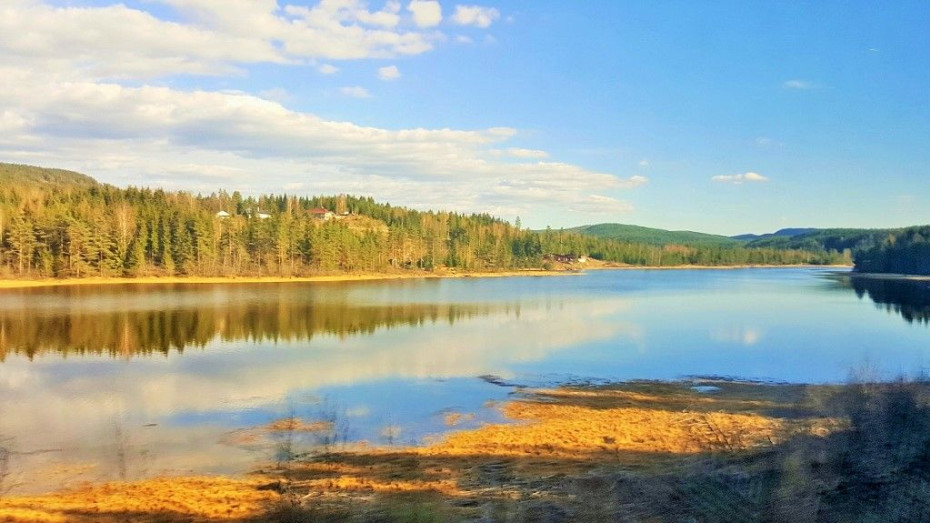
Rail Pass Itinerary: The Best Of Northern Europe
This itinerary includes Amsterdam, Hamburg, Stockholm, Olso, The Flåm Railway, Copenhagen, Berlin, Warsaw, Prague and Vienna
Amsterdam → Hamburg → Stockholm → Oslo → The Flåm Railway → Oslo → Copenhagen/Kobenhavn → Berlin → Warsaw/Warszawa → Prague/Praha → Vienna/Wien → Amsterdam
Along with some of the most beautiful journeys in Europe, this suggested routing enables you to visit the most spectacular cities of northern Europe, by taking as few trains as possible. Taking the minimum number of trains means that additional reservation fees can’t be avoided, but despite that, using rail passes can be good value on this itinerary - even compared to the hassle of tracking down the cheapest possible prices for each journey.
The itinerary is also a continuous loop, so you can follow this itinerary if you want the start and finish point of your entire trip, to be in any of the cities where each day concludes.
All timings have been verified on the usual timetable, but they can be altered due to local circumstances such as weather or works on the line.
OR our Concierge rail travel planning service, could help you plan a similar itinerary.
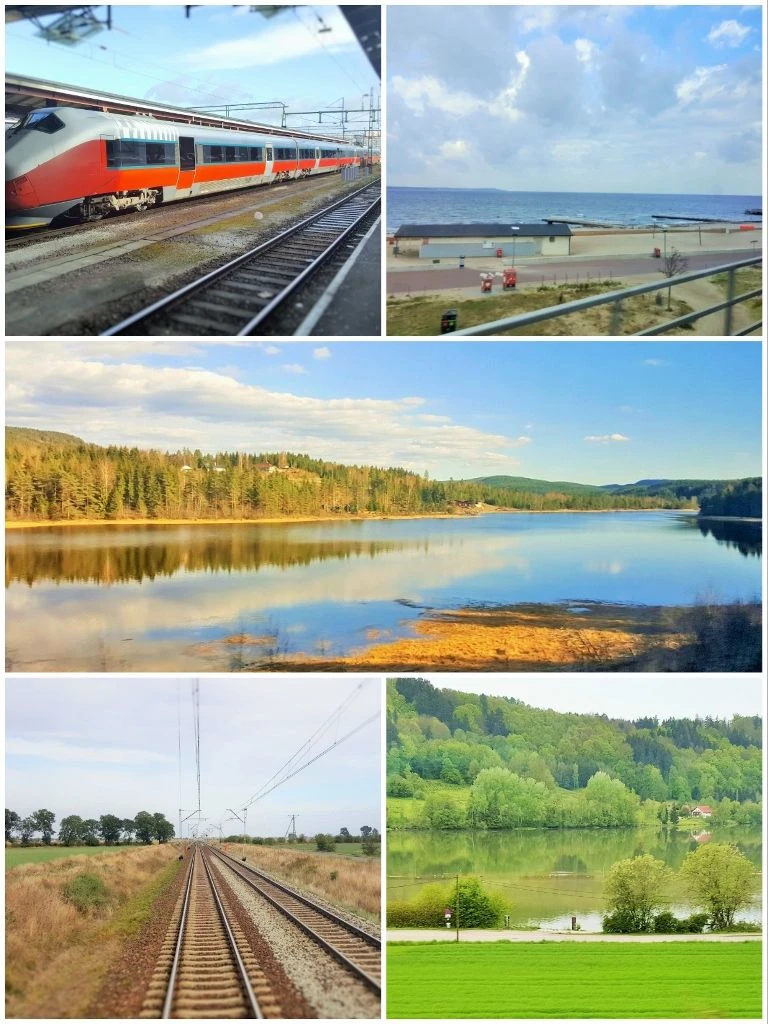
The required rail pass:
If you use a 10 days of travel within two months InterRail Global Pass OR a 10 days within 2 months Eurail Global Pass you can take breaks between your days of train travel. You can then spend some time in some fabulous destinations including Hamburg, Oslo, Stockholm, Berlin, Warsaw, Prague and Vienna.
From and to Amsterdam:
This rail pass itinerary starts and finishes in Amsterdam, which has three ticks in the box:
(1) Amsterdam is served by ICE trains from Germany , on which no rail pass reservations are required, and trains from Belgium and Paris . So an easy option is to use purchase a rail pass valid for 15 days of travel, so that you can use these additional five days of travel to travel to and from Amsterdam by train. (2) It’s also a budget airline destination - after all you don't have to take a train from/to Amsterdam (3) Amsterdam has direct flights from destinations outside Europe; so ideal if you'll be flying into the continent, to use a Eurail Pass. Schiphol Airport has easy train connections to Amsterdam city centre, but don't use your rail pass for these trains.
Managing Luggage:
The suggested routing also loops back through Hamburg on Day 6, so an option is to deposit some of your bags there and travel lighter through Scandinavia – and then pick them up on the way to Berlin.
Most of the journeys are clickable, so you can access more useful info about each individual train ride including:
(1) All you need to know about the stations where you will be joining and leaving the train. (2) What to expect when on board each train, such as catering facilities and tips for how to manage your luggage. (3) Insights for scenic journeys - what to look out for, which side of the train to sit on for the best of the views etc.
Plus if you click the station buttons on the journey guides, you will also usually* find: (1) Lists of overnight accommodation with easy access to the station and with high user ratings; (2) Links to destination guides to help you make the most of each location. *Just the big cities, for now.
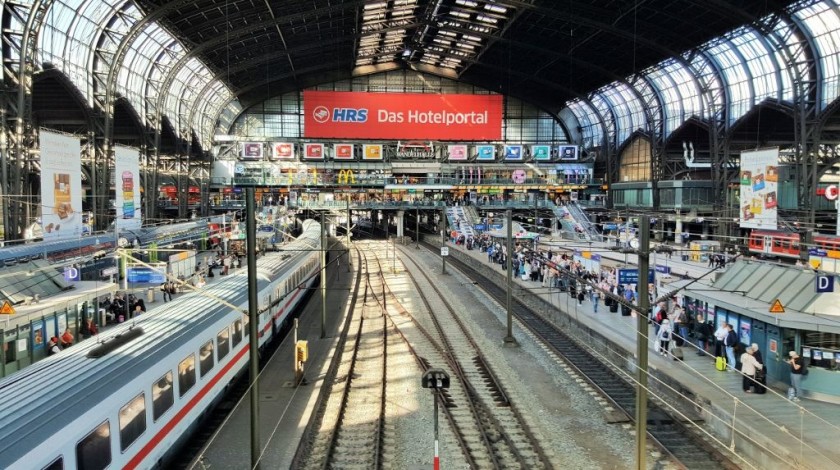
Seat reservations are available, but optional on these trains.
Train 1: Depart: Amsterdam Centraal at 11:33 - the train will be heading to Berlin. Arrive: Osnabruck at 14:51
Train 2: Depart: Osnabruck at 15:23 Arrive: Hamburg Hbf at 17:14
An option is to take the same combination of trains, but to depart Amsterdam at 09:03 and arrive in Hamburg around two hours earlier. Don’t be too concerned about making the connection in Osnabruck, there will another train on to Hamburg an hour later, if the train from Amsterdam is delayed

Train 1: Depart: Hamburg at 08:55 Arrive: Kobenhaven H at 13:34
Between June 14th and August 26th you must reserve on this trains: 1st class = €5.90; 2nd class = €4.50 Although we recommend reserving at any time of the year, these can be a busy trains, so having a seat for the entire journey is not guaranteed.
These seat reservations can be BOOKED on the DB (German Railways) website; more info is available here .
Depart: Kobenhaven H at 14:19 Arrive: Stockholm Central at 19:37
Reservations = 1st class = €16; 2nd class = €7 (equivalent prices will be charged in Swedish krona)
Book these reservations on the SJ (Swedish Railways) website ; booking at last a week ahead is highly recommended. More info on how to this is available here .
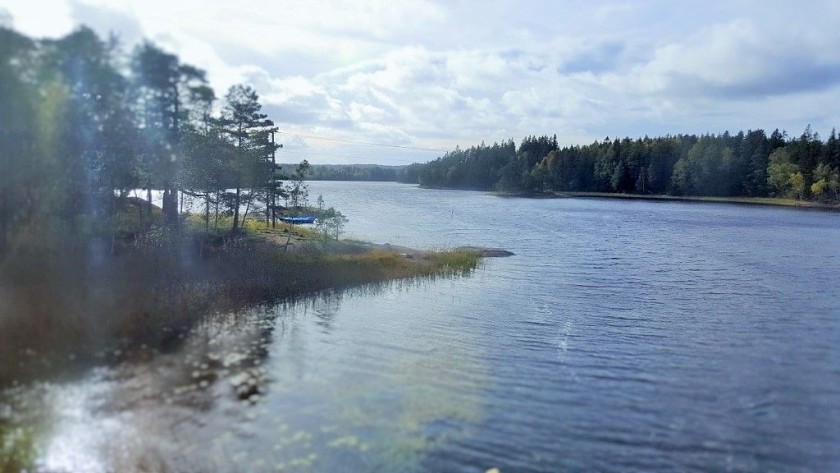
Depart: Stockholm Central at 10:51 Arrive: Oslo S at 16:09
Book these reservations on the SJ (Swedish Railways) website ; booking at last a week ahead is highly recommended, so you may as well book, when reserving the Copenhagen/Kobenhavn to Stockholm train.
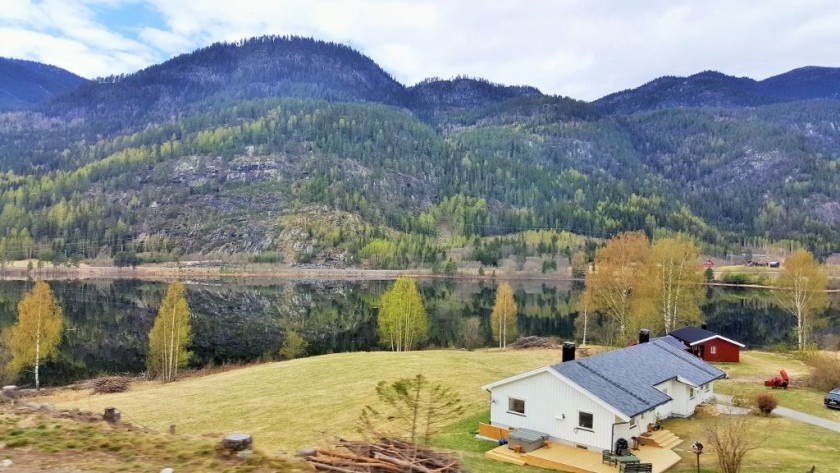
An epic day trip by train from Olso to the Norwegian fjords including the majestic Flamsbana railway is entirely feasible if you will be travelling with a rail pass.
Train 1: Depart: Olso S at 08:25 Arrive: Myrdal at 12:57
Train 2: Depart: Myrdal at 13:15 Arrive: Flam at 14:05
Sit on the left when you board the Flamsbana train.
Train 3: Depart: Flam at 16:50 Arrive: Myrdal at 17:35
Rail pass users also qualify for a 30% discount on the Flamsbana trains, you won't have time to book tickets on arrival at Myrdal station, so board the train and seek out the conductor.
Train 4: Depart: Myrdal at 17:40 Arrive: Oslo S at 22:27
All of the videos were taken from a train travelling in the opposite direction
Booking reservations
Reservations are required on the Oslo - Myrdal train and return, but they're free if you will be travelling with a 1st class pass; the 2nd class reservations cost the equivalent of around €6.
Reservations are usually available up to 90 days in advance
You can book reservations online by using the Eurail reservation service or the InterRail reservation service though you will be charged a €2 booking fee per reservation, per person. Though this €2 fee can now be avoided by using the Entur rail pass reservation service . Reservations can also be arranged at the Entur ticket desks in stations
The terms differ depending on whether you have a first class or second class rail pass. Second class passes = the costs per seat in the Standard (second class) seating areas is NOK 50, but holders of second class passes can also opt to to travel in the equivalent of first class seats at a cost of NOK 200/300.
First class passes you can either;
- opt to reserve prior to arrival in Norway and pay the reservation fee NOK 200/300 (plus the booking fees),
- or avoid paying any charges at all, if you wait until you are in Norway and book at an Entur travel desk in the major stations.
Or with a First Class pass it's possible to avoid the charges by calling the Entur (Norway's national transport booking service) call center: +47 61 27 90 88 (press 9 for services in English). Opening hours: Monday to Friday: 07:00 - 23:00 Saturday: 08:00 - 21:00 Sunday: 08:00 - 23:00 ( during bank holidays are shorter).
If you have a 1st class pass, make this clear when calling to make reservations in 'Komfort' class, in order to avoid being charged any fees. If the travel adviser asks you for a payment, you are being offered a 2nd class reservation.
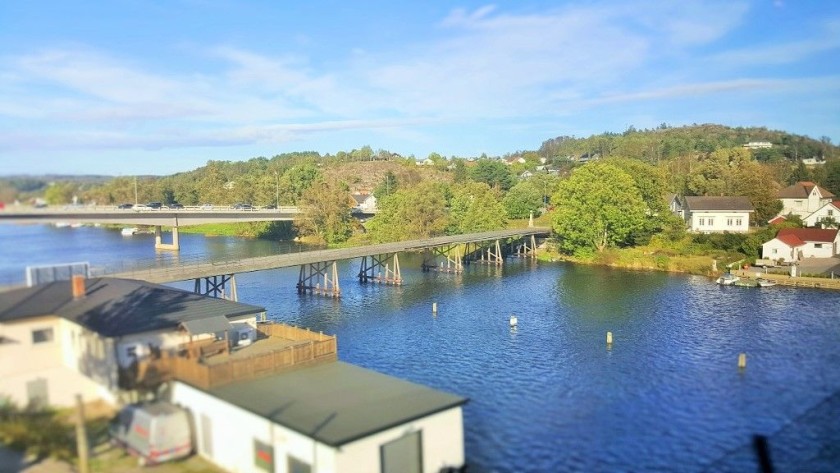
Train 1: Depart: Oslo S at 10:14 Arrive: Goteborg C at 13:45
Train 2: Depart: Goteborg C at 14:40 Arrive: Kobenhavn H at 18:30
Train 1: Depart: Kobenhaven H at 09:26 Arrive: Hamburg Hbf at 14:06
Train 2: Depart: Hamburg Hbf at 14:35 (the ICE train will be heading to Munchen) Arrive: Berlin Hbf at 16:20 Or drop your bags in a left luggage locker in Hamburg hbf and see something of the city between trains, there are 1 or 2 x trains per hour from Hamburg to Berlin.

Depart: Berlin Hbf at 09:52 Arrive: Warsawa Centralna at 15:26
Reservations = 1st class and 2nd class = €4 These reservations can be booked on the DB (German Railways) website or at the Reisezentrum desk at Hamburg Hbf, when you arrive there on Day One.
An option is to use this travel desk at Hamburg Hbf to book all your reservations, EXCEPT for the Snabbtag trains to and from Stockholm and the Regiontog trains to/from Myrdal; we recommend booking those in advance.
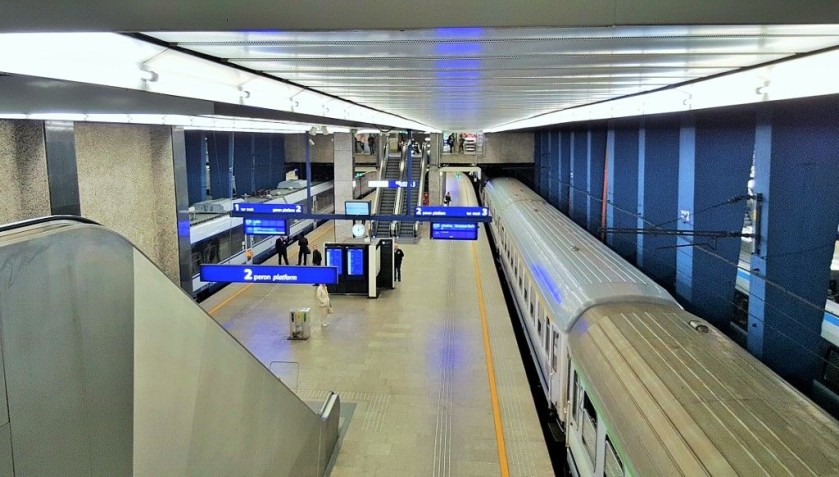
Depart: Warsawa Centralna at 13:30 Arrive: Praha hl.n. at 21:34
Reservations = 1st class and 2nd class = €4 (the equivalent price in Polish zloty) You can book these reservations when you arrive in Warszawa Centralna station the previous evening; doing that is now cheaper than booking them at the Reisezentrum desk back in Hamburg Hbf.
Depart: Praha Hln at 08:44 or 10:44 Arrive: Wien Hbf at 12:49 or 14:49 These trains will be heading to Graz.

Depart: Wien Hbf at 09:13 Arrive: Frankfurt (Main) Hbf at 15:36
Reservations are optional, but highly recommended for this journey, particularly if you want to remain in the same seat all the way to Frankfurt.
If you do want to reserve then they can be booked online on the DB (German Railways) website, or if you’ll be booking other reservations at the Reisezentrum desk at Hamburg Hbf, you may as well as book this train there too. More info is available here .
Depart: Frankfurt (Main) Hbf at 16:28 Arrive: Amsterdam Central at 20:46
Reservations are recommended on this train on Mon-Friday and Sunday. On some dates the train will arrive in Amsterdam around 30 – 60 mins later.
The total costs are based on standard* InterRail and Eurail prices + the costs of the mandatory reservation fees on the trains that have been included on this itinerary + a discounted ticket for the journey on the Flamsbana Railway
*Both of these passes are frequently discounted during 'sales' periods.
1st Class Adult = €611 2nd Class Adult = €488
Approximate* cost comparison with purchasing tickets:
Cheapest 1st class tickets = €749 Cheapest 2nd class tickets = €465
1st class tickets when booked a few days ahead of the travel date = €1190 2nd class tickets when booked a few days ahead of the travel date = €839
The costs estimates based on one Adult aged 18+ travelling solo.
*We looked through 100s of departure times/dates to assess these costs and used the most 'typical' prices we could find.
However, the prices of train tickets can fluctuate, so these cost estimates do not take into sporadic promotions and other offers; nor do they include exponentially high prices at holiday times etc.

Simon Harper
I wanted to share my passion for train travel and explain how anyone can take the fantastic journeys I have taken.

This is one of more than 100 train travel guides available on ShowMeTheJourney , which will make it easier to take the train journeys you want or need to make. As always, all images were captured on trips taken by ShowMeTheJourney.
Please support ShowMeTheJourney
Help keep us advertising and paywall free!
This second version of ShowMeTheJourney is exciting and new, so we are genuinely thrilled that you are here and reading this, but we also need your help.
We’re striving not to let anything get in the way of providing the most useful service possible, hence a facility has been set up with DonorBox which can be used to support the running costs and make improvements.
Instead of advertising or paywalls, your financial support will make a positive difference to delivering an enhanced service, as there’s a lot of ideas which we want to make happen.
So if you have found the info provided here to be useful, please consider saying thank you.

- Europe by Train
- Journey Guides
- Rail Stations
- Trip Planning
- Travel Articles
- Tips from 100s of journeys
- How to take a night train
- Good to know about daytime trains
- Travelling with Children
- Taking Bikes on Trains
- Travelling with Luggage
- Taking dogs on trains
- Common benefits of first class travel
- Journeys with multiple connections
- Money saving advice
- The best permanent deals and offers
- Intro to seat reservations
- Step-by-step booking guides
- InterRail/Eurail
- Access over 500 rail holidays
- Save 5% on more than 30 Swiss rail holidays
- Book a range of Swiss rail passes
- Buy Half Fare Cards for Switzerland
- Book train tickets with Trainline
- Book rail holidays worldwide with Bookmundi
- Japan Tourism
- Japan Hotels
- Japan Bed and Breakfast
- Japan Vacation Rentals
- Flights to Japan
- Japan Restaurants
- Things to Do in Japan
- Japan Travel Forum
- Japan Photos
- All Japan Hotels
- Japan Hotel Deals
- Last Minute Hotels in Japan
- Things to Do
- Restaurants
- Vacation Rentals
- Travel Stories
- Rental Cars
- Add a Place
- Travel Forum
- Travelers' Choice
- Help Center
Itinerary advice needed for 27 days northern Kyushu - Japan Forum
- Asia
- Japan
Itinerary advice needed for 27 days northern Kyushu
- United States Forums
- Europe Forums
- Canada Forums
- Asia Forums
- Central America Forums
- Africa Forums
- Caribbean Forums
- Mexico Forums
- South Pacific Forums
- South America Forums
- Middle East Forums
- Honeymoons and Romance
- Business Travel
- Train Travel
- Traveling With Disabilities
- Tripadvisor Support
- Solo Travel
- Bargain Travel
- Timeshares / Vacation Rentals
- Asia forums
- Japan forum

Day 1 Fukuoka - Canal City
Day 2 Pick up rental car , site seeing in Itoshima, Karatsu and over night in Takeo.
Day 3 Ureshino
Day 4 Visit Yutokun Imari Shrine, Oouo Shrine overnight in Nagasaki
Day 5 Nagasaki
Day 6 Nagasaki
Day 7 Nagasaki
Day 8 Unzen
Day 9 Shimabara
Day 10 Kumamoto
Day 11 Kumamoto
Day 12 Takachiho overnight in Aso
Day 13 Mt Aso
Day 14 Kurokawa overnight
Day 15 Yufuin
Day 16 Yufuin
Day 17 Beppu
Day 18 Visit USA Shrine overnight in moji-Ko
Day 19 Moji-Ko
Day 20 Moji-Ko
Day 21 Fukuoka - return rental car
Day 22 Fukuoka
Day 23 Fukuoka
Day 24 Fukuoka
Day 27 Fly home
2 days extra and was thinking about visiting Miyazaki and Nishinan area if it is doable!
Any adjustment of time needed for each location and the logistics needed to fit in visiting Miyazaki?
Thanks in advance!
2 replies to this topic

One day should be enough to see Moji-ko. There's a little railway museum near the Moji-ko train station, some historic buildings, and an undersea pedestrian tunnel to Shimonoseki.
In Nagasaki, don't miss the Dejima museum.
Consider adding Kagoshima to your itinerary; it's got a volcano and a garden.
You don't need a car in Nagasaki or Moji-ko. You might consider reorganizing your trip to use trains for all the locations that have train stations, and use your car rental period only for locations that don't have train stations. JR Kyushu offers a variety of rail passes.

What is your travel season? Scenery and scenery recommendation changes by season or even by week.
- Itinerary advice needed for 27 days northern Kyushu 6:32 am
- Tokyo from 17 July - 26 July 2024 6:08 am
- Highway Bus Shinjuku to Chuodo Expwy 4:57 am
- 8D Roadtrip from Fukuoka to Oita, Kumamoto, Karatsu 4:54 am
- Airport transfer to Keio Plaza Hotel Tokyo 4:39 am
- KIX to Namba station 4:33 am
- How to get from Lake Kawaguchiko to Hakone pirate ship 2:13 am
- New Otani 1:38 am
- Onsen near Takayama - Gero or Okuhida in mid-late November 1:19 am
- Saphir Odoriko 12:49 am
- Ways to use up digital Suica in Wallet 11:47 pm
- Itinerary for Dec Hokkaido Trip (10 Days) 11:38 pm
- Photo sharing: 99 Japanese castles 11:37 pm
- Itinerary for Dec Hokkaido Trip (10 Days) 11:11 pm
- 'semi double' rooms 5 replies
- Pocket WiFi Rental Experience? 315 replies
- kyoto-takayama JR or Lmtd express??? 6 replies
- Best Japan travel guide book? 29 replies
- Best/cheapest time of year to visit?? 3 replies
- Radiation danger in Tokyo? 37 replies
- Best Skiing in Japan? And When? 3 replies
- Japan in 10 days 3 replies
- How far is Nara from Kyoto 8 replies
- how to get to Hokkaido from Tokyo? confused..pls HELP. 5 replies
- 2024 public holiday chart in East Asian countries
- Where can I find more onsen in Japan?
- Driving Information
- Catholic mass in English and other languages
- How can we access tourist attraction from cruise port?
- Pocket WiFi Rental Experience?
- Halal Information
- Tokyo trip report here


Europe Travel Guide
Last Updated: April 18, 2024

From beautiful Paris to smoke-filled coffeeshops in Amsterdam, Oktoberfest to La Tomatina, Europe is a massive, diverse continent with an unlimited assortment of things to see and do. You won’t have any problem filling your time, whether you’re backpacking Europe for a few months on a budget or just spending a few weeks there on a well-earned vacation.
The continent boasts wonderful beaches, historical architecture, amazing wine, and tons of world-class festivals. Every country is incredibly different from the next too, providing limitless variety in what you do during your trip.
I first backpacked Europe in 2006 and was hooked immediately. I’ve been visiting every year since, have run tours around the continent, and even wrote a book on traveling in Europe . It’s a destination I love and never get tired of exploring.
This guide will give you an overview of Europe and the tips and tricks you need to start planning your trip. I’ve also written extensive travel guides to each country on the continent (linked below in this post) so you can get more in-depth information for your specific itinerary too!
Table of Contents
- Things to See and Do
- Typical Costs
- Suggested Budget
- Money-Saving Tips
- Where to Stay
- How to Get Around
- How to Stay Safe
- Best Places to Book Your Trip
- Related Blogs on Europe
Click Here for Country Guides
Top 5 things to see and do in europe.

1. Tour the Greek Islands
These islands are the mecca of summer beach fun and each is unique in its own great way. There’s Ios (beach party central with archeological ruins and awesome boat tours); Kos (ancient ruins and nature); Crete (Bronze Age ruins of Knossos, hiking, beaches, and wine), Santorini (iconic blue water, white buildings, and local wineries); Mykonos , (the upscale party island with beautiful beaches, villages, and sunsets), Naxos (best island in the Cyclades). Plus, Milos, Corfu, Lemnos, Zakynthos, and so many more! With hundreds of islands in the country, you can always find what you are looking for!
2. Ride the rails
Europe is famous for its international rail system. Rail passes like the Eurail Pass have been around forever and still make it very easy to get from country to country on a relatively small budget (and with lots of flexibility). Europe has some of the fastest trains in the world that travel up to an incredible 217 mph (350 kph). The whole continent is connected by trains and there’s a growing push for even more connections and long-distance, high-speed trains in order to reduce flying and help combat climate change. There’s nothing more quintessential than riding the trains in Europe and I encourage you to take as many trains as possible. It’s one of the best ways to see the continent.
3. Get lost in Paris
The “City of Lights” is everything people say it is. I fell in love with it the first time I stepped foot in Paris . The city is just magical. You have a ton of museums, cafes, jazz clubs, famous art, and beautiful architecture. I love just strolling around the streets of the Quartier Latin (Latin Quarter) or Montmartre neighborhood as it makes for a breathtaking day. Another one of my favorite things to do here is just sit in the Jardin des Champs-Élysées park and picnic like the Parisians. For something a bit different, check out the famous Catacombs and Paris Sewer Museum. With so much to offer in the way of culture, history, and gastronomy, it would take years to see everything here but you can still get a good feel of the city in a few days.
4. Go city hopping
There are so many amazing cities in Europe that we’d need a top 100 to list them all. Here are some of my personal favorites and must-see cities: London is rich in history, culture, and the famous Big Ben clock; Edinburgh is a vibrant medieval city with cozy pubs and a famous castle with a huge New Year’s Eve Party; Amsterdam has cozy coffee shops and canopied tree-covered canals; Berlin has a wild party scene, street art, and the Berlin Wall; Barcelona has tapas, beach, and unique Gaudi architecture; coastal Lisbon has colorful tiles, old tramcars, cobblestone streets and plenty of fresh seafood; Prague has a beautiful intact Old Town, incredible architecture and eclectic bars; Tallinn Estonia has beautiful medieval buildings with colorful roofs. Florence is a mecca for Italian Renaissance architecture, art history, and gelato; Stockholm mixes medieval architecture and modern art and design. Crisscross the continent, take in the culture, and enjoy all the historic cities!
5. Hit the Alps
Whether you go skiing in the winter or hiking in the summer, the Alps hold some of the most breathtaking views in all the world. You don’t even need to be an expert hiker because there are mountain trails for all levels and crystal-clear Alpine lakes. Check out the spectacular Eibsee trail loop in Bavaria at the foot of Die Zugspitze, Germany’s tallest mountain, for the clearest, multi-colored, sparkling lake you’ve ever seen. Or the Männlichen Kleine Scheidegg Panorama trail in Switzerland’s stunning green and snow-capped Alps. Or visit Italy’s Dolomites in South Tyrol for the scenic Seceda trail. The Alps have trails for every fitness level and in every season.
Other Things to See and Do in Europe
1. tour amsterdam.
I love Amsterdam so much that I lived here for a short period of time in 2006. Here cobblestone and brick streets weave around lovely canals as people ride their bikes to and fro. My favorite things to enjoy here are Amsterdam’s vibrant art and music scene and there are also a ton of interesting museums here like the Anne Frank House, FOAM, the history museum, and the hemp museum. Be sure you get out of the center into Jordaan and Oost with their wonderful outdoor cafes and fewer tourists. Also, a visit to Amsterdam wouldn’t be complete without a canal cruise to visit the many islands and there are many to choose from that include snacks and drinks, sunset cruises, live guided tours, and more.
2. Hang out in Barcelona
Barcelona is a city that goes 24 hours a day, 7 days a week. It truly could give NYC a run for the “city that never sleeps” title. Be prepared for late-night dinners and parties until dawn. Besides a great food and nightlife scene, there is a wonderful beach, tons of Gaudi architecture (including the fairytale-like Parc Güell, as well as the iconic Sagrada Familia , which has been under construction for over 100 years!), incredible food tours, one of the best history museums in the country, and lots of outdoor spaces. What I love about Barcelona is that when you’re ready to chill, you can wander around Parc de la Ciutadella and marvel at the majestic fountains, plant life, and buildings created from an ornate military fortress.
3. Visit Berlin
Hip and trendy Berlin is an energetic destination. It is one of Europe’s most affordable capital cities, with a vibrant music and art scene and a growing foodie movement. Be sure to spend some time learning about the city’s darker history via the many excellent museums, memorials, and landmarks. The East Side Gallery, a section of the Berlin Wall that’s now painted with murals, and the Memorial to the Murdered Jews of Europe are two especially powerful reminders of Germany’s past. For all periods of German history, don’t miss the Deutsches Historisches Museum (German Historical Museum) – it’s one of the best history museums in the world. Once you’ve had your fill of history, relax in Berlin’s many green spaces, from Tempelhof Field, the site of a former airfield and popular local hangout spot, to Tiergarten, a tree-covered former hunting ground for 17th-century aristocrats.
4. Drink beer at Oktoberfest
Oktoberfest is a must for anyone going to Germany at the end of September. While not a budget option since beers now cost 15 € a maß, I love the energy and friendly camaraderie this event inspires. For two weeks, millions of people from all over the world gather for lots of beer, excitement, music, and wild fun. Watching thousands of people sing together, raising quart-sized beer mugs for endless toasts, and enjoying the general party atmosphere makes you feel good about the world. (Or maybe that’s just the beer?) Just be sure to book your accommodation well in advance and be prepared to pay top prices for them. If you don’t have an outfit, don’t worry, there are plenty of shops even at the main train station where you can buy a Bavarian dirndl dress and men’s lederhosen.
5. Experience London
Get a taste of English culture in diverse London . The museums here are some of the best in the world (most are free) and include the Tate, the British Museum, the City Museum, the National Gallery, the Historical Museum. There’s no shortage of iconic sights here as well, with Big Ben, the House of Parliament, the London Eye, the Tower of London, Tower Bridge, and of course, Buckingham Palace. I love London’s diversity because of the countless international eateries with great food and wonderful pub culture, perfect for after a long day seeing the sights. Head to Brick Lane on the weekends for some amazing food and craft markets. I prefer Paris to London, but there is something sophisticated and fun about London. Just watch those pints — London is not a cheap destination!
6. Get outdoors in Scandinavia
My favorite region in Europe is Scandinavia. The quality of life here is high, the people are beautiful and friendly, and the cities are clean and historic. Cycling the cities, taking canal tours, hiking the vast forested areas, archipelago hopping, enjoying fika (a Swedish coffee break), and warming up in saunas are just a few of the popular activities that await you here. True, this area of Europe is not cheap, but there are plenty of ways to reduce your expenses. Don’t let the high prices scare you away. Highlights for me include Copenhagen , Stockholm , Gotland, Norway’s fjords, and Lapland in Finland .
7. Get enchanted in Prague
Prague has an amazing history and is one of the most beautiful and picturesque cities I’ve ever seen. Highlights include the 9th-century Prague Castle, the magnificent Charles Bridge (built in the 14th century and one of the oldest standing bridges in the world), the 10th-century old square with its iconic astronomical clock, and the winding Jewish Quarter. Even if you only have a few days there don’t miss the free walking tour which is one of my favorites in Europe and the best way to learn about the Old Town and the tragic history of the city that went from thriving Bohemian capital of art, music, and literature to part of the Iron Curtain after WWII. Some of my favorite gems here include the fantastic black light theater shows in 4D and the one-of-a-kind medieval dinner show in an old tavern complete with musicians and jugglers not to mention hearty food and drinks. During the weekends it heaves with people enjoying the bars, cheap beer, and delicious food so try to visit during the week (and in the spring or fall) to beat the crowds.
8. Relax on the French Riviera
Here, you can pretend to live the high life for a little bit. Have fun in the sun, relax on the beach, swim in azure blue water, hobnob with the rich and famous, and sail on (or gaze at) gigantic yachts. As for cities, Nice is nice with its palm-tree-lined promenade, old town, and many art museums. If you want to go see how the rich and famous live, spend an afternoon checking out Cannes to soak up some glamorous vibes on La Croisette where they hold the famous Cannes Film Festival. The kingdom of Monaco with its tiny streets, beautiful buildings, and world-famous casino is just a skip away too.
9. Enjoy the great outdoors in Interlaken
Located in the beautiful mountains of Switzerland, Interlaken is a gorgeous place to unwind with fantastic hiking, delicious hot chocolate, and plenty of outdoor sports. The area is full of natural attractions to explore, including the St. Beatus Caves (complete with a legendary dragon), the cascading 500-meter-high (1,640 feet) Giessbach Waterfalls, the Jungfraujoch mountain railway (which leads to the highest train station on the continent), and a plethora of lakes (hence the town’s name). It’s a good alternative to all the cities and museums. Interlaken is also a popular party destination for backpackers and other young travelers. By far, my favorite scenic and visually stunning trail was the Oberberghorn panoramic hike, where you can wander the green mountain ridge ogling the amazing views and the turquoise-blue Brienzersee.
10. Experience history in Rome
In this thriving historical city, you can’t walk two feet without stumbling over a ruin, making Rome a history buff’s dream. Its tiny streets are perfect for wandering as you explore the Colosseum, see the Forum and Palatine Hill, visit the Pantheon, spend time in Vatican City, admire the Spanish Steps, and toss coins into the famous Trevi Fountain. The skip-the-line tickets can definitely be worth it so you don’t waste time waiting outside attractions. Rome also has amazing food (it’s Italy, after all) and nightlife. Visit the Trastevere area for a taste of “local” Rome and chill bars. It’s my favorite area in the city because you feel like you’re in a small village in the middle of a big city.
11. Hike around the Cinque Terre
Cinque Terre is my favorite part of Italy. These five beautiful cliffside towns are perched near warm waters and beautiful olive and grape groves. There are wondrous and strenuous hikes in these hills; for a real challenge, take trail #8. Or just walk the coastline for something less difficult. Many activities here revolve around the coastline: kayaking, swimming, having a beach picnic or visiting the Technical Naval Museum. If you happen to be here in December or January, don’t miss the Nativity Manarola, the world’s biggest lighted nativity scene.
12. Tour Krakow
Krakow looks like it stepped out of a medieval postcard. It’s a hip, trendy, and youthful city that’s the center of education in Poland, meaning there are a lot of university students here. Most travelers come to party here (the vodka is cheap) but try to enjoy the city’s history and food besides just the bars. Walk the Royal Road through the Old Town to the 13th-century Wawel Castle, tour Schindler’s Factory (where Schindler saved over 1,200 Jews during World War II), and visit the sobering Auschwitz-Birkenau concentration camp. You can also take a fascinating day trip to the UNESCO World Heritage Wieliczka Salt Mine, a 13th-century mine with cavernous chambers, statues, chapels, chandeliers, and cathedrals all carved out of salt.
13. Visit the ruin bars in Budapest
The coolest nightlife in all of Europe is found in Budapest . Built in abandoned buildings, ruin bars feature funky art installations, repurposed furniture, and quirky decor. They are amazing, fun, and great places to meet locals, as people of all ages flock here. Open since 2001, Szimpla Kert is the original ruin bar and one of my favorites, along with Instant-Fogas Complex, which takes up an entire building and is actually many different bars in one. Don’t skip the ruin bars — they’re one of the most unique things about the city!
14. Explore Cornwall
The best part of England is outside London, yet unfortunately, not a lot of travelers leave London. Head west to the area of Cornwall for cheaper prices, welcoming locals, natural beauty, great hiking, rolling hills, plenty of medieval castles, and picturesque small towns. If you like biking, the Camel Trail from Bodmin to Padstow is worth the trip and you even pass by a local vineyard. It’s an easy way to spend a day (and it’s pretty flat so it’s not too hard to do.) Plus, I had the best fish and chips in Cornwall! Overall, it’s what you think of as “traditional England.”
15. Walk the Camino
El Camino de Santiago (The Way of Saint James) is an ancient pilgrimage route that stretches from France all the way across northern Spain. It is a 500 mile (800 km) trail that winds through incredible terrain, ending in Santiago de Compostela at the cathedral where St. James is supposedly buried. As a pilgrim, you get a “pilgrim’s passport” which allows you to stay in affordable pilgrim-only hostels, making this a surprisingly budget-friendly adventure. While it usually takes over a month to complete, you can just walk a section if you don’t have the time. To receive a “Compostela” (certificate of completion), you just need to walk the last 62 miles (100 km), which generally takes 4-5 days.
16. Throw tomatoes during La Tomatina
By far my favorite festival, the largest food fight in the world happens during the last Wednesday of August in Bunol, Spain. What started in 1945 as a local brawl has turned into a massive event drawing tens of thousands of people from all over the world. For about an hour, everyone throws tomatoes at each other, leaving streets ankle-deep in tomato juice. Afterward, everyone walks down to the river, cleans off, and then heads to the town square for sangria and music.
17. Find Dracula in Romania
Not a lot of people visit Romania but this underrated country in Eastern Europe has undiscovered yet picturesque medieval towns like Brasov (home to “Dracula’s castle”), Sighisoara, and Sibiu; gorgeous beaches on the Black Sea; and incredible hiking in the Fagaras Mountains — all at dirt-cheap prices. Other major sights include frescoed Byzantine monasteries, the steepled wooden churches of Transylvania, the hip university town Cluj-Napoca, the post-communist capital of Bucharest, and the Danube Delta, a huge nature reserve.
18. Drink whisky in Islay
Whisky has a long history on Islay , an island off Scotland’s west coast. It’s been made there since the 16th-century — first in backyards and then, starting in the 19th-century, in large distilleries. Over the years, whisky from the island came to be considered a specialty and was used to flavor a lot of other blends on the mainland. There are currently nine working distilleries on the island, all located along the island’s shores, with Laphroaig, Ardbeg, and Lagavulin being the most famous. Most distilleries here make single-malt Scotch, meaning that only one type of grain (barley) is used. My visit here was amazing and, even if you don’t like whisky, there are tons of good hikes and walks throughout this magnificent island.
19. Explore Iceland
Iceland is a magical country with majestic waterfalls, hidden hot springs around every corner, and sweeping vistas unlike anywhere else in the world. After my first visit, the country quickly became one of my favorite countries. With whale watching in the summer, the northern lights in the winter, and geothermal baths for soaking in year-round, there really is no bad time to visit! While Iceland’s main draw is the epic natural landscapes, it’s worth spending a couple of days in Reykjavik with its café culture, artsy feel, and brightly colored wooden row houses.
20. Sail the Croatian coast
With calm winds, short distances, a coastline littered with over 1,000 islands, and countless historical sites, Croatia is one of the world’s best sailing destinations. If you can, go during the shoulder season when you can find some great deals. Plan to stay at least a couple of days on one of the islands, with the most popular being Brac, Hvar, Krk, Cres, and Lošinj. However, don’t be afraid to get off the beaten path and explore some of the lesser-known islands such as Silba, Vis, and Lastovo. If you want to splash out and spend a week partying on a yacht, check out The Yacht Week, which hosts week-long parties, complete with DJs, from May-September. You can book a full boat to share with friends or just a cabin if you’re traveling solo. Prices start at 5,250 HRK per person and go up to 9,300 HRK.
21. Explore the Balkans
While the Balkans have become more popular with backpackers in recent years, it’s still largely overlooked by most budget travelers, despite being an extremely budget-friendly region. The Balkan peninsula is home to great (and again, overlooked) wine, beautiful medieval towns like Kotor and Mostar, stunning mountainous landscapes, beautiful pebble beaches, coffee culture, fresh, hearty yet inexpensive food, and museums covering the area’s history, including the most recent turbulent events of the early 1990s. I especially loved my time in Albania . Don’t miss the beautiful beaches in Ksamil, nicknamed the “Maldives of Europe’ as well as the mountain village of Gjirokastër, which was occupied by Romans, Byzantines, and Ottomans. The Balkans have so much to offer for every budget and every country has its unique cultural flavor.
22. Take a wine tour in the Loire Valley
Located in central France, the picturesque Loire Valley is a UNESCO World Heritage site and stretches 280 kilometers (174 miles) along the Loire River. One of the major wine-producing regions of France, the area is home to some of the best wines in the world, with over 1,000 vineyards open to the public. Even those who don’t drink wine will enjoy the beautiful small towns, great food, and the region’s over 300 impressive chateaux. I loved the medieval Chenonceau Castle and Chateau Villandry and the small villages like Saint-Florent-le-Vieil. Spring and Autumn are my favorite times to visit because you can go biking and do outdoor activities when it’s not too hot and there are fewer people. It’s an area not to be missed.
23. See Fado in Portugal
Fado is an important musical tradition in Portugal , originating in Lisbon and stretching back some 200 years. The word “fado” likely stems from the Latin word for fate, and it’s very haunting, poetic, and emotional music. Most of the songs follow themes of loss and mourning, and the music was popular with the working class (especially sailors). Performances normally take place in restaurants during dinner. In Lisbon, head to Clube de Fado, Tasca do Chico, Parreirinha de Alfama, or Senhor Vinho.
24. Tour green Slovenia
Slovenia is one of Europe’s least-visited destinations, which is mind-blowing to me because it’s an amazing place to visit. Slovenia offers all the beauty of Western Europe but at a fraction of the cost and with a fraction of the crowds. Perfect for outdoor adventure lovers, Slovenia offers rugged mountains, untouched landscapes, fantastic ski resorts, plentiful wine, sprawling cave systems, incredible food, and postcard-perfect lakes, such as the famous Lake Bled with its castle on an island. I loved Piran, Slovenia’s often overlooked coastal Venetian-style harbor town that was actually founded 3000 years ago. Stroll around its beautiful windy cobble-stoned streets, beautiful plazas, and take advantage of the many affordable restaurants right on the water. Make sure to also spend a few days in the country’s capital, Ljubljana, known as one of the continent’s greenest and most livable cities. Take a river cruise to see the city and enjoy the friendliness of the locals.
For more information on specific countries in Europe, check out the guides below:
- Albania Travel Guide
- Austria Travel Guide
- Belgium Travel Guide
- Belarus Travel Guide
- Bosnia & Herzegovina Travel Guide
- Bulgaria Travel Guide
- Czechia Travel Guide
- Croatia Travel Guide
- Denmark Travel Guide
- England Travel Guide
- Estonia Travel Guide
- Finland Travel Guide
- France Travel Guide
- Germany Travel Guide
- Greece Travel Guide
- Hungary Travel Guide
- Iceland Travel Guide
- Ireland Travel Guide
- Italy Travel Guide
- Latvia Travel Guide
- Lithuania Travel Guide
- Malta Travel Guide
- Moldova Travel Guide
- Montenegro Travel Guide
- Netherlands Travel Guide
- Norway Travel Guide
- Portugal Travel Guide
- Poland Travel Guide
- Romania Travel Guide
- Scotland Travel Guide
- Slovakia Travel Guide
- Slovenia Travel Guide
- Spain Travel Guide
- Sweden Travel Guide
- Switzerland Travel Guide
- Ukraine Travel Guide
Europe Travel Costs

Accommodation – Accommodation prices vary greatly by region. In Western Europe, hostel dorm rooms cost between 25-45 EUR per night, depending on the room’s size and the popularity of the hostel. I stayed in a 6-bed dorm in Berlin for 20 EUR, while the same one would have cost me around 45 EUR in Paris. A room in Paris costs on the higher end and a room in cheaper Athens costs on the lower end.
In Eastern Europe, hostel dorm rooms cost between 10-15 EUR per night depending on the size of the dorm room and the popularity of the hostel. The further east you go, the cheaper it gets. Expect to pay around 30-60 EUR per night for a private room that sleeps two.
In Scandinavia, hostel dorm beds cost around 25-45 EUR, while private rooms are 65-80 EUR. Budget hotels start around 85 EUR.
Most accommodations offer free linens, free Wi-Fi, and a lot offer free breakfast, but it’s important to check specific websites for exact amenities.
Campsites cost between 10-15 EUR per night for a basic plot for two without electricity.
Food – Food traditions in Europe run deep, stretching back centuries to become integral parts of each country’s culture. From baguettes in France to tapas in Spain, from hearty Eastern European stews and goulash to the fresh vegetables and olive oils of the Mediterranean, European cuisine varies as much as the countries themselves. Food prices differ greatly across the continent, so check individual country guides for specifics.
But no matter where you are, even in the more expensive countries, finding places to eat within your budget is easier than you might think. Throughout Western Europe, you can find small shops, street food stalls, or food trucks where you can get sandwiches, gyros, kebabs, slices of pizza, or sausages for between 3-7 EUR. These shops are most often found in train stations, bus stations, and main pedestrian areas, and offer cheap food alternatives that can have you eating on 12-17 EUR per day. Fast food (think McDonald’s) costs around 7-10 EUR for a combo meal.
Turkish, Middle Eastern, and Vietnamese eateries abound in Germany, while Indian food is incredible and everywhere in the United Kingdom. Meals at these restaurants usually cost between 8-12 EUR.
Restaurant meals in casual, traditional eateries generally cost around 13-25 EUR for a main dish and drink. Food is much cheaper in the east than in the west, and in the west, northern regions like Scandinavia and the UK are more expensive than southern countries like Spain, Portugal, and Italy.
In Eastern Europe, even if you are eating out for all your meals, you can still get by on a food budget of as little as 15 EUR per day.
For drinks, a pint of beer is 2-5 EUR, a glass of wine is 2-7 EUR, a cappuccino is 2-5 EUR, and cocktails range from 6-14 EUR.
If you eat out, do so at lunch and get the prix-fixe menu (two-course or three-course set menu). Restaurants offer this set menu during lunch, and with prices between 10-20 EUR, it’s a way better deal than the regular dinner menu. You can also get affordable lunches at outdoor markets. So many European cities have huge fresh food markets throughout town.
You can cook your own food for around 45-65 EUR per week. This gets you basic staples like rice, pasta, seasonal produce, bread, and some meat. You can save money by shopping at discount supermarkets like Profi, Lidl, Aldi, and Penny Market.
If you want to save big money on meals, head to one of the markets, pick up some cheese, wine, bread, meats, or anything else, and go to the park for a picnic. (Or grab a sandwich for later!) You’ll find the locals doing the same thing, and it’s one of the cheaper ways to get a true taste of local food.
Backpacking Europe Suggested Budgets
Prices for travel in Europe vary greatly depending on how far north, east, south, or west you travel. If you stick to the budget accommodations, food, and tours listed here and use all my tips on saving money, you need about 65-110 EUR per day in Western Europe, 40-50 EUR in Eastern Europe, and about 85-130 EUR in Scandinavia.
Those numbers reflect a traveler who stays in hostels, cooks some meals and eats out cheaply, enjoys a few drinks, and sticks to free and cheap activities like hiking, walking tours, and enjoying nature. This is your typical backpacker budget. You aren’t going to have a fancy time, but you aren’t going to want for anything either.
However, by getting tourist cards and rail passes, avoiding flights, occasionally Couchsurfing or camping, cooking all your meals, and not drinking, you can travel a lot cheaper. On this budget, you could do Western Europe on 35-45 EUR per day, Eastern Europe on 20-25 EUR, and Scandinavia on 50-65 EUR. That would require you to take a train or a bus or hitchhike everywhere, skip most museums, and limit how often you go out.
Generally, the suggested daily budget for Europe is 80-120 EUR. You can use the chart below to get an idea of how much you need to budget daily. Keep in mind these are daily averages – some days you’ll spend more, some days you’ll spend less (you might spend less every day). We just want to give you a general idea of how to make your budget. Prices are in EUR.
Europe Travel Guide: Money-Saving Tips
Individual country guides have more specific information on how to save money in them but here are some general tips on cutting your costs while you explore Europe:
- Picnic – This continent has a lot of little shops where you can buy pre-made sandwiches or ingredients to make your own. Many supermarkets have delis as well where you can get food to go. Buy some food, eat outside, and watch the city and its people go by. It’s a much more enjoyable and cheaper way to eat.
- Eat local and cheap – Not into picnicking? Eat at local sandwich shops, pizza parlors, Maoz, Wok to Walks, and outdoor street vendors. Avoiding restaurants and eating at a lot of the local “grab n’ go” places gives you a taste of the local cuisine at a much cheaper price. If you’re really on a budget, use your creative cooking skills to prepare meals at the hostel as well.
- Stay with a local – Hostels can add up really quickly. If you don’t have any friends with whom you can stay, consider using Couchsurfing , which connects you with locals who let you stay with them for free. Plus, they tend to also have meetups to meet other locals and travelers. It’s a great way to save on accommodation and meet a local who can share their insider tips and advice.
- Camp in a garden – A very good camping service specific to Europe is Campspace , which allows you to pitch a tent in someone’s backyard for free or for a small fee (around 10-20 EUR). All of the garden owners have profiles that tell you what services and facilities they offer. Also, many countries allow wild camping (like Sweden), which can save you a fortune if you have a tent.
- Take the bus – Budget bus companies like Flixbus can take you across the continent for cheap. I personally feel it’s best for day travel as sitting up for an overnight bus isn’t really ideal for sleeping. It isn’t glamorous, but with tickets starting at 5 EUR, you really can’t complain!
- Get a Rail Pass – Eurail Passes have saved me hundreds of dollars. If you are traveling far distances and through many countries, they are a great deal.
- Take the free city tours – One of the great things about Europe is that you can find free walking tours in all the major cities. They can be a great way to see the city attractions, take in some history, and learn your bearings without spending any money. Just make sure to tip your guide at the end!
- Plan accordingly – Plan your trip around Europe so you avoid doubling back. Transportation is a big expense so proper planning can save you a lot of money (and time). Go in a straight line or a loop. Booking your accommodation ahead helps you save as well since cheap, good places unsurprisingly get reserved first. One thing I’ve learned is that waiting until the last minute means you get stuck with expensive places or cheap places no one wants.
- Fly cheap – If you know where you are going and a train won’t do, try to book flights early. You can often get round trip fares for as little as 5 EUR from many of the European discount airlines like Ryanair or Wizz. Many capital cities have smaller airports farther from the city with ‘inconvenient’ times but cheaper fares. Keep in mind you might need to factor in an early morning Uber or taxi if the busses aren’t running and you have an early flight!
- Drink less – Those 5 EUR beers add up. Hit happy hours or pick and choose when you party. Hostel bars are a good place to get cheap drinks or buy your alcohol at the supermarket. Plus, in Europe, it’s legal to drink outside in parks, plazas, by the lakes or rivers. You’ll find you can save a lot of money by not going to bars and clubs. Partying your way across the continent will destroy your bank balance in no time.
- Get a city tourist card – Many local tourism offices sell a tourism card for all their attractions, tours, and restaurants. This card gives you free entry and substantial discounts on all the attractions and tours in a city, free local public transportation (a huge plus), and discounts at a few restaurants and shopping malls. They save a ton of money. If you plan on doing a lot of sightseeing, get one of these cards.
- Rideshare – If you’re flexible in your schedule, use the ridesharing service BlaBlaCar to catch rides with locals between cities (or countries) by paying a small fee. It’s like Airbnb but for rides. I used this service in Switzerland and, not only did I save a lot of money, but I got to meet interesting people and learn about local culture and life. Drivers are verified and it’s perfectly safe, though sometimes rides cancel at the last minute (which is why you need to be flexible). Check their ratings first and try to use rides where the person has done many trips.
- Bring a water bottle – The tap water is safe to drink in most of Europe, so bring a reusable water bottle to save money and reduce your plastic use. LifeStraw is my go-to brand as their bottles have built-in filters to ensure your water is always clean and safe.
- Get a HostelPass – HostelPass is a discount membership for hostels in Europe. Members get 10-20% off select hostels around Europe, as well as perks like free breakfast or free drinks. There are discounts on tours and activities too. It’s a great way to save money if you’re bouncing around Europe as they have hostels in 18 countries around the continent.
Where to Stay in Europe
Europe has a ton of budget accommodation options. The individual country and city guides have tons of recommendations but here’s a short list of some of my favorite budget hostels and hotels around Europe:
- The Flying Pig (Amsterdam, The Netherlands)
- Hotel 54 (Barcelona, Spain)
- Generator Hostel (Copenhagen, Denmark)
- Harcourt Hotel (Dublin, Ireland)
- Castle Rock (Edinburgh, Scotland)
- Ios Palm Pansion (Ios, Greece)
- Greg and Tom’s Party Hostel (Krakow, Poland)
- Largo da Sé Guest House (Lisbon, Portugal)
- Sophie’s Hostel (Prague, Czech Republic)
- The Yellow (Rome, Italy)
- City Backpackers (Stockholm, Sweden)
How to Get Around Europe

Public transportation – Transportation around most European cities is by tram, subway, or bus. Prices are typically around 2 EUR for a one-way ticket in Western Europe and closer to 1 EUR in Eastern Europe. Most large cities also have day passes available that offer unlimited public transportation. These passes are usually 5-12 EUR per day.
In large cities with international airports, there is usually a bus or train available that ferries travelers from the downtown core to the airport. Expect to pay around 5-15 EUR to get to/from the airport.
Bus – Buses are not quite as comfortable as Europe’s trains, although certain lines do have great amenities (like roomy seats and Wi-Fi). While buses are not the most efficient way to travel around the continent, they’re certainly dependable, reliable, and cheap. You can find last-minute rides for as little as 5 EUR. A route from Berlin to Munich is about 25 EUR, while Paris to Bordeaux can be as low as 10 EUR. Longer routes, like Amsterdam to Copenhagen, start at around 47 EUR.
Each country has its own national bus service, but some lines also take you long distances internationally. Megabus and Flixbus (which now owns Eurolines) are the most popular companies.
Train – Train travel is a great way to see Europe. Intercity train prices vary wildly from country to country, depending on whether you take the slow train or a high-speed train and how far in advance you book. For example, a high-speed train from Berlin to Munich costs around 38-60 EUR, Bordeaux to Paris is about 50-85 EUR, and Madrid to Barcelona ranges from 45-85 EUR. Non-high-speed trains and other intercity lines are a lot cheaper, generally costing about 40-50% of the price of high-speed trains. Eastern Europe inter-country trains usually cost between 45-100 EUR when the ticket is booked last minute. Short train rides of 2-3 hours within countries cost about 27 EUR.
To find routes and prices for trains around Europe, use Trainline .
You may also want to consider getting a Eurail Pass , which allows travelers to explore Europe by providing a set number of stops in a specific time period. These passes are continent-wide, country-specific, or regional. It can potentially save you hundreds of dollars.
Ridesharing/Car sharing – If your schedule is flexible, use a ridesharing service and catch rides with locals between cities (or countries). Drivers are verified and it’s perfectly safe. BlaBlaCar is the most popular.
If you’d rather rent a car yourself and find passengers to share a ride with, use Discover Cars to find the best car rental prices.
Flying – Budget airlines are so prolific that competition helps keep fares low. You can often find tickets where the fare is just 5 EUR round-trip! Companies like EasyJet, Ryanair, Wizz, and Vueling offer mind-blowingly cheap flights throughout Europe. Book at least a month early to scoop up great deals.
Make sure that the airport they fly into isn’t too far out of your way (transportation from the secondary airport sometimes negates the savings from using the budget airline itself).
Keep in mind that you’ll have to pay to check your baggage on these cheap flights. It costs about 25-39 EUR for one checked bag. If you wait to pay for your luggage at the gate, you end up paying almost double. Travel carry-on only to avoid this added cost.
Hitchhiking – Hitchhiking in Europe is very safe, but it’s not for everyone. Hitching is quite common around the continent and I’ve met a number of travelers who have done it (I, myself, traveled this way in Bulgaria and Iceland). Some countries are very supportive (Romania, Iceland, Germany) while others may be a bit more time-consuming (Italy, Spain). HitchWiki is the best website for hitchhiking info.
Here are my suggested articles for how to get around Europe:
- 7 Cheap Ways to Travel Across Europe
- Are Eurail Passes a Giant Scam or Do They Save You Money?
- The Ultimate Guide to Finding Cheap Flights
When to Go to Europe
There’s no wrong time to visit Europe. Peak season is summer, when Europe gets crowded and August is the time most European families are at the beach so everything becomes more crowded and expensive. But the overall atmosphere and weather are great during this time, so it’s still worth visiting during peak season (just book your accommodation in advance — especially in August). Keep in mind it’s much hotter in summer so if you like AC, be sure to check that your hostel or hotel has it before you book. You can expect the most crowds in Western Europe. For this reason, I feel summer is a great time to visit the Balkans and the Baltics because many people head to the beaches in Spain, France, Italy, Croatia, and Greece.
Shoulder season is spring and fall (April-May and September-October). It’s still warm during this time but there aren’t as many crowds and prices are cheaper. This is my favorite time to visit hotspot places like Spain, Croatia and Greece, where it’s still hot enough to swim in the sea but you have way more room on the beach. It’s also a good time to go hiking in the Alps in Germany, northern Italy, Slovenia and Switzerland because it’s cooler during the day so you’re much less sweaty on the mountain without shade. The weather is good, the crowds are smaller, and the prices lower.
Winter is from November to February but in much of Central Europe, it’s wet and cold until March or April. It gets cold, even as far south as it gets (like Greece). On the other hand, the Christmas season has Christmas markets and festivals galore! Even if it’s cold, this is a cultural tradition you can’t miss and why I love Europe in December. There is hot mulled wine, sweets, and plenty of hot snacks, which vary by country. One of my favorites is Prague because the Old Town Square is lit up with a gigantic tree with aromas of crispy cinnamon pastries and mulled wine. Berlin takes their Christmas markets very seriously, so there are around 80 different markets with special themes.
Winter is fantastic in Europe for skiing and snowboarding but it doesn’t have to break the bank if you plan carefully. While Switzerland and France are probably the most famous, they are also expensive, but there are plenty of budget winter options.
How to Stay Safe in Europe
Europe is very safe for backpacking and solo traveling, even if you’re traveling solo, and even as a solo female traveler. Violent crimes against tourists are very rare. In fact, some of the safest countries in the world are in Europe. (I wrote a whole article about how Europe is safe to visit right now .)
That said, there are scams and petty crimes you should watch out for, especially around popular tourist landmarks. The most important thing to be aware of is pickpockets in crowds and on public transportation. Zip your bags and don’t put your mobile phone in a jacket pocket where someone could quickly take it. This should be obvious but don’t flash your money to let everyone know you have a huge wad of cash.
When choosing a hostel, look for ones with lockers. It’s always a good idea to carry around a padlock or combination lock. Most hostels are safe and travelers respect each other and I’ve rarely seen things happen to people’s valuables. Nevertheless, I always think that prevention is better.
As anywhere, the standard precautions apply (never leave your drink unattended at the bar, never walk home alone intoxicated, etc.). When at the bar, always keep an eye on your drink. Avoid walking home alone at night if you’re intoxicated.
For female travelers in particular, it’s always a good idea to have a bit of extra money on you just in case you need to take an Uber or taxi back by yourself so you don’t take unnecessary risks to save money. If you’re using apps to date people while traveling, please use common sense and meet in public places. Since I’m not a female traveler, please check out the numerous female bloggers who have first hand knowledge of this.
If you’re worried about scams, you can read about common travel scams to avoid here.
If you rent a vehicle, don’t leave any valuables in it overnight. Break-ins are rare, but it’s always better to be safe than sorry. Be aware that the UK drives on the left and that most rental cars in Europe will have manual transmissions unless you request otherwise.
When hiking, always bring water, sunscreen, and bandaids or foot plasters. There is nothing worse than being halfway up the mountain with a blister and nothing you can do about it!
Likewise, when at the coast, don’t forget not only to wear sunscreen! I can’t tell you how many times I’ve seen people get burnt to a crisp the first day. Be sure to check the weather before you depart and dress accordingly.
If you do experience an emergency, dial 112 for assistance.
Always trust your gut instinct. Make copies of your personal documents, including your passport and ID. Forward your itinerary to loved ones so they know where you are.
The most important piece of advice I can offer is to purchase good travel insurance. Travel insurance will protect you against illness, injury, theft, and cancellations. It’s comprehensive protection in case anything goes wrong. I never go on a trip without it as I’ve had to use it many times in the past. You can use the widget below to find the policy right for you:
Europe Travel Guide: The Best Booking Resources
These are my favorite companies to use when I travel. They consistently have the best deals, offer world-class customer service and great value, and overall, are better than their competitors. They are the companies I use the most and are always the starting point in my search for travel deals.
- Skyscanner – Skyscanner is my favorite flight search engine. They search small websites and budget airlines that larger search sites tend to miss. They are hands down the number one place to start.
- Hostelworld – This is the best hostel accommodation site out there with the largest inventory, best search interface, and widest availability.
- Booking.com – The best all around booking site that constantly provides the cheapest and lowest rates. They have the widest selection of budget accommodation. In all my tests, they’ve always had the cheapest rates out of all the booking websites.
- HostelPass – This new card gives you up to 20% off hostels throughout Europe. It’s a great way to save money. They’re constantly adding new hostels too. I’ve always wanted something like this and glad it finallt exists.
- Get Your Guide – Get Your Guide is a huge online marketplace for tours and excursions. They have tons of tour options available in cities all around the world, including everything from cooking classes, walking tours, street art lessons, and more!
- The Man in Seat 61 – This website is the ultimate guide to train travel anywhere in the world. They have the most comprehensive information on routes, times, prices, and train conditions. If you are planning a long train journey or some epic train trip, consult this site.
- Rome2Rio – This website allows you to see how to get from point A to point B the best and cheapest way possible. It will give you all the bus, train, plane, or boat routes that can get you there as well as how much they cost.
- FlixBus – Flixbus has routes between 20 European countries with prices starting as low 5 EUR! Their buses include WiFi, electrical outlets, a free checked bag.
- SafetyWing – Safety Wing offers convenient and affordable plans tailored to digital nomads and long-term travelers. They have cheap monthly plans, great customer service, and an easy-to-use claims process that makes it perfect for those on the road.
- LifeStraw – My go-to company for reusable water bottles with built-in filters so you can ensure your drinking water is always clean and safe.
- Unbound Merino – They make lightweight, durable, easy-to-clean travel clothing.
- Top Travel Credit Cards – Points are the best way to cut down travel expenses. Here’s my favorite point earning credit cards so you can get free travel!
GO DEEPER: Nomadic Matt’s In-Depth Budget Guide to Europe!

While I have a lot of free tips on Europe, I also wrote an entire book that goes into great detail on everything you need to plan a trip here on a budget! You’ll get suggested itineraries, budgets, even more ways to save money, my favorite restaurants, prices, practical information (i.e. phone numbers, websites, prices, safety advice, etc etc), and cultural tips.
I’ll give the insider view of Europe that I got from years of traveling and living here! The downloadable guide can be used on your Kindle, iPad, phone, or computer so you can have it with you when you go. Click here to learn more about my book on Europe!
Europe Travel Guide: Related Articles
Want more tips for your trip? Check out all the articles I’ve written on Europe travel and continue planning your trip:

The 7 Best Hotels in London

10 Scotland Road Trip Tips You Need to Know Before You Go

The Perfect 7-Day Croatia Itinerary

The 6 Best Hotels in Copenhagen

The 6 Best Hotels in Florence

The 7 Best Hotels in Madrid
Get your free travel starter kit.
Enter your email and get planning cheatsheets including a step by step checklist, packing list, tips cheat sheet, and more so you can plan like a pro!

- Where To Stay
- Transportation
- Booking Resources
- Related Blogs
National Geographic content straight to your inbox—sign up for our popular newsletters here

What you need to know about European travel this summer
With headlines warning of everything from flight delays to wildfires, summer travel is changing. Here’s how to make sure your trip this summer goes smoothly.
Record numbers of tourists are expected to visit Europe this summer. In the first three months of 2024, the number of international arrivals has already risen by 7.2% compared to 2019’s pre-pandemic figures, according to the European Travel Commission , with 120 million international tourists visiting the region in that time. Yet while this is welcome news for the tourism industry, some challenges remain for visitors, especially during the summer’s busy peak season, when potential flight delays, high temperatures, new laws and major events could all impact travel. Here’s what you need to know to make sure your European trip this summer goes smoothly.
1. What you need to know about flight disruptions
Increased passenger numbers, staff shortages and strikes meant there were 106.7 million delayed air passengers in Europe during peak summer months last year. More than 700,000 passengers were affected over the August bank holiday in the UK alone following a technical meltdown at air traffic control. This year, EasyJet has had to cancel over 100 flights from Paris due to a no-fly zone during the opening ceremony of the Olympic Games. Ryanair has also cut flights from its summer schedule after the delivery of several of its new Boeing aircraft was delayed. If you’re due to fly, visit the airport’s website for the latest information, and check social media for real-time updates from other travellers. Remember that you may be owed compensation if you face disruption, but rules vary, so take out a travel insurance policy as soon as you book flights.
( What should you do if your flight is delayed or cancelled? )
2. Why you should consider travelling by train
Keep your carbon footprint low, avoid airport hassle and see even more of Europe this summer by taking advantage of a whole host of new and expanded routes across the continent. New services include a high-speed route connecting Barcelona to Madrid and Seville , a sleeper train from Brussels to Prague , a daily train between Vilnius and Riga , a relaunched night train between Paris and Nice and a sleeper train from Rome to the Dolomites . Following the success of Germany’s €49 unlimited monthly travel pass last year, France has also introduced its own nationwide rail pass for the same price. However, this is only valid for those under 27 and excludes high-speed TGV trains and travel in the greater Paris region of Ile-de-France.
( 6 of the world’s best coastal rail journeys .)

3. What to do you if you’re affected by wildfires
Following unprecedented high temperatures, wildfires swept through some of Europe’s most popular tourist spots last summer, scorching parts of Tenerife, mainland Spain, Greece, Portugal and Italy. This year, protective measures have already been put in place that aim to prevent a repeat of the disaster, with Greece banning all outdoor fires from April and increasing investment in fire detection and water tankers. To ensure you’re protected if the worst happens, arrange travel insurance at the time of booking, then keep an eye on official travel advisories for up-to-date information. If you’re affected by wildfires or any other natural disasters when you’re away, follow the advice of the emergency services and evacuate when instructed, then contact your tour operator or airline for help getting home.
( What to do if you’re caught in a disaster while travelling. )
4. How big events could disrupt your travel
From Taylor Swift’s tour across Europe to the UEFA European Championship in Germany, Europe is limbering up for a summer of major cultural and sporting events. The Olympic Games in Paris are expected to attract three million more visitors than usual . This is likely to mean a greater demand for accommodation, higher prices, crowded public transport, unexpected road closures and even increased security checks in response to the heightened risk of terrorist attacks. If your holiday does coincide with an event, try to explore beyond the city itself, visit nearby tourist attractions that could be quieter than normal, or just enjoy the inevitable citywide buzz surrounding the main event.
( How to explore Paris this summer beyond the Olympics. )
5. Why you should think about overcrowding
While many destinations welcome a return to pre-pandemic levels of tourism, others are actively trying to deter visitors. In Barcelona , tour groups have been capped at 20 people, while entrance to Athens’ Acropolis is now limited to 20,000 tourists each day. Dubrovnik has already cut the number of souvenir stands by 80%, while thousands attended an anti-tourism protest in Santa Cruz de Tenerife in April. All are concerned that overcrowding leads to skyrocketing prices for locals and causes environmental damage, with increased plastic pollution, erosion of heritage sites and traffic congestion. Consider less-visited destinations instead, swapping Santorini for Folegandros an hour’s ferry ride away, Dubrovnik for Šibenik with its medieval centre and fortress, or Barcelona for the Spanish seaside city of Valencia.
( What’s the problem with overtourism? )

6. How to deal with heatwaves
2023 was the hottest year on record globally, with temperatures in Europe above average for 11 months of the year. The Mediterranean was the worst area affected, with temperatures soaring above 40°C across Italy, Spain, Turkey, Cyprus and Greece. Consider travelling outside the hottest months, between July and September, or visiting destinations further north such as Denmark, Germany, Belgium, Lithuania or Ireland which should escape the most intense heat. If temperatures do climb, wear high-factor SPF, avoid being outside in the middle of the day and wear light-coloured clothes made from breathable materials. Avoid alcohol and drink plenty of water, and keep a close eye on vulnerable people, including young children and the elderly.
7. How to avoid being caught out by local laws and taxes
Do your research before travelling to make sure you don’t fall foul of new laws. A €5 tax for day-trippers was introduced in Venice in April, for example, and will be enforced on selected dates until July. It can be paid online in advance, and those staying overnight are exempt but do still need to register. A second tourist tax of €1 to €5 per night is already applicable to overnight stays and should be paid at your hotel. Be aware that some Airbnbs ask that this is paid in cash. Other new rules in parts of Mallorca and Ibiza ban drinking on the street and prevent shops selling alcohol at night, though you will still be able to buy drinks in bars and restaurants.
Related Topics
- FAMILY TRAVEL
- CITY GUIDES
You May Also Like

How to explore Paris this summer beyond the Olympics

Would you travel by flying taxi? Here's everything you need to know
Introducing nat geo kids book bundle.

Peak fun: what's new in the Alps this summer, from trains to trails

3 European cities of innovation and what they're doing to build a better future

The best packing cubes to save space and keep you organized

The ultimate Canary Islands itinerary: 48 hours in Northern Lanzarote

A family city guide to Berlin
- Environment
- Paid Content
- Photography
History & Culture
- History & Culture
- History Magazine
- Mind, Body, Wonder
- Terms of Use
- Privacy Policy
- Your US State Privacy Rights
- Children's Online Privacy Policy
- Interest-Based Ads
- About Nielsen Measurement
- Do Not Sell or Share My Personal Information
- Nat Geo Home
- Attend a Live Event
- Book a Trip
- Inspire Your Kids
- Shop Nat Geo
- Visit the D.C. Museum
- Learn About Our Impact
- Support Our Mission
- Advertise With Us
- Customer Service
- Renew Subscription
- Manage Your Subscription
- Work at Nat Geo
- Sign Up for Our Newsletters
- Contribute to Protect the Planet
Copyright © 1996-2015 National Geographic Society Copyright © 2015-2024 National Geographic Partners, LLC. All rights reserved
Protect Your Trip »
How to see the northern lights in iceland in 2024.
Increased solar activity means 2024 is a prime time to see the northern lights in Iceland.
Seeing the Northern Lights in Iceland

Tom Archer | Courtesy of Hidden Iceland
While Iceland isn't the only place in the world to view the northern lights, the Nordic country's prime location near the Arctic Circle means the light show can be visible for more than 100 nights per year. And 2024 in particular will provide prime viewing opportunities.
"Interestingly, the sun is reaching its solar maximum (increased activity that's conducive for northern lights) over the next few years, so 2024, 2025 and 2026 are prime years for getting a great light show," explains Ryan Connolly, co-founder of tour operator Hidden Iceland.
While you're never guaranteed to see the northern lights in Iceland, a little planning and forethought can pay off. Read on to discover the best time of year to visit, the most scenic places to go, unique tour options and more.
The best time to see the northern lights in Iceland
Northern lights forecast for iceland, tips for exploring on your own, the 5 best places to see the northern lights in iceland, iceland northern lights hotels, iceland northern lights tours.

Getty Images
According to the country's tourism authority, the best time to see the northern lights in Iceland is from September to mid-April, between 9 p.m. and 2 a.m. – and particularly around midnight.
Within that September to April period, there's some debate about the optimal time to see the lights. Connolly cautions against a visit between late March and mid-April as well as in early September "so you don't have to stay up too late to watch the sun set." He and other experts recommend the following timeframes:
- November to January: You're generally more likely to catch the northern lights during these darkest months. The sun barely rises around this time of the year, and the extremely long nights mean a longer window for the phenomenon to appear each day.
Spring and fall equinoxes: Although midwinter probably offers the best chance of catching the aurora, some people recommend viewing it around the spring or fall equinoxes – that is, around March 19 and Sept. 22 (these dates change slightly each year). The science behind this timing is complex: In short, there tends to be more geomagnetic disturbance around the equinoxes, leading to stronger auroras. But don't forget that the nights at these times are shorter than in midwinter, so your daily window for seeing the northern lights will also be shorter.
"We loved visiting in the fall for the opportunity to see the northern lights and for how few tourists there were," says U.S. News Travel digital producer Leilani Osmundson , who has visited Iceland in the fall. "Sometimes it felt like we had the whole country to ourselves!"
- New moons: Moonlight can make it harder to spot the light show if the aurora is already faint – so serious aurora chasers may want to plan their visit to coincide with a new moon.
During the rest of the year, Iceland experiences near-constant daylight, meaning there isn't enough darkness for the aurora borealis to appear. Put simply, if you visit in late spring or summer, you will not be able to see the lights, even if you go to the best viewing locations.

These are the most reliable resources for determining the likelihood of spotting the northern lights in the coming days:
- The Icelandic Meteorological Office: On the Icelandic Met Office's website , forecasts show the Kp index, which measures disturbances in Earth's magnetic field on a scale of zero to nine; the higher the number on the index, the stronger the aurora activity. The Met Office site also shows the cloud cover across Iceland, helping you determine whether you'll actually be able to see the lights.
- Iceland's Aurora Forecast: Iceland's Aurora Forecast , which is run by locals with expert knowledge of the aurora, offers a similar forecast on a slightly more user-friendly site.
Unfortunately, longer-range predictions (for example, weeks or months in advance) are less reliable. There are 27-day forecasts available, but take note that solar activity can occur rapidly and may not factor into such predictions. However, due to the sun's rotation cycle, if a strong aurora appears, it is considered more likely that the lights will appear again 27 days later, so this type of forecast may still be worth checking.

While it requires some extra planning, you can easily explore Iceland on your own. If you're considering this route for your trip, take these expert travel tips into account:
- Avoid chasing the lights: "Once you are in an area with clear skies, you just need to wait, grab a cup of hot chocolate, and hope for the best," Connolly says. "Driving around aimlessly rarely provides any benefits and isn't much fun."
- Manage your expectations: "The northern lights don't necessarily always appear to the naked eye as we see them in photos," Osmundson explains. "On our trip, they looked super green through the camera, but silvery and very faded to the naked eye."
- Consider a self-drive tour: Several tour companies offer customized itineraries for travelers who want to explore on their own.
- Opt for four-wheel drive: Rent a vehicle with four-wheel drive for safety and peace of mind on wintry roads.
- Heed road restrictions and conditions: Regardless of when you visit, don't go off the beaten track – off-roading is strictly illegal. You'll also want to check road conditions via the Icelandic government's official portal to avoid weather-related accidents.
- Consider travel insurance: An international travel insurance policy can provide car rental protections, medical care coverage and more.
Tips on Trips and Expert Picks Newsletter
Travel tips, vacation ideas and more to make your next vacation stellar.
Sign up to receive the latest updates from U.S News & World Report and our trusted partners and sponsors. By clicking submit, you are agreeing to our Terms and Conditions & Privacy Policy .

The most basic rule for catching the northern lights is to go somewhere dark – and with Iceland's sparse population, there's no shortage of places that fit the bill. From fjords and glaciers to mountains and black sand beaches , these are some of the most notable places to see the northern lights in Iceland.
Jökulsárlón
This glacial lagoon is adorned with icebergs, which break off from the huge Vatnajökull glacier to the north. It's also populated by crowds of seals, making Jökulsárlón a stunning place to commune with nature and a formidable backdrop for the shimmering aurora. You can also watch the light show from Diamond Beach, a black sand beach right where the lake drains into the Atlantic.
Reynisfjara and other black sand beaches
Reynisfjara, near the southern village of Vik, is a popular tourist spot, and it won't be hard to see why once you take in the basalt columns dotted along this black sand beach. You might be able to find yourself a quiet corner either here or on another stretch of shoreline nearby, and you'll be surrounded by beautiful scenery while you wait for the light show.
Be on alert around the water – you must pay attention to your surroundings on the beaches, as so-called "sneaker waves" can cause injury or death. Consider stopping off at the spectacular 200-foot high Seljalandsfoss waterfall on the way; it's about 40 miles from Vik, on the main road from Reykjavik.
Snæfellsnes peninsula
About 130 miles northwest of Reykjavik, the Snæfellsnes peninsula centers around a huge volcano called Snæfellsjökull. There's plenty of impressive places to view the lights here – consider staking out a spot near the unusually pointy Kirkjufell mountain or on Djúpalónssandur beach, with its black sand and craggy rock formations. You can stay overnight in a number of villages in the area.
Reykjanes peninsula
Reykjanes has plenty of naturally beautiful backdrops for catching the lights. Kleifarvatn, a large and tranquil lake ringed by small mountains, sits about 20 miles south of Reykjavik, while another option is Krýsuvík, a geothermal area with hot springs south of the lake.
Thingvellir
This volcanic national park is located on the rift between two continental plates. About a 30-mile drive east of Reykjavik, Thingvellir – written as Þingvellir in Icelandic – offers varied scenery from volcanoes to lakes to famous Iceland waterfalls . Take note: As part of the Golden Circle tour route, Thingvellir is a popular spot for aurora viewing, so you may not be alone.

Kristján Pétur Vilhelmsson | Courtesy of Hotel Rangá
If you're planning a self-guided visit, book an Airbnb or hotel that caters to aurora spotters. Below is a sampling of hotels that offer special viewing locations and wake-up calls if the lights appear after you go to bed.
Hotel Rangá
Tucked in a charming timber building near the south coast of Iceland , this hotel specializes in aurora viewing, with an observatory on its roof and an aurora wake-up service. The hotel also lends out snowsuits for those who want to spend time outside and boasts a 24/7 bar with hot drinks to seal the deal. Guests have praised Hotel Rangá's incredible service, calling it the kind of luxury place that's relaxing and not too formal.
The Retreat Hotel and Silica Hotel
The Blue Lagoon's geothermal waters would be a formidable place to spot the northern lights, but daytime visitors can't stay past late evening – before the aurora tends to appear. However, guests in the two on-site hotels don't have to stress about this timing. Offering ultra-chic minimalist rooms, access to private lagoons and otherworldly views, The Retreat Hotel and Silica Hotel at the Blue Lagoon resort offer a true luxury experience, with prices to match. Despite the price, guests rave about the beauty of this hotel's location and its stylish design.
Hótel Húsafell
Located on a former farm in the Icelandic wilderness, this hotel says it gets an average of three aurora sightings per week in the winter months. Hótel Húsafell also offers a complimentary aurora wake-up service so you don't miss the show. Its location near the Langjökull glacier means stellar views during the day too. Recent visitors enjoyed the range of activities on offer around the hotel in addition to the restaurant, noting that although the menu options are limited, the food is divine.
Panorama Glass Lodge
There's no need to go out in the cold to see the northern lights when you're staying in an all-glass cabin. Hot tubs and heated floors at the Panorama Glass Lodge make the views over the rocky tundra all the more cozy. Guests have plenty of compliments for this lodge's scenic setting, as well as the luxury and comfort of its one-of-a-kind design.
Hótel Búdir
A rustic building now plays host to this stylish yet homey hotel on the Snæfellsnes peninsula, with aurora wake-up calls; fine dining sourced from local purveyors; and stellar views that span glaciers, lava fields and the Atlantic. According to past guests, the old-timey charm and restaurant and bar are serious highlights at Hótel Búdir (also written Búðir).
Skálakot Manor Hotel
This luxury lodge is located on a horse farm in remote southern Iceland – the perfect place to spot the aurora. In addition to tours on horseback, the hotel offers cozy guest rooms, a fine dining restaurant and a spa. Recent visitors, many of whom visited to enjoy the resort's amenities for a day, note how stunning the location is.

Northern lights tours with a guided expert may increase your chances of spotting the natural phenomenon, but remember: Seeing the northern lights is never a sure bet, and as such, tour operators have various policies to account for this. Below are some of the best tour options.
Multiday tours
- Hidden Iceland: Hidden Iceland offers an immersive, private Must See 6+ Day Private Tour Winter Itinerary that combines daytime activities like discovering a blue ice cave with overnight stays in remote locations that are ideal for spotting the northern lights. Recent travelers praise Hidden Iceland, especially the tour guides.
- Arctic Adventures: Arctic Adventures offers a two-day tour focused on the aurora and the Snæfellsnes peninsula north of Reykjavik, including sights of waterfalls and a black sand beach. A six-day tour with Arctic Adventures explores the south of the country, including an ice cave and a black sand beach, as well as a northern lights boat excursion from Reykjavik. Take note, though, that this tour does not accept children younger than 8, while the age minimum for the two-day tour is 6 years old. The company has received generally good feedback for its organization – negative reviews tend to come from customers who didn't get to spot the aurora.
- GJ Travel: Another reliable bet is GJ Travel, which has been showing visitors around Iceland for more than 90 years. This tour operator has garnered high praise for its "jam-packed" itineraries and extremely experienced guides. GJ Travel offers multiple northern lights tours that also stop off at key sights around Iceland. Choose a five-day tour or an eight-day trip , and know that these excursions may carry up to 40 people.
Northern lights tours from Reykjavik
- Iceland Everywhere
- Reykjavik Outventure
- Special Tours
- Elding Whale Watching
For more options, check out our list of the best Iceland tours .
Frequently Asked Questions
Yes, the northern lights can be visible from Reykjavík . "It's a myth that it's impossible to see them in the city," Connolly says. "If you find yourself stuck in Reykjavík each night, don't be disheartened – there are still plenty of places with wide-open views of the ocean and away from direct light, such as along the harbour downtown." Other local viewing spots include:
- Öskjuhlíð: This hill on the south side of Reykjavík offers decent views of the northern lights from the top. While you're up there, you can visit the spectacular glass-domed Perlan, a museum and restaurant offering an immersive aurora documentary in its unique planetarium, as well as spectacular views over Reykjavik. Although it's possible to see the lights from Perlan, the museum typically closes midevening, before the best viewing hours for the aurora.
- Seltjarnarnes peninsula: Located on the western edge of the city, this area's top viewing spot is the Grótta lighthouse, which provides scenic vistas of the night sky just far enough from the city lights.
- Mount Esja: If you have a car but want to stay close to the city, consider driving less than 20 miles out of toward snow-capped Mount Esja, which provides a splendid backdrop for the light show (but note that hiking on the mountain is not recommended during aurora season due to icy conditions).
Yes, though it's less likely as the Blue Lagoon typically closes in the late evening during the winter and early spring, which is often too early to see the northern lights.
Iceland's weather can be unpredictable. Because there's no easy way to plan around the changing forecasts, it's best to book a longer visit to the country. A two-day jaunt could easily be ruined by one patch of cloudy weather; if you stay on the island for a week, however, your chances of catching clear skies are much better.
You might also be interested in:
- The Best Packable Jackets
- How to See the Northern Lights in Alaska
- The World's Best Places to See the Northern Lights
- The Best Travel Insurance for Europe
Most Beautiful Landscapes in the World

Tags: Travel , Europe Vacations , Travel Tips
World's Best Places To Visit
- # 1 South Island, New Zealand
- # 4 Bora Bora
If you make a purchase from our site, we may earn a commission. This does not affect the quality or independence of our editorial content.
You May Also Like
The best places to celebrate juneteenth.
Suzanne Mason June 6, 2024

The Best Salem Tours
Lyn Mettler June 6, 2024

The Best Key Largo Snorkeling Tours
Gwen Pratesi June 6, 2024

The Best London Tours
Kim Foley MacKinnon June 5, 2024

Celebrity Ascent Review
Megan duBois June 5, 2024

The Best Graceland Tours
Gwen Pratesi June 5, 2024

Top Things to Do in Orange County, CA
Brittany Chrusciel and Sharael Kolberg June 4, 2024

Fun Things to Do in Arkansas
Ben Luthi and Justine Harrington June 3, 2024

Top Things to Do in Florida
Gwen Pratesi May 31, 2024

The Best Travel Neck Pillows
Timothy J. Forster and Amanda Norcross May 30, 2024


IMAGES
VIDEO
COMMENTS
Overall, one of the the best times to visit most countries in Northern Europe is in the shoulder seasons of spring (May to early June) and the fall (September to October). In both of these seasons, the days are still relatively warm to mild while escaping the crowds (and the bugs!) of summer. If you can handle the colder temperatures and ever ...
Northern Europe. Northern Europe is a diverse region that includes countries such as Sweden, Norway, Denmark, Finland, Iceland, and the Baltic States (Estonia, Latvia, and Lithuania)., all of which offer plenty of opportunities for adventures and explorations that will leave you speechless at every turn. Read More.
This 3-week Northern Europe itinerary focuses on the top countries in the northern stretch of mainland Europe. You'll begin your stay in the picture-perfect streets of Paris, before popping over to legend-filled Brussels. From there, you'll explore the quaint towns of Bruges and Ghent in northern Belgium. Then, you'll head over to one of ...
The Best Places to Travel in Northern Europe "Northern Europe" is a bit difficult to define, but it's often categorized as countries above the 54th Parallel North, or roughly in line with the southern border of the Baltic Sea. ... However, make sure to save a couple of days in your itinerary for Glasgow to admire the Victorian and Art ...
Not part of Norway until 1925, today, visiting Svalbard is relatively easy, thanks to a surprising number of lodgings. This makes it easy to spot everything from polar bears and Arctic foxes to the magical Northern Lights. 6. Gullfoss. In southwest Iceland lies the startling natural wonder that is Gullfoss.
Scandinavia Itinerary 14 Days (Bonus: Vibrant Estonian Capital of Tallinn) Day 1: Arrive in Helsinki, Finland | Explore Helsinki. Day 2: Explore Helsinki. Day 3: Take a Ferry to Tallinn, Estonia | Explore Tallinn. Day 4: Explore Tallinn | Overnight Cruise from Tallinn to Stockholm, Sweden.
2 Weeks in Europe Itinerary: Paris, London, Amsterdam. You have excellent direct flights, trains, or bus connections between all three. There are overnight trains between Lisbon and Madrid that run daily, departing at 11:34 p.m. and arriving in Madrid at 8:40 a.m. Also, there are direct flights, trains, or busses from Madrid to Barcelona.
The Northern Europe by train itinerary involves four travel days across two countries, so the best option is the Global Pass for 4 travel days within 1 month. This costs €246 for adults, €185 for youths (aged 12-27) or €221 for seniors (aged 60+) in second class. Tulips in Amsterdam's Bloemenmarkt.
Creating a comprehensive backpacking itinerary for all of Northern Europe is a vast task, as it encompasses numerous countries with diverse cultures, landscapes, and attractions. Here's a suggested itinerary that includes major destinations in Northern Europe. Adjust the duration of your stay in each location based on your preferences and available time. Also, consider the best time to visit ...
A tour of Norway's fjords is a once-in-a-lifetime experience, Copenhagen in Denmark is a foodie's dream while Finland offers the chance to travel to the Arctic north in the hope of witnessing the haunting and ethereal Aurora Borealis, otherwise known as the Northern Lights. 259 Trips in Northern Europe with 643 Reviews. 15% OFF TODAY.
4. Ireland. In recent years, you may have heard Ireland mentioned as one of Europe's hidden gems. Come 2024, the Celtic nation's charm is undimmed. Thanks to its intoxicating mix of ancient history, emerald landscapes, and lively nightlife, Ireland remains one of the best places to travel in Northern Europe.
11 Incredible 2-Week Europe Itinerary Options. ️1. London & Paris: 2-Week Europe Itinerary. ️2. Amsterdam, Bruges & Luxembourg City: 2-Week Europe Itinerary. ️3. Chamonix, Courmayeur & The Matterhorn (Zermatt): 2-Week Europe Itinerary. ️4. Barcelona & The French Riviera: 2-Week Europe Itinerary.
Discover the best 10-Day multi-day tours in Northern Europe with Bookmundi. We offer a total of 29 Northern Europe 10-Day tours and itineraries with 17 customer reviews. 29 Trips in Northern Europe with 17 Reviews. 34% OFF TODAY. Starts Copenhagen, Denmark.
Enjoy the best of Norway with this scenic rail trip along fjords and waterfalls. Includes Stavanger, Oslo, Bergen, Trondheim and Bodo. Travel time: 7 days or more. Check this itinerary →.
Itinerary #1 South Europe: Spain and France or France and Italy. We have two sub-options in our first itinerary for your 2 weeks in Europe. This includes either Spain and France or France and Italy. Spain is well-known for its lively culture, flamenco, arts, and literature, as well as its wines, beaches, and, of course, football.
The Complete Itinerary for Our Northern Italy and Switzerland Trip. If you're planning a trip to northern Italy and Switzerland, I'm laying out our entire itinerary in this post.. In November 2023, I flew to Milan, Italy with my sister-in-law. We crafted an epic week in both the Lombardy region of northern Italy and Switzerland's Ticino canton. . Although we never get more than an hour ...
Trusted local travel experts. Established in 2002, Nordic Visitor is a leading Northern Europe travel agency, with passionate local experts who know our destinations inside out. You'll have a personal travel consultant to plan your dream tour using their in-depth knowledge. They will be delighted to arrange an unforgettable trip for you.
Most Popular Northern Europe Tour Packages. These top trips come highly recommended by our customers. Add the Nordics to your wish list if you're craving dazzling glaciers, deep fjords, and artistic capitals. Or if it's verdant hills, crumbling castles, and historic cities that you're after, head to Scotland and Ireland. Norway. 10% OFF ...
Train 1: Depart: Amsterdam Centraal at 11:33 - the train will be heading to Berlin. Arrive: Osnabruck at 14:51. Train 2: Depart: Osnabruck at 15:23. Arrive: Hamburg Hbf at 17:14. An option is to take the same combination of trains, but to depart Amsterdam at 09:03 and arrive in Hamburg around two hours earlier.
Tip #2 - Take Advantage Of Free Attractions In Big Cities. Sforzesco Castle in Milan. Northern Italy is one of the most expensive regions in Italy and one of the most expensive places to backpack in Europe. The average travel cost is 70 € to 150 € per day depending on the season.
Itinerary advice needed for 27 days northern Kyushu. Jun 7, 2024, 8:29 PM. Hi all, We are a family of four planning on traveling to Kyushu. Will hire car the whole trip except in Fukuoka. Need logistic advice and time needed for each destination. Day 1 Fukuoka - Canal City. Day 2 Pick up rental car, site seeing in Itoshima, Karatsu and over ...
Backpacking Europe Suggested Budgets. Prices for travel in Europe vary greatly depending on how far north, east, south, or west you travel. If you stick to the budget accommodations, food, and tours listed here and use all my tips on saving money, you need about 65-110 EUR per day in Western Europe, 40-50 EUR in Eastern Europe, and about 85-130 EUR in Scandinavia.
Here's what you need to know to make sure your European trip this summer goes smoothly. 1. What you need to know about flight disruptions. Increased passenger numbers, staff shortages and ...
Getty Images. According to the country's tourism authority, the best time to see the northern lights in Iceland is from September to mid-April, between 9 p.m. and 2 a.m. - and particularly ...
Northern Europe and Scandinavia cruises 2024 and 2025. 2024. 2025. Norway And Northern Lights, 26 nights, Oct 25 2024. Timed to offer you the best chance of witnessing the Northern Lights, this roundtrip New York voyage to Norway is sure to be filled with unforgettable moments you'll cherish long after you return. View voyage.